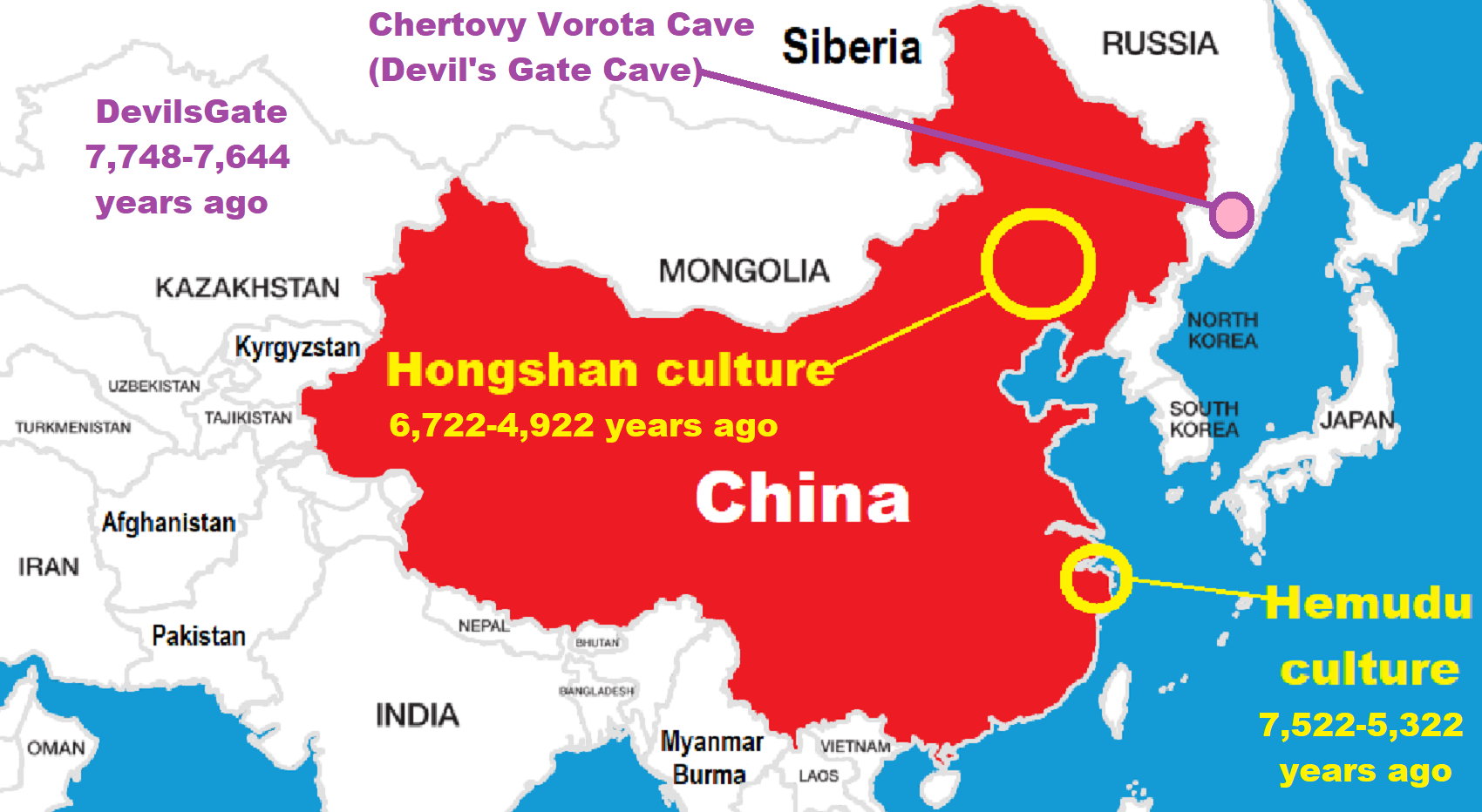
There will be 6 shows on this blog in total:
- Show One: Paleolithic or Old Stone Age in China and Different Approaches to Defining Civilization
- Show Two: Early Neolithic China: Ritual, Religion, and Civilization
- Show Three: Middle Neolithic China: Ritual, Religion, Elites, and Language
- Show Four: Late Neolithic and Bronze Age China: Ritual, Religion, Elites, Language, and Empires
- Show Five: Bronze Age and Ancient China: Ritual, Religion, Elites, Language, and Empires
- Show Six: Ancient China: Ritual, Religion, Elites, Language, Slavery, Eunuchs, and Empires
Part one Paleolithic or Old Stone Age in China
First let’s address the Paleolithic or Old Stone Age (from 3 million years ago, to around 12,000 years ago when it becomes the Neolithic or New Stone Age: 12,000 years ago to around 6,500 years ago when it becomes the Chalcolithic or Copper Age) in China. I am adding this so there is an understanding of how China’s populations formed and led to more cultural development in the Neolithic and beyond.
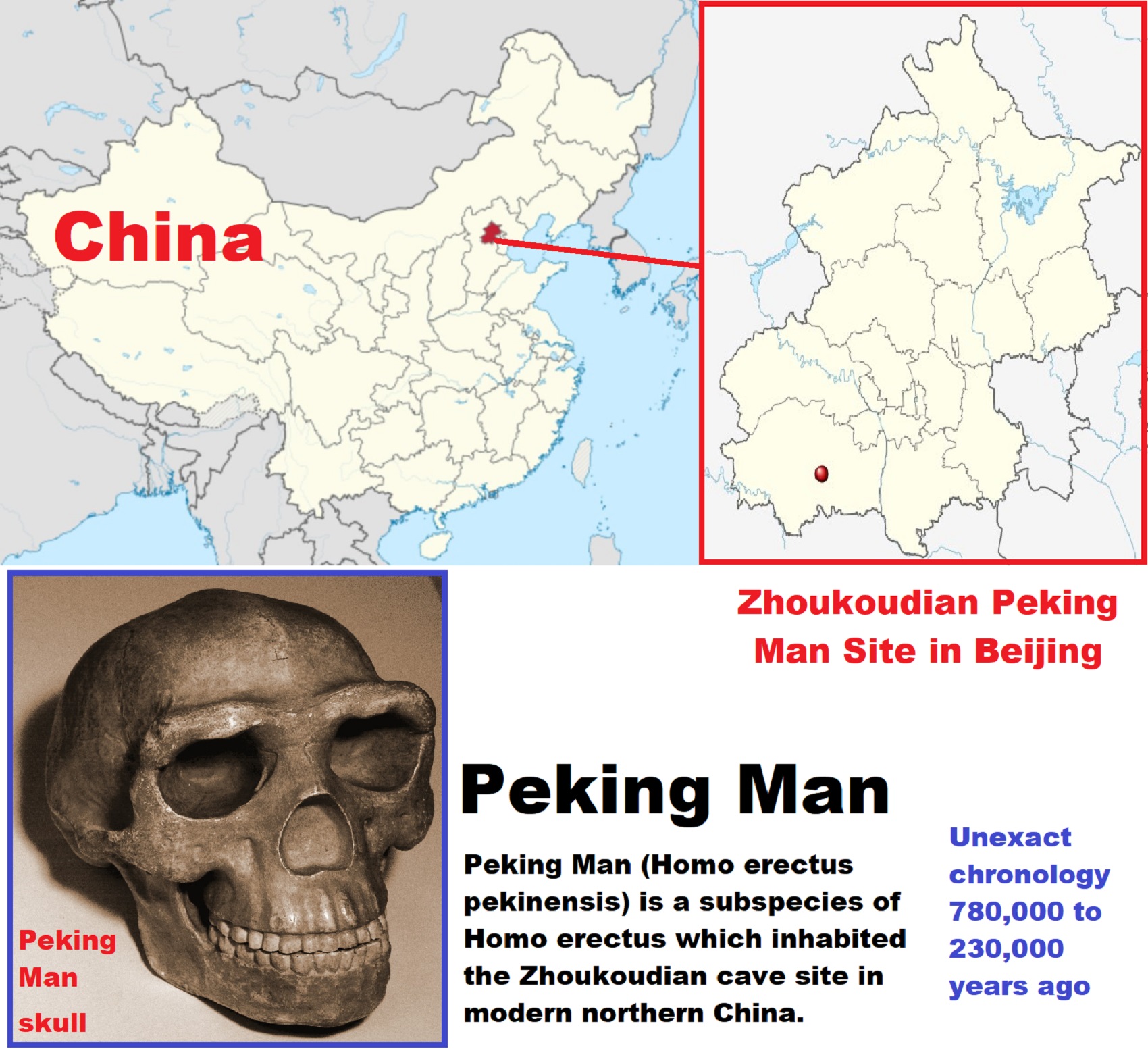
“Peking Man (Homo erectus pekinensis) is a subspecies of H. erectus which inhabited the Zhoukoudian cave site in modern northern China, discovered in the Zhoukoudian Cave has since then become the most productive Homo erectus site in the world. The fossils became the center of anthropological discussion and were classified as a direct human ancestor, propping up the Out of Asia hypothesis that humans evolved in Asia. Peking Man also played a vital role in the restructuring of the Chinese identity following the Chinese Communist Revolution, and was intensively communicated to working class and peasant communities to introduce them to Marxism and science (overturning deeply-rooted superstitions and creation myths).” ref
“Early models of Peking Man society strongly leaned towards communist or nationalist ideals, leading to discussions on primitive communism and polygenism. This produced a strong schism between Western and Eastern interpretations, especially as the West adopted the Out of Africa hypothesis by late 1967, and Peking Man’s role in human evolution diminished as merely an offshoot of the human line. Though Out of Africa is now the consensus, Peking Man interbreeding with human ancestors is frequently discussed especially in Chinese circles. Peking Man lived in a cool, predominantly steppe, partially forested environment, alongside deer, rhinos, elephants, bison, buffalo, bears, wolves, big cats, and a menagerie of other creatures. Peking Man intermittently inhabited the Zhoukoudian Cave, but the exact chronology is unclear, with estimates as far back as 780,000 years ago and as recent as 230,000 years ago.” ref
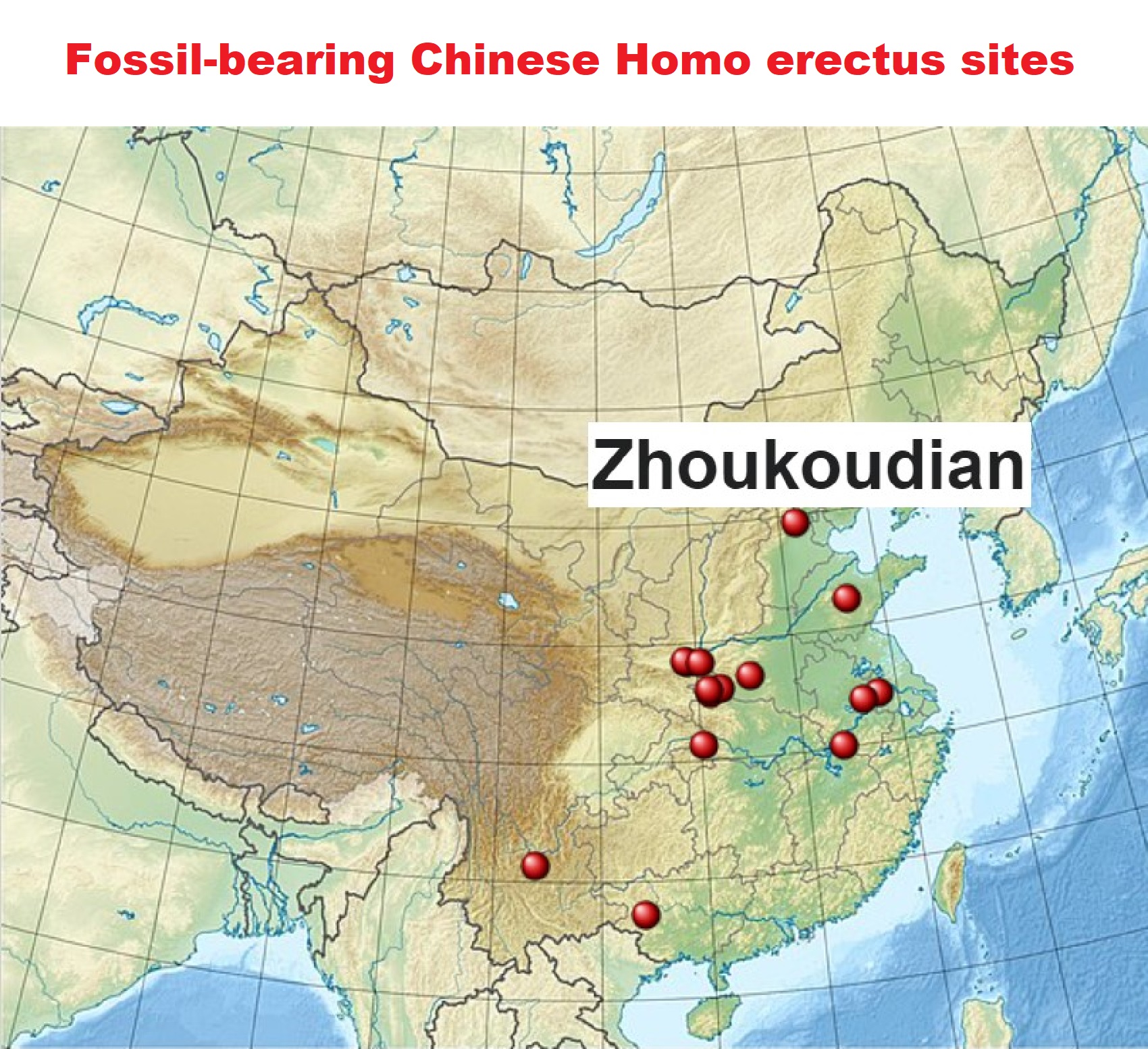
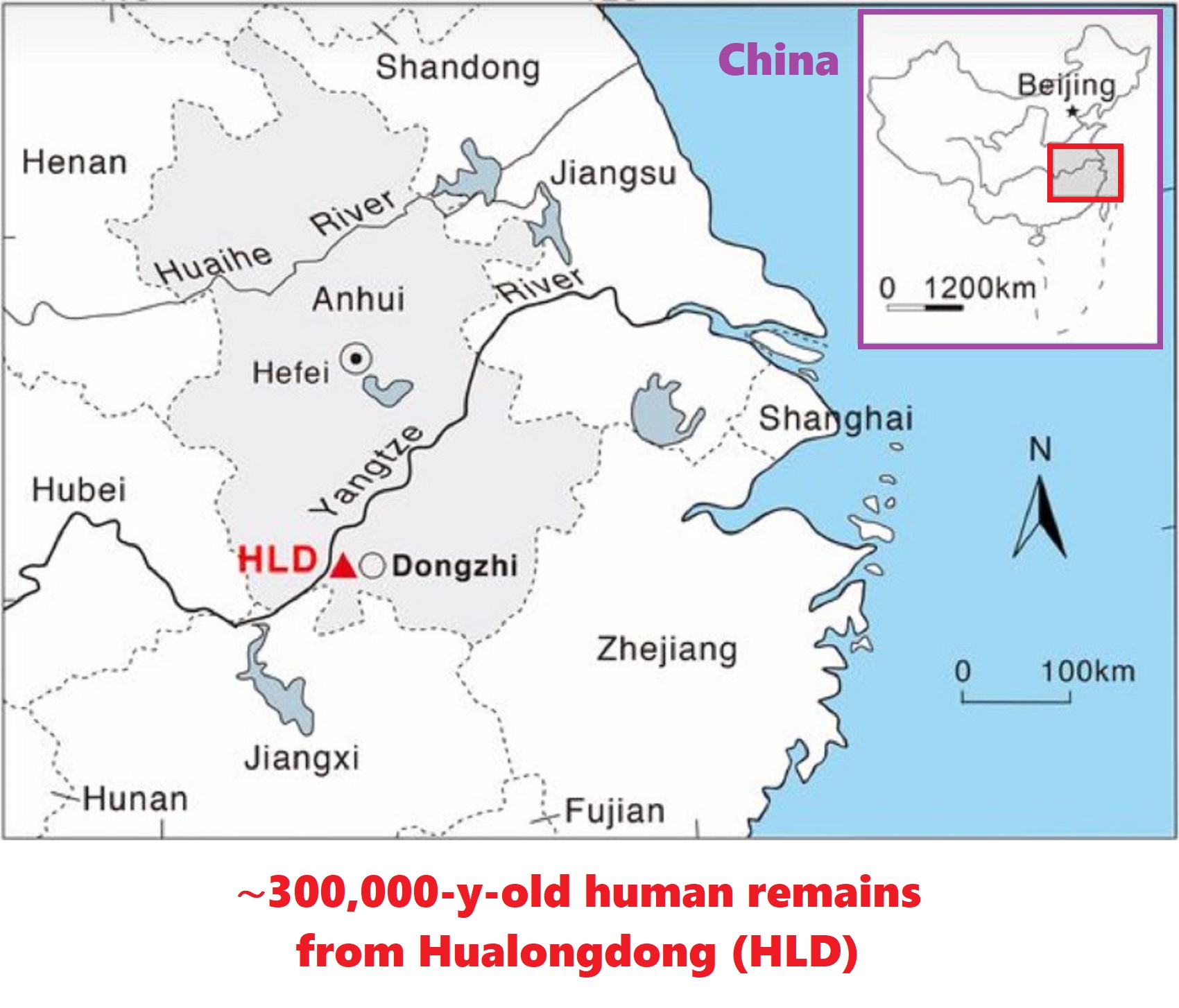
“Abstract: Late Middle Pleistocene hominins in Africa displaying key modern morphologies by 315,000 years ago are claimed as the earliest Homo sapiens. Evolutionary relationships among East Asian hominins appear complex due to a growing fossil record of late Middle Pleistocene hominins from the region, reflecting mosaic morphologies that contribute to a lack of consensus on when and how the transition to modern humans transpired. Newly discovered 300,000 years ago hominin fossils from Hualongdong, China, provide further evidence to clarify these relationships in the region. In this study, facial morphology of the juvenile partial cranium (HLD 6) is described and qualitatively and quantitatively compared with that of other key Early, Middle, and Late Pleistocene hominins from East Asia, Africa, West Asia, and Europe and with a sample of modern humans. Qualitatively, facial morphology of HLD 6 resembles that of Early and Middle Pleistocene hominins from Zhoukoudian, Nanjing, Dali, and Jinniushan in China, as well as others from Java, Africa, and Europe in some of these features (e.g., supraorbital and malar regions), and Late Pleistocene hominins and modern humans from East Asia, Africa, and Europe in other features (e.g., weak prognathism, flat face and features in nasal and hard plate regions). Comparisons of HLD 6 measurements to group means and multivariate analyses support close affinities of HLD 6 to Late Pleistocene hominins and modern humans. Expression of a mosaic morphological pattern in the HLD 6 facial skeleton further complicates evolutionary interpretations of regional morphological diversity in East Asia. The prevalence of modern features in HLD 6 suggests that the hominin population to which HLD 6 belonged may represent the earliest pre-modern humans in East Asia. Thus, the transition from archaic to modern morphology in East Asian hominins may have occurred at least by 300,000 years ago, which is 80,000 to 100,000 years earlier than previously recognized.” ref
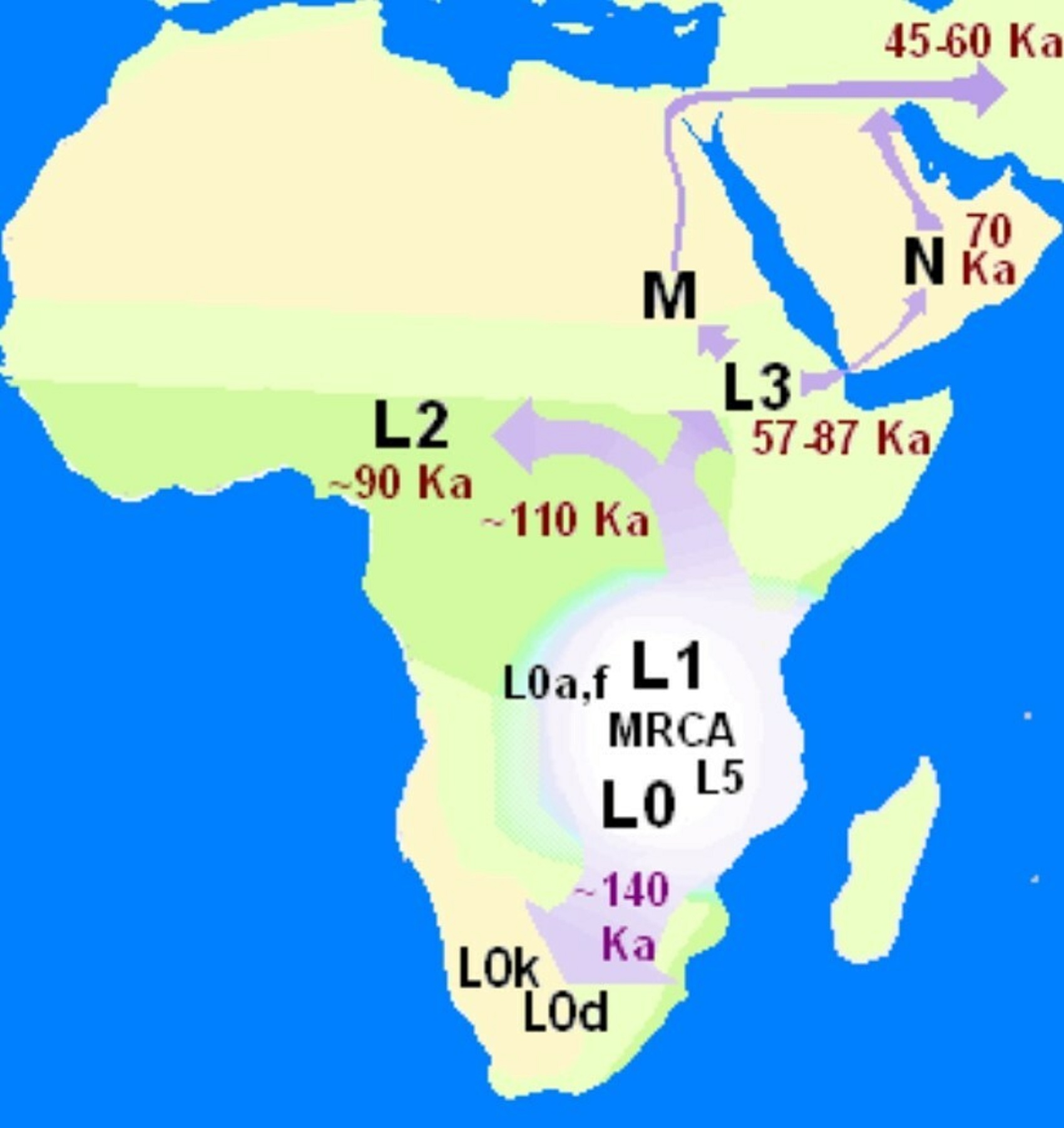
Y Chromosome Study Suggests Asians, Too, Came from Africa
“Geneticist Li Jin of the University of Texas and his colleagues examined Y chromosomal DNA from more than 12,000 males belonging to 163 populations in Asia and Oceania. Multiregionalism posits that archaic humans such as Neandertals contributed to the modern human gene pool. Thus modern Southeast Asian populations, for example, should retain some ancient lineages inherited from the archaic populations that once inhabited that region, an argument that the multiregionalists have bolstered with fossil evidence. But Jin and his colleagues only found markers associated with a gene mutation known to have arisen in an African ancestor sometime between 35,000 and 89,000 years ago. This, the authors write, “indicates that modern humans of African origin completely replaced earlier populations in East Asia.” ref
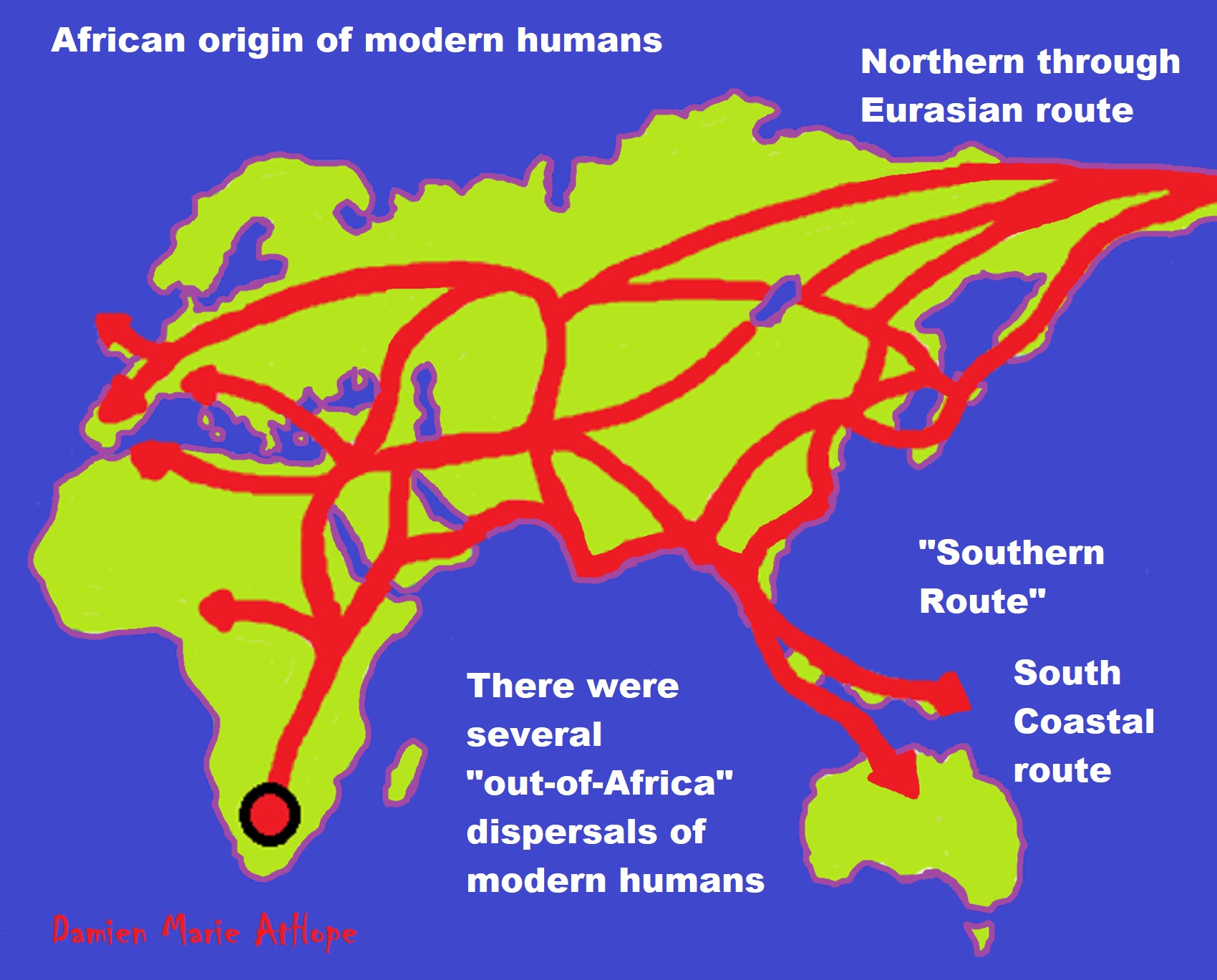
ref, ref, ref, ref, ref, ref, ref, ref
“There are two geographically plausible routes that have been proposed for humans to emerge from Africa: through the current Egypt and Sinai (Northern Route), or through Ethiopia, the Bab el Mandeb strait, and the Arabian Peninsula (Southern Route).” ref
“Although there is a general consensus on the African origin of early modern humans, there is disagreement about how and when they dispersed to Eurasia. This paper reviews genetic and Middle Stone Age/Middle Paleolithic archaeological literature from northeast Africa, Arabia, and the Levant to assess the timing and geographic backgrounds of Upper Pleistocene human colonization of Eurasia. At the center of the discussion lies the question of whether eastern Africa alone was the source of Upper Pleistocene human dispersals into Eurasia or were there other loci of human expansions outside of Africa? The reviewed literature hints at two modes of early modern human colonization of Eurasia in the Upper Pleistocene: (i) from multiple Homo sapiens source populations that had entered Arabia, South Asia, and the Levant prior to and soon after the onset of the Last Interglacial (MIS-5), (ii) from a rapid dispersal out of East Africa via the Southern Route (across the Red Sea basin), dating to ~74,000-60,000 years ago.” ref
“Within Africa, Homo sapiens dispersed around the time of its speciation, roughly 300,000 years ago. The so-called “recent dispersal” of modern humans took place about 70–50,000 years ago. It is this migration wave that led to the lasting spread of modern humans throughout the world. The coastal migration between roughly 70,000 and 50,000 years ago is associated with mitochondrial haplogroups M and N, both derivative of L3. Europe was populated by an early offshoot that settled the Near East and Europe less than 55,000 years ago. Modern humans spread across Europe about 40,000 years ago, possibly as early as 43,000 years ago, rapidly replacing the Neanderthal population.” ref, ref
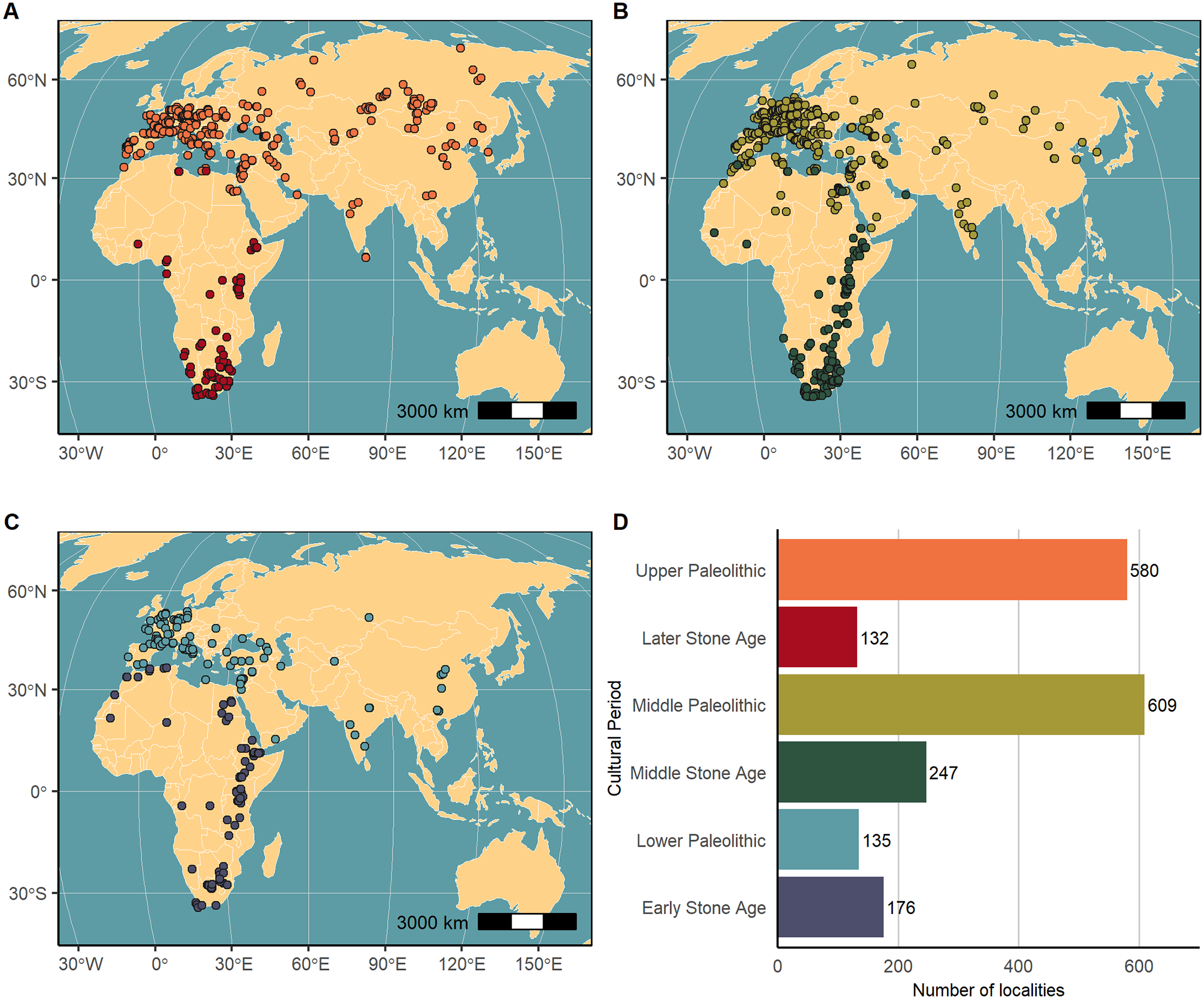
- Lower Paleolithic (around 3.3 million to 300,000 years ago)
- Middle Paleolithic (around 300,000 to 50,000 years ago)
- Upper Paleolithic (around 50,000 to 12,000 years ago)
The ROCEEH Out of Africa Database (ROAD): A large-scale research database serves as an indispensable tool for human evolutionary studies
“Abstract: Large-scale databases are critical for helping scientists decipher long-term patterns in human evolution. This paper describes the conception and development of such a research database and illustrates how big data can be harnessed to formulate new ideas about the past. The Role of Culture in Early Expansions of Humans (ROCEEH) is a transdisciplinary research center whose aim is to study the origins of culture and the multifaceted aspects of human expansions across Africa and Eurasia over the last three million years. To support its research, the ROCEEH team developed an online tool named the ROCEEH Out of Africa Database (ROAD) and implemented its web-based applications. ROAD integrates geographical data as well as archaeological, paleoanthropological, paleontological, and paleobotanical content within a robust chronological framework. In fact, a unique feature of ROAD is its ability to dynamically link scientific data both spatially and temporally, thereby allowing its reuse in ways that were not originally conceived. The data stem from published sources spanning the last 150 years, including those generated by the research team. Descriptions of these data rely on the development of a standardized vocabulary and profit from online explanations of each table and attribute. By synthesizing legacy data, ROAD facilitates the reuse of heritage data in novel ways. Database queries yield structured information in a variety of interoperable formats. By visualizing data on maps, users can explore this vast dataset and develop their own theories. By downloading data, users can conduct further quantitative analyses, for example with Geographic Information Systems, modeling programs, and artificial intelligence. In this paper, we demonstrate the innovative nature of ROAD and show how it helps scientists studying human evolution to access datasets from different fields, thereby connecting the social and natural sciences. Because it permits the reuse of “old” data in new ways, ROAD is now an indispensable tool for researchers of human evolution and paleogeography.”
https://journals.plos.org/plosone/article?id=10.1371/journal.pone.0289513
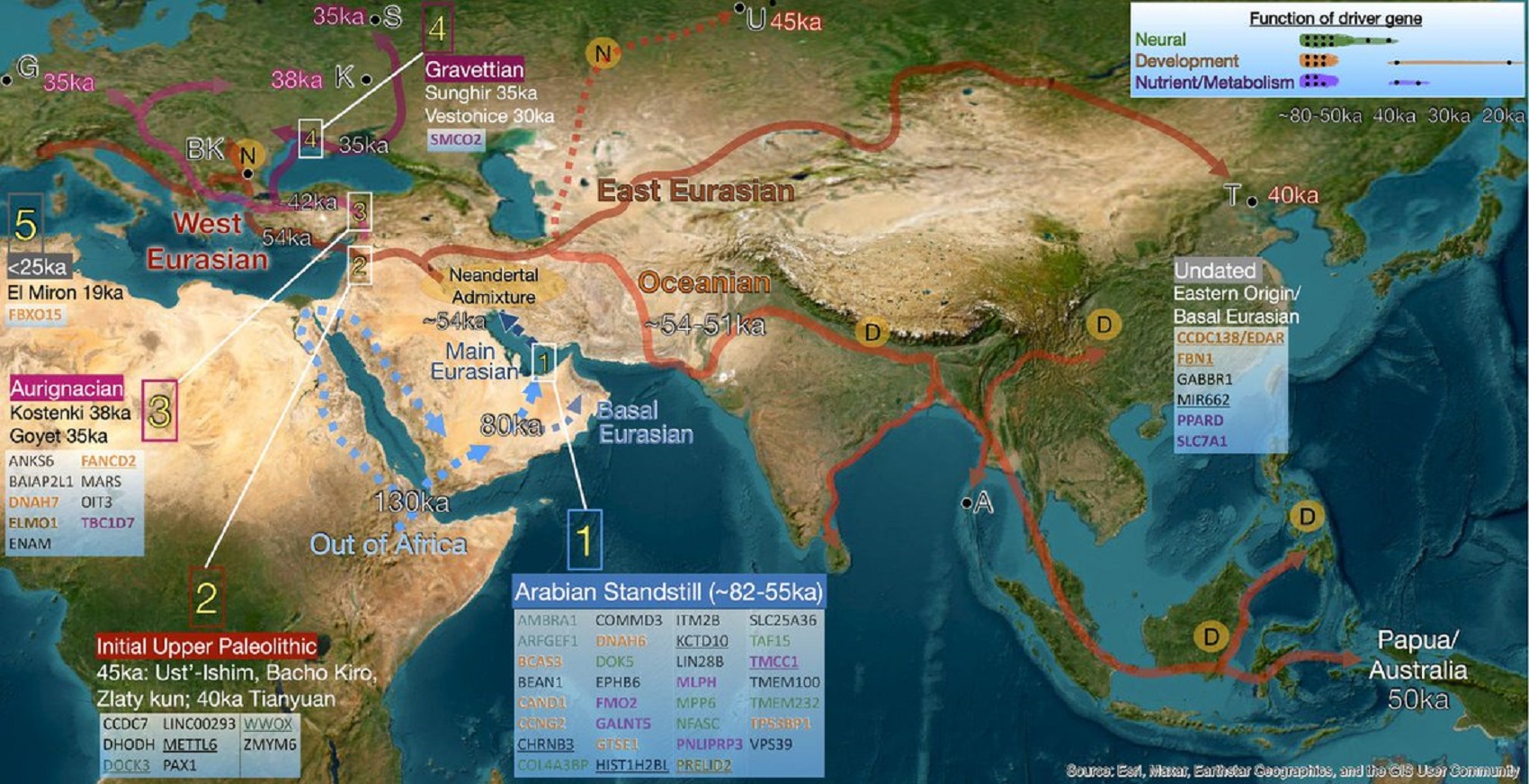
“Abstract: The evolutionarily recent dispersal of anatomically modern humans (AMH) out of Africa (OoA) and across Eurasia provides a unique opportunity to examine the impacts of genetic selection as humans adapted to multiple new environments. Analysis of ancient Eurasian genomic datasets (~1,000 to 45,000 y old) reveals signatures of strong selection, including at least 57 hard sweeps after the initial AMH movement OoA, which have been obscured in modern populations by extensive admixture during the Holocene. The spatiotemporal patterns of these hard sweeps provide a means to reconstruct early AMH population dispersals OoA. We identify a previously unsuspected extended period of genetic adaptation lasting ~30,000 y, potentially in the Arabian Peninsula area, prior to a major Neandertal genetic introgression and subsequent rapid dispersal across Eurasia as far as Australia. Consistent functional targets of selection initiated during this period, which we term the Arabian Standstill, include loci involved in the regulation of fat storage, neural development, skin physiology, and cilia function. Similar adaptive signatures are also evident in introgressed archaic hominin loci and modern Arctic human groups, and we suggest that this signal represents selection for cold adaptation. Surprisingly, many of the candidate selected loci across these groups appear to directly interact and coordinately regulate biological processes, with a number associated with major modern diseases including the ciliopathies, metabolic syndrome, and neurodegenerative disorders. This expands the potential for ancestral human adaptation to directly impact modern diseases, providing a platform for evolutionary medicine.” ref

ref, ref, ref, ref, ref, ref, ref, ref, ref, ref, ref, ref
“There were at least several “out-of-Africa” dispersals of modern humans, possibly beginning as early as 270,000 years ago, including 215,000 years ago to at least Greece, and certainly via northern Africa and the Arabian Peninsula about 130,000 to 115,000 years ago. These early waves appear to have mostly died out or retreated by 80,000 years ago.” ref
“The most significant “recent” wave out of Africa took place about 70,000–50,000 years ago, via the so-called “Southern Route“, spreading rapidly along the coast of Asia and reaching Australia by around 65,000–50,000 years ago, (though some researchers question the earlier Australian dates and place the arrival of humans there at 50,000 years ago at earliest, while others have suggested that these first settlers of Australia may represent an older wave before the more significant out of Africa migration and thus not necessarily be ancestral to the region’s later inhabitants) while Europe was populated by an early offshoot which settled the Near East and Europe less than 55,000 years ago.” ref
- “An Eastward Dispersal from Northeast Africa to Arabia 150,000–130,000 years ago based on the finds at Jebel Faya dated to 127,000 years ago (discovered in 2011). Possibly related to this wave are the finds from Zhirendong cave, Southern China, dated to more than 100,000 years ago. Other evidence of modern human presence in China has been dated to 80,000 years ago.” ref
- “The most significant out of Africa dispersal took place around 50–70,000 years ago via the so-called Southern Route, either before or after the Toba event, which happened between 69,000 and 77,000 years ago. This dispersal followed the southern coastline of Asia, and reached Australia around 65,000-50,000 years ago, or according to some research, by 50,000 years ago at earliest. Western Asia was “re-occupied” by a different derivation from this wave around 50,000 years ago, and Europe was populated from Western Asia beginning around 43,000 years ago.” ref
- “Wells (2003) describes an additional wave of migration after the southern coastal route, namely a northern migration into Europe at circa 45,000 years ago. However, this possibility is ruled out by Macaulay et al. (2005) and Posth et al. (2016), who argue for a single coastal dispersal, with an early offshoot into Europe.” ref

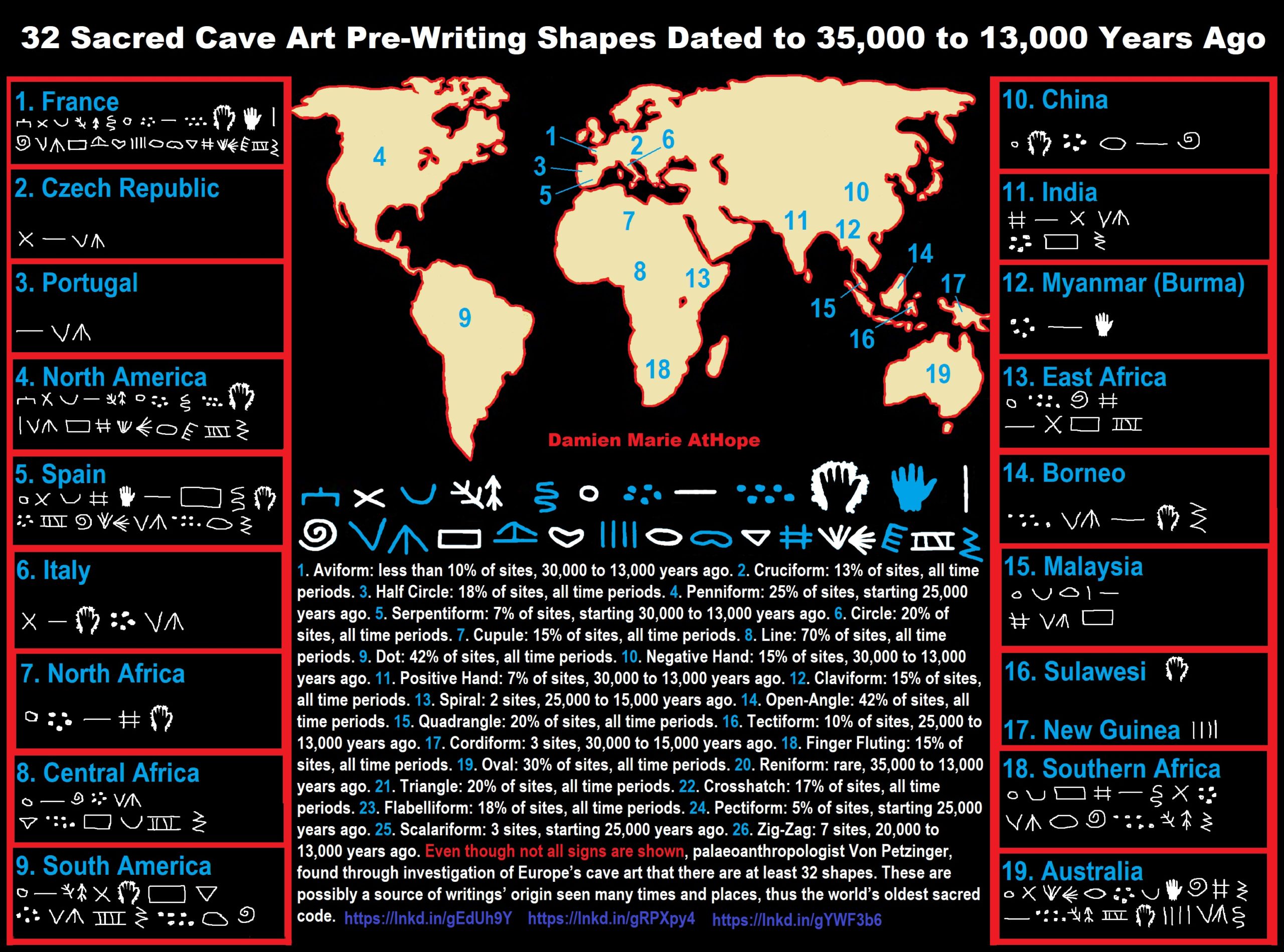
Why are these 32 symbols found in caves all over Europe
32 Sacred Cave Art Pre-Writing Shapes Dated to 35,000 to 13,000 Years Ago
- 1. Aviform: less than 10% of sites, 30,000 to 13,000 years ago.
- 2. Cruciform: 13% of sites, all time periods.
- 3. Half Circle: 18% of sites, all time periods.
- 4. Penniform: 25% of sites, starting 25,000 years ago.
- 5. Serpentiform: 7% of sites, starting 30,000 to 13,000 years ago.
- 6. Circle: 20% of sites, all time periods.
- 7. Cupule: 15% of sites, all time periods.
- 8. Line: 70% of sites, all time periods.
- 9. Dot: 42% of sites, all time periods.
- 10. Negative Hand: 15% of sites, 30,000 to 13,000 years ago.
- 11. Positive Hand: 7% of sites, 30,000 to 13,000 years ago.
- 12. Claviform: 15% of sites, all time periods.
- 13. Spiral: 2 sites, 25,000 to 15,000 years ago.
- 14. Open-Angle: 42% of sites, all time periods.
- 15. Quadrangle: 20% of sites, all time periods.
- 16. Tectiform: 10% of sites, 25,000 to 13,000 years ago.
- 17. Cordiform: 3 sites, 30,000 to 15,000 years ago.
- 18. Finger Fluting: 15% of sites, all time periods.
- 19. Oval: 30% of sites, all time periods.
- 20. Reniform: rare, 35,000 to 13,000 years ago.
- 21. Triangle: 20% of sites, all time periods.
- 22. Crosshatch: 17% of sites, all time periods.
- 23. Flabelliform: 18% of sites, all time periods.
- 24. Pectiform: 5% of sites, starting 25,000 years ago.
- 25. Scalariform: 3 sites, starting 25,000 years ago.
- 26. Zig-Zag: 7 sites, 20,000 to 13,000 years ago.
Even though not all signs are shown, palaeoanthropologist Von Petzinger, found through investigation of Europe’s cave art that there are at least 32 shapes. These are possibly a source of writings’ origin seen many times and places, thus the world’s oldest sacred code. A paleoanthropologist and rock art researcher explains that even though to many written language is the hallmark of human civilization, this construct in behavior didn’t just suddenly appear one day. Thousands of years before the first fully developed writing systems, our ancestors scrawled geometric signs across the walls of the caves they sheltered in. She has studied and codified these ancient markings in caves across Europe, suggesting that graphic communication, and the ability to preserve and transmit messages beyond a single moment in time, may be much older than we think. ref, ref, ref, ref
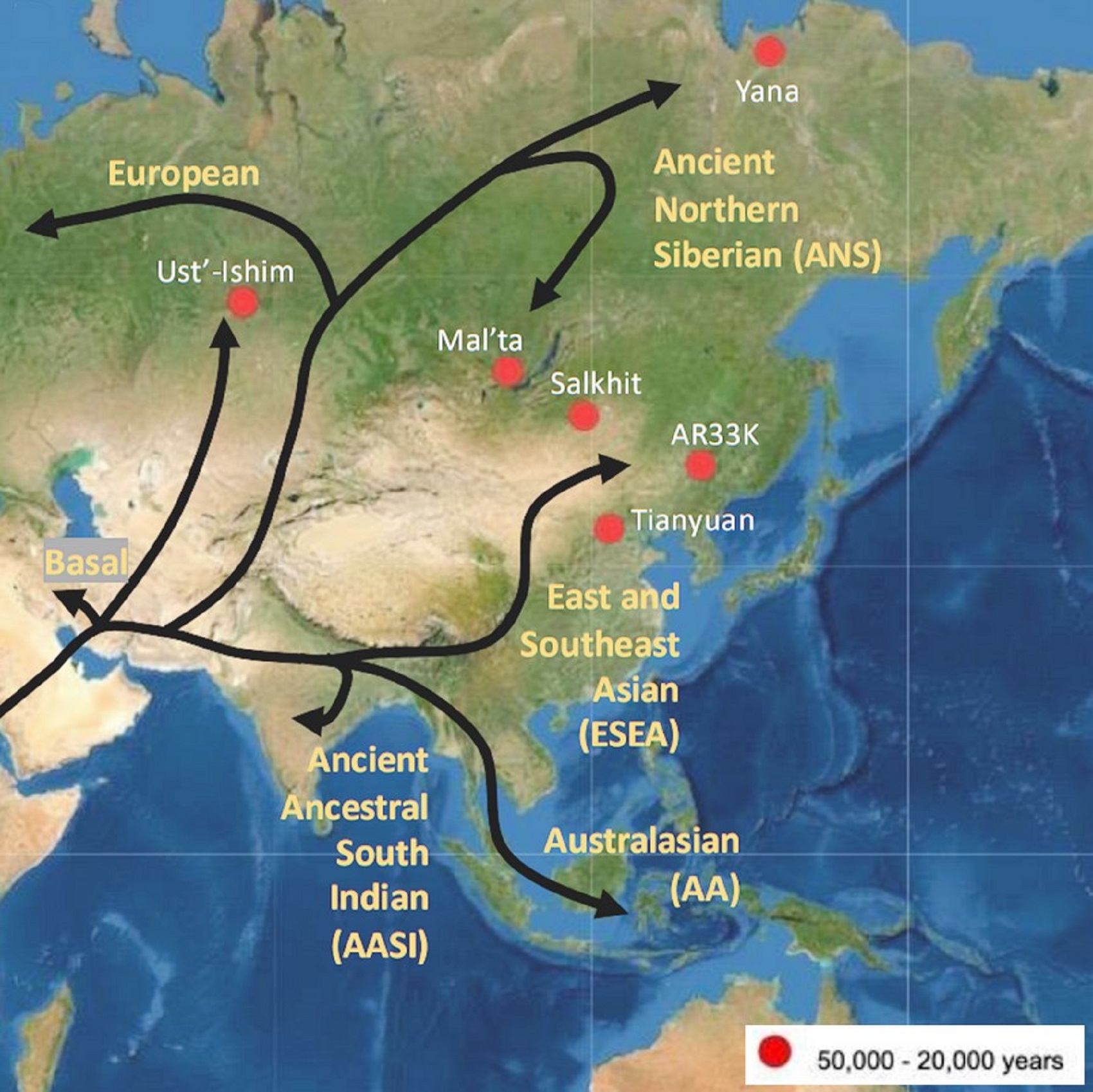

Groups partially derived from the Ancient North Eurasians
“The ANE lineage is defined by association with the MA-1, or “Mal’ta boy”, remains of 24,000 years ago in central Siberia Mal’ta-Buret’ culture 24,000-15,000 years ago. The Ancient North Eurasians (ANE) samples (Afontova Gora 3, Mal’ta 1, and Yana-RHS) show evidence for minor gene flow from an East Asian-related group (simplified by the Amis, Han, or Tianyuan) but no evidence for ANE-related geneflow into East Asians (Amis, Han, Tianyuan), except the Ainu, of North Japan.” ref
“The ANE lineage is defined by association with the MA-1, or “Mal’ta boy”, remains of 24,000 years ago in central Siberia Mal’ta-Buret’ culture 24,000-15,000 years ago “basal to modern-day Europeans”. Some Ancient North Eurasians also carried East Asian populations, such as Tianyuan Man.” ref
“Bronze-age-steppe Yamnaya and Afanasevo cultures were ANE at around 50% and Eastern Hunter-Gatherer (EHG) at around 75% ANE. Karelia culture: Y-DNA R1a-M417 8,400 years ago, Y-DNA J, 7,200 years ago, and Samara, of Y-haplogroup R1b-P297 7,600 years ago is closely related to ANE from Afontova Gora, 18,000 years ago around the time of blond hair first seen there.” ref
Ancient North Eurasian
“In archaeogenetics, the term Ancient North Eurasian (often abbreviated as ANE) is the name given to an ancestral West Eurasian component that represents descent from the people similar to the Mal’ta–Buret’ culture and populations closely related to them, such as from Afontova Gora and the Yana Rhinoceros Horn Site. Significant ANE ancestry are found in some modern populations, including Europeans and Native Americans.” ref
“The ANE lineage is defined by association with the MA-1, or “Mal’ta boy“, the remains of an individual who lived during the Last Glacial Maximum, 24,000 years ago in central Siberia, Ancient North Eurasians are described as a lineage “which is deeply related to Paleolithic/Mesolithic hunter-gatherers in Europe,” meaning that they diverged from Paleolithic Europeans a long time ago.” ref
“The ANE population has also been described as having been “basal to modern-day Europeans” but not especially related to East Asians, and is suggested to have perhaps originated in Europe or Western Asia or the Eurasian Steppe of Central Asia. However, some samples associated with Ancient North Eurasians also carried ancestry from an ancient East Asian population, such as Tianyuan Man. Sikora et al. (2019) found that the Yana RHS sample (31,600 BP) in Northern Siberia “can be modeled as early West Eurasian with an approximately 22% contribution from early East Asians.” ref
“Populations genetically similar to MA-1 were an important genetic contributor to Native Americans, Europeans, Central Asians, South Asians, and some East Asian groups, in order of significance. Lazaridis et al. (2016:10) note “a cline of ANE ancestry across the east-west extent of Eurasia.” The ancient Bronze-age-steppe Yamnaya and Afanasevo cultures were found to have a noteworthy ANE component at ~50%.” ref
“According to Moreno-Mayar et al. 2018 between 14% and 38% of Native American ancestry may originate from gene flow from the Mal’ta–Buret’ people (ANE). This difference is caused by the penetration of posterior Siberian migrations into the Americas, with the lowest percentages of ANE ancestry found in Eskimos and Alaskan Natives, as these groups are the result of migrations into the Americas roughly 5,000 years ago.” ref
“Estimates for ANE ancestry among first wave Native Americans show higher percentages, such as 42% for those belonging to the Andean region in South America. The other gene flow in Native Americans (the remainder of their ancestry) was of East Asian origin. Gene sequencing of another south-central Siberian people (Afontova Gora-2) dating to approximately 17,000 years ago, revealed similar autosomal genetic signatures to that of Mal’ta boy-1, suggesting that the region was continuously occupied by humans throughout the Last Glacial Maximum.” ref
“The earliest known individual with a genetic mutation associated with blonde hair in modern Europeans is an Ancient North Eurasian female dating to around 16000 BCE from the Afontova Gora 3 site in Siberia. It has been suggested that their mythology may have included a narrative, found in both Indo-European and some Native American fables, in which a dog guards the path to the afterlife.” ref
“Genomic studies also indicate that the ANE component was introduced to Western Europe by people related to the Yamnaya culture, long after the Paleolithic. It is reported in modern-day Europeans (7%–25%), but not of Europeans before the Bronze Age. Additional ANE ancestry is found in European populations through paleolithic interactions with Eastern Hunter-Gatherers, which resulted in populations such as Scandinavian Hunter-Gatherers.” ref
“The Ancient North Eurasians (ANE) split from the ancestors of European peoples somewhere in the Middle East or South-central Asia, and used a northern dispersal route through Central Asia into Northern Asia and Siberia. Genetic analyses show that all ANE samples (Afontova Gora 3, Mal’ta 1, and Yana-RHS) show evidence for minor gene flow from an East Asian-related group (simplified by the Amis, Han, or Tianyuan). In contrast, no evidence for ANE-related geneflow into East Asians (Amis, Han, Tianyuan), except the Ainu, was found.” ref
“Genetic data suggests that the ANE formed during the Terminal Upper-Paleolithic (36+-1,5ka) period from a deeply European-related population, which was once widespread in Northern Eurasia, and from an early East Asian-related group, which migrated northwards into Central Asia and Siberia, merging with this deeply European-related population. These population dynamics and constant northwards geneflow of East Asian-related ancestry would later gave rise to the “Ancestral Native Americans” and Paleosiberians, which replaced the ANE as dominant population of Siberia.” ref
Groups partially derived from the Ancient North Eurasians
“Eastern Hunter-Gatherer (EHG) is a lineage derived predominantly (75%) from ANE. It is represented by two individuals from Karelia, one of Y-haplogroup R1a-M417, dated c. 8.4 kya, the other of Y-haplogroup J, dated c. 7.2 kya; and one individual from Samara, of Y-haplogroup R1b-P297, dated c. 7.6 kya. This lineage is closely related to the ANE sample from Afontova Gora, dated c. 18 kya. After the end of the Last Glacial Maximum, the Western Hunter-Gatherers (WHG) and EHG lineages merged in Eastern Europe, accounting for early presence of ANE-derived ancestry in Mesolithic Europe. Evidence suggests that as Ancient North Eurasians migrated West from Eastern Siberia, they absorbed Western Hunter-Gatherers and other West Eurasian populations as well.” ref
“Caucasian Hunter-Gatherer (CHG) is represented by the Satsurblia individual dated ~13 kya (from the Satsurblia cave in Georgia), and carried 36% ANE-derived admixture. While the rest of their ancestry is derived from the Dzudzuana cave individual dated ~26 kya, which lacked ANE-admixture, Dzudzuana affinity in the Caucasus decreased with the arrival of ANE at ~13 kya Satsurblia.” ref
“Scandinavian Hunter-Gatherer (SHG) is represented by several individuals buried at Motala, Sweden ca. 6000 BC. They were descended from Western Hunter-Gatherers who initially settled Scandinavia from the south, and later populations of EHG who entered Scandinavia from the north through the coast of Norway.” ref
“Iran Neolithic (Iran_N) individuals dated ~8.5 kya carried 50% ANE-derived admixture and 50% Dzudzuana-related admixture, marking them as different from other Near-Eastern and Anatolian Neolithics who didn’t have ANE admixture. Iran Neolithics were later replaced by Iran Chalcolithics, who were a mixture of Iran Neolithic and Near Eastern Levant Neolithic.” ref
“Ancient Beringian/Ancestral Native American are specific archaeogenetic lineages, based on the genome of an infant found at the Upward Sun River site (dubbed USR1), dated to 11,500 years ago. The AB lineage diverged from the Ancestral Native American (ANA) lineage about 20,000 years ago.” ref
“West Siberian Hunter-Gatherer (WSHG) are a specific archaeogenetic lineage, first reported in a genetic study published in Science in September 2019. WSGs were found to be of about 30% EHG ancestry, 50% ANE ancestry, and 20% to 38% East Asian ancestry.” ref
“Western Steppe Herders (WSH) is the name given to a distinct ancestral component that represents descent closely related to the Yamnaya culture of the Pontic–Caspian steppe. This ancestry is often referred to as Yamnaya ancestry or Steppe ancestry.” ref
“Late Upper Paeolithic Lake Baikal – Ust’Kyakhta-3 (UKY) 14,050-13,770 BP were mixture of 30% ANE ancestry and 70% East Asian ancestry.” ref
“Lake Baikal Holocene – Baikal Eneolithic (Baikal_EN) and Baikal Early Bronze Age (Baikal_EBA) derived 6.4% to 20.1% ancestry from ANE, while rest of their ancestry was derived from East Asians. Fofonovo_EN near by Lake Baikal were mixture of 12-17% ANE ancestry and 83-87% East Asian ancestry.” ref
“Hokkaido Jōmon people specifically refers to the Jōmon period population of Hokkaido in northernmost Japan. Though the Jōmon people themselves descended mainly from East Asian lineages, one study found an affinity between Hokkaido Jōmon with the Northern Eurasian Yana sample (an ANE-related group, related to Mal’ta), and suggest as an explanation the possibility of minor Yana gene flow into the Hokkaido Jōmon population (as well as other possibilities). A more recent study by Cooke et al. 2021, confirmed ANE-related geneflow among the Jōmon people, partially ancestral to the Ainu people. ANE ancestry among Jōmon people is estimated at 21%, however, there is a North to South cline within the Japanese archipelago, with the highest amount of ANE ancestry in Hokkaido and Tohoku.” ref
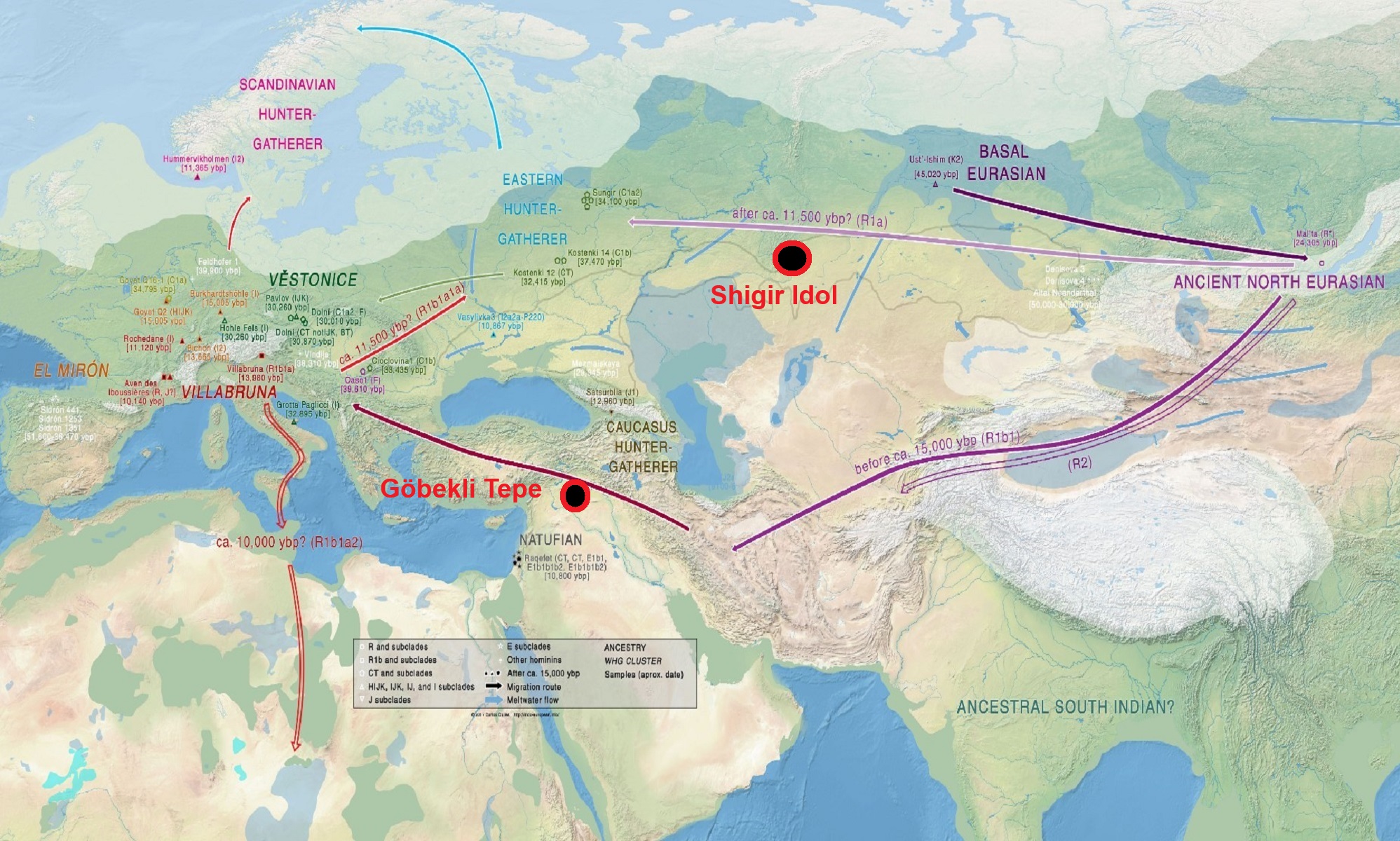

ref, ref, ref, ref, ref, ref, ref, ref, ref, ref, ref, ref, ref, ref, ref, ref, ref, ref, ref
Here are my thoughts/speculations on where I believe is the possible origin of shamanism, which may have begun sometime around 35,000 to 30,000 years ago seen in the emergence of the Gravettian culture, just to outline his thinking, on what thousands of years later led to evolved Asian shamanism, in general, and thus WU shamanism as well. In both Europe-related “shamanism-possible burials” and in Gravettian mitochondrial DNA is a seeming connection to Haplogroup U. And the first believed Shaman proposed burial belonged to Eastern Gravettians/Pavlovian culture at Dolní Věstonice in southern Moravia in the Czech Republic, which is the oldest permanent human settlement that has ever been found. It is at Dolní Věstonice where approximately 27,000-25,000 years ago a seeming female shaman was buried and also there was an ivory totem portrait figure, seemingly of her.
And my thoughts on how cultural/ritual aspects were influenced in the area of Göbekli Tepe. I think it relates to a few different cultures starting in the area before the Neolithic. Two different groups of Siberians first from northwest Siberia with U6 haplogroup 40,000 to 30,000 or so. Then R Haplogroup (mainly haplogroup R1b but also some possible R1a both related to the Ancient North Eurasians). This second group added its “R1b” DNA of around 50% to the two cultures Natufian and Trialetian. To me, it is likely both of these cultures helped create Göbekli Tepe. Then I think the female art or graffiti seen at Göbekli Tepe to me possibly relates to the Epigravettians that made it into Turkey and have similar art in North Italy. I speculate that possibly the Totem pole figurines seen first at Kostenki, next went to Mal’ta in Siberia as seen in their figurines that also seem “Totem-pole-like”, and then with the migrations of R1a it may have inspired the Shigir idol in Russia and the migrations of R1b may have inspired Göbekli Tepe.

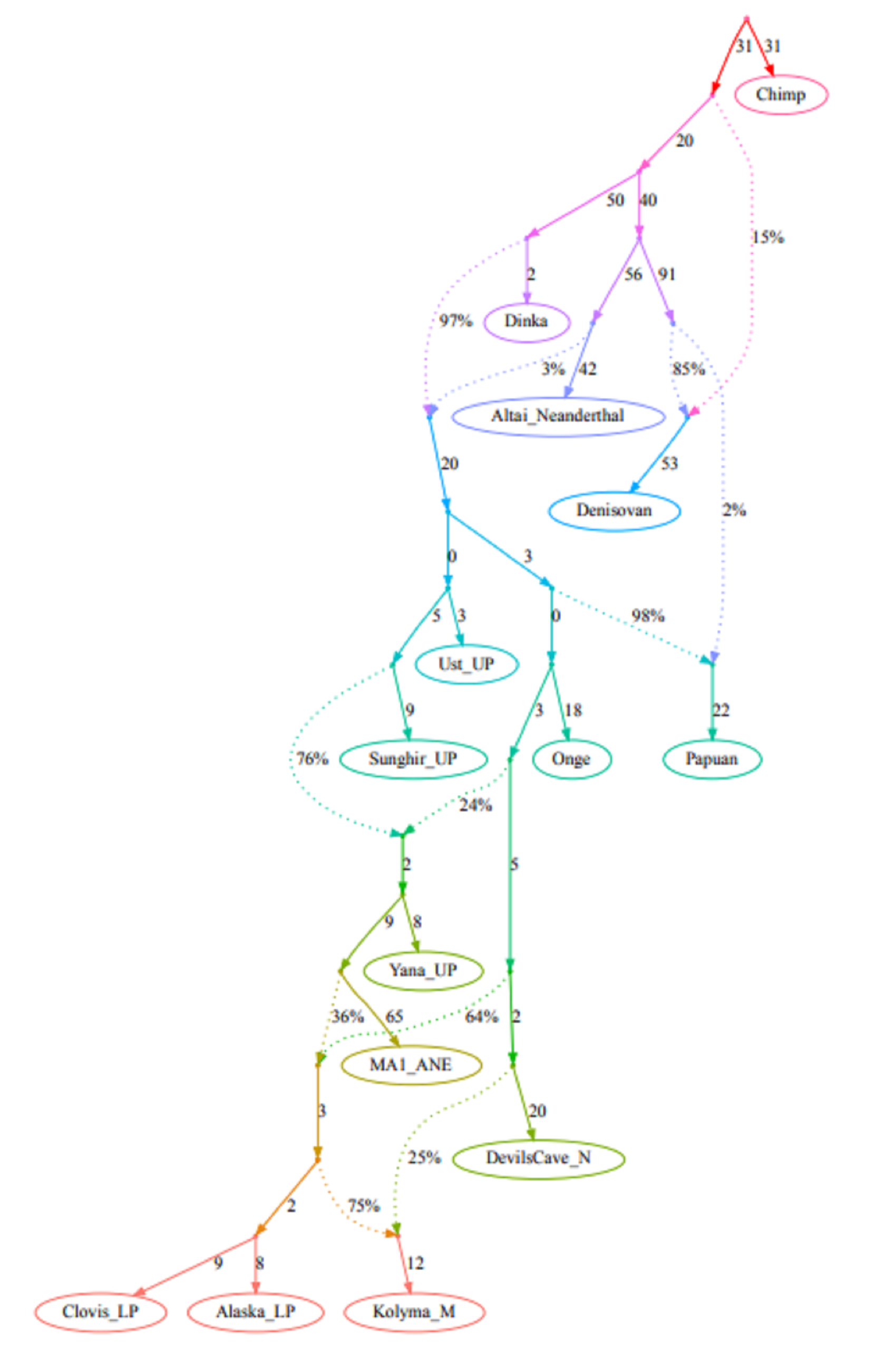
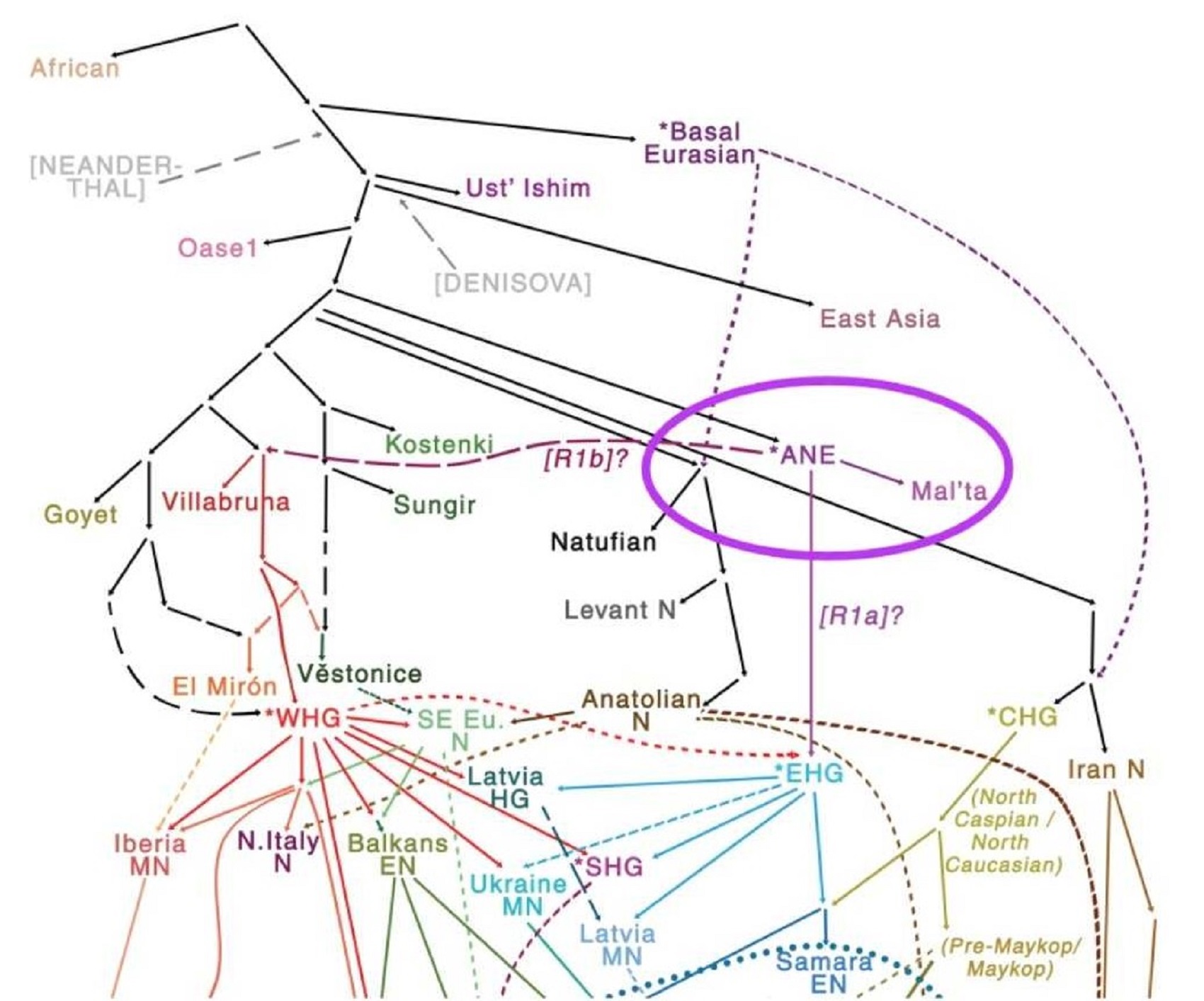
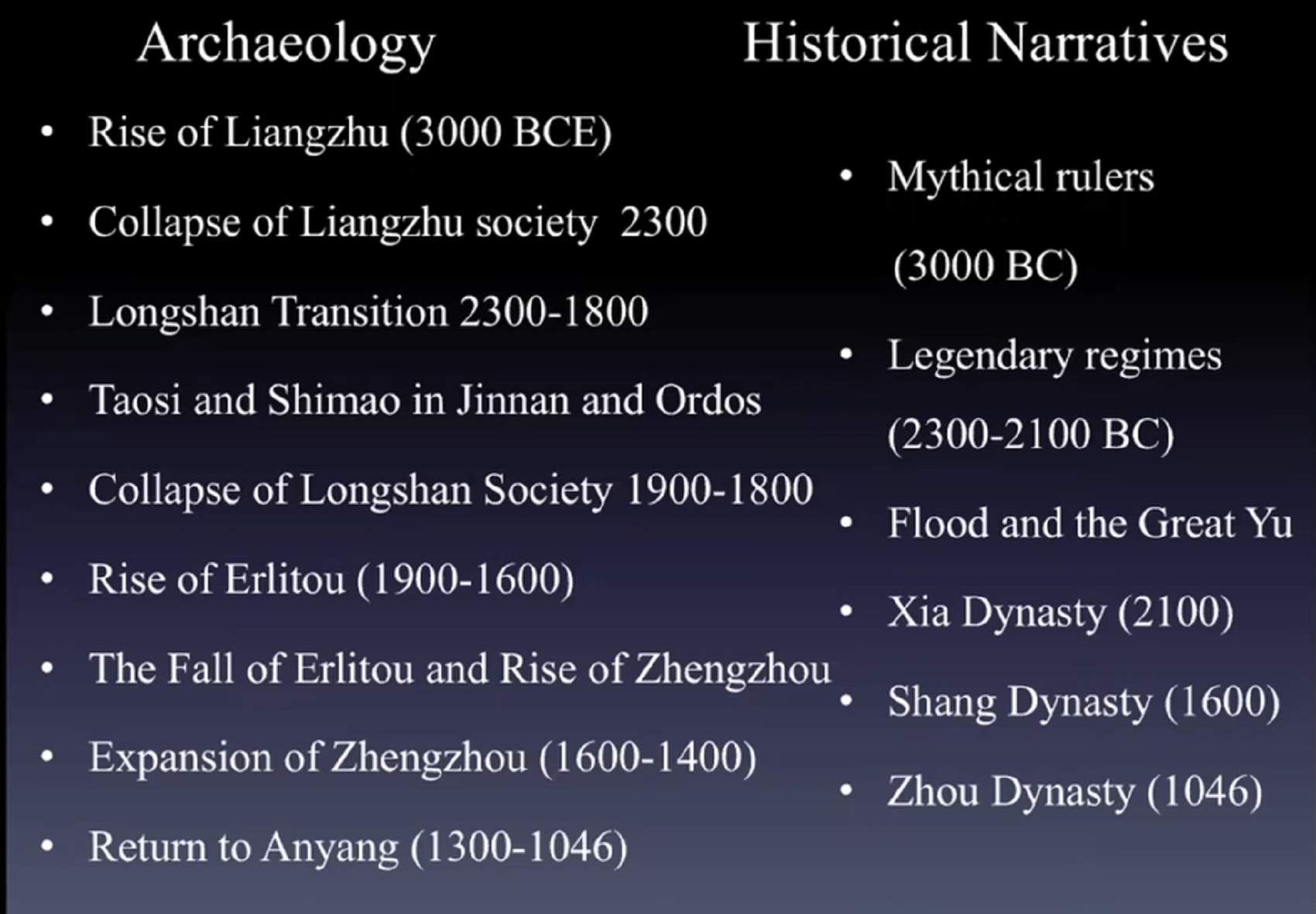
The video used for this blog and our “Atheist-Humanist-Leftist Revolutionaries” YouTube show is:
(The Rise of Early Chinese Civilization ~ Dr. Min Li): https://www.youtube.com/watch?v=lz4EQ0iYDI4&t=413s
“In this superb and intense crash course, Dr. Min Li defines the different approaches to defining Civilization and how these concepts are applied to Neolithic and Ancient China when tracing the early origins of Chinese Civilization.” https://www.youtube.com/watch?v=lz4EQ0iYDI4&t=413s
“Li, Min (Ph.D, University of Michigan, 2008) is an associate professor of East Asian archaeology with a joint appointment at Department of Anthropology and Department of Asian Languages and Cultures at UCLA. His archaeological research spans from state formation in early China to early modern global trade network. He is also co-director of the landscape archaeology project in the Bronze Age city of Qufu, China. His first book Social Memory and State Formation in Early China with the Cambridge University Press.” https://www.academia.edu/83568661/Water_Management_at_the_Liangzhu_Prehistoric_Mound_Center_China
Show 1 “Palaeolithic” China and the Different Approaches to Defining Civilization
Use time 0:33 to 6:30 https://www.youtube.com/watch?v=lz4EQ0iYDI4&t=413s
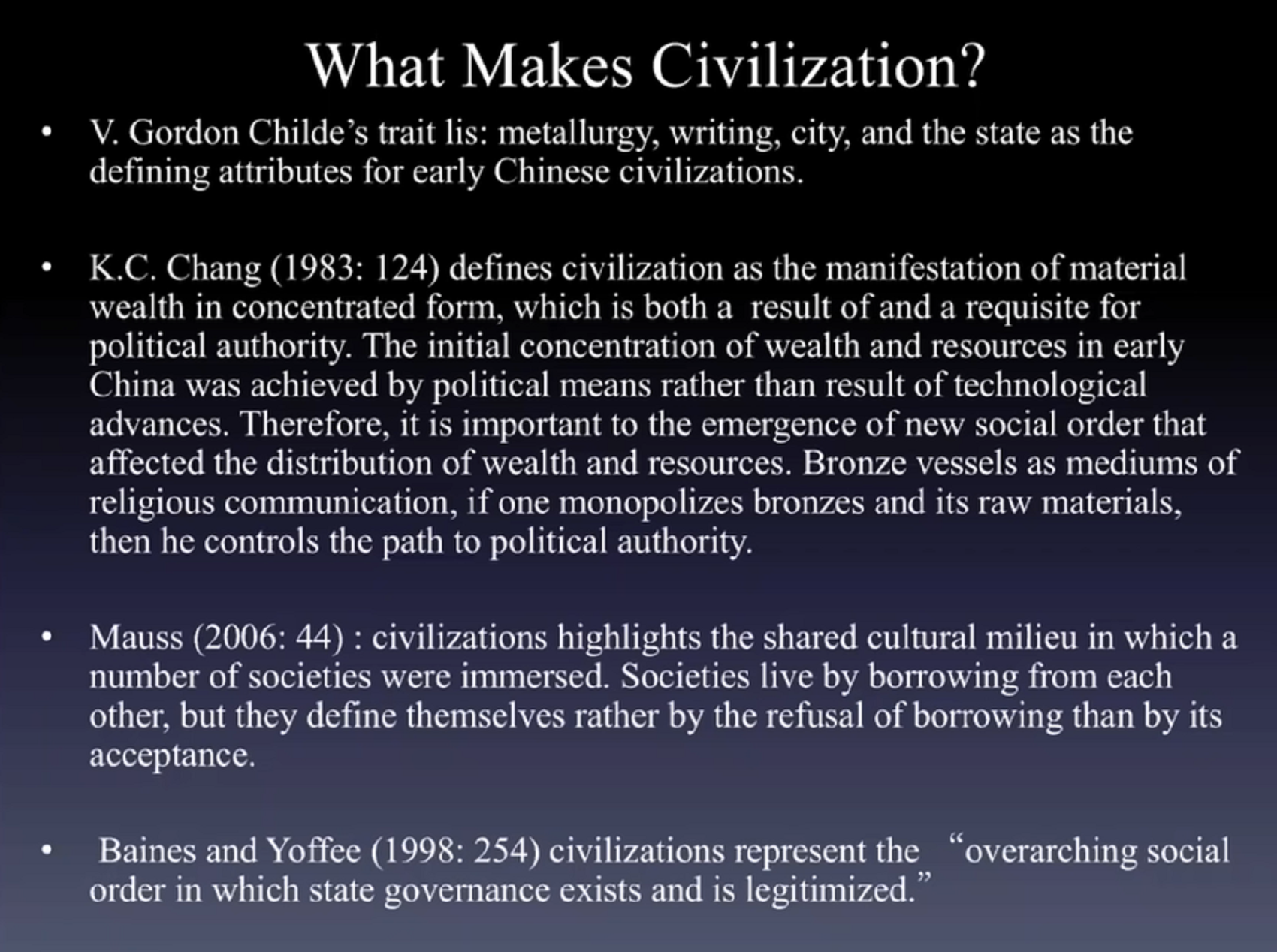
|
18000–7000 |
Xianren Cave culture |
仙人洞、吊桶环遗址 |
https://en.wikipedia.org/wiki/List_of_Neolithic_cultures_of_China
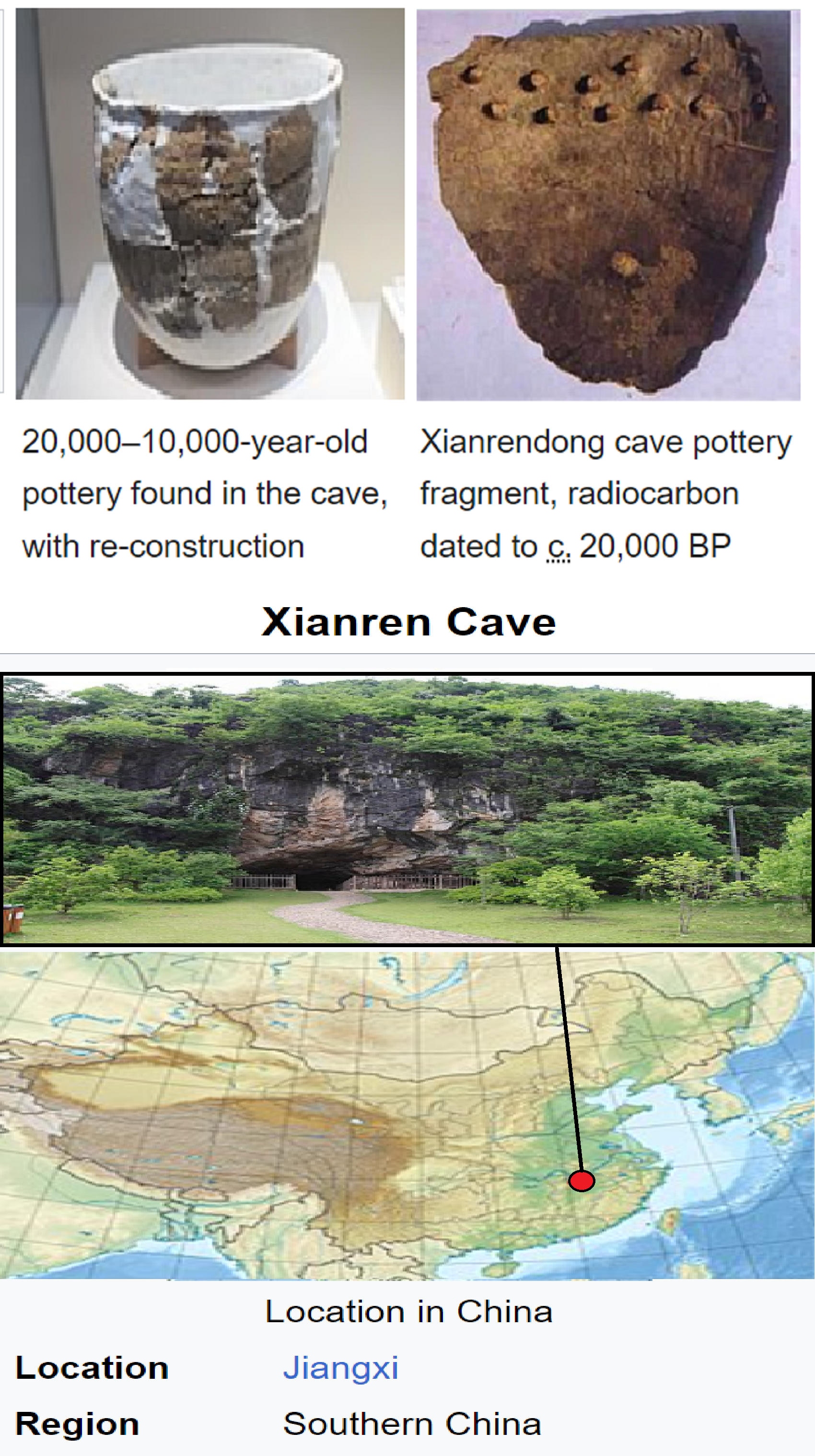
Chinese pottery dates to about 20,000 years BCE.
“China holds the earliest pottery yet known anywhere in the world was found at this site dating by radiocarbon to between 20,000 and 19,000 years ago. The carbon 14 datation was established by careful dating of surrounding sediments. Many of the pottery fragments had scorch marks, suggesting that the pottery was used for cooking. These early pottery containers were made well before the invention of agriculture (dated to 10,000 to 8,000 BC), by mobile foragers who hunted and gathered their food during the Late Glacial Maximum.” https://en.wikipedia.org/wiki/Xianren_Cave


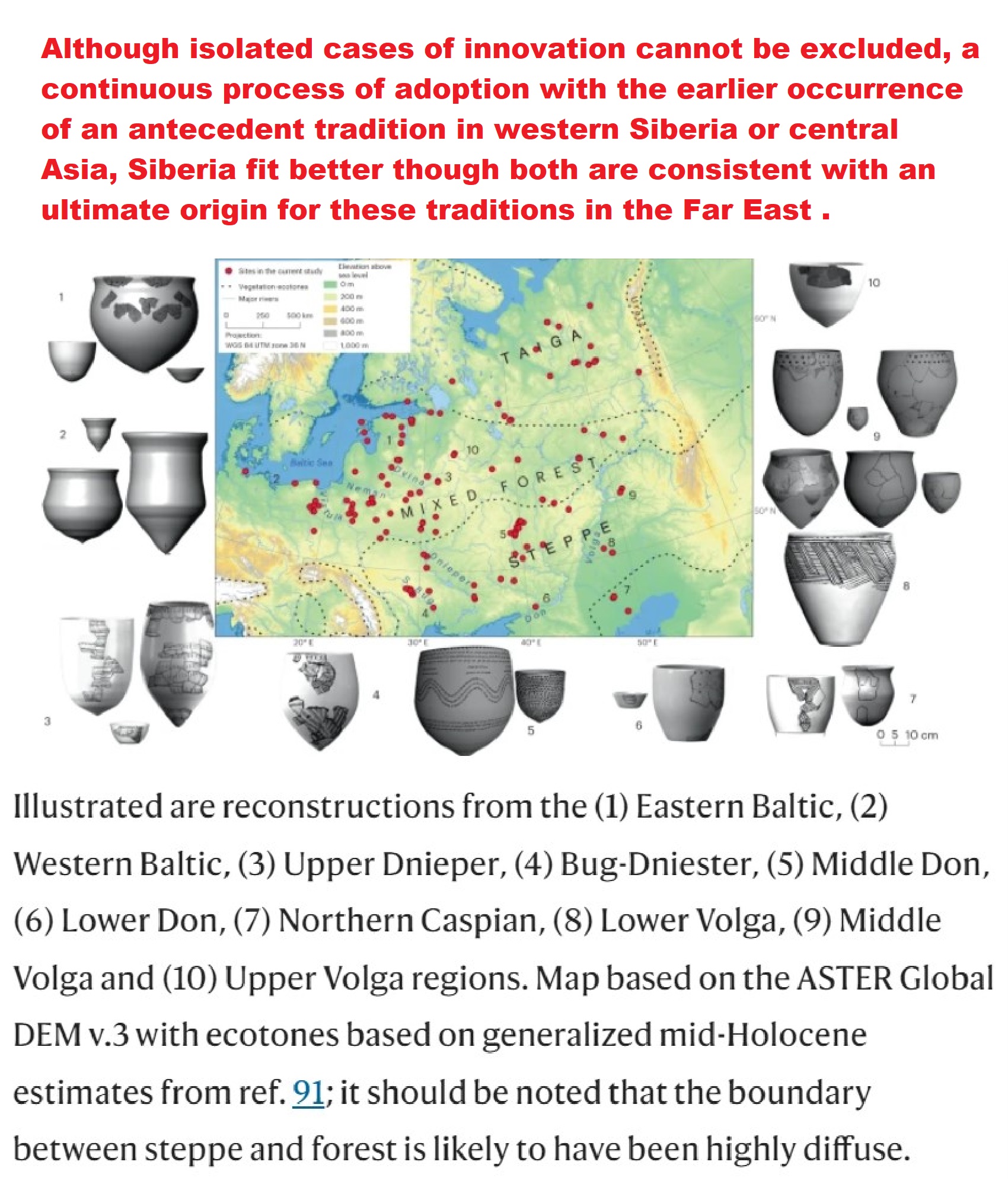
The transmission of pottery technology among prehistoric European hunter-gatherers
https://www.nature.com/articles/s41562-022-01491-8
“Although isolated cases of innovation cannot be excluded, a continuous process of adoption with the earlier occurrence of an antecedent tradition in western Siberia or central Asia, Siberia fit better though both are consistent with an ultimate origin for these traditions in the Far East.” ref
Show 2 “Early Neolithic” China: Ritual, Religion, and Civilization
Use time 6:30 to 8:24 https://www.youtube.com/watch?v=lz4EQ0iYDI4&t=413s
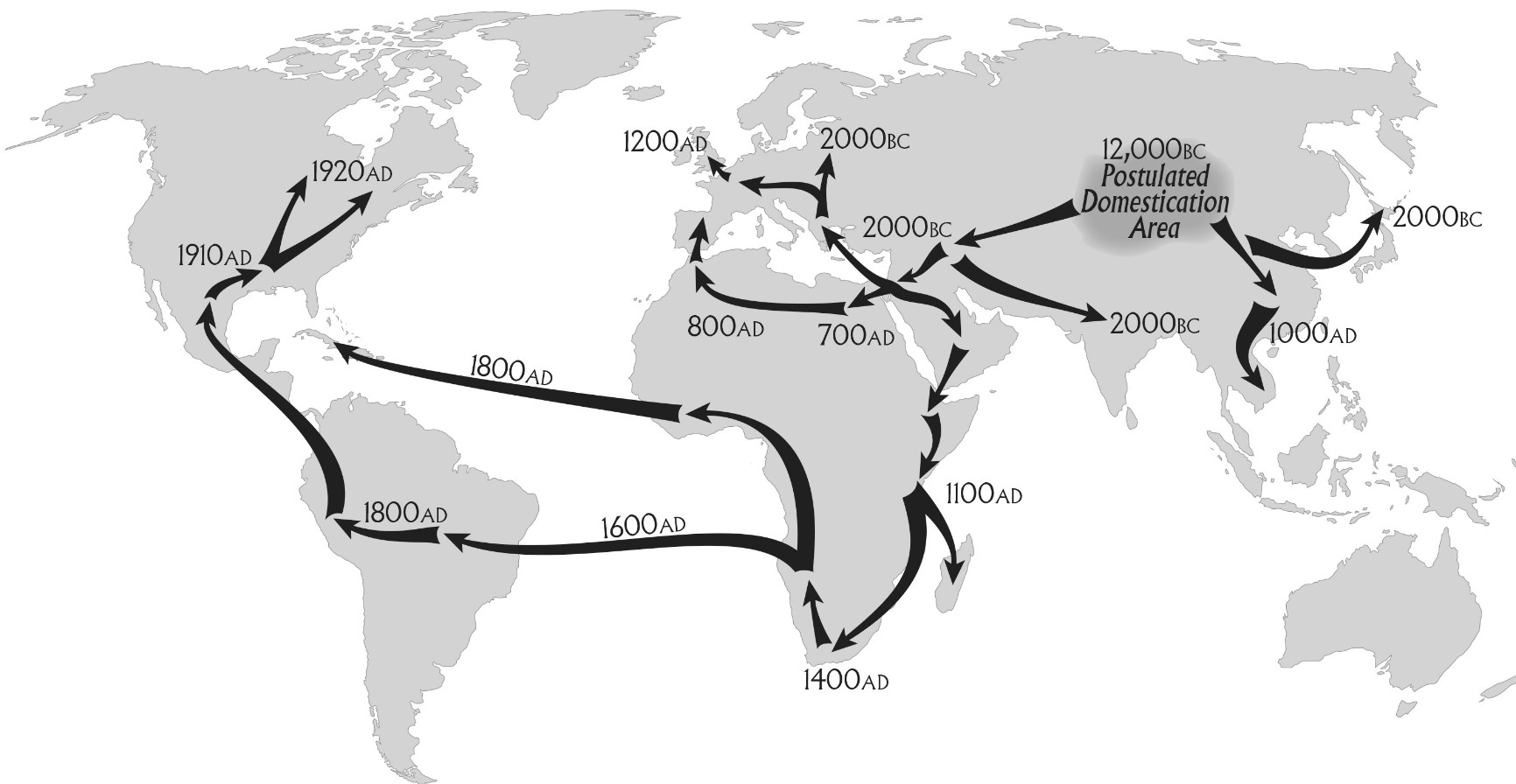
Starting in areas that included North China, the map shows the history of how cannabis traveled throughout the world.
“Hemp was also one of the first plants to be spun into usable fiber 50,000 years ago. It may also be one of the earliest plants to have been cultivated. The world-leading producer of hemp is China, which produces more than 70% of the world output.” ref
“Cannabis plants are believed to have evolved on the steppes of Central Asia, specifically in the regions that are now Mongolia and southern Siberia, according to Warf. The history of cannabis use goes back as far as 12,000 years, which places the plant among humanity’s oldest cultivated crops, according to information in the book “Marihuana: The First Twelve Thousand Years.” “It likely flourished in the nutrient-rich dump sites of prehistoric hunters and gatherers,” Warf wrote in his study.” ref
“Cannabis in China has been confirmed to have originated in Northwest China before the Ancient Chinese domesticated the plant to India and other parts of Asia, particularly the Central Asian steppe in 10,000 BCE or around 12,000 years ago.” ref
“Cannabis or marijuana, was first domesticated around 12,000 years ago in China, researchers found, after analyzing the genomes of plants from across the world. The study, published in the journal Science Advances on Friday, said the genomic history of cannabis domestication had been under-studied compared to other crop species, largely due to legal restrictions. The researchers compiled 110 whole genomes covering the full spectrum of wild-growing feral plants, landraces, historical cultivars, and modern hybrids of plants used for hemp and drug purposes.” ref
“Cannabis has a high nutritional content, which is why all parts of the plant, including the stem, seeds, roots, and flowers, have been used for food, feed, and therapeutic purposes for a long time.” ref
“The history of wheat from about 10,000 BCE or around 12,000 years ago and thought to have first been cultivated in the Fertile Crescent, an area in the Middle East spreading from Jordan, Palestine, and Lebanon to Syria, Turkey, Iraq, and Iran.” ref
“One of the first cultivated grains of the Fertile Crescent, barley was domesticated about 8000 BCE or around 10,000 years ago.” ref
“Earliest domestication of common millet (Panicum miliaceum) in East Asia extended to 10,000 years ago” ref
“Lentils were first cultivated in Southwest Asia 8000–10,000 years ago but archeological evidence is unclear as to how many times it may have been independently domesticated.” ref
“The earliest archaeological evidence of Rice comes from central and eastern China and dates to 7000–5000 BCE or around 9,000 to 7,000 years ago.” ref
“The study said it identified “the time and origin of domestication, post-domestication divergence patterns, and present-day genetic diversity”. “Researchers show that cannabis sativa was first domesticated in early Neolithic times in East Asia and that all current hemp and drug cultivars diverged from an ancestral gene pool currently represented by feral plants and landraces in China”. Cannabis has been used for millennia for things like textiles/clothing, nets/etc. and for its medicinal and recreational properties, not to mention its likely ritual use. The evolution of the cannabis genome suggests the plant was cultivated for multipurpose use over several millennia.” ref
“Our genomic dating suggests that early domesticated ancestors of hemp and drug types diverged from Basal cannabis”, around 12,000 years ago, “indicating that the species had already been domesticated by early Neolithic times”, it said. “Contrary to a widely-accepted view, which associates cannabis with a Central Asian center of crop domestication, our results are consistent with a single domestication origin of cannabis sativa in East Asia, in line with early archaeological evidence.” It said that some of the wild plants currently found in China represent the closest descendants of the ancestral gene pool from which hemp and marijuana varieties have since derived.” ref
“East Asia has been shown to be an important ancient hot spot of domestication for several crop species… our results thus add another line of evidence,” the study said. The researchers said their study offered an “unprecedented” base of genomic resources for ongoing molecular breeding and functional research, both in medicine and in agriculture. The study, they said, also “provides new insights into the domestication and global spread of a plant with divergent structural and biochemical products at a time in which there is a resurgence of interest in its use, reflecting changing social attitudes and corresponding challenges to its legal status in many countries.” ref
“For the most part, it was widely used for medicine and spiritual purposes,” during pre-modern times, said Warf, a professor of geography at the University of Kansas in Lawrence. “The idea that this is an evil drug is a very recent construction,” and the fact that it is illegal is a “historical anomaly,” Warf said. Marijuana has been legal in many regions of the world for most of its history.” ref
“The use of hemp in Taiwan dates back at least 10,000 years.” An archeological site in the Oki Islands near Japan contained cannabis achenes from about 8000 BCE or 10,000 years ago, probably signifying use of the plant.” ref
“The Peiligang culture was a Neolithic culture in the Yi-Luo river basin (in modern Henan Province, China) that existed from about 7000 to 5000 BCE or around 9,000 to 7,000 years ago. The Peiligang culture used nets made from hemp fibers. The site at Jiahu also with nets made of hemp fibers, is the earliest site associated with Peiligang culture.” ref, ref
“Hemp use archaeologically dates back to the Neolithic Age in China, with hemp fiber imprints found on Yangshao culture pottery dating from the 5th millennium BCE or around 7,000 to 6,000 years ago.” ref
“Both hemp and psychoactive marijuana were used widely in ancient China, Warf wrote. The first record of the drug’s medicinal use dates to 4000 BCE or around 6,000 years ago. Burned cannabis seeds have also been found in kurgan burial mounds in Siberia dating back to 3,000 BCE or around 5,000 years ago.” ref
“The medicinal properties of the cannabis plant have been known for millennia. As far back as 2800 BCE or around 4,800 years ago, cannabis was used to treat a vast array of health problems and was listed in Emperor Shen Nung’s pharmacopoeia. Cannabis has a long and colorful history. The use of cannabis originated in central Asia or western China. Cannabis has been used for its alleged healing properties for millennia. The first documented case of its use dates back to 2800 BCE, when it was listed in the Emperor Shen Nung’s (regarded as the father of Chinese medicine) pharmacopoeia. Therapeutic indications of cannabis are mentioned in the texts of the Indian Hindus, Assyrians, Greeks and Romans. Hindu legend holds that Shiva, the supreme Godhead of many sects, was given the title ‘The Lord of Bhang’, because the cannabis plant was his favorite food. The ancient Hindus thought the medicinal benefits of cannabis were explained by pleasing the gods such as Shiva. Ancient Hindu texts attribute the onset of fever with the ‘hot breath of the gods’ who were angered by the afflicted person’s behavior. Using cannabis in religious rites appeased the gods and hence reduced the fever.” ref
“The herb was used, for instance, as an anesthetic during surgery, and stories say it was even used by the Chinese Emperor Shen Nung in 2737 BCE. (However, whether Shen Nung was a real or a mythical figure has been debated, as the first emperor of a unified China was born much later than the supposed Shen Nung.) And some of the tombs of noble people buried in Xinjiang region of China and Siberia around 2500 BCE have included large quantities of mummified psychoactive marijuana.” ref
“Historically, cannabis has been used in China for fiber, seeds, as a traditional medicine, as well as for some ritual purposes within Taoism. Má (Mandarin pronunciation: [mǎ]), a Chinese word for cannabis, is represented by the Han character 麻. The term ma, used to describe medical marijuana by 2700 BCE or around 4,700 years ago, is the oldest recorded name for the hemp plant. The word ma has been used to describe the cannabis plant since before the invention of writing five-thousand years ago. Ma might share a common root with the Proto-Semitic word mrr, meaning “bitter.” Evidence of the earliest human cultivation of cannabis was found in Taiwan. Ancient Chinese prose and poems, including poetry in the Shi jing (Book of Odes), mention the word ma many times. An early song refers to young women weaving ma into clothing. The word ma is often paired with the Chinese word for “big” or “great” to form the compound word dama or 大麻 (dàmá). Dama is sometimes used to describe industrial hemp, as there is a negative connotation meaning “numbness” associated with the word ma by itself.” ref
“The current highly-specialized hemp and drug varieties are thought to come from selective cultures initiated about 4,000 years ago, optimized for the production of fibers or cannabinoids. The selection led to unbranched, tall hemp plants with more fiber in the main stem, and well-branched, short marijuana plants with more flowers, maximizing resin production.” ref
Archaeobotanical evidence of the use of medicinal cannabis in a secular context unearthed from south China
Abstract: “As one of the first plants used by ancient people, cannabis has been used for medicinal purposes for thousands of years. The long history of medicinal cannabis use contrasts with the paucity of archaeobotanical records. Moreover, physical evidence of medicinal cannabis use in a secular context is much rarer than evidence of medicinal cannabis use in religious or ritual activities, which impedes our understanding of the history of medicinal cannabis use. Plant remains were collected from the Laoguanshan Cemetery of the Han Dynasty in Chengdu, South China. The botanical remains were accurately identified as cannabis. More than 120 thousand fruits were found, which represents the largest amount of cannabis fruit remains that have been statistically analyzed from any cemetery in the world thus far.” ref
“Charred cannabis seeds that are more than 4,000 years old have been found in special braziers from graves at Gurbanesti and the northern Caucasus region in Eastern Europe. These seeds may be the earliest evidence of the intentional burning of cannabis for psychoactive use and may thus represent the first physical evidence of medicinal cannabis use (the non-psychoactive cannabis seeds remain after the psychoactive inflorescences and leaves have been burnt away). In addition, some remains from Central Asia, such as nearly 13 whole cannabis plants from Jiayi Cemetery, female inflorescences of cannabis from Yanghai Cemetery in the Xinjiang Uyghur Autonomous Region, Northwest China, and cannabis fruits from Pazyryk Cemetery in East Siberia, are thought to indicate the use of cannabis for medical purposes.” ref
“From China, coastal farmers brought pot to Korea about 2000 BCE at around 4,000 years ago, or earlier, according to the book “The Archeology of Korea. Cannabis came to the South Asian subcontinent between 2000 to 1000 BCE, when the region was invaded by the Indo-Iranian speaking peoples — a group that spoke an archaic Indo-European language. The drug became widely used in India, where it was celebrated as one of “five kingdoms of herbs … which release us from anxiety” in one of the ancient Sanskrit Vedic poems whose name translate into “Science of Charms.” ref
“From Asia to Europe, Cannabis came to the Middle East between 2000 to 1400 BCE or around 4,000 to 3,400 years ago, and it was probably used there by the Scythians, a nomadic Indo-European group. The Scythians also likely carried the drug into southeast Russia and Ukraine, as they occupied both territories for years, according to Warf’s report. Germanic tribes brought the drug into Germany, and marijuana went from there to Britain during the 5th century with the Anglo-Saxon invasions.” ref
“Different religions have varying stances on the use of cannabis, historically and presently. In ancient history some religions used cannabis as an entheogen, particularly in the Indian subcontinent where the tradition continues on a more limited basis. In Ancient Egypt there is a written record of the medicinal use of hemp. Thus the Ebers papyrus (written 1500 BCE or around 3,500 years ago) mentions the use of oil from hempseed to treat vaginal inflammation. Cannabis pollen was recovered from the tomb of Ramses II, who governed for sixty‐seven years during the 19th dynasty, and several mummies contain trace cannabinoids.” ref
“The Assyrians, Egyptians, and Hebrews, among other Semitic cultures of the Middle East, mostly acquired cannabis from Aryan cultures and have burned it as an incense as early as 1000 BCE or around 3,000 years ago. Cannabis has been used by shamanic and pagan cultures to ponder deeply religious and philosophical subjects related to their tribe or society, to achieve a form of enlightenment, to unravel unknown facts and realms of the human mind and subconscious, and also as an aphrodisiac during rituals or orgies. There are several references in Greek mythology to a powerful drug that eliminated anguish and sorrow. Herodotus wrote about early ceremonial practices by the Scythians, thought to have occurred from the 5th to 2nd century BCE or 2,500 to 2,200 years ago.” ref
“In addition, according to Herodotus, the Dacians and Scythians had a tradition where a fire was made in an enclosed space and cannabis seeds were burned and the resulting smoke ingested. In ancient Germanic paganism, cannabis was possibly associated with the Norse love goddess, Freya. Linguistics offers further evidence of prehistoric use of cannabis by Germanic peoples: The word hemp derives from Old English hænep, from Proto-Germanic *hanapiz. While *hanapiz has an unknown origin, some scholars believe it is a unreconstructed loanword of Scythian origin. The Greek word κάνναβις, which that cannabis derives from, is also thought to be a loanword of the same Scythian origin. While a loanword, *hanapiz was borrowed early enough to be affected by Grimm’s Law, by which Proto-Indo-European initial *k- becomes *h- in Germanic. The shift of *k→h indicates it was a loanword into the Germanic parent language at a time depth no later than the separation of Common Germanic from Proto-Indo-European, about 500 BCE or around 2,500 years ago.” ref
“People may have smoked marijuana in rituals 2,500 years ago in western China. Cannabis may have been altering minds at an ancient high-altitude cemetery, researchers say. Mourners gathered at a cemetery in what’s now western China around 2,500 years ago to inhale fumes of burning cannabis plants that wafted from small wooden containers. High levels of the psychoactive compound THC in those ignited plants, also known as marijuana, would have induced altered states of consciousness. Evidence of this practice comes from Jirzankal Cemetery in Central Asia’s Pamir Mountains, says a team led by archaeologist Yimin Yang of the University of Chinese Academy of Sciences in Beijing. Chemical residues on wooden burners unearthed in tombs there provide some of the oldest evidence to date of smoking or inhaling cannabis fumes, the researchers report online June 12 in Science Advances.” ref
“Rituals aimed at communicating with the dead or a spirit world likely included cannabis smoking, the team speculates. Cannabis remains of comparable age have been found in several other Central Asian tombs, including a site in Russia’s Altai Mountains located about 3,000 kilometers northwest of the Pamir Mountains. But the discoveries at Jirzankal Cemetery offer an unprecedented look at how cannabis was initially used as a mind-altering substance, the researchers say. East Asians grew cannabis starting at least 6,000 years ago, but only to consume the plants’ oily seeds and make clothing and rope out of cannabis fibers. Early cultivated cannabis varieties in East Asia and elsewhere, like most wild forms of the plant, contained low levels of THC and other mind-altering compounds.” ref
“Some of the earliest evidence for people smoking marijuana comes from the Greek historian Herodotus, who wrote of cannabis smoking roughly 2,500 years ago on the Central Asian steppes, about 2,000 kilometers west of the Pamir Mountains. But a determination of exactly when and where high-THC cannabis plants first developed and which people first smoked cannabis has long eluded scientists. Archaeological finds indicate that many burial practices had spread across Central and East Asia by around 2,500 years ago. So cannabis smoking at graveside ceremonies was likely part of that process, says archaeologist Michael Frachetti of Washington University in St. Louis, who did not participate in the new study. “At that time, the early Silk Road connected populations from Beijing to Venice,” he says.” ref
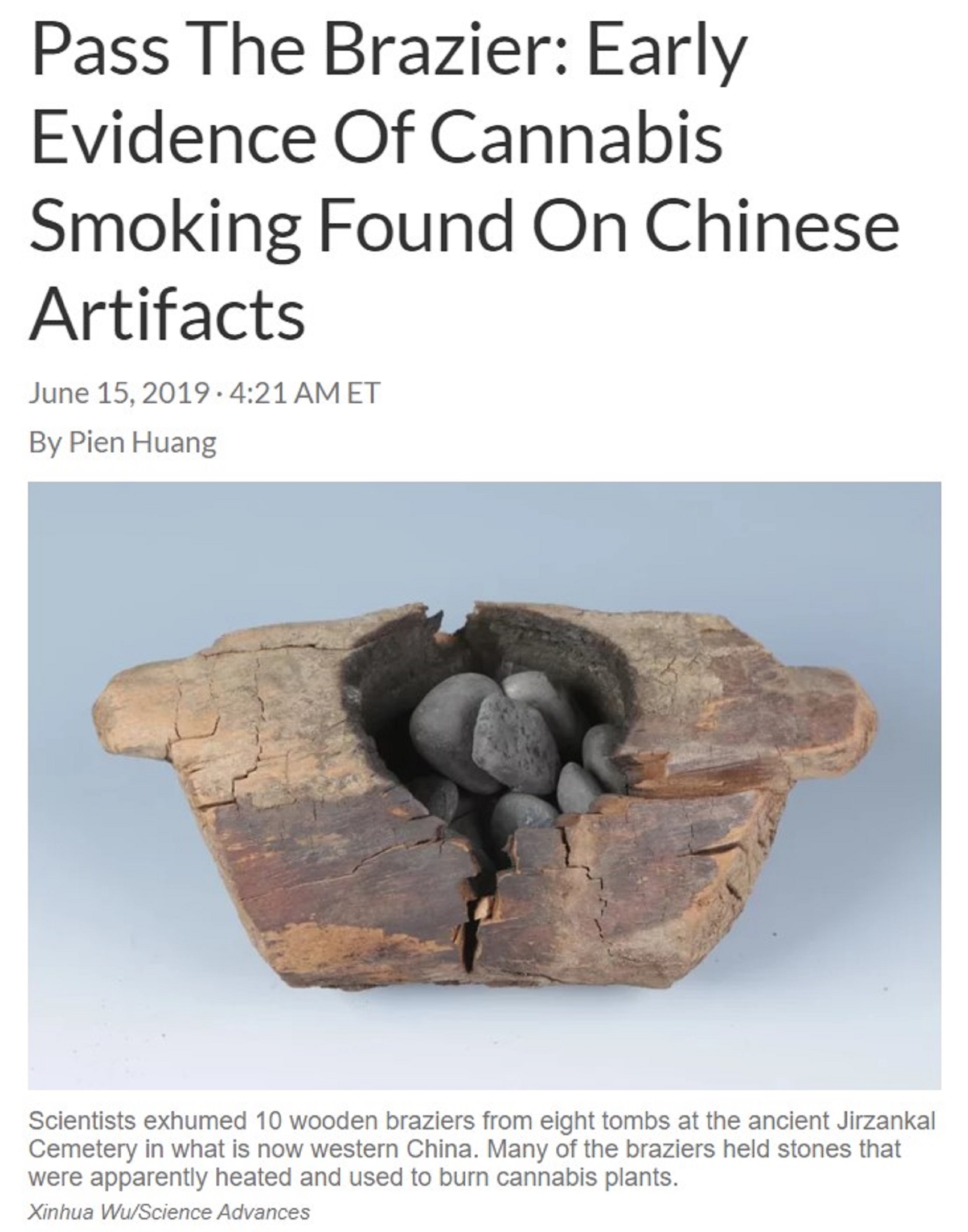
“People have been smoking pot to get high for at least 2,500 years. Chinese archaeologists found signs of that when they studied the char on a set of wooden bowls from an ancient cemetery in western China. The findings are some of the earliest evidence of cannabis used as a drug.” ref
“Historical Chinese medical texts (c. 200 CE) through contemporary twentieth century Chinese medical literature discuss individual terms for ma, including mafen (麻蕡), mahua (麻花), and mabo (麻勃), referring to specific parts of the male and female flowers of a cannabis plant with differing cannabinoid ratios. Beginning around the 4th century, Taoist texts mentioned using cannabis in censers.” ref
“Needham cited the (ca. 570 CE) Taoist encyclopedia Wushang Biyao 無上秘要 (“Supreme Secret Essentials”) that cannabis was added into ritual incense-burners, and suggested the ancient Taoists experimented systematically with “hallucinogenic smokes”. Joseph Needham connected myths about Magu, “the Hemp Damsel”, with early Daoist religious usages of cannabis, pointing out that Magu was goddess of Shandong’s sacred Mount Tai, where cannabis “was supposed to be gathered on the seventh day of the seventh month, a day of séance banquets in the Taoist communities.” ref
|
8500–7700 |
Nanzhuangtou culture |
南莊頭遺址 |
Yellow River region in southern Hebei |
|
7500–6100 |
Pengtoushan culture |
彭頭山文化 |
|
|
7000–5000 |
裴李崗文化 |
Yi-Luo river basin valley in Henan |
|
|
6500–5500 |
後李文化 |
||
|
6200–5400 |
興隆洼文化 |
Inner Mongolia–Liaoning border |
|
|
6000–5000 |
Kuahuqiao culture |
跨湖桥文化 |
|
|
6000–5500 |
磁山文化 |
southern Hebei |
|
|
5800–5400 |
大地灣文化 |
||
|
5500–4800 |
新樂文化 |
lower Liao River on the Liaodong Peninsula |
|
|
5400–4500 |
趙宝溝文化 |
Luan River valley in Inner Mongolia and northern Hebei |
|
|
5300–4100 |
北辛文化 |
https://en.wikipedia.org/wiki/List_of_Neolithic_cultures_of_China

ref, ref, ref, ref, ref, ref, ref, ref, ref, ref, ref, ref, ref, ref
1. Kebaran culture 23,022-16,522 Years Ago, 2. Kortik Tepe 12,422-11,722 Years Ago, 3. Jerf el-Ahmar 11,222 -10,722 Years Ago, 4. Gobekli Tepe 11,152-9,392 Years Ago, 5. Tell Al-‘abrUbaid and Uruk Periods, 6. Nevali Cori 10,422 -10,122 Years Ago, 7. Catal Hoyuk 9,522-7,722 Years Ago
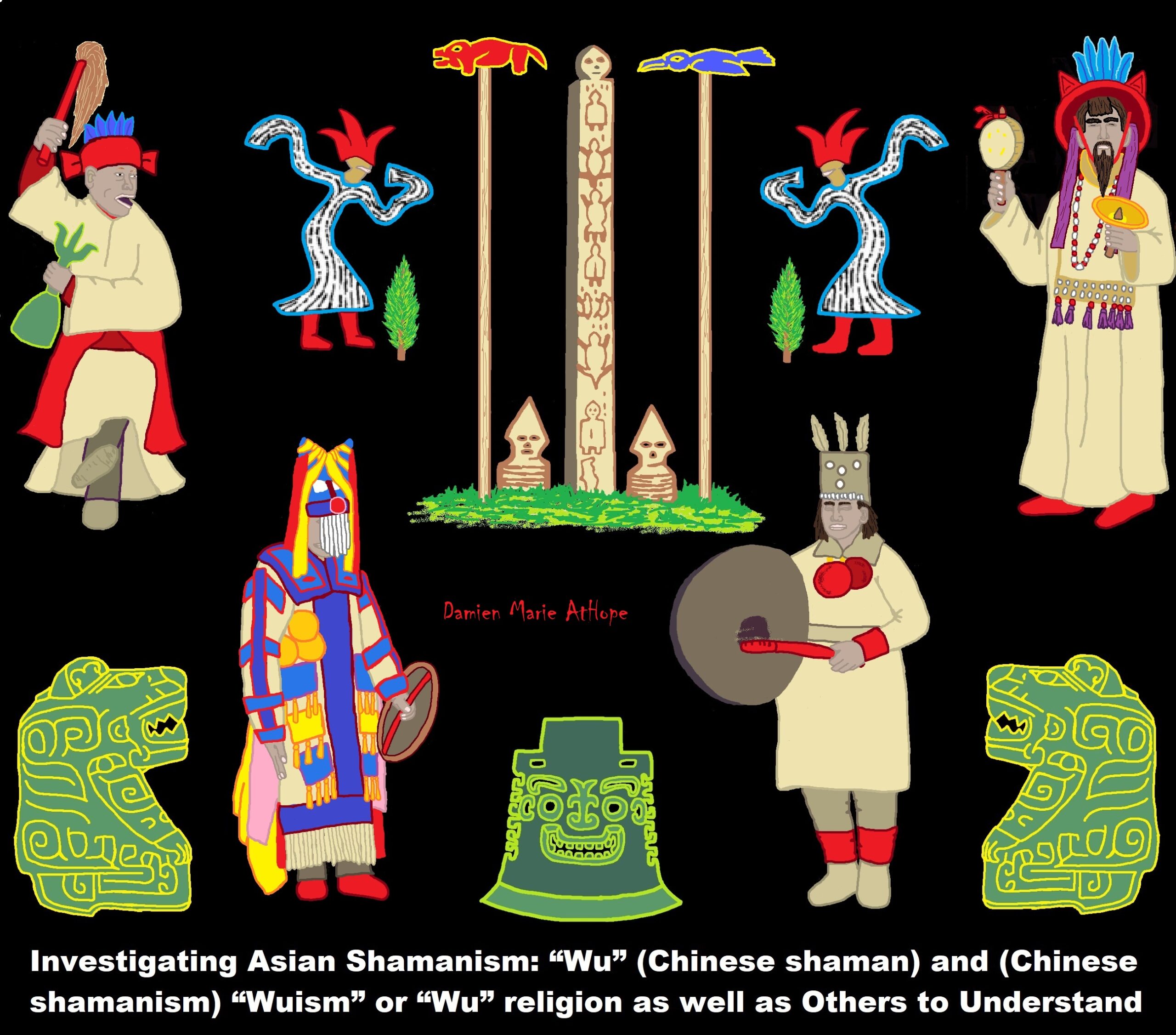
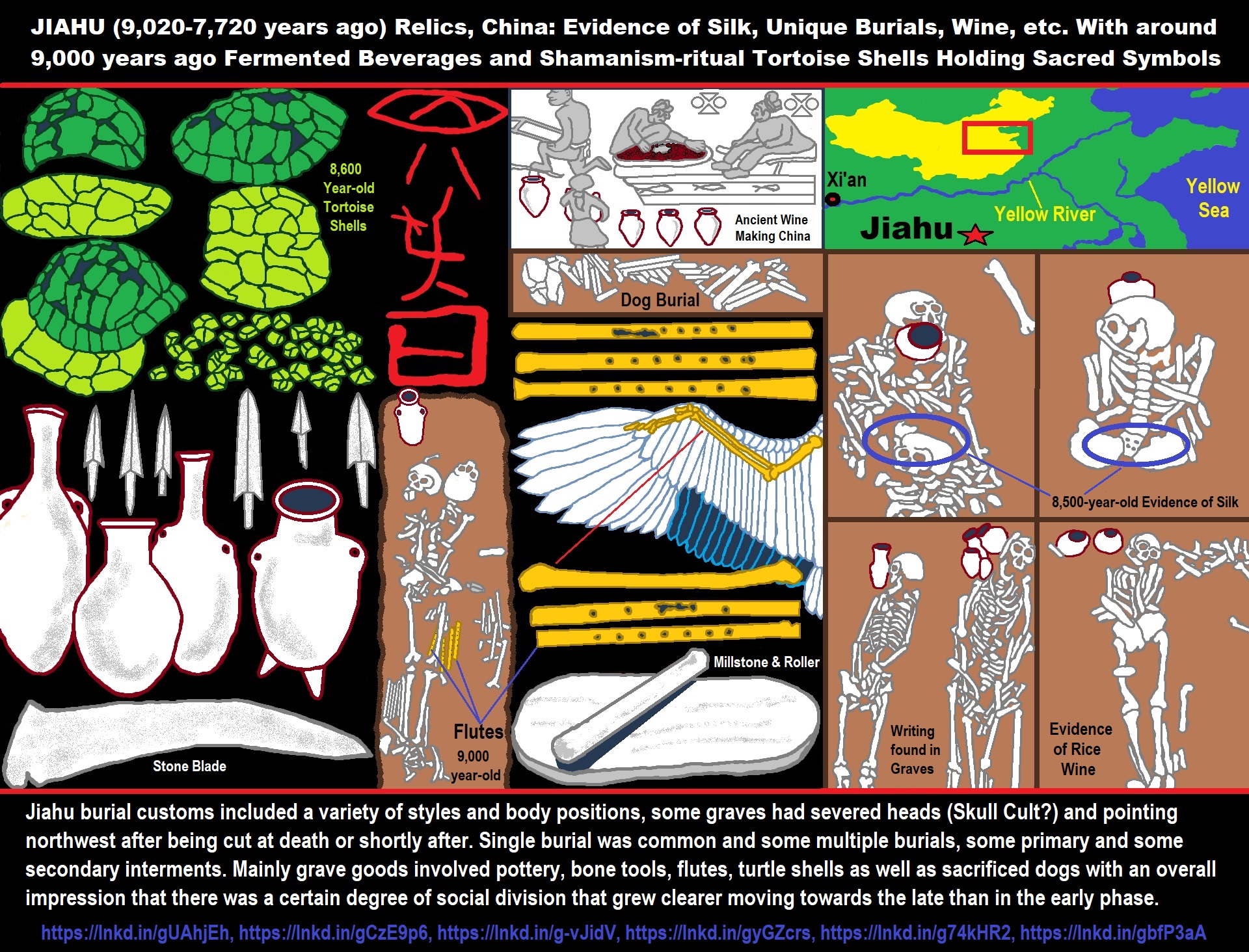
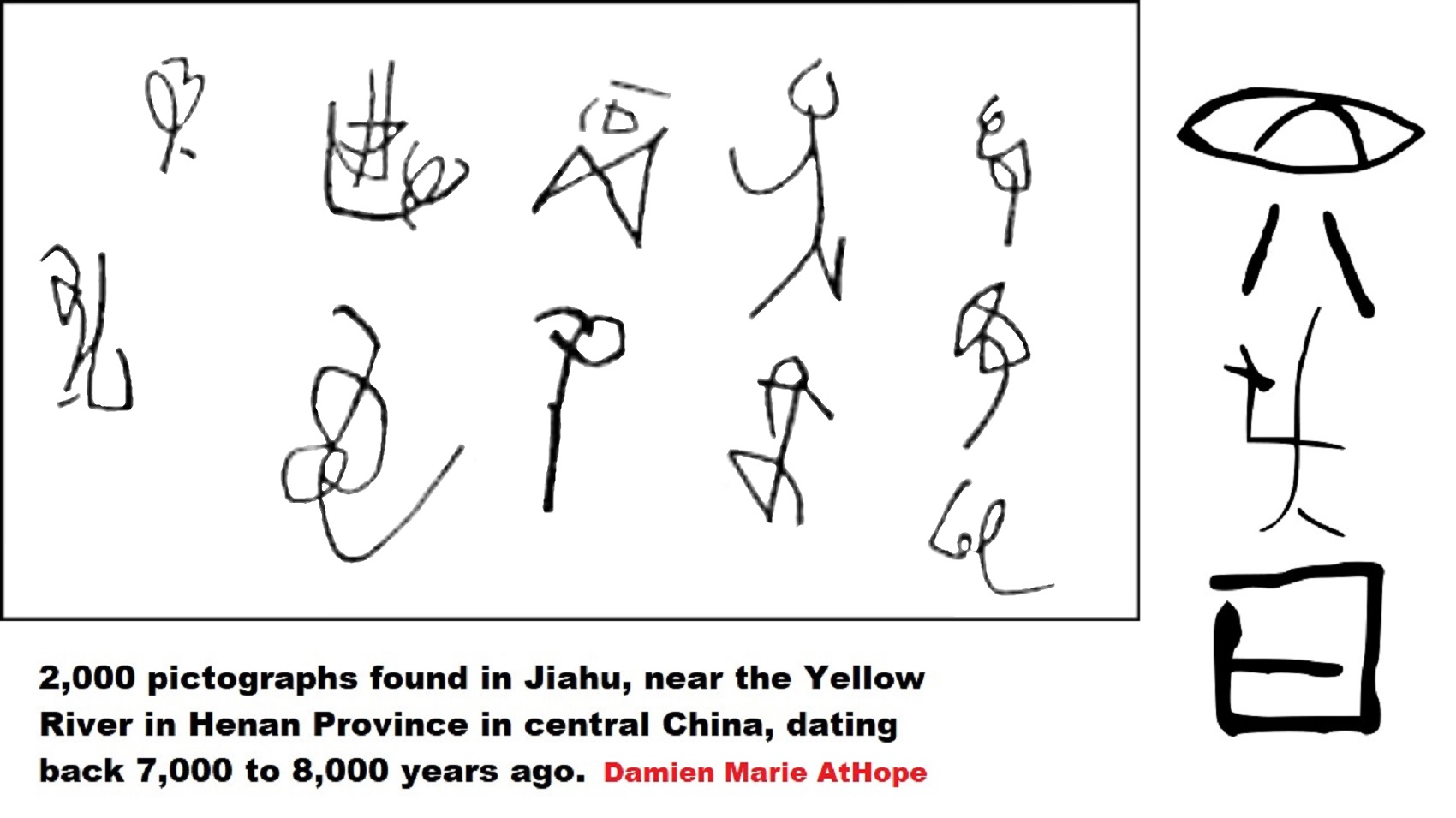
“Jiahu was the site of a Neolithic settlement based in the central plain of ancient China, near the Yellow River. Settled around 7000 BCE, the site was later flooded and abandoned around 5700 BCE. Jiahu symbols, possibly an early proto-writing.” https://en.wikipedia.org/wiki/Jiahu
“The Jiahu symbols consist of 16 distinct markings on prehistoric artifacts found in Jiahu, a neolithic Peiligang culture site found in Henan, China, and excavated in 1989. The Jiahu symbols are dated to around 6000 BCE.” https://en.wikipedia.org/wiki/Jiahu_symbols

Pic ref
Ancient Women Found in a Russian Cave Turn Out to Be Closely Related to The Modern Population https://www.sciencealert.com/ancient-women-found-in-a-russian-cave-turn-out-to-be-closely-related-to-the-modern-population
Abstract
“Ancient genomes have revolutionized our understanding of Holocene prehistory and, particularly, the Neolithic transition in western Eurasia. In contrast, East Asia has so far received little attention, despite representing a core region at which the Neolithic transition took place independently ~3 millennia after its onset in the Near East. We report genome-wide data from two hunter-gatherers from Devil’s Gate, an early Neolithic cave site (dated to ~7.7 thousand years ago) located in East Asia, on the border between Russia and Korea. Both of these individuals are genetically most similar to geographically close modern populations from the Amur Basin, all speaking Tungusic languages, and, in particular, to the Ulchi. The similarity to nearby modern populations and the low levels of additional genetic material in the Ulchi imply a high level of genetic continuity in this region during the Holocene, a pattern that markedly contrasts with that reported for Europe.” ref
“Six of seven individuals whose remains have been recovered from the cave have been DNA tested. Originally, three of the specimens were thought to be adult males, two were thought to be adult females, one was thought to be a sub-adult of about 12-13 years of age, and one was thought to be a juvenile of about 6-7 years of age based on the skeletal morphology of the remains. Results of genetic analysis of the sub-adult individual have not yet been published. However, two specimens, NEO236 (Skull B, DevilsGate2) and NEO235 (Skull G), who had been presumed to be adult males according to a forensic morphological assessment of their remains, were discovered through genetic analysis to actually be females. The juvenile specimen also has been determined to be female through genetic analysis. Three of the specimens (including the only adult male plus NEO235/Skull G and another adult female, labeled as Skull Е, DevilsGate1, or NEO240, who has been genetically determined to be a first-degree relative of NEO235/Skull G) have been assigned to mtDNA haplogroup D4m; a previous genetic analysis of one of these adult female specimens determined her mtDNA haplogroup to be D4. Another three specimens (including the juvenile female, the DevilsGate2 specimen, and another adult female; both the juvenile female and the DevilsGate2 specimen have been determined to be first-degree relatives of the other adult female, and the juvenile female and the DevilsGate2 specimen also have been determined to be second-degree relatives of each other) have been assigned to haplogroup D4; a previous genetic analysis of the DevilsGate2 specimen determined her mtDNA haplogroup to be M. The only specimen from the cave who has been confirmed to be male through genetic analysis has been assigned to Y-DNAhaplogroup C2b-F6273/Y6704/Y6708, equivalent to C2b-L1373, the northern (Central Asian, Siberian, and indigenous American) branch of haplogroup C2-M217.” ref
“The haplogroup C-M217 is now found at high frequencies among Central Asian peoples, indigenous Siberians, and some Native peoples of North America. Haplogroup C-M217 is the modal haplogroup among Mongolians and most indigenous populations of the Russian Far East, such as the Buryats, Northern Tungusic peoples, Nivkhs, Koryaks, and Itelmens. The subclade C-P39 is common among males of the indigenous North American peoples whose languages belong to the Na-Dené phylum. C2b1a1a P39 Canada,USA(Found in several indigenous peoples of North America, including some Na-Dené-,Algonquian-, orSiouan-speaking populations).” ref
“Males carrying C-M130 are believed to have migrated to the Americas some 6,000-8,000 years ago, and was carried by Na-Dené-speaking peoples into the northwest Pacific coast of North America. The distribution of Haplogroup C-M130 is generally limited to populations of Siberia, parts of East Asia, Oceania, and the Americas. Haplogroup C2 (M217) – the most numerous and widely dispersed C lineage – was once believed to have originated in Central Asia, spread from there into Northern Asia and the Americas while other theory it originated from East Asia. C-M217 stretches longitudinally from Central Europe and Turkey, to the Wayuu people of Colombia and Venezuela, and latitudinally from the Athabaskan peoples of Alaska to Vietnam to the Malay Archipelago. The highest frequencies of Haplogroup C-M217 are found among the populations of Mongolia and Far East Russia, where it is the modal haplogroup. Haplogroup C-M217 is the only variety of Haplogroup C-M130 to be found among Native Americans, among whom it reaches its highest frequency in Na-Dené populations.” ref
Origins of ‘Transeurasian’ languages traced to Neolithic millet farmers in north-eastern China about 9,000 years ago
“A study combining linguistic, genetic, and archaeological evidence has traced the origins of a family of languages including modern Japanese, Korean, Turkish and Mongolian and the people who speak them to millet farmers who inhabited a region in north-eastern China about 9,000 years ago. The findings outlined on Wednesday document a shared genetic ancestry for the hundreds of millions of people who speak what the researchers call Transeurasian languages across an area stretching more than 5,000 miles (8,000km).” ref
“Millet was an important early crop as hunter-gatherers transitioned to an agricultural lifestyle. There are 98 Transeurasian languages, including Korean, Japanese, and various Turkic languages in parts of Europe, Anatolia, Central Asia, and Siberia, various Mongolic languages, and various Tungusic languages in Manchuria and Siberia. This language family’s beginnings were traced to Neolithic millet farmers in the Liao River valley, an area encompassing parts of the Chinese provinces of Liaoning and Jilin and the region of Inner Mongolia. As these farmers moved across north-eastern Asia over thousands of years, the descendant languages spread north and west into Siberia and the steppes and east into the Korean peninsula and over the sea to the Japanese archipelago.” ref
“Eurasiatic is a proposed language with many language families historically spoken in northern, western, and southern Eurasia; which typically include Altaic (Mongolic, Tungusic, and Turkic), Chukchi-Kamchatkan, Eskimo–Aleut, Indo-European, and Uralic.” ref
“Voiced stops such as /d/ occur in the Indo-European, Yeniseian, Turkic, Mongolian, Tungusic, Japonic and Sino-Tibetan languages. They have also later arisen in several branches of Uralic.” ref
“Uralo-Siberian is a hypothetical language family of Uralic, Yukaghir, Eskimo–Aleut and besides linguistic evidence, several genetic studies, support a common origin in Northeast Asia.” ref
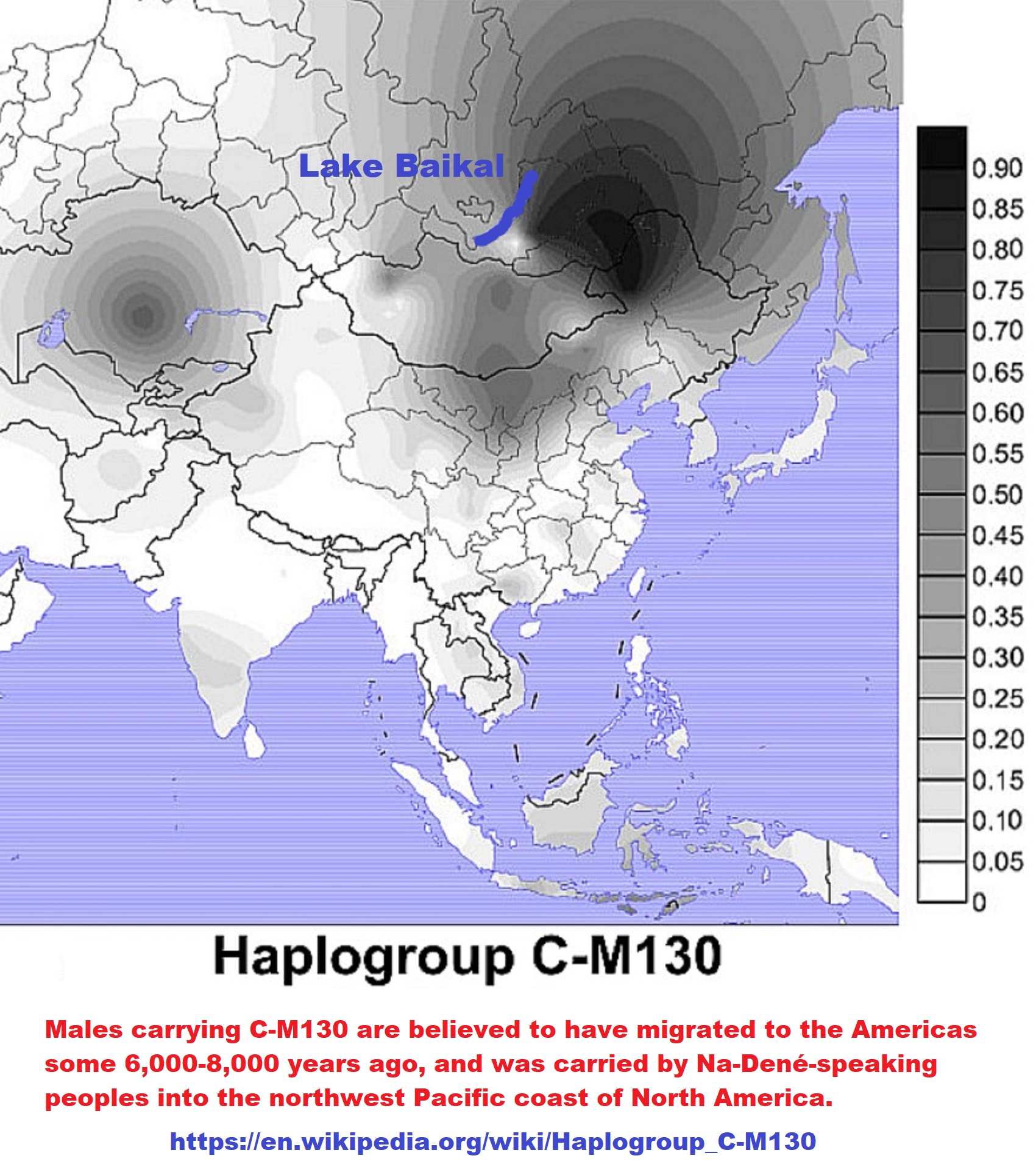
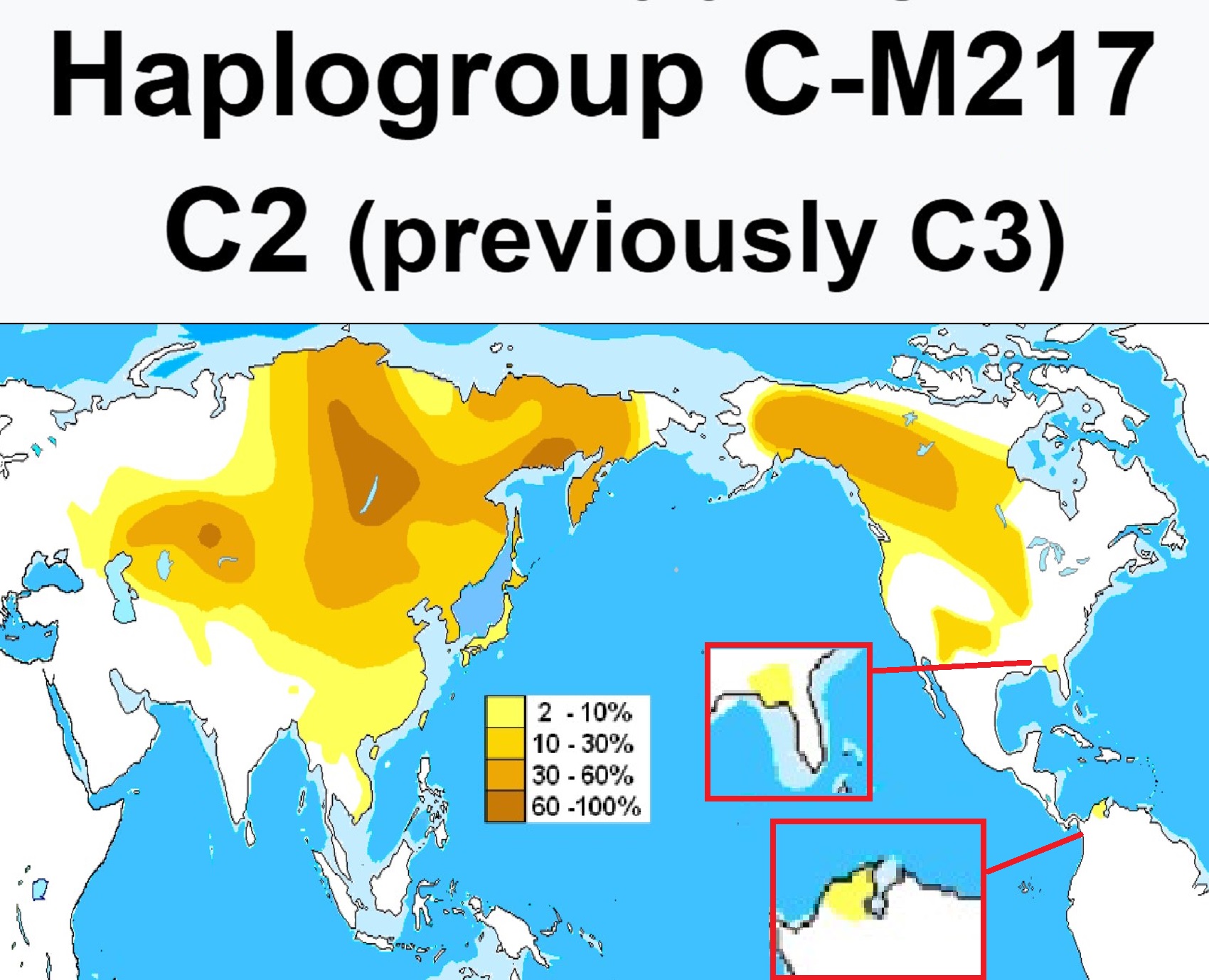

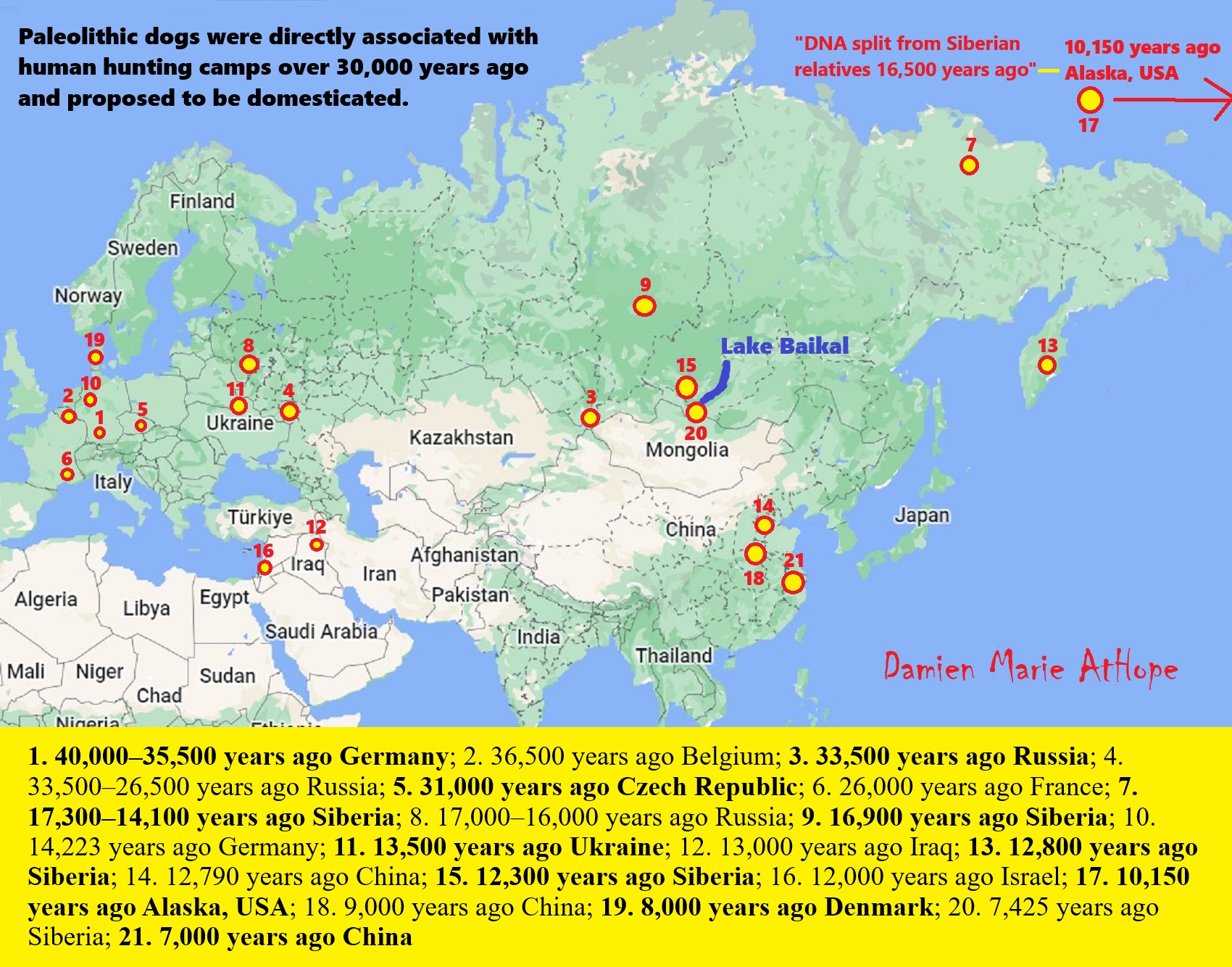
“The Paleolithic dog was a Late Pleistocene canine. They were directly associated with human hunting camps in Europe over 30,000 years ago and it is proposed that these were domesticated. They are further proposed to be either a proto-dog and the ancestor of the domestic dog or an extinct, morphologically and genetically divergent wolf population. There are a number of recently discovered specimens which are proposed as being Paleolithic dogs, however, their taxonomy is debated. These have been found in either Europe or Siberia and date 40,000–17,000 years ago. They include Hohle Fels in Germany, Goyet Caves in Belgium, Predmosti in the Czech Republic, and four sites in Russia: Razboinichya Cave in the Altai Republic, Kostyonki-8, Ulakhan Sular in the Sakha Republic, and Eliseevichi 1 on the Russian plain.” ref
1. 40,000–35,500 years ago Hohle Fels, Schelklingen, Germany
2. 36,500 years ago Goyet Caves, Samson River Valley, Belgium
3. 33,500 years ago Razboinichya Cave, Altai Mountains, (Russia/Siberia)
4. 33,500–26,500 years ago Kostyonki-Borshchyovo archaeological complex, (Kostenki site) Voronezh, Russia
5. 31,000 years ago Predmostí, Moravia, Czech Republic
6. 26,000 years ago Chauvet Cave, Vallon-Pont-d’Arc, Ardèche region, France
7. 17,300–14,100 years ago Dyuktai Cave, northern Yakutia, Siberia
8. 17,000–16,000 years ago Eliseevichi-I site, Bryansk Region, Russian Plain, Russia
9. 16,900 years ago Afontova Gora-1, Yenisei River, southern Siberia
10. 14,223 years ago Bonn–Oberkassel, Germany
11. 13,500 years ago Mezine, Chernigov region, Ukraine
12. 13,000 years ago Palegawra, (Zarzian culture) Iraq
13. 12,800 years ago Ushki I, Kamchatka, eastern Siberia
14. 12,790 years ago Nanzhuangtou, China
15. 12,300 years ago Ust’-Khaita site, Baikal region, Siberia
16. 12,000 years ago Ain Mallaha (Eynan) and HaYonim terrace, Israel
17. 10,150 years ago Lawyer’s Cave, Alaska, USA
18. 9,000 years ago Jiahu site, China
19. 8,000 years ago Svaerdborg site, Denmark
20. 7,425 years ago Lake Baikal region, Siberia
21. 7,000 years ago Tianluoshan archaeological site, Zhejiang province, China ref
1. 40,000–35,500 years ago Hohle Fels, Schelklingen, Germany
“Canid maxillary fragment. The size of the molars matches those of a wolf, the morphology matches a dog. Proposed as a Paleolithic dog. The figurine Venus of Hohle Fels was discovered in this cave and dated to this time.” ref
2. 36,500 years ago Goyet Caves, Samson River Valley, Belgium
“The “Goyet dog” is proposed as being a Paleolithic dog. The Goyet skull is very similar in shape to that of the Eliseevichi-I dog skulls (16,900 years ago) and to the Epigravettian Mezin 5490 and Mezhirich dog skulls (13,500 years ago), which are about 18,000 years younger. The dog-like skull was found in a side gallery of the cave, and Palaeolithic artifacts in this system of caves date from the Mousterian, Aurignacian, Gravettian, and Magdalenian, which indicates recurrent occupations of the cave from the Pleniglacial until the Late Glacial. The Goyet dog left no descendants, and its genetic classification is inconclusive because its mitochondrial DNA (mDNA) does not match any living wolf nor dog. It may represent an aborted domestication event or phenotypically and genetically distinct wolves. A genome-wide study of a 35,000-year-old Pleistocene wolf fossil from northern Siberia indicates that the dog and the modern grey wolf genetically diverged from a common ancestor between 27,000 and 40,000 years ago.” ref
3. 33,500 years ago Razboinichya Cave, Altai Mountains, (Russia/Siberia)
“The “Altai dog” is proposed as being a Paleolithic dog. The specimens discovered were a dog-like skull, mandibles (both sides), and teeth. The morphological classification, and an initial mDNA analysis, found it to be a dog. A later study of its mDNA was inconclusive, with 2 analyses indicating dog and another 2 indicating wolf. In 2017, two prominent evolutionary biologists reviewed the evidence and supported the Altai dog as being a dog from a lineage that is now extinct and that was derived from a population of small wolves that are also now extinct.” ref
4. 33,500–26,500 years ago Kostyonki-Borshchyovo archaeological complex, (Kostenki site) Voronezh, Russia
“One left mandible paired with the right maxilla, proposed as a Paleolithic dog.” ref
5. 31,000 years ago Predmostí, Moravia, Czech Republic
“Three dog-like skulls proposed as being Paleolithic dogs. Predmostí is a Gravettian site. The skulls were found in the human burial zone and identified as Palaeolithic dogs, characterized by – compared to wolves – short skulls, short snouts, wide palates and braincases, and even-sized carnassials. Wolf skulls were also found at the site. One dog had been buried with a bone placed carefully in its mouth. The presence of dogs buried with humans at this Gravettian site corroborates the hypothesis that domestication began long before the Late Glacial. Further analysis of bone collagen and dental microwear on tooth enamel indicates that these canines had a different diet when compared with wolves (refer under diet).” ref
6. 26,000 years ago Chauvet Cave, Vallon-Pont-d’Arc, Ardèche region, France
“50-metre trail of footprints made by a boy of about ten years of age alongside those of a large canid. The size and position of the canid’s shortened middle toe in relation to its pads indicate a dog rather than a wolf. The footprints have been dated by soot deposited from the torch the child was carrying. The cave is famous for its cave paintings. A later study using geometric morphometric analysis to compare modern wolves with modern dog tracks proposes that these are wolf tracks.” ref
7. 17,300–14,100 years ago Dyuktai Cave, northern Yakutia, Siberia
“Large canid remains along with human artifacts. And from a nearby site dating to around 17,200–16,800 Ulakhan Sular, northern Yakutia, Siberia held a fossil dog-like skull similar in size to the “Altai dog”, proposed as a Paleolithic dog.” ref
8. 17,000–16,000 years ago Eliseevichi-I site, Bryansk Region, Russian Plain, Russia
“Two fossil canine skulls proposed as being Paleolithic dogs. In 2002, a study looked at the fossil skulls of two large canids that had been found buried 2 meters and 7 meters from what was once a mammoth-bone hut at this Upper Paleolithic site, and using an accepted morphologically based definition of domestication declared them to be “Ice Age dogs”. The carbon dating gave a calendar-year age estimate that ranged between 16,945 and 13,905 years ago. The Eliseevichi-1 skull is very similar in shape to the Goyet skull (36,000 years ago), the Mezine dog skull (13,500 years ago) and Mezhirich dog skull (13,500 years ago). In 2013, a study looked at the mDNA sequence for one of these skulls and identified it as Canis lupus familiaris i.e. dog. However, in 2015 a study using three-dimensional geometric morphometric analyses indicated the skull is more likely from a wolf. These animals were larger in size than most grey wolves and approached the size of a Great Dane.” ref
9. 16,900 years ago Afontova Gora-1, Yenisei River, southern Siberia
“Fossil dog-like tibia, proposed as a Paleolithic dog. The site is on the western bank of the Yenisei River about 2,500 km southwest of Ulakhan Sular, and shares a similar timeframe to that canid. A skull from this site described as dog-like has been lost in the past, but there exists a written description of it possessing a wide snout and a clear stop, with a skull length of 23 cm that falls outside of those of wolves.” ref
“Afontova Gora is a Late Upper Paleolithic and Mesolithic Siberian complex of archaeological sites located on the left bank of the Yenisei River near the city of Krasnoyarsk, Russia. Afontova Gora 3 carries are at the root of the classic European blond hair mutation, as massive population migrations from the Eurasian steppe, by a people who had substantial Ancient North Eurasian ancestry, entered continental Europe. Afontova Gora has cultural and genetic links to the people from Mal’ta-Buret’ culture. In a 2016 study, researchers determined that Afontova Gora 2, Afontova Gora 3, and Mal’ta 1 (Mal’ta boy) shared common descent and were clustered together in a Mal’ta cluster. The individual showed close genetic affinities to Mal’ta 1 (Mal’ta boy). Afontova Gora 2 also showed greater genetic affinity for the Karitiana people an indigenous people of Brazil, than for the Han Chinese.” ref
“Since the term ‘Ancient North Eurasian’ refers to a genetic bridge of connected mating networks, scholars of comparative mythology have argued that they probably shared myths and beliefs that could be reconstructed via the comparison of stories attested within cultures that were not in contact for millennia and stretched from the Pontic–Caspian steppe to the American continent. The mytheme of the dog guarding the Otherworld possibly stems from an older Ancient North Eurasian belief, as suggested by similar motifs found in Indo-European, Native American and Siberian mythology. In Siouan, Algonquian, Iroquoian, and in Central and South American beliefs, a fierce guard dog was located in the Milky Way, perceived as the path of souls in the afterlife, and getting past it was a test. The Siberian Chukchi and Tungus believed in a guardian-of-the-afterlife dog and a spirit dog that would absorb the dead man’s soul and act as a guide in the afterlife. In Indo-European myths, the figure of the dog is embodied by Cerberus, Sarvarā, and Garmr. In Zoroastrianism, two four-eyed dogs guard the bridge to the afterlife called Chinvat Bridge. Anthony and Brown note that it might be one of the oldest mythemes recoverable through comparative mythology. A second canid-related series of beliefs, myths and rituals connected dogs with healing rather than death. For instance, Ancient Near Eastern and Turkic–Kipchaq myths are prone to associate dogs with healing and generally categorised dogs as impure. A similar myth-pattern is assumed for the Eneolithic site of Botai in Kazakhstan, dated to 3500 BCE, which might represent the dog as absorber of illness and guardian of the household against disease and evil. In Mesopotamia, the goddess Nintinugga, associated with healing, was accompanied or symbolized by dogs. Similar absorbent-puppy healing and sacrifice rituals were practiced in Greece and Italy, among the Hittites, again possibly influenced by Near Eastern traditions.” ref
10. 14,223 years ago Bonn–Oberkassel, Germany
“The “Bonn-Oberkassel dog“. Undisputed dog skeleton buried with a man and woman. All three skeletal remains were found sprayed with red hematite powder. The consensus is that a dog was buried along with two humans. Analysis of mDNA indicates that this dog was a direct ancestor of modern dogs. Domestic dog.” ref
11. 13,500 years ago Mezine, Chernigov region, Ukraine
“Ancient dog-like skull proposed as being a Paleolithic dog. Additionally, ancient wolf specimens were found at the site. Dated to the Epigravettian period (17,000–10,000 years ago). The Mezine skull is very similar in shape to the Goyet skull (36,000 years ago), the Eliseevichi-1 dog skulls (16,900 years ago), and the Mezhirich dog skull (13,500 years ago). The Epigravettian Mezine site is well known for its round mammoth bone dwelling. Taxonomy uncertain.” ref
12. 13,000 years ago Palegawra, (Zarzian culture) Iraq
“The fossil jaw and teeth of a domesticated dog, recovered from a cave in Iraq, have been found to be about 14,000 years old. The bone was found in a shallow cave with a number of stone tools suggesting that its keepers were hunters. The scientists who found and studied the bone speculated that the animal served either as a hunting dog in the field or as a watchdog back at the cave or perhaps as both.” ref, ref
13. 12,800 years ago Ushki I, Kamchatka, eastern Siberia
“Complete skeleton buried in a buried dwelling. Located 1,800 km to the southeast from Ulakhan Sular. Domestic dog.” ref
14. 12,790 years ago Nanzhuangtou, China
“31 fragments including a complete dog mandible.” ref
“Nanzhuangtou, dated to 12,600–11,300 years ago an Initial Neolithic site near Lake Baiyangdian in Xushui County, Hebei, China. The site was discovered under a peat bog. Over 47 pieces of pottery were discovered at the site. Nanzhuangtou is also the earliest Neolithic site yet discovered in northern China. There is evidence that the people at Nanzhuangtou had domestic dogs 10,000 years ago. Stone grinding slabs and rollers and bone artifacts were also discovered at the site. It is one of the earliest sites showing evidence of millet cultivation dating to 10,500 years ago. Pottery can also be dated to 10,200 years ago.” ref
“At a nearby location of Lingjing (Henan, China) was found bird carving, with a probable age estimated to 13,500 years old. The carving, which predates previously known comparable instances from this region by 8,500 years.” ref
Damien finds both the dogs likely from Siberia and possibly the bird mythology that came to inspire the bird art.
“N moved from southern China 20,000 years ago involving the earliest pottery, then spreading pottery into Siberia starting around 14,000 years ago, and N has experienced serial bottlenecks in Siberia and secondary expansions in eastern Europe. Haplogroup N-M46 is approximately 14,000 years old. In Siberia, haplogroup N-M46 reaches a maximum frequency of approximately 90% among the Yakuts, a Turkic people who live mainly in the Sakha (Yakutia) Republic. However, N-M46 is present with much lower frequency among many of the Yakuts’ neighbors, such as Evenks and Evens. The haplogroup N-M46 has a low diversity among Yakuts suggestive of a population bottleneck or founder effect. This was confirmed by a study of ancient DNA which traced the origins of the male Yakut lineages to a small group of horse-riders from the Cis-Baikal area.” ref
15. 12,300 years ago Ust’-Khaita site, Baikal region, Siberia
“Sub-adult skull located 2,400 km southwest of Ulakhan Sular and proposed as a Paleolithic dog. Also a somewhat close find at 12,450 years old mummified dog carcass. The “Black Dog of Tumat” was found frozen into the ice core of an oxbow lake steep ravine at the middle course of the Syalaah River in the Ust-Yana region. DNA analysis confirmed it as an early dog.” ref The Archaeology of Ushki Lake, Kamchatka, and the Pleistocene Peopling of the Americas: The Ushki Paleolithic sites of Kamchatka, Russia, have long been thought to contain information critical to the peopling of the Americas, especially the origins of Clovis. New radiocarbon dates indicate that human occupation of Ushki began only 13,000 calendar years ago-nearly 4000 years later than previously thought. Although biface industries were widespread across Beringia contemporaneous to the time of Clovis in western North America, these data suggest that late-glacial Siberians did not spread into Beringia until the end of the Pleistocene, perhaps too recently to have been ancestral to proposed pre-Clovis populations in the Americas.” ref
16. 12,000 years ago Ain Mallaha (Eynan) and HaYonim terrace, Israel
“Three canid finds. A diminutive carnassial and a mandible, and a wolf or dog puppy skeleton buried with a human during the Natufian culture. These Natufian dogs did not exhibit tooth-crowding. The Natufian culture occupied the Levant, and had earlier interred a fox together with a human in the Uyun al-Hammam burial site, Jordan dated 17,700–14,750 years ago.” ref
17. 10,150 years ago Lawyer’s Cave, Alaska, USA
“Bone of a dog, oldest find in North America. DNA indicates a split from Siberian relatives 16,500 years ago, indicating that dogs may have been in Beringia earlier. Lawyer’s Cave is on the Alaskan mainland east of Wrangell Island in the Alexander Archipelago of southeast Alaska.” ref
18. 9,000 years ago Jiahu site, China
“Eleven dog interments. Jaihu is a Neolithic site 22 kilometers north of Wuyang in Henan Province.” ref Most archaeologists consider the Jaihu site to be one of the earliest examples of the Peiligang culture. Settled around 7000 BCE or around 9,000 years ago, the site was later flooded and abandoned around 5700 BCE or around 7,700 years ago. At one time, it was “a complex, highly organized Chinese Neolithic society”, home to at least 250 people and perhaps as many as 800. The important discoveries of the Jiahu archaeological site include the Jiahu symbols, possibly an early example of proto-writing, carved into tortoise shells and bones; the thirty-three Jiahu flutes carved from the wing bones of cranes, believed to be among the oldest playable musical instruments in the world; and evidence of alcohol fermented from rice, honey and hawthorn leaves.” ref
19. 8,000 years ago Svaerdborg site, Denmark
“Three different sized dog types recorded at this Maglemosian culture site. Maglemosian (c. 9000 – c. 6000 BCE or around 11,000 to 8,000 years ago) is the name given to a culture of the early Mesolithic period in Northern Europe. In Scandinavia, the culture was succeeded by the Kongemose culture. It appears that they had domesticated the dog. Similar settlements were excavated from England to Poland and from Skåne in Sweden to northern France.” ref, ref
20. 7,425 years ago Lake Baikal region, Siberia
“Dog buried in a human burial ground. Additionally, a human skull was found buried between the legs of a “tundra wolf” dated 8,320 years ago (but it does not match any known wolf DNA). The evidence indicates that as soon as formal cemeteries developed in Baikal, some canids began to receive mortuary treatments that closely paralleled those of humans. One dog was found buried with four red deer canine pendants around its neck dated 5,770 years ago. Many burials of dogs continued in this region with the latest finding at 3,760 years ago, and they were buried lying on their right side and facing towards the east as did their humans. Some were buried with artifacts, e.g., stone blades, birch bark, and antler bone.” ref
21. 7,000 years ago Tianluoshan archaeological site, Zhejiang province, China
“In 2020, an mDNA study of ancient dog fossils from the Yellow River and Yangtze River basins of southern China showed that most of the ancient dogs fell within haplogroup A1b, as do the Australian dingoes and the pre-colonial dogs of the Pacific, but in low frequency in China today. The specimen from the Tianluoshan archaeological site is basal to the entire lineage. The dogs belonging to this haplogroup were once widely distributed in southern China, then dispersed through Southeast Asia into New Guinea and Oceania, but were replaced in China 2,000 years ago by dogs of other lineages.” ref
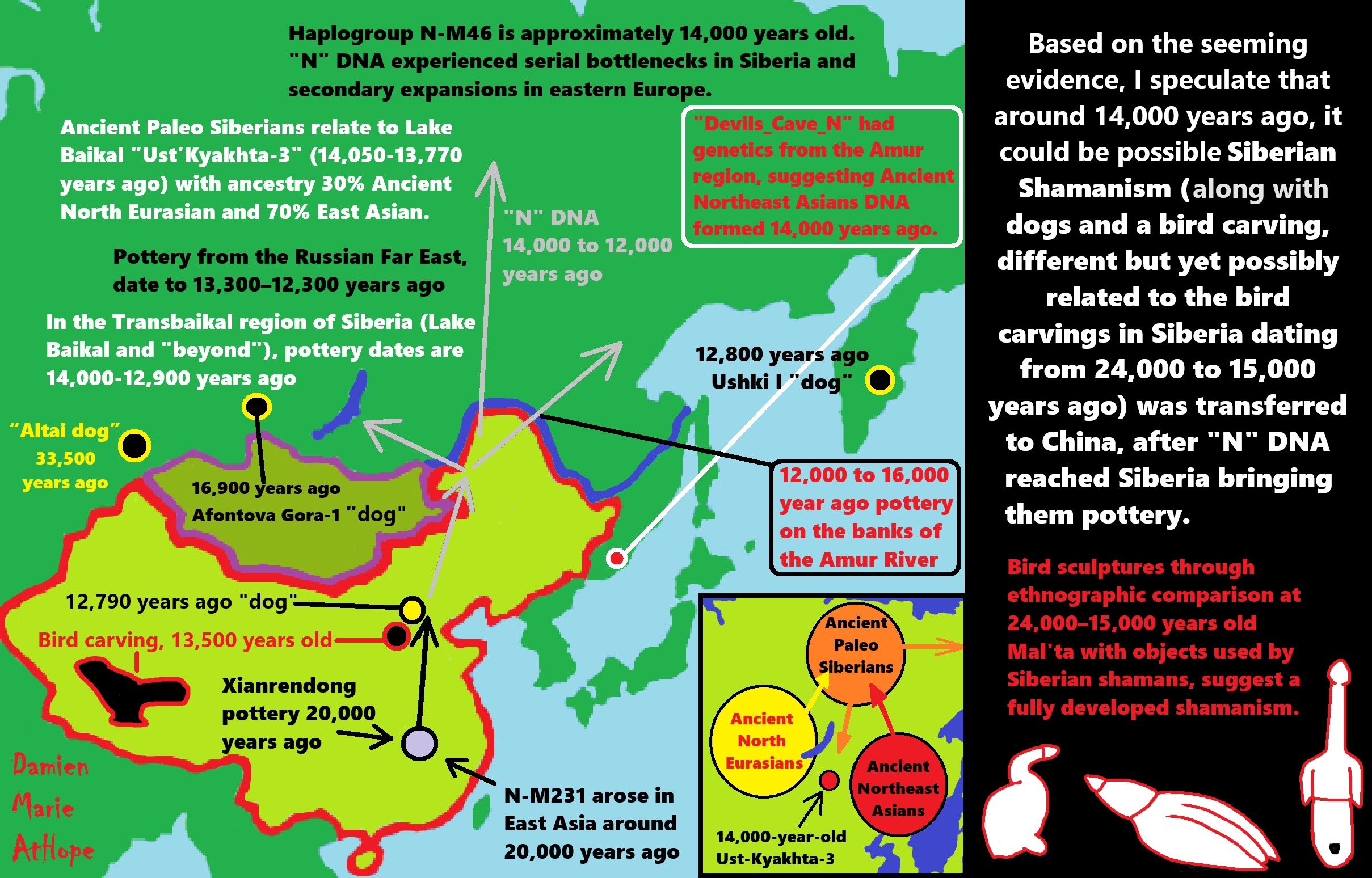
ref, ref, ref, ref, ref, ref, ref, ref, ref, ref, ref, ref, ref, ref, ref, ref
Based on the seeming evidence, I speculate that around 14,000 years ago, it could be possible Siberian Shamanism (along with dogs and a bird carving, different but yet possibly related to the bird carvings in Siberia dating from 24,000 to 15,000 years ago) was transferred to China, after “N” DNA reached Siberia bringing them pottery. Bird sculptures through ethnographic comparison at 24,000–15,000 years old Mal’ta with objects used by Siberian shamans, suggest a fully developed shamanism.
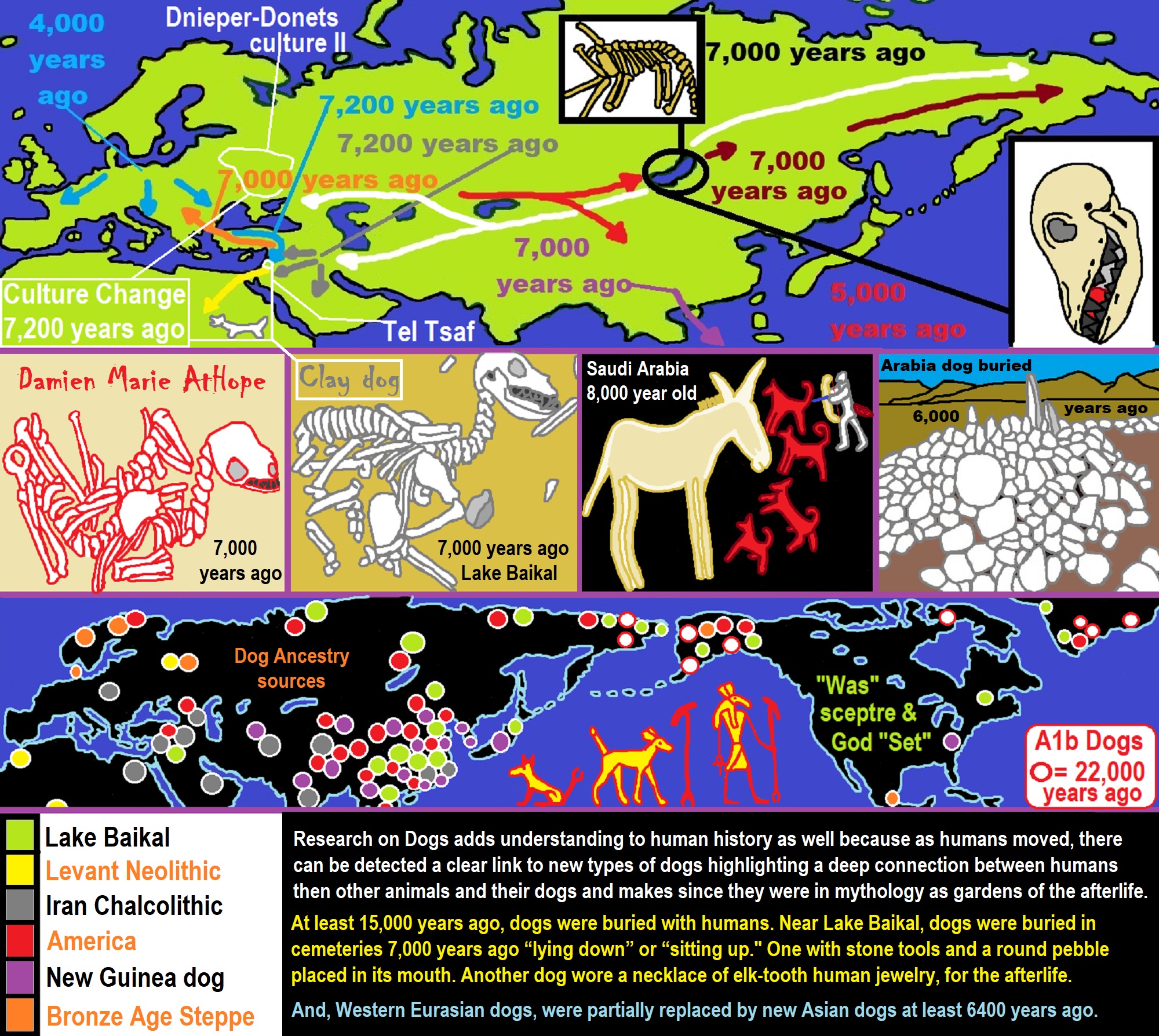

ref, ref, ref, ref, ref, ref, ref, ref, ref, ref, ref, ref, ref, ref, ref, ref, ref
“These ideas are my speculations from the evidence.”
I am still researching the “god‘s origins” all over the world. So you know, it is very complicated but I am smart and willing to look, DEEP, if necessary, which going very deep does seem to be needed here, when trying to actually understand the evolution of gods and goddesses. I am sure of a few things and less sure of others, but even in stuff I am not fully grasping I still am slowly figuring it out, to explain it to others. But as I research more I am understanding things a little better, though I am still working on understanding it all or something close and thus always figuring out more.
Sky Father/Sky God?
“Egyptian: (Nut) Sky Mother and (Geb) Earth Father” (Egypt is different but similar)
Turkic/Mongolic: (Tengri/Tenger Etseg) Sky Father and (Eje/Gazar Eej) Earth Mother *Transeurasian*
Hawaiian: (Wākea) Sky Father and (Papahānaumoku) Earth Mother *Austronesian*
New Zealand/ Māori: (Ranginui) Sky Father and (Papatūānuku) Earth Mother *Austronesian*
Proto-Indo-European: (Dyḗus/Dyḗus ph₂tḗr) Sky Father and (Dʰéǵʰōm/Pleth₂wih₁) Earth Mother
Indo-Aryan: (Dyaus Pita) Sky Father and (Prithvi Mata) Earth Mother *Indo-European*
Italic: (Jupiter) Sky Father and (Juno) Sky Mother *Indo-European*
Etruscan: (Tinia) Sky Father and (Uni) Sky Mother *Tyrsenian/Italy Pre–Indo-European*
Hellenic/Greek: (Zeus) Sky Father and (Hera) Sky Mother who started as an “Earth Goddess” *Indo-European*
Nordic: (Dagr) Sky Father and (Nótt) Sky Mother *Indo-European*
Slavic: (Perun) Sky Father and (Mokosh) Earth Mother *Indo-European*
Illyrian: (Deipaturos) Sky Father and (Messapic Damatura’s “earth-mother” maybe) Earth Mother *Indo-European*
Albanian: (Zojz) Sky Father and (?) *Indo-European*
Baltic: (Perkūnas) Sky Father and (Saulė) Sky Mother *Indo-European*
Germanic: (Týr) Sky Father and (?) *Indo-European*
Colombian-Muisca: (Bochica) Sky Father and (Huythaca) Sky Mother *Chibchan*
Aztec: (Quetzalcoatl) Sky Father and (Xochiquetzal) Sky Mother *Uto-Aztecan*
Incan: (Viracocha) Sky Father and (Mama Runtucaya) Sky Mother *Quechuan*
China: (Tian/Shangdi) Sky Father and (Dì) Earth Mother *Sino-Tibetan*
Sumerian, Assyrian and Babylonian: (An/Anu) Sky Father and (Ki) Earth Mother
Finnish: (Ukko) Sky Father and (Akka) Earth Mother *Finno-Ugric*
Sami: (Horagalles) Sky Father and (Ravdna) Earth Mother *Finno-Ugric*
Puebloan-Zuni: (Ápoyan Ta’chu) Sky Father and (Áwitelin Tsíta) Earth Mother
Puebloan-Hopi: (Tawa) Sky Father and (Kokyangwuti/Spider Woman/Grandmother) Earth Mother *Uto-Aztecan*
Puebloan-Navajo: (Tsohanoai) Sky Father and (Estsanatlehi) Earth Mother *Na-Dene*
ref, ref, ref, ref, ref, ref, ref, ref, ref, ref, ref, ref, ref, ref, ref, ref, ref, ref, ref, ref, ref, ref, ref, ref, ref, ref, ref
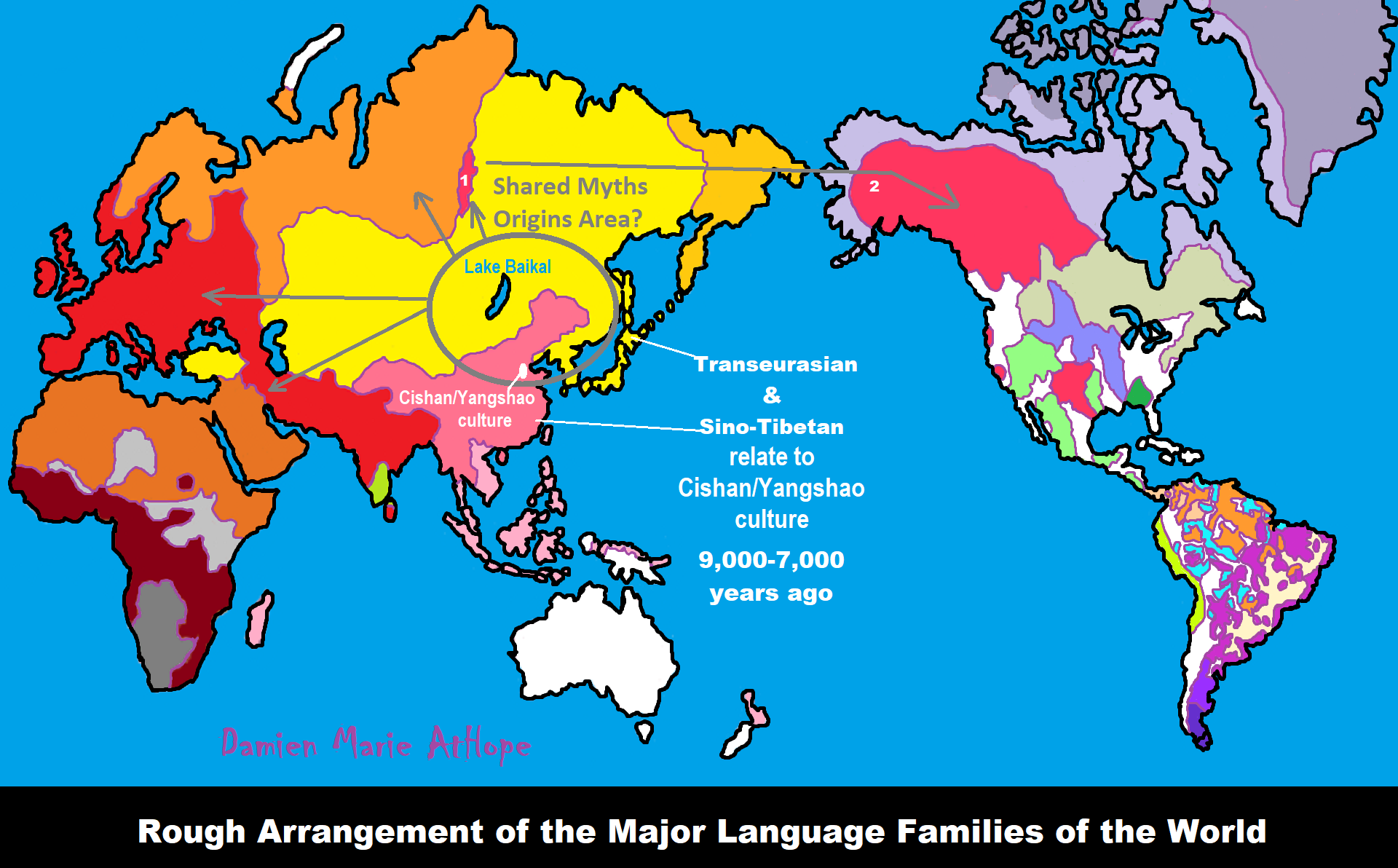
“These ideas are my speculations from the evidence.”
“1 central Eurasian Neolithic individual from Tajikistan (around 8,000 years ago) and approximately 8,200 years ago Yuzhniy Oleniy Ostrov group from Karelia in western Russia formed by 19 genomes affinity to Villabruna ancestry than all the other Eastern Hunter-Gatherer groups” https://www.nature.com/articles/s41586-023-05726-0
Here are Damien’s thoughts on the evolution of paganism:
Paganism 12,000 years old: related to (Pre-Capitalism): LINK
Paganism 7,000-5,000 years old: related to (Capitalism) (World War 0) Elite & their slaves: LINK
Paganism 5,000 years old: progressed organized religion and the state: related to (Kings and the Rise of the State): LINK
Paganism 4,000 years old: related to (First Moralistic gods, then the Origin time of Monotheism): LINK
Arcane = complicated and therefore understood or known by only a few people
To Damien, societies start with primitive anarchism and socialism at least 100,000 years ago and are seen in animist-only thinking that is now largely limited to southern Africa today. Then they lose systematic anarchism possibly by 50,000 to 40,000 years ago but keeps socialism/primitive communism with the emergence of totemism largely limited to Europe and then spreading out from there. And to Damien, arcane/primitive capitalism emerges at or around 7,000 to 5,000 years ago in central Europe especially southern Germany or surrounding areas (Czecho-Slovakia and Austria), and then spread out from there.
7,522-6,522 years ago Linear Pottery culture which I think relates to Arcane Capitalism’s origins
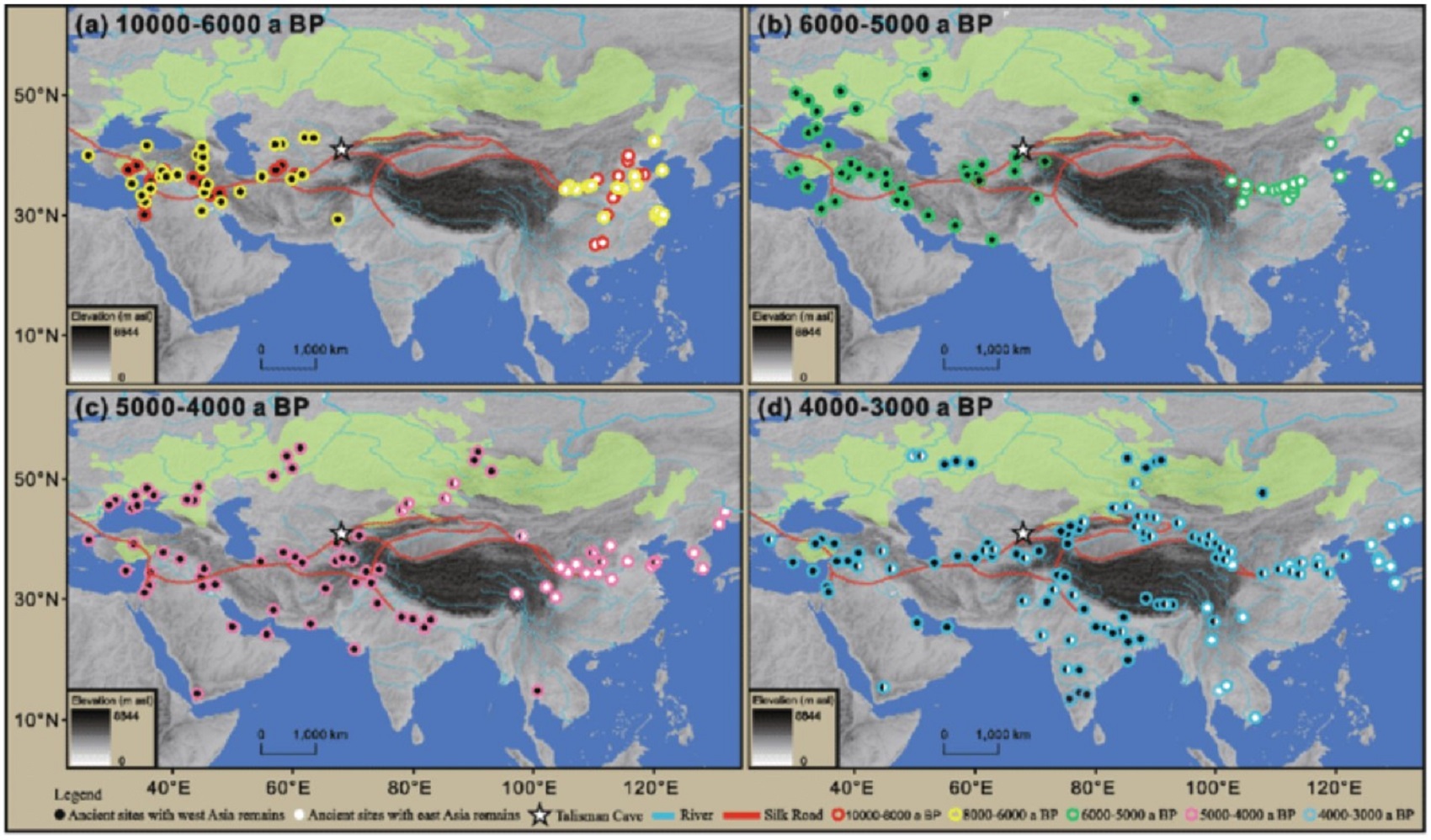
Maps showing the distribution of ancient sites in ACA and the Eurasian Steppe during different millennial increments over the past 10,000 years; a. Representative sites in other regions of Eurasia are also shown. (a) 10,000-8000 years ago (red) and 8000-6000 years ago (yellow), (b) 6000-5000 years ago, (c) 5000-4000 years ago, and (d) 4000-3000 years ago. The black dots represent the ancient sites with West Asian cultural elements, specifically wheat, barley, sheep/goat, and cattle. The white dots represent the ancient sites with East Asian cultural elements, including foxtail and broomcorn millet. The red lines represent prominent historical routes of the Silk Roads and the green shaded area represents the steppe ecoregion.” ref
Megadrought and cultural exchange along the proto-silk road
“Abstract: Arid Central Asia, with its diverse landscapes of high mountains, oases, and deserts, hosted the central routes of the Silk Roads that linked trade centers from East Asia to the eastern Mediterranean. Ecological pockets and ecoclines in Arid Central Asia are largely determined by local precipitation. However, little research has gone into the effects of hydroclimatic changes on trans-Eurasian cultural exchange. Here, we reconstruct precipitation changes in Arid Central Asia, covering the mid-late Holocene with a U-Th dated, ~3 a resolution, multi-proxy time series of replicated stalagmites from the southeastern Fergana Valley, Kyrgyzstan. Our data reveal a 640-a megadrought between 5820 and 5180 years ago, which likely impacted cultural development in Arid Central Asia and impeded the expansion of cultural traits along oasis routes. Instead, it may have diverted the earliest transcontinental exchange along the Eurasian steppe during the 5th millennium years ago. With gradually increasing precipitation after the megadrought, settlement of peoples in the oases and river valleys may have facilitated the opening of the oasis routes, “prehistoric Silk Roads”, of trans-Eurasian exchange. By the 4th millennium years ago, this process may have reshaped cultures across the two continents, laying the foundation for the organized Silk Roads.” ref
“Early agricultural populations in East and West Asia followed distinct trajectories of cultural development, leading to differing languages, socio-political systems, rituals, culinary traditions, cultivation practices, and domestication pathways for crops and animals. Many scholars have noted the existence of a cultural barrier that roughly followed the mountains and deserts of Arid Central Asia. Differences are visible in the types of crops and the cultivation practices used on either side of this divide. Trans-Eurasian exchange led to the gradual dispersal of cultural traits across Eurasia, starting several millennia before the formation of organized and taxed commercial trade. Archeological studies indicate that wheat, barley, sheep, goats, and cattle (West Asian cultural traits) spread to East Asia during the late fifth and fourth millennium BP. Likewise, broomcorn and foxtail millet evolved under cultivation in what is now northern China and dispersed to West Asia during the fourth millennium years ago. Some scholars argue that the early trans-Eurasian exchange crossed the Eurasian Steppe from Europe to Asia, a model often referred to as the steppe highway.” ref
“However, increasingly more archaeobotanical, zooarchaeological, and isotopic data suggest that the main passage for the transcontinental exchange followed the rich river valleys and alluvial slopes of the mountains to the beaded oasis passage, a continual route of communication for more than 4,000 years ago, designating the pre-Silk Roads. This spatial–temporal transformation significantly influenced the development of cultures across Europe and Asia, yet the underlying mechanisms that drove or constrained population expansions remain unclear. Extreme climate events, especially megadroughts lasting for decades or centuries, are thought to be a natural forcings that can contribute to the collapse of ancient imperial systems. Shifts in surface water have been implemented in the abandonment of many major urban centers in Arid Central Asia, such as those along the peripheries of the Bukhara Oasis in Uzbekistan or across the northern edge of the Kopet Dag Mountains during the third millennium years ago.” ref
“However, whether extreme climate events in Arid Central Asia played an important role in prehistoric demographic shifts and the trans-Eurasian exchange remains unexplored, due to a dearth of high-resolution climate records with accurate chronologies covering the middle to late Holocene in this region. Existing paleo-climate records reveal Holocene climate trends in eastern Arid Central Asia. These records have issues with dating uncertainty, temporal resolution, and proxy interpretation. To address these uncertainties, we have produced a climate record from two stalagmites collected from Talisman Cave in Kyrgyzstan. This high-resolution (~3 a), precisely 230 Th dated (dating errors are ~6‰) record allows us to correlate regional climate changes with the archaeological record, and test potential cause-effect hypotheses.” ref
Show 3 “Middle Neolithic” China: Ritual, Religion, Elites, and Language
Use time 8:24 to 10:50 https://www.youtube.com/watch?v=lz4EQ0iYDI4&t=413s
| 5000–4500 | Hemudu culture | 河姆渡文化 | Yuyao and Zhoushan, Zhejiang |
| 5000–3000 | Daxi culture | 大溪文化 | Three Gorges region |
| 5000–3000 | Majiabang culture | 馬家浜文化 | Lake Tai area and north of Hangzhou Bay |
| 5000–3000 | Yangshao culture | 仰韶文化 | Henan, Shaanxi, and Shanxi |
| 4700–2900 | Hongshan culture | 紅山文化 | Inner Mongolia, Liaoning, and Hebei |
| 4100–2600 | Dawenkou culture | 大汶口文化 | Shandong, Anhui, Henan, and Jiangsu |
| 3800–3300 | Songze culture | 崧澤文化 | Lake Tai area |
https://en.wikipedia.org/wiki/List_of_Neolithic_cultures_of_China
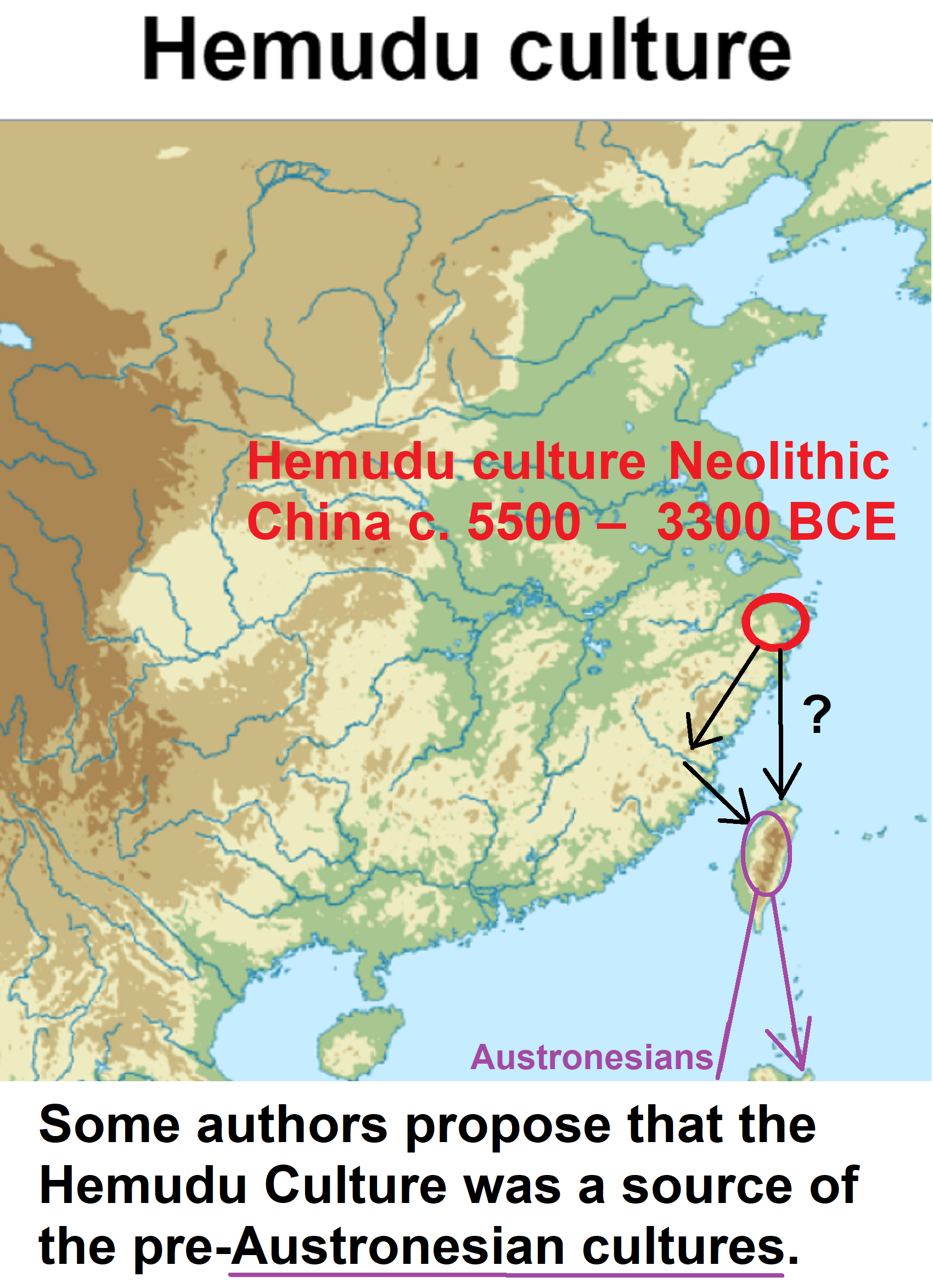
“The Hemudu culture was one of the earliest cultures to cultivate rice. Recent excavations at the Hemudu period site of Tianluoshan has demonstrated rice was undergoing evolutionary changes recognized as domestication. Most of the artifacts discovered at Hemudu consist of animal bones, exemplified by hoes made of shoulder bones used for cultivating rice. The culture also produced lacquer wood. A red lacquer wood bowl at the Zhejiang Museum is dated to 4000-5000 BC. It is believed to be the earliest such object in the world. The culture produced a thick, porous pottery. This distinctive pottery was typically black and made with charcoal powder. Plant and geometric designs were commonly painted onto the pottery; the pottery was sometimes also cord-marked. The culture also produced carved jade ornaments, carved ivory artifacts, and small clay figurines.” ref
“The early Hemudu period is considered the maternal clan phase. Descent is thought to have been matrilineal and the social status of children and women is comparatively high. In the later periods, they gradually shifted into patrilineal clans. During that period, the social status of men rose, and descent was passed through the male line. Hemudu’s inhabitants worshiped a sun spirit as well as a fertility spirit. They also enacted shamanistic rituals to the sun and believed in bird totems. A belief in an afterlife and ghosts is thought to have been widespread as well. People were buried with their heads facing east or northeast and most had no burial objects. Infants were buried in urn-casket style burials, while children and adults received earth-level burials. They did not have a definite communal burial ground, for the most part, but a clan communal burial ground has been found from the later period. Two groups in separate parts of this burial ground are thought to be two intermarrying clans. There were noticeably more burial goods in this communal burial ground.” ref
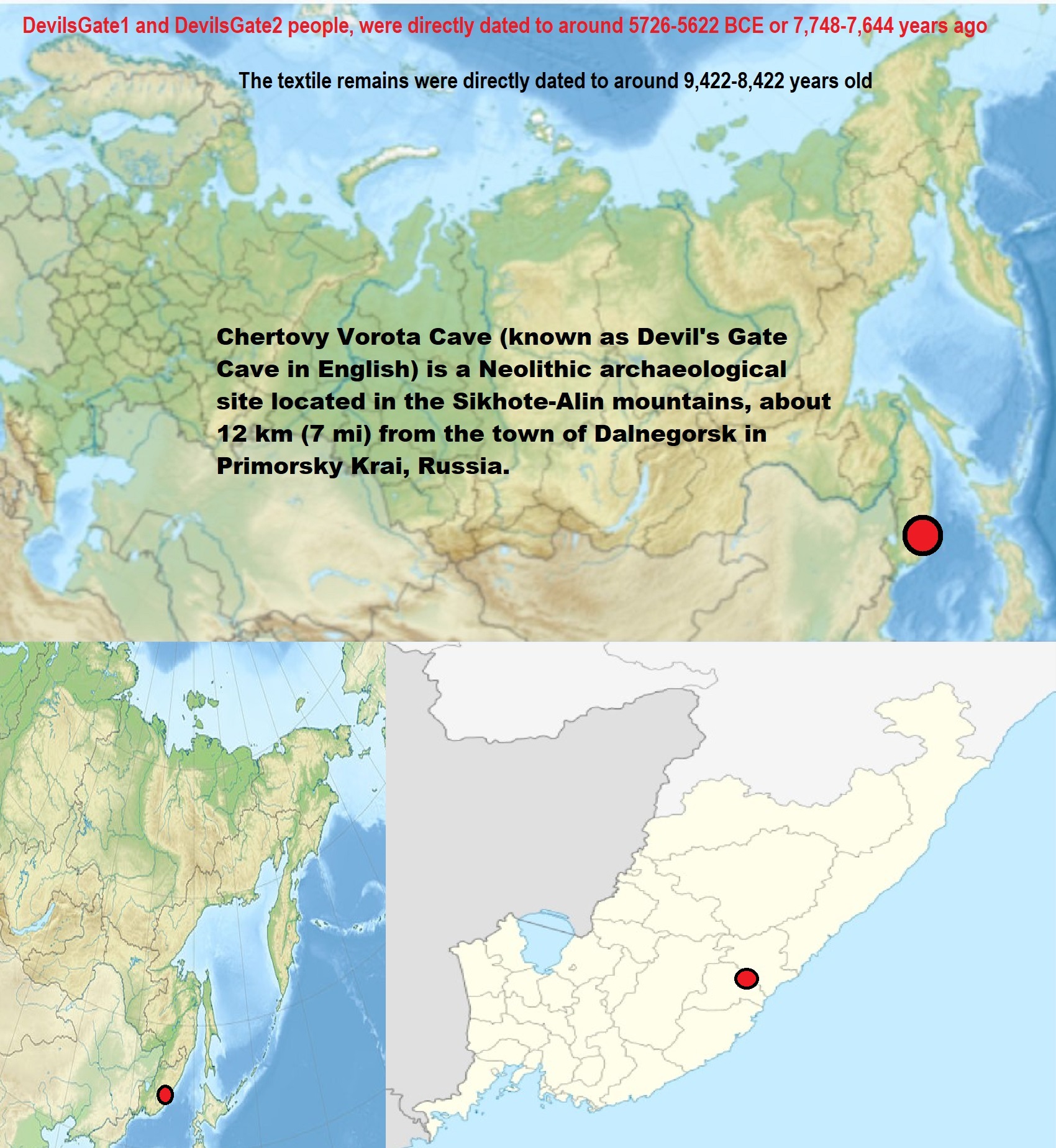
To Damien, paganism starts around 12,00 years ago in Turkey/Anatolia in Western Asia. The odd thing is most of the world’s religious myths/fables start or commonly relate to “Siberia” like “Lake Baikal/Golden Mountains of Altai” region and “North China like Chertovy Vorota Cave (Devil’s Gate Cave) area and the “Amur Region” at about 8,000/7,000 years ago and they were transferred to the middle east and East Europe/Balkans/Ukraine/Russia.”
The river Amur (Heilong Jiang)
“The Amur (Russian), or Heilong Jiang (Chinese: “Black Dragon River“), is the world’s tenth longest river, forming the border between the Russian Far East and Manchuria/Northeastern China.” ref

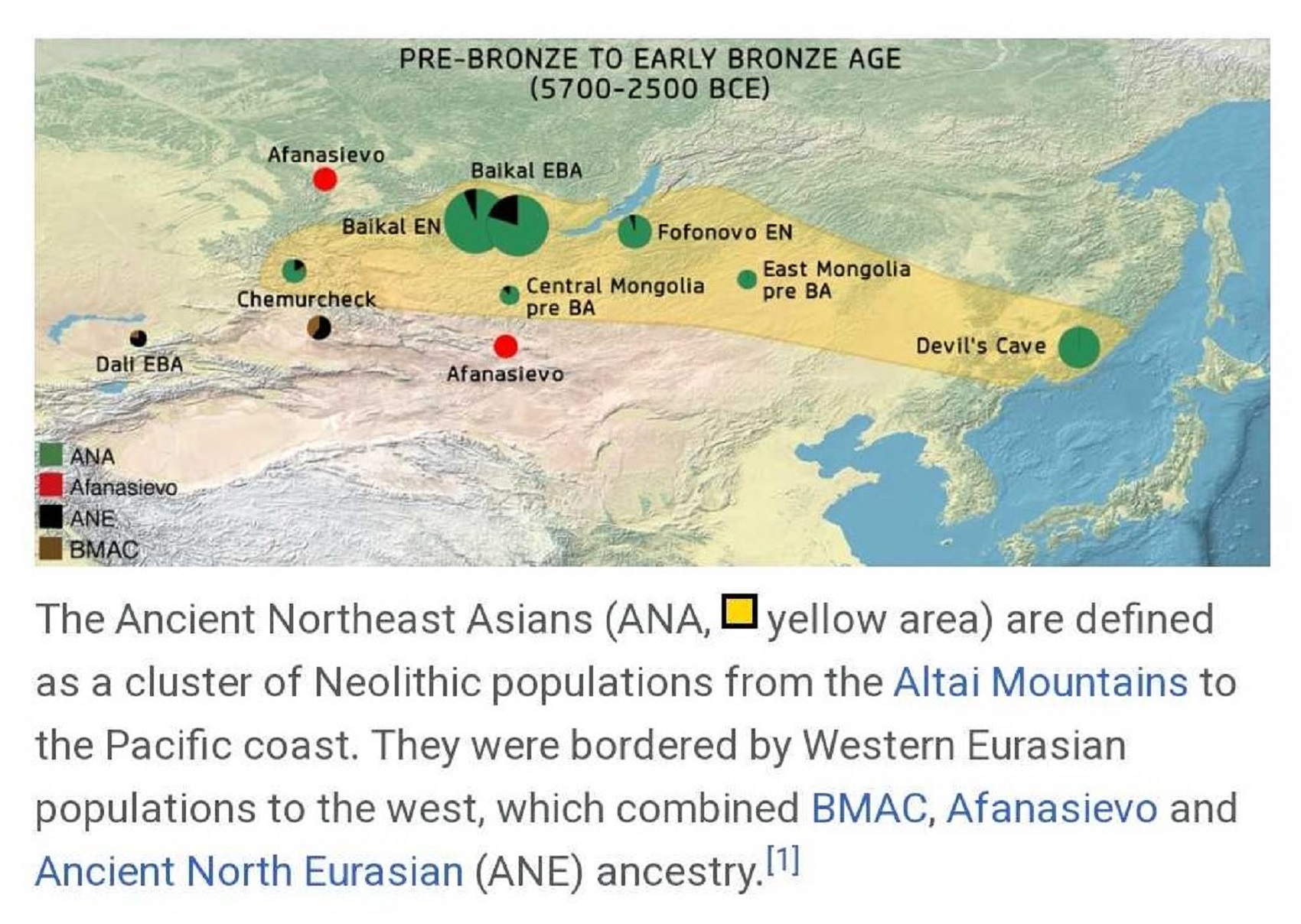
Ancient Northeast Asian
“In archaeogenetics, the term Ancient Northeast Asian (ANA), also known as Amur ancestry, is the name given to an ancestral component that represents the lineage of the hunter-gatherer people of the 7th-4th millennia before present, in far-eastern Siberia, Mongolia, and the Baikal regions. They are inferred to have diverged from Ancient East Asians about 24,000 years ago, and are represented by several ancient human specimens found in archaeological excavations east of the Altai Mountains. They are a sub-group of the Ancient Northern East Asians (ANEA). Genetically, ANA ancestry peaks among modern Tungusic, Mongolic, and Nivkh-speaking populations of Northeast Asia. ANA ancestry (represented by the Tungusic-speaking Ulchi people) overall forms the main ancestry of the early and contemporary speakers of Turkic, Mongolic, and Tungusic languages, which supports their spread from Northeast Asia westwards. An earlier wave into Siberia can be associated with “Neo-Siberians” (represented by Uralic-speaking Nganasans), which may be associated with the spread of Yukaghir and Uralic languages, and the partial displacement of Paleo-Siberians.” ref
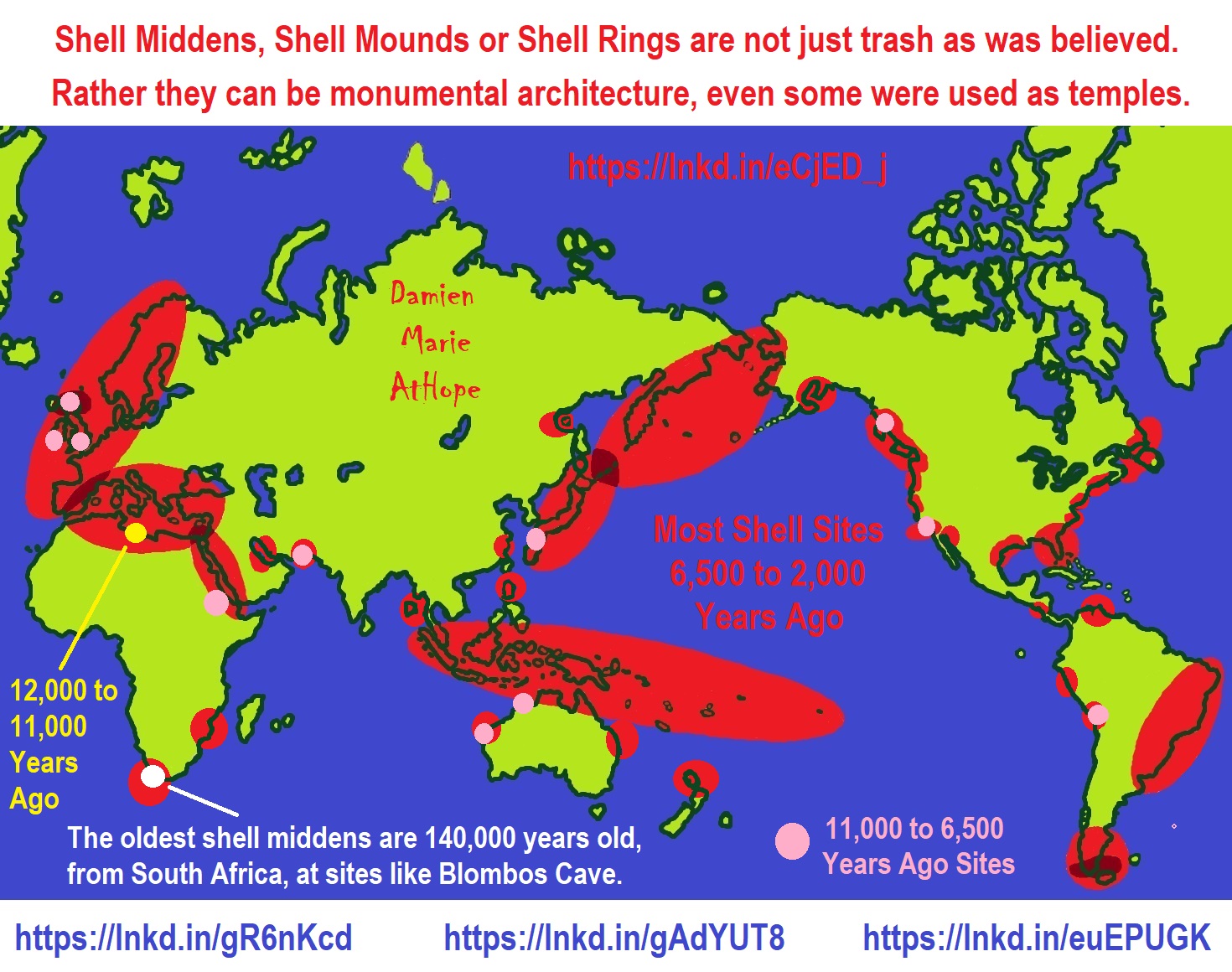
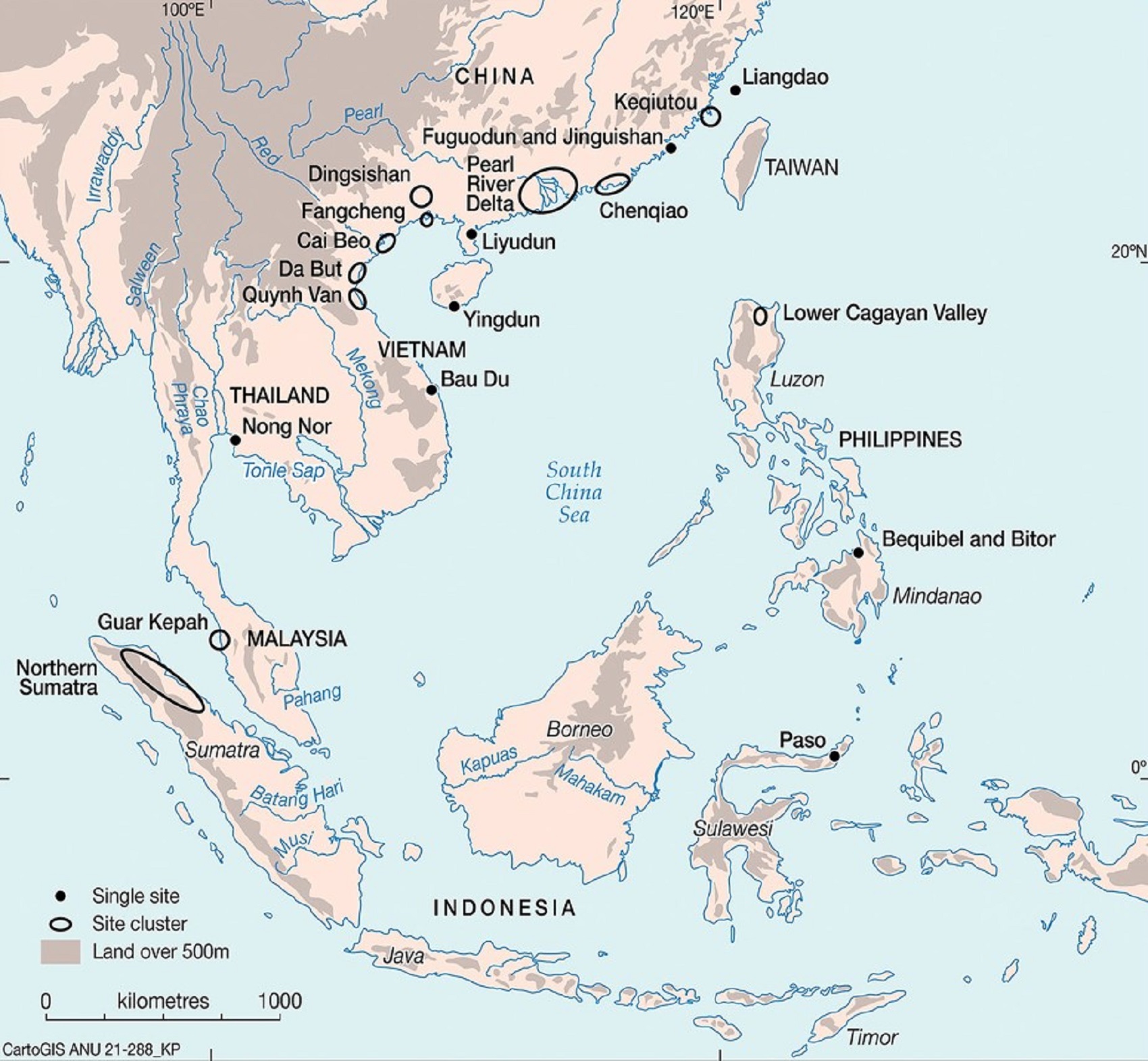
“Massive ancient shell middens, some over 16,000 m2, dot the Cagayan Valley in the #Philippines. Built-up between 7,000-2,000-years-ago, they document interactions between Indigenous hunter-gatherers and immigrant #Neolithic farmers.” ref
Preceramic riverside hunter-gatherers and the arrival of Neolithic farmers in northern Luzon
“Abstract: The most westerly Pacific island chain, running from Taiwan southwards through the Philippines, has long been central in debates about the origins and early migrations of Austronesian-speaking peoples from the Asian mainland into the islands of Southeast Asia and Oceania. Focusing on the Cagayan Valley of northern Luzon in the Philippines, the authors combine new and published radiocarbon dates to underpin a revised culture-historical synthesis. The results speak to the initial contacts and long-term relationships between Indigenous hunter-gatherers and immigrant Neolithic farmers, and the question of how the early speakers of Malayo-Polynesian languages spread into and through the Philippines.” ref
“Located 125km off the south-eastern coast of China, the island of Taiwan was host to the earliest Neolithic cultures that existed offshore from the southern Chinese mainland. The Dabenkeng Culture, which marked their initial arrival, commenced AROUND 5,500–5,000 years ago. Taiwan was also the most likely immediate archaeological source for the Neolithic settlement of the northern Philippines more than 4000 years ago. Recent research on ancient DNA from northern Luzon, the Mariana Islands, and the south-western Pacific suggests that the modern Austronesian-speaking populations of Island Southeast Asia and Oceania (beyond New Guinea and Island Melanesia) acquired much of their genetic heritage through ancient migration from southern China, via Taiwan, and through the Philippines.” ref
“These observations mean that Luzon, the first large landmass to be reached by Neolithic migrants heading south from Taiwan, must have played a significant role in the development of the ancestral languages and cultures of the Austronesian-speaking peoples of recent ethnographic times and through to the present. In terms of linguistics, for example, the Austronesian language family is divided into two major phylogenetic divisions: one includes the Indigenous (non-Sinitic) Formosan languages of Taiwan, while the other includes the Malayo-Polynesian languages of all other regions of the Austronesian world, from Madagascar to Rapanui (Easter Island), as well as the Philippines. Taiwan is also the source of Proto-Austronesian, the earliest proto-language that can be reconstructed through a comparison of historically recorded and living Austronesian languages. The proto-language for the Malayo-Polynesian subgroup is thought to have developed somewhere within the northern Philippines, including Luzon and the Batanes Islands, or perhaps in eastern Taiwan.” ref

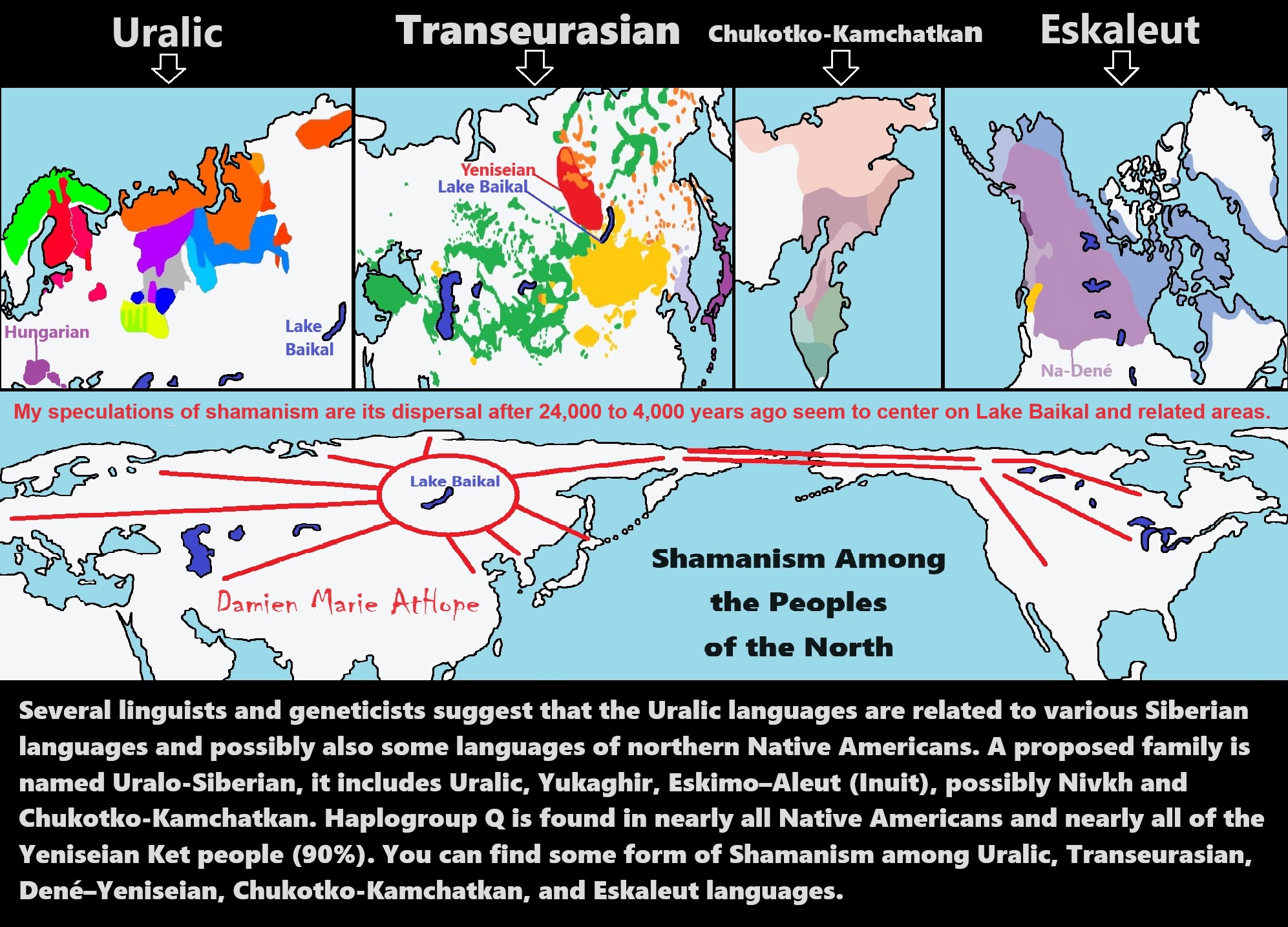
ref, ref, ref, ref, ref, ref, ref, ref, ref
“Several linguists and geneticists suggest that the Uralic languages are related to various Siberian languages and possibly also some languages of northern Native Americans. A proposed family is named Uralo-Siberian, it includes Uralic, Yukaghir, Eskimo–Aleut (Inuit), possibly Nivkh, and Chukotko-Kamchatkan. Haplogroup Q is found in nearly all Native Americans and nearly all of the Yeniseian Ket people (90%).” ref, ref
You can find some form of Shamanism, among Uralic, Transeurasian, Dené–Yeniseian, Chukotko-Kamchatkan, and Eskaleut languages.
My speculations of shamanism are its dispersals, after 24,000 to 4,000 years ago, seem to center on Lake Baikal and related areas. To me, the hotspot of Shamanism goes from west of Lake Baikal in the “Altai Mountains” also encompassing “Lake Baikal” and includes the “Amur Region/Watershed” east of Lake Baikal as the main location Shamanism seems to have radiated out from.
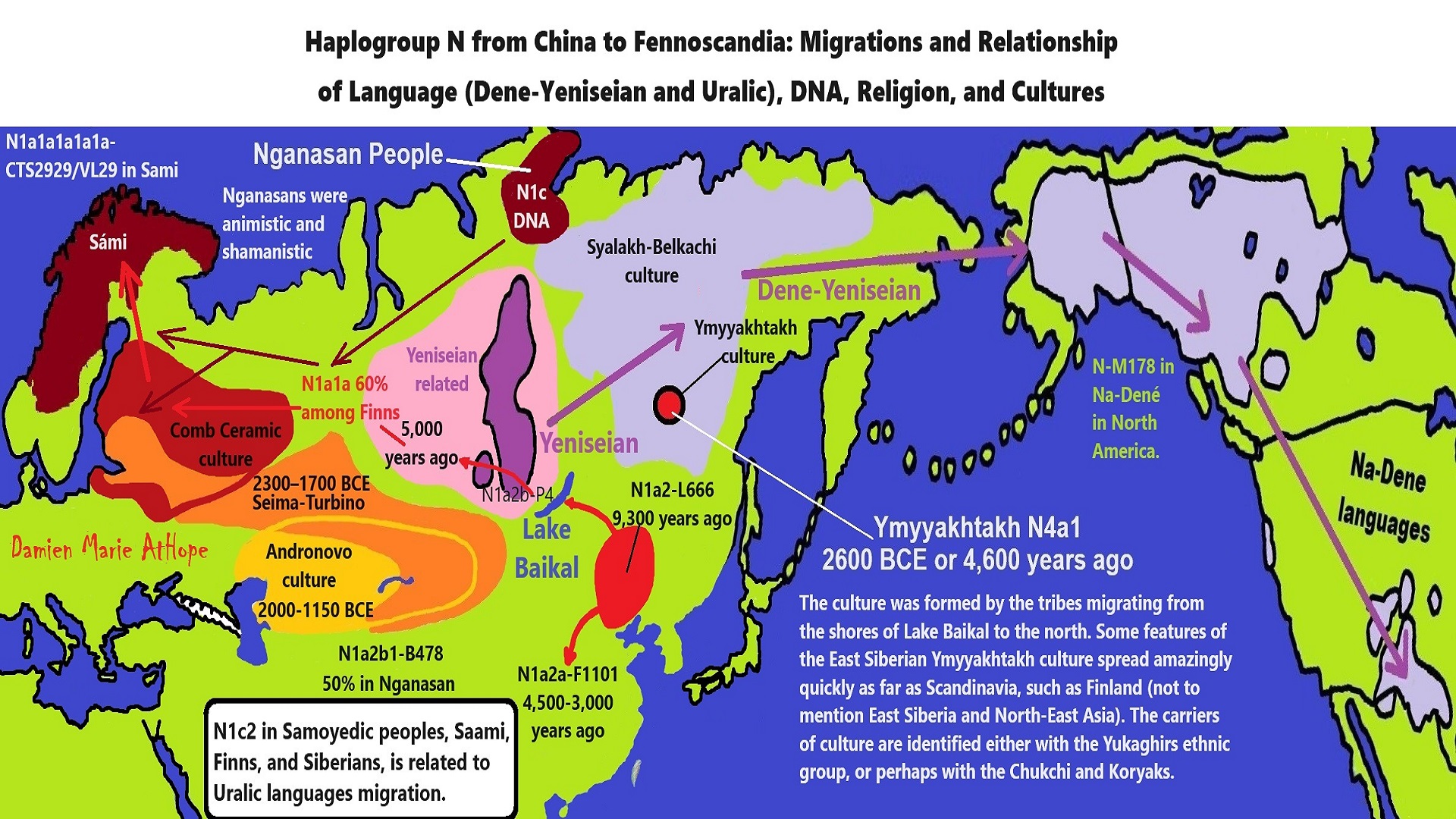
ref, ref, ref, ref, ref, ref, ref, ref, ref, ref, ref, ref, ref, ref, ref, ref
Postglacial genomes from foragers across Northern Eurasia reveal prehistoric
mobility associated with the spread of the Uralic and Yeniseian languages
Abstract
“The North Eurasian forest and forest-steppe zones have sustained millennia of sociocultural connections among northern peoples. We present genome-wide ancient DNA data for 181 individuals from this region spanning the Mesolithic, Neolithic, and Bronze Age. We find that Early to Mid-Holocene hunter-gatherer populations from across the southern forest and forest-steppes of Northern Eurasia can be characterized by a continuous gradient of ancestry that remained stable for millennia, ranging from fully West Eurasian in the Baltic region to fully East Asian in the Transbaikal region. In contrast, cotemporaneous groups in far Northeast Siberia were genetically distinct, retaining high levels of continuity from a population that was the primary source of ancestry for Native Americans. By the mid-Holocene, admixture between this early Northeastern Siberian population and groups from Inland East Asia and the Amur River Basin produced two distinctive populations in eastern Siberia that played an important role in the genetic formation of later people. Ancestry from the first population, Cis-Baikal Late Neolithic-Bronze Age (Cisbaikal_LNBA), is found substantially only among Yeniseian-speaking groups and those known to have admixed with them. Ancestry from the second, Yakutian Late Neolithic-Bronze Age (Yakutia_LNBA), is strongly associated with present-day Uralic speakers. We show how Yakutia_LNBA ancestry spread from an east Siberian origin ~4.5kya, along with subclades of Y-chromosome haplogroup N occurring at high frequencies among present-day Uralic speakers, into Western and Central Siberia in communities associated with Seima-Turbino metallurgy: a suite of advanced bronze casting techniques that spread explosively across an enormous region of Northern Eurasia ~4.0kya. However, the ancestry of the 16 Seima-Turbino-period individuals–the first reported from sites with this metallurgy–was otherwise extraordinarily diverse, with partial descent from Indo-Iranian-speaking pastoralists and multiple hunter-gatherer populations from widely separated regions of Eurasia. Our results provide support for theories suggesting that early Uralic speakers at the beginning of their westward dispersal where involved in the expansion of Seima-Turbino metallurgical traditions, and suggests that both cultural transmission and migration were important in the spread of Seima-Turbino material culture.” ref
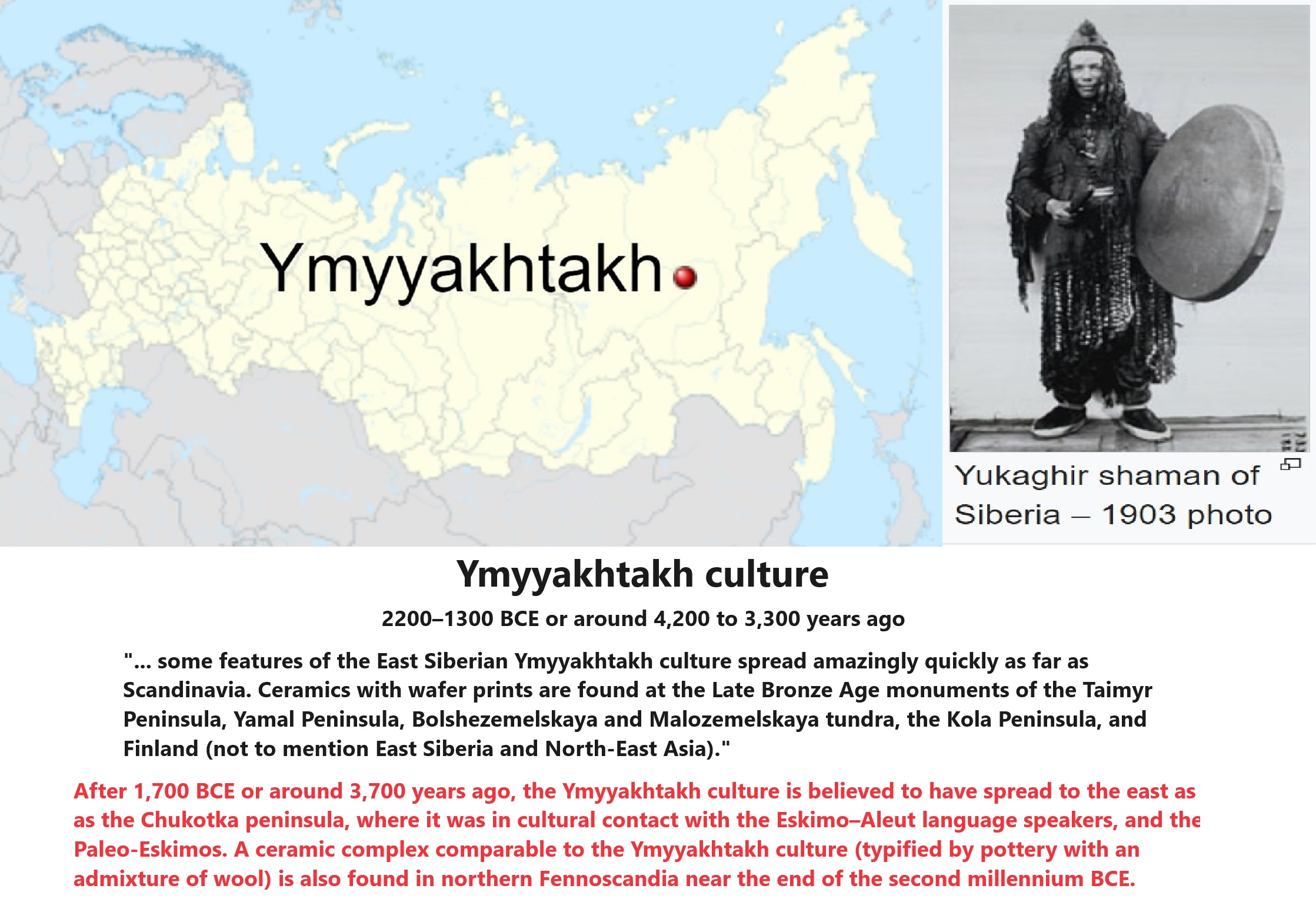
Ymyyakhtakh culture
“The Ymyyakhtakh culture (ɯm-mɯ-yakh-takh, Russian: Ымыяхтахская культура, romanized: Ymyyakhtakhskaya kul’tura) was a Late Neolithic culture of Siberia, with a very large archaeological horizon, dating to c. 2200–1300 BCE. Its origins seem to be in the Lena river basin of Yakutia, and also along the Yenisei river. From there it spread to the east and west. Individual sites were also found in Taymyr. It is named after Ymyyakhtakh, a settlement in the Sakha Republic, Russia.” ref
A. Golovnev discusses Ymyyakhtakh culture in the context of a “circumpolar syndrome”:
- “… some features of the East Siberian Ymyyakhtakh culture spread amazingly quickly as far as Scandinavia. Ceramics with wafer prints are found at the Late Bronze Age monuments of the Taimyr Peninsula, Yamal Peninsula, Bolshezemelskaya and Malozemelskaya tundra, the Kola Peninsula, and Finland (not to mention East Siberia and North-East Asia).” ref
“The Ymyyakhtakh made round-bottomed ceramics with waffle and ridge prints on the outer surface. Stone and bone arrowheads, spears, and harpoons are richly represented. Armour plates were also used in warfare. Finds of bronze ware are frequent in the burial grounds. The culture was formed by the tribes migrating from the shores of Lake Baikal to the north, merging with the local substrate of the Bel’kachi culture. The carriers of culture are identified either with the Yukaghirs ethnic group, or perhaps with the Chukchi and Koryaks. The Ymyyakhtakh culture continued at least until the first centuries of our era. It was later replaced by the Ust-Mil culture.” ref
“After 1,700 BCE, the Ymyyakhtakh culture is believed to have spread to the east as far as the Chukotka peninsula, where it was in cultural contact with the Eskimo–Aleut language speakers, and the Paleo-Eskimos. A ceramic complex comparable to the Ymyyakhtakh culture (typified by pottery with an admixture of wool) is also found in northern Fennoscandia near the end of the second millennium BCE.” ref
Syalakh culture
“Syalakh culture is an early Neolithic culture of Yakutia and Eastern Siberia. It formed in the middle Lena river basin in the V — IV millenniums BCE as a result of the migration of tribes from Transbaikalia, which assimilated the local Sumnagin culture (10,500-6,500 years ago) that was preceramic. The culture got its name from Lake Syalakh, located 90 km from the town of Zhigansk in Yakutia (Saha). The first archaeological excavations in this area were conducted under the direction of A. P. Okladnikov in the 1940s. The sites of the carriers of Syalakh culture are marked by the first appearance of polished stone tools, as well as the earliest ceramics (fired clay pottery with a characteristic mesh pattern). Bone harpoons, and bow and arrows have also been found. More than 50 sites of the Syalakh culture are known. In the decorative arts, a central place is occupied by the images of moose, which reflect mythological representation. The Syalakh culture was followed by the Belkachi culture. The ancient Paleo-Eskimo peoples were probably involved in these migrations. According to the linguists, the most likely hypothesis is that representatives of this culture spoke one of the Dené–Yeniseian languages.” ref
According to Pavel Flegontov et al.,
- “The new wave of population from northeastern Asia that arrived in Alaska at least 4,800 years ago displays clear archaeological precedents leading back to Central Siberia. … the Syalakh culture peoples, spreading across Siberia after 6,500 years ago, might represent the “ghost population” that split off around 6,500-7,000 years ago, and later gave rise to migrants into America.” ref
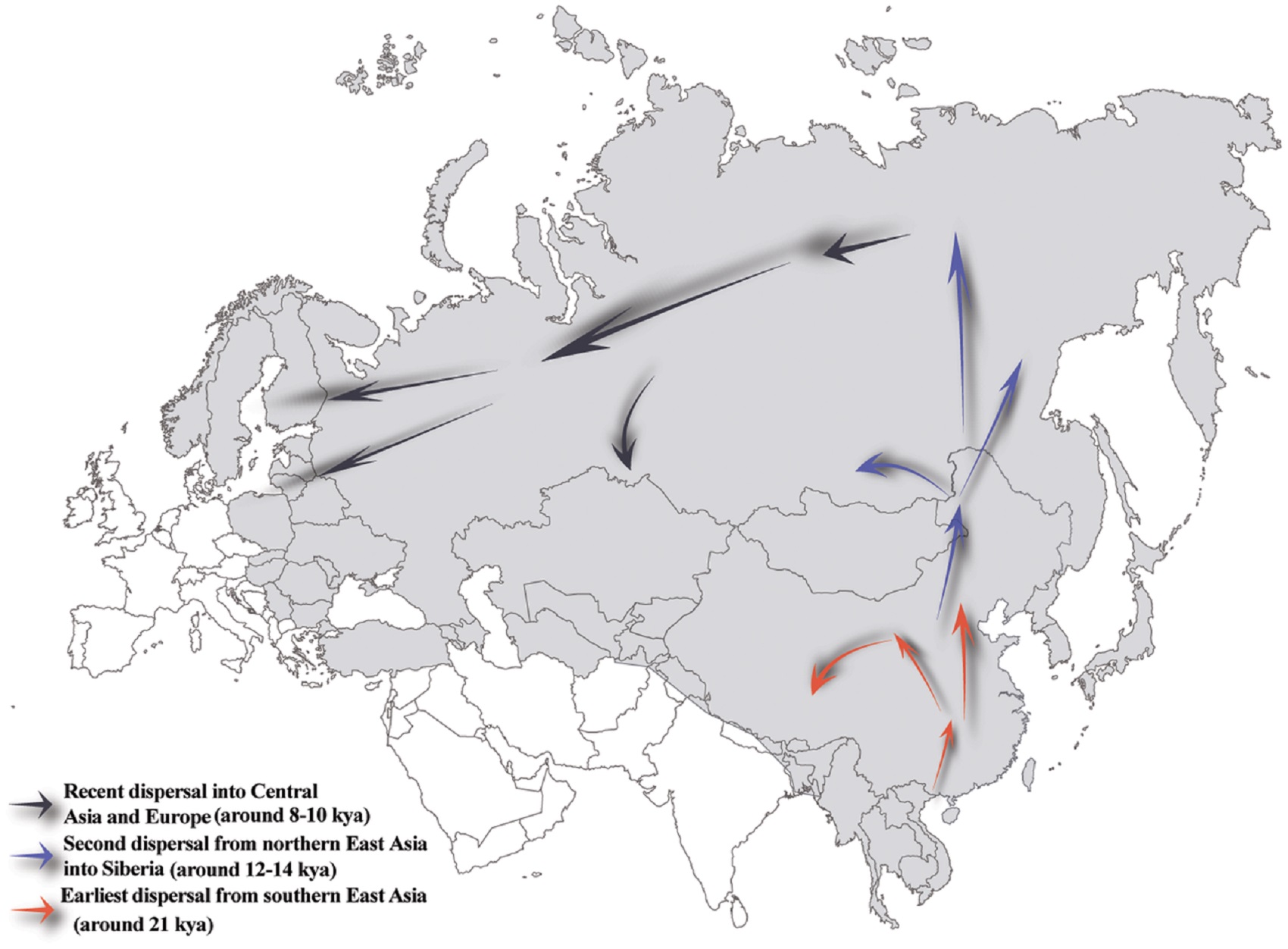
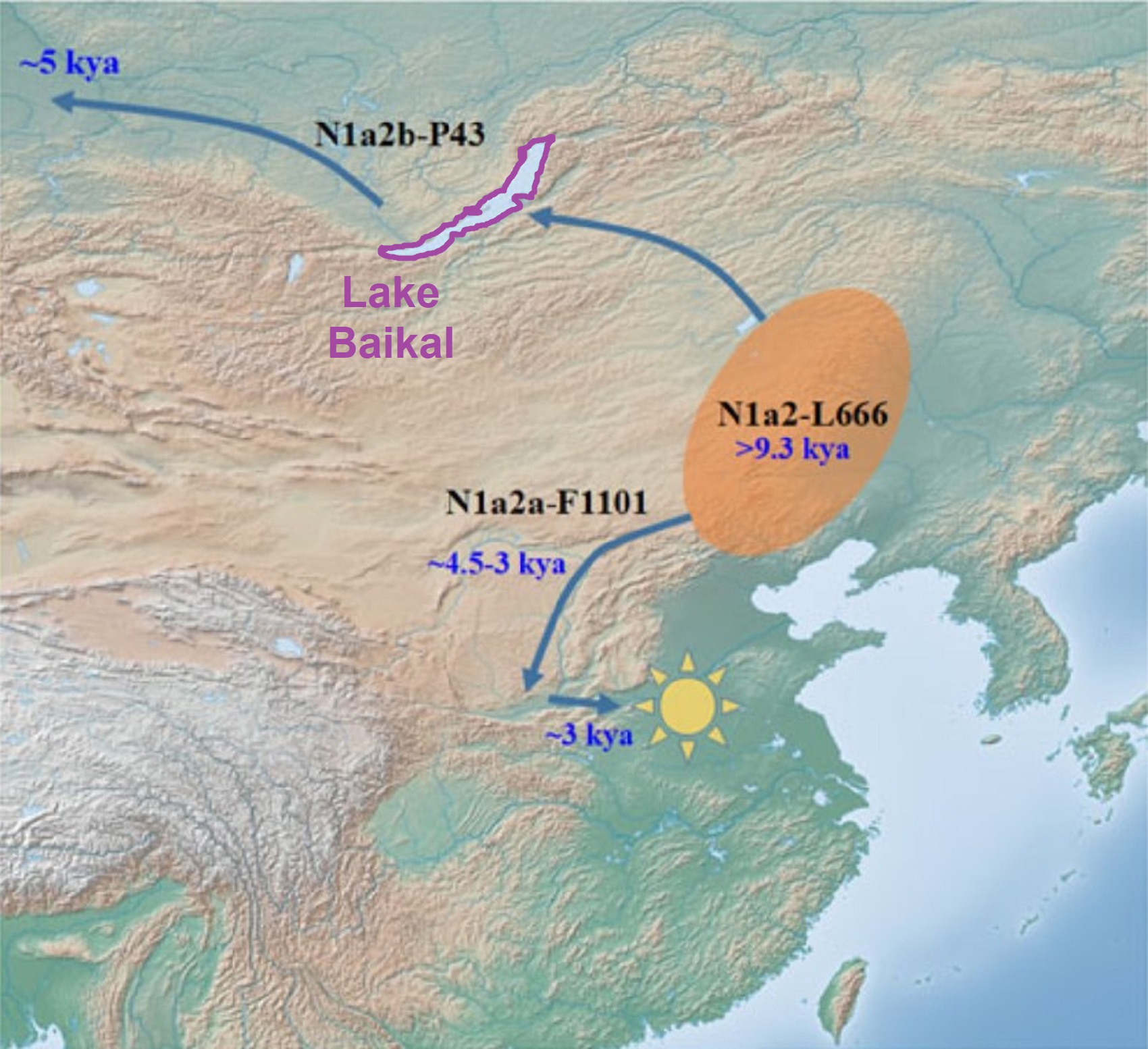
Early history between 9,300 and 4,400 years ago
“As the only two downstream clades of N1a2-L666, the geographical distribution of N1a2a-F1101 and N1a2b-P43 is very different from each other. Ancient DNA studies have identified early branches of N1a2a-F1101 and N1a2b-P43 in sites in the Baikal region (de Barros Damgaard et al., 2018; Kilinc et al., 2021; Ma et al., 2021). The most recent branch of N1a2-L666 is N1a1-M46, the main paternal type of the Uralic population (Ilumäe et al., 2016). The first two early branches under N1a1-M46, N1a1b-Y149447, and N1a1a3-F4065, are mainly distributed in northeast China (https://www.yfull.com/tree/N/) (Hu et al., 2015). Therefore, we speculate that the initial spread of haplogroup N1a2-L666 may have been in the southwestern part of northeastern China (Figure 3).” ref
“The researchers proposed that this region is also the initial diffusion center of N1a1-M46, while the diffusion of N1a1-M46 (>12,000 years ago) happened earlier than that of N1a2-L666 (<9,300 years ago) (Hu et al., 2015). In the early Holocene (about 11,200-8,000 years ago), with climate change and the rise of early agricultural populations in northern China, a part of the descendants of the ancestor group, representing by sub-lineage N1a2b-P43, spread to the high latitude region of Siberia, eventually becoming part of the Ural-speaking populations. The other part, representing by sub-lineage N1a2a-F1101, remained in the local area and participated in the formation of the northern Chinese populations in the later historical period (Figure 3).” ref
“A bottleneck period of 5,000 years was observed early in the evolution of N1a2a-F1101 (Figure 1, Supplementary Table S1). Similar lengthy bottleneck periods were observed in downstream structures of N1a2b-P43, N1a1-M46, and Q1a1a-M120 (Ilumäe et al., 2016; Sun et al., 2019). This evolutionary pattern is very different from the expansion pattern of ancient agricultural populations in East Asia, which continued to expand since the beginning of Neolithic age (Yan et al., 2014). The differentiation of the downstream clades of Q-M242 and N-231 presents a similar structure, i.e., downstream clades with high-frequency distribution both in East Asia and Siberia, respectively. Therefore, we speculate that in the bottleneck interval, ancient populations with Q1a1a-M120 and N1a2a-F1101 as the main paternal lineages are likely to exist in the form of prehistoric hunter-gatherer populations in the border between the eastern Eurasian steppe and the northern-northeastern China. The drought and harsh natural environment of this area had a great influence on the evolution of the two paternal lineages in later historical periods.” ref
Expansion during the chalcolithic age and bronze age
“During the Chalcolithic age (about 4.5 kya-4.0 kya) in East Asia, copper, cattle, and wheat were introduced to the East Asian heartland (Liu and Chen, 2003; Liu, 2004; Liu and Chen, 2017). Archaeologists have suggested that the elements may have spread from the northern boundary of China through the Eurasian steppe. However, the demographic context of this important cultural process is very ambiguous. Around 4,000 years ago, the Bronze culture arose in the agro-pastoral region of northwestern China and later spread across East Asia and Southeast Asia. The mixing of the bronze culture of agriculture and animal husbandry with the people of the middle and lower reaches of the Yellow River contributed to the establishment of three dynasties of the Bronze Age in ancient China, namely the Xia, Shang, and Zhou dynasties (Liu and Chen, 2003; Liu, 2004; Liu and Chen, 2017).” ref
“As discussed above, ancient populations with Q1a1a-M120 and N1a2a-F1101 as the main paternal lineages may have played a mediating role in the spread of the Copper and Bronze cultures from the eastern Eurasian steppe to the central East Asian region, due to their area of activity in the junction zone. Due to the same reason, these two paternal lines experienced a very significant spread during the Bronze Age, becoming important patrilineal lineages that occupied an upper political position in the Bronze Age, and were frequently detected in the tombs of chiefs and nobles of the time (Zhao et al., 2014; Sun et al., 2019; Ma et al., 2021; Wei et al., 2022). An interesting thing is that the significant expansion of N1a2a-F1101 occurred after 3,300 years ago, significantly later than the major expansion period of Q1a1a-M120 (4.2 kya-3 kya, Figure 1).” ref
“Nevertheless, several downstream clades of Q1a1a-M120, like F4759 and F4689, exhibit simultaneous expansion with N1a2a1a1a1a1-F710 (Sun et al., 2019). Ancient DNA data suggest that these two paternal lineages were concentrated in ancient populations in northwest China, and co-occurred in some tombs (Zhao et al., 2014; Ma et al., 2021; Wei et al., 2022). These ancient DNA studies also suggest that N1a2a-F1101 is likely the paternal lineage of the royal family of the Zhou Dynasty, while Q1a1a-M120 is the main paternal lineage of the Rong-Di populations (Means “Barbarians” in ancient Chinese). Both paternal lineages became the main paternal component of the Chinese group in later generations. In conclusion, we speculate that Q1a1a-M120 and N1a2a-F1101 together constitute the main paternal lineages of the populations that worked as farmers and pastoralists in northwest China during the Copper-Bronze Age. They played a key role in the emergence of bronze culture, early states, and early civilizations in the central region of ancient China.” ref
Bronze age globalization in East Asia
“As, discussed in the Introduction section, Bronze Age globalization has led to the mass replacement and mixing of populations in multiple parts of Eurasia (Allentoft et al., 2015). In East Asia, however, the situation is quite different. Ancient DNA shows that during the Copper-Bronze Age, the populations in the central East Asian region did not experience large-scale replacement, and the genetic components from Indo-Europeans are nearly absent. Based on previous literature and the results of this paper, we suggest that the Gobi Desert on the border between China and Mongolia may have hindered the spread of the Bronze culture and Indo-European-related populations. The hunter-gatherer communities that originally operated in the north and south of the Gobi Desert relied on their familiarity with the environment and long-distance material exchange networks to spread relevant cultural elements as intermediaries. In later historical periods, they became the main founders of the bronze culture populations in northwest China.” ref
“These demographic histories led to the spread of Bronze culture into central East Asia as a form of cultural diffusion, unlike what happened in other parts of Eurasia during the Bronze Age period of globalization. In summary, we constructed a high-resolution phylogeny for Y-chromosome haplogroup N1a2a-F1101, one of the main paternal lineages of modern Chinese. We explored the demographic of this paternal haplogroup in the past 9,000 years. We also discussed the activity of ancient populations with this lineage and their role during the appearance of Bronze Age culture, the formation of early state and early civilizations in the central region of China. The newly-discovered sub-branches and variants will assist in exploring the formation process of gene pool of Chinese populations and their cultural traditions.” ref
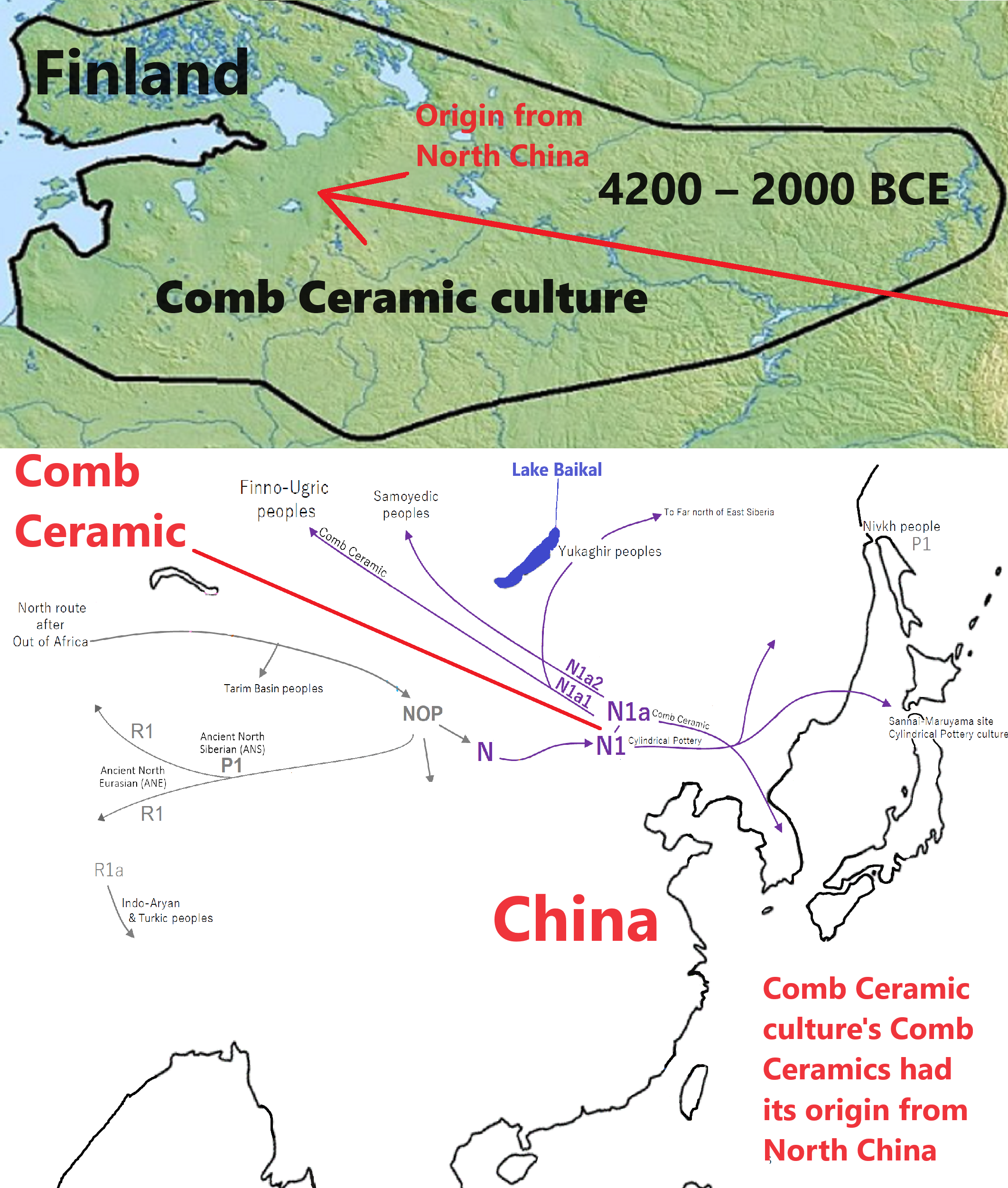
Comb Ceramic culture
“The Comb Ceramic culture or Pit-Comb Ware culture, often abbreviated as CCC or PCW, was a northeast European culture characterised by its Pit–Comb Ware. It existed from around 4200 BCE to around 2000 BCE. The bearers of the Comb Ceramic culture are thought to have still mostly followed the Mesolithic hunter-gatherer (Eastern Hunter-Gatherer) lifestyle, with traces of early agriculture. The distribution of the artifacts found includes Finnmark (Norway) in the north, the Kalix River (Sweden) and the Gulf of Bothnia (Finland) in the west and the Vistula River (Poland) in the south. It would include the Narva culture of Estonia and the Sperrings culture in Finland, among others. They are thought to have been essentially hunter-gatherers, though e.g. the Narva culture in Estonia shows some evidence of agriculture. Some of this region was absorbed by the later Corded Ware horizon. The Pit–Comb Ware culture is one of the few exceptions to the rule that pottery and farming coexist in Europe. In the Near East farming appeared before pottery, then when farming spread into Europe from the Near East, pottery-making came with it. However, in Asia, where the oldest pottery has been found, pottery was made long before farming. It appears that the Comb Ceramic Culture reflects influences from Siberia and distant China.” ref
“By dating according to the elevation of land, the ceramics have traditionally (Äyräpää 1930) been divided into the following periods: early (Ka I, c. 4200 BC – 3300 BC), typical (Ka II, c. 3300 BC – 2700 BC) and late Comb Ceramic (Ka III, c. 2800 BC – 2000 BC). However, calibrated radiocarbon dates for the comb-ware fragments found (e.g., in the Karelian isthmus), give a total interval of 5600 BC – 2300 BC (Geochronometria Vol. 23, pp 93–99, 2004). The settlements were located at sea shores or beside lakes and the economy was based on hunting, fishing, and the gathering of plants. In Finland, it was a maritime culture that became more and more specialized in hunting seals. The dominant dwelling was probably a teepee of about 30 square meters where some 15 people could live. Also, rectangular houses made of timber became popular in Finland from 4000 BC cal. Graves were dug at the settlements and the dead were covered with red ochre. The typical Comb Ceramic age shows an extensive use of objects made of flint and amber as grave offerings.” ref
“The stone tools changed very little over time. They were made of local materials such as slate and quartz. Finds suggest a fairly extensive exchange network: red slate originating from northern Scandinavia, asbestos from Lake Saimaa, green slate from Lake Onega, amber from the southern shores of the Baltic Sea, and flint from the Valdai area in northwestern Russia. The culture was characterized by small figurines of burnt clay and animal heads made of stone. The animal heads usually depict moose and bears and were derived from the art of the Mesolithic. There were also many rock paintings. There are sources noting that the typical comb ceramic pottery had a sense of luxury and that its makers knew how to wear precious amber pendants. The great westward dispersal of the Uralic languages is suggested to have happened long after the demise of the Comb Ceramic culture, perhaps in the 1st millennium BC.” ref
“Saag et al. (2017) analyzed three CCC individuals buried at Kudruküla as belonging to Y-hg R1a5-YP1272 (R1a1b~ after ISOGG 2020), along with three mtDNA samples of mt-hg U5b1d1, U4a and U2e1. Mittnik (2018) analyzed two CCC individuals. The male carried R1 (2021: R1b-M343) and U4d2, while the female carried U5a1d2b. Generally, the CCC individuals were mostly of Eastern Hunter-Gatherer (EHG) descent, with even more EHG than people of the Narva culture. Lamnidis et al. (2018) found 15% Western Hunter-Gatherer (WHG) ancestry, 65% Eastern Hunter-Gatherer (EHG) – higher than among earlier cultures of the eastern Baltic, and 20% Western Steppe Herder (WSH).” ref
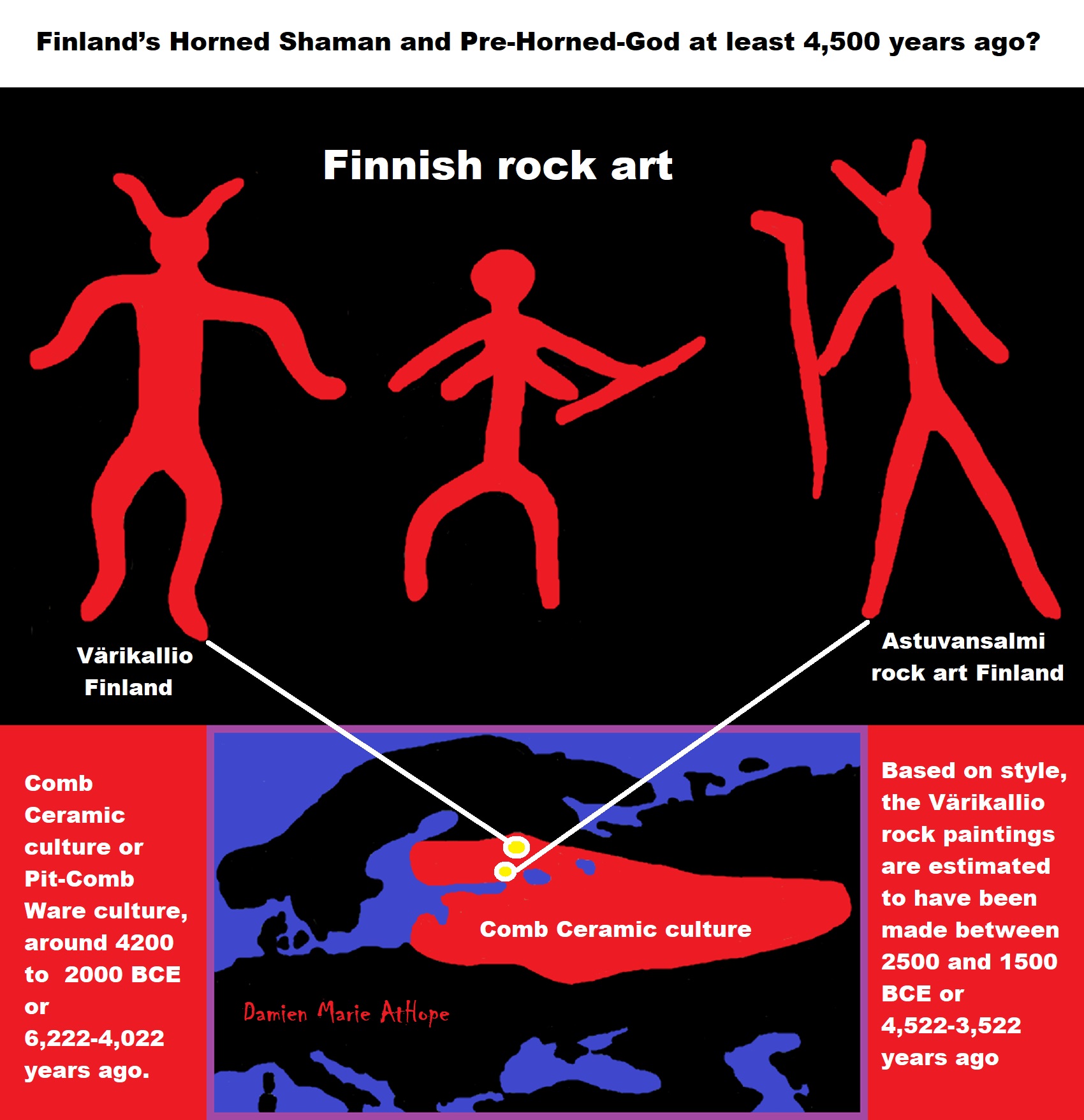
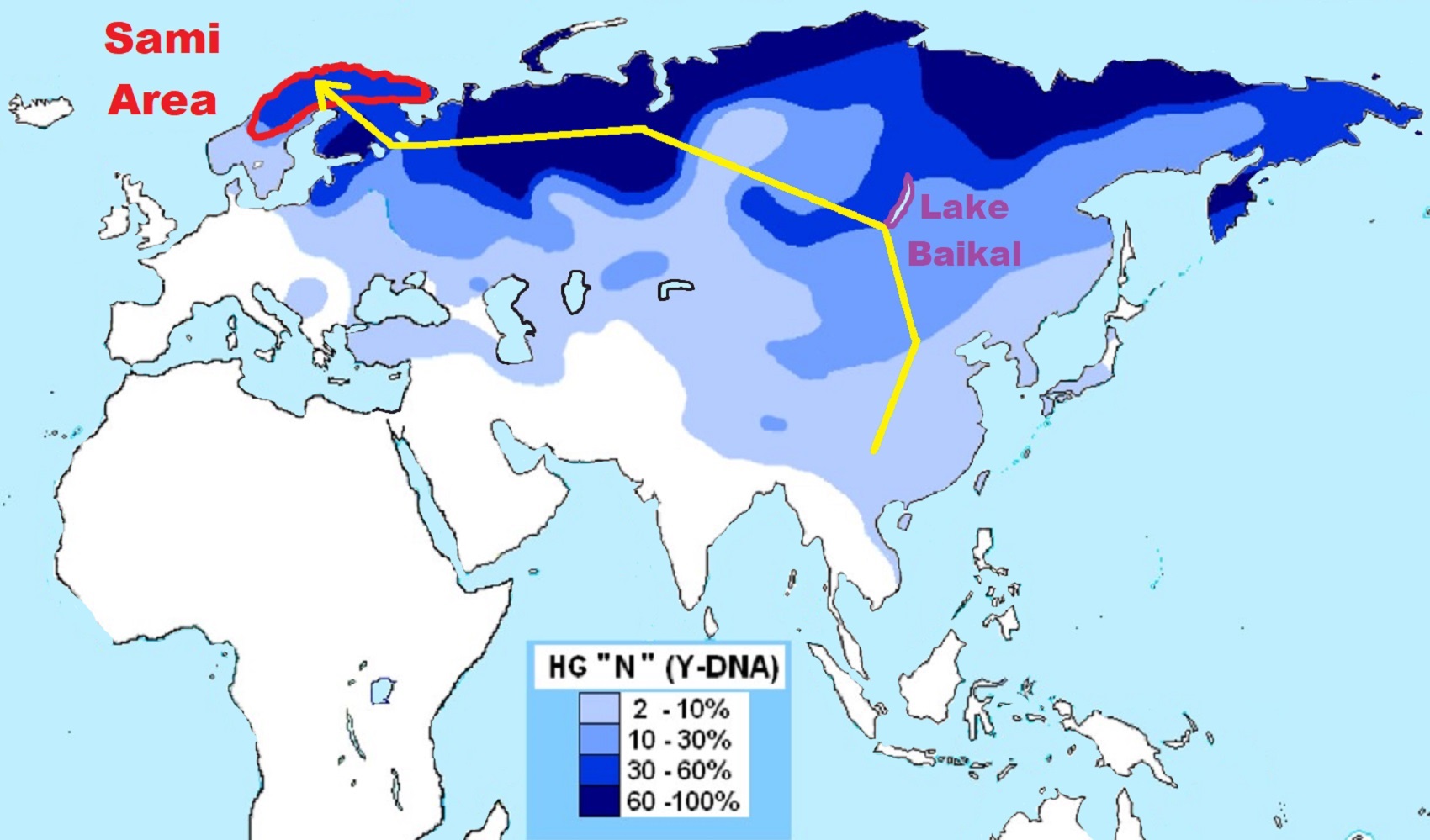
“Haplogroup N1 (N1a, N1c) was found in ancient bones of Liao civilization (at least by 6,200 BCE or around 8,200 years ago):
- Niuheliang (Hongshan Culture, 6500–5000 years ago) 66.7%
- Halahaigou (Xiaoheyan Culture, 5000–4200 years ago) 100.0%
- Dadianzi (Lower Xiajiadian culture, 4200–3600 years ago) 60.0%” ref
“N1a1a (M178) is seen at 60% among Finns and approximately 40% among Latvians, Lithuanians & 35% among Estonians. N1a2b (P43) estimated to be approximately 4,000 to 5,500 years old, is seen at low to moderate frequency among speakers of some other Uralic languages. Haplogroup N-P43 forms two distinctive subclusters of STR haplotypes, Asian and European, the latter mostly distributed among Finno-Ugric-speaking peoples and related populations. N has also been found in many samples of Neolithic human remains exhumed from Liao civilization in northeastern China, and in the circum-Baikal area of southern Siberia. It is suggested that yDNA N, reached southern Siberia from 12-14 kya. From there it reached southern Europe 8-10kya.” ref
“N1a1a1a1a1a-CTS2929/VL29 Found with high frequency among Lithuanians, Latvians, Estonians, northwestern Russians, Swedish Saami, Karelians, Nenetses, Finns, and Maris, moderate frequency among other Russians, Belarusians, Ukrainians, and Poles, and low frequency among Komis, Mordva, Tatars, Chuvashes, Dolgans, Vepsa, Selkups, Karanogays, and Bashkirs.” ref
“N1a1a1a1a1a1a1-L1025/B215 Highest frequency among Lithuanians, significant in Latvians and Estonians and lesser frequency in Belorussians, Ukrainians, South-West Russians, and Poles. With exception of Estonians, L1025 has highest share among N-M231 clades in previously mentioned populations. Also observed in Finland and Sweden, with sporadic instances in Norway, Germany, Netherlands, United Kingdom, the Azores, Czech Republic, and Slovakia.” ref
“N1a1a1a1a2-Z1936,CTS10082 Found with high frequency among Finns, Vepsa, Karelians, Swedish Saami, northwestern Russians, Bashkirs, and Volga Tatars, moderate frequency among other Russians, Komis, Nenetses, Ob-Ugrians, Dolgans, and Siberian Tatars, and low frequency among Mordva, Nganasans, Chuvashes, Estonians, Latvians, Ukrainians, and Karanogays.” ref
“Haplogroup N1c was known as N3. N1c represents the western extent of haplogroup N, which is found all over the Far East (China, Korea, Japan), Mongolia, and Siberia, especially among Uralic speakers of northern Siberia. Haplogroup N1 reaches a maximum frequency of approximately 95% in the Nenets (40% N1c and 57% N1b) and Nganassans (all N1b), two Uralic tribes of central-northern Siberia, and 90% among the Yakuts (all N1c), a Turkic people who live mainly in the Sakha (Yakutia) Republic in central-eastern Siberia. N1c is found chiefly in north-eastern Europe, particularly in Finland (61%), Lapland (53%), Estonia (34%), Latvia (38%), Lithuania (42%), and northern Russia (30%), and to a lower extent also in central Russia (15%), Belarus (10%), eastern Ukraine (9%), Sweden (7%), Poland (4%) and Turkey (4%). N1c is also prominent among the Uralic-speaking ethnicities of the Volga-Ural region, including the Udmurts (67%), Komi (51%), Mari (50%), and Mordvins (20%), but also among their Turkic neighbors like the Chuvashs (28%), Volga Tatars (21%) and Bashkirs (17%), as well as the Nogais (9%) of southern Russia.” ref
“Haplogroup N is a descendant of East Asian macro-haplogroup NO. It is believed to have originated in Indochina or southern China approximately 15,000 to 20,000 years ago. Haplogroup N1* and N1c were both found at high frequency (26 out of 70 samples, or 37%) in Neolithic and Bronze Age remains (4500-700 BCE) from the West Liao River valley in Northeast China (Manchuria) by Yinqiu Cui et al. (2013). Among the Neolithic samples, haplogroup N1 made up two-thirds of the samples from the Hongshan culture (4700-2900 BCE) and all the samples from the Xiaoheyan culture (3000-2200 BCE), hinting that N1 people played a major role in the diffusion of the Neolithic lifestyle around Northeast China, and probably also to Mongolia and Siberia.” ref
“Ye Zhang et al. 2016 found 100% of Y-DNA N out of 17 samples from the Xueshan culture (Jiangjialiang site) dating from 3600–2900 BCE, and among those 41% belonged to N1c1-Tat. It is therefore extremely likely that the N1c1 subclade found in Europe today has its roots in the Chinese Neolithic. It would have progressively spread across Siberia until north-eastern Europe, possibly reaching the Volga-Ural region around 5500 to 4500 BCE with the Kama culture (5300-3300 BCE), and the eastern Baltic with the Comb Ceramic culture (4200-2000 BCE), the presumed ancestral culture of Proto-Finnic and pre-Baltic people. There is little evidence of agriculture or domesticated animals in Siberia during the Neolithic, but pottery was widely used. In that regard, it was the opposite development from the Near East, which first developed agriculture then only pottery from circa 5500 BCE, perhaps through contact with East Asians via Siberia or Central Asia.” ref
- “N1c1a (M178): found in Siberia (Khakass-Daurs)
- N1c1a1 (L708): found in Siberia (Anayins)
- N1c1a1a (P298): found in Siberia (Yakuts)
- N1c1a1a1 (L392, L1026): Finno-Ugric branch; found throughout north-east Europe
- N1c1a1a1a (CTS2929/VL29): Baltic-Finnic branch
- N1c1a1a1a1 (L550): West Finnic branch; found around the Baltic Sea and in places settled by the Vikings
- N1c1a1a1a1a (L1025)
- N1c1a1a1a1a1 (M2783): found especially in Balto-Slavic countries, with a peak in Lithuania and Latvia
- N1c1a1a1a1a2 (Y4706): found mostly in Finland and Scandinavia
- N1c1a1a1a2 (CTS9976): East Finnic branch; found among the Chudes (Karelia, Estonia)
- N1c1a1a1a2a (L1022)
- N1c1a1a1a2a1 (Z1936): Finno-Permic branch; found in the Volga-Ural region and among the Karelians and Savonians
- N1c1a1a1a2a1a (Z1925): found in Finland, Lapland, Scandinavia, the Volga-Ural and the Altai
- N1c1a1a1a2a1a1 (Z1933)
- N1c1a1a1a2a1a1a (Z1927): found among the Karelians
- N1c1a1a1a2a1a1b (CTS8565): found among the Savonians” ref
“Today, the sharp western boundary for the distribution of hgs C, D and Z lies in the VUB, where they display intermediate frequencies: C (0.3–11.8%), Z (0.2–0.9%), and D (0.6–12%). Sub-hgs Z1 and D5 are also present in modern-day Saami, with highest cumulated frequencies (15.9%) in the Saami of Finland, the easternmost part of the Saami geographical distribution. A precise date for the arrival of these ‘Central/East Siberian’ lineages in NEE is difficult to estimate, although the presence of ‘Central/East Siberian’ lineages in the 3,500 year-old aBOO site indicates that an eastern genetic influence pre-dates historical westward expansions from Central/East Siberia of, e.g., the Huns and the Mongols (∼400–1,500 CE). We present here direct genetic evidence for a prehistoric gene-flow from Siberia. On the basis of modern-day genetic data, hg Z1 was proposed to have been introduced into populations of the VUB and Saami by migrations from Siberia via the southern Urals to the Pechora and Vychegda basins (northwest Urals), associated with the appearance of the Kama culture ∼8,000 years ago.” ref
“D5’6 (16189) is mainly found in East Asia and Southeast Asia, especially in China, Korea, and Japan. It does not appear to have participated in the migration to the Americas, and frequencies in Central, North, and South Asia are generally lower, although the D5a2a2 subclade is prevalent (57/423 = 13.48%) among the Yakuts, a Turkic-speaking group that migrated to Siberia in historical times under the pressure of the Mongol expansion.” ref
“mt-DNA D5a3 – Tibet, Korea, Japan (time to most recent common ancestor 11,100 years ago )
- D5a3a – China, Tibet, Finland
Mansi people
“The Mansi are an Ugric indigenous people living in Khanty–Mansia, an autonomous okrug within Tyumen Oblast in Russia. In Khanty–Mansia, the Khanty and Mansi languages have co-official status with Russian. The Mansi language is one of the postulated Ugric languages of the Uralic family. The Mansi people were formerly known as the Voguls. The Mansi are one of the closest linguistic relatives of modern Hungarians. The Mansi share many similarities with the Khanty people and together they are called Ob-Ugric peoples. Their languages are closely related but also clearly distinct from each other. Weapons used by the Mansi were advanced for the period and included longbows, arrows, spears, and the use of iron helmets and chain mail. In a 2018 study, Mansi samples showed variation in the amounts of West and East Eurasian admixtures. Some of them clustered with the Khanty, while outlier samples had additional West Eurasian admixture, making them closer to Uralic-speakers from Volga-Ural region.” ref
“A notable part of the traditional Mansi religion is the bear cult. A bear celebration is held in connection with the bear hunt (a similar concept to the Finnish peijaiset); it lasts for several days and involves songs, dances and plays. Mansi folklore also includes mythical and heroic stories and fate songs, which are biographical poems. An example of the traditional material culture of Ob-Ugric peoples is ornamenting leather clothing and birchbark objects with mosaics. According to a 2019 study, in addition to having a high level of East Eurasian-like ancestry, the Mansi have also West Eurasian admixture. Their admixture can be modeled to be about 60 % Bronze Age Baikal Lake-like and 40% Srubnaya-like, or about 54% Nganasan-like and about 38% Srubnaya-like, with additional Ancient North Eurasian ANE-related admixture.” ref
“Bear worship (also known as the bear cult or arctolatry) is the religious practice of the worshipping of bears found in many North Eurasian ethnic religions such as among the Sami people in Scandinavia, Nivkh people in the Sakhalin Island and the lower Amur River of the Russian Far East and Manchuria/Northeastern China, and Ainu people in the area of the Sea of Okhotsk, including Hokkaido Island, Northeast Honshu Island, Sakhalin Island, the Kuril Islands, the Kamchatka Peninsula, and Khabarovsk Krai, since before the arrival of the Yamato Japanese and Russians.” ref, ref, ref, ref
“Likewise, Bear worship is seen in the Basques, Germanic peoples, Slavs, and Finns. There are also a number of deities from Celtic Gaul and Britain associated with the bear, and the Dacians, Thracians, and Getians were noted to worship bears and annually celebrate the bear dance festival. The bear is featured on many totems throughout northern cultures that carve them. In an article in Enzyklopädie des Märchens, American folklorist Donald J. Ward noted that a story about a bear mating with a human woman, and producing a male heir, functions as an ancestor myth to peoples of the northern hemisphere, namely, from North America, Japan, China, Siberia and Northern Europe.” ref
Kama Culture (5300-3300 BCE or around 7,300 to 5,300 years ago)
“The Kama culture (also known as Volga-Kama or Khutorskoye from finds near the Khutorskoye settlement) is an Eastern European Subneolithic archaeological culture from the 6th-4th millennium BCE. The area covers the Kama, Vyatka, and the Ik–Belaya watersheds (Perm and Kirov regions, Udmurtia, Tatarstan, and Bashkortostan). In its development the Kama culture passed through three stages: early (sites: Mokino, Ust-Bukorok, Ziarat, Ust-Shizhma), middle (sites: Khutorskaya Kryazhskaya, Lebedynska), and late (sites: Lyovshino, Chernashka). The culture was formed in the early Neolithic on a local Mesolithic substrate under the influence of southern steppe populations. The prehistoric phase according to archaeologists emerged around 2,000 BCE. During this stage, the culture existed in the area that began in the Ufa River (in modern Bashkortostan) through the entire Kama drainage area to the upper Pechora River (Komimu). In the southern regions the influence of the nearby forest-steppe cultures of the Middle Volga can be observed during the whole period of existence. In the developed Neolithic a population of Trans-Ural origin penetrates in the upper and middle Kama. In this period there are formed local variants: Verkhnekamsk, Ikska-Belsky, and Nizhnekamsk. At the end of the Neolithic the lower Kama falls under the influence of the Early Eneolithic Samara culture.” ref
“Linguist Asko Parpola (2022) associates the Kama culture and the Elshanka culture with the early Proto-Uralic language, which would later expand eastwards and westwards with the Seima-Turbino material culture. Uralic languages would later be transmitted by language shift from groups of hunters and fishers participating in the spread of the Seima-Turbino culture towards Siberia and back to Northeastern Europe. The pottery is thick-walled, egg-shaped, both round- and pointed-bottomed. The stone and bone inventory of the pottery culture demonstrated a Mesolithic character. It is heavily ornamented with comb stamp designs, vertical and horizontal zigzags, sloping rows, braids, triangles, banded comb meshes. Kama culture is noted for its metal work and handicrafts. The instruments for work include scrapers, sharpeners, knives, leaf-shaped and semi-rhombic arrowheads, chisels and adzes, weights.” ref
“The definition of the Kama culture remains a subject of debate. Initially, it was determined by O.H. Bader on the territory of the Middle Kama, where he distinguished two phases: Borovoye (Borovoy Lake I) and Khutorskoye. A.Kh. Khalikov united the finds with Pitted and Combed Ware of the Lower and Middle Kama into one Volga-Kama culture. I.V. Kalinina, based on the study of ceramics came to the conclusion that there are two distinct cultures: Volga-Kama pitted pottery and Kama combed pottery. A.A. Vibornov identified three stages of development in the Kama culture, and V.P. Denisov and L.A. Nagovitchin joined the Kama Neolithic finds with combed ceramics into a single Khutorskoye culture, synchronous with the Poluden culture in the Ural Mountains. Its comb decorated pottery is similar to that of the Upper Volga culture. The Kama culture is also culturally close and genetically related to the Volosovo culture. There are scholars who also believe that the culture is related to the Dnieper-Donetsk.” ref
Comb Ceramic culture (4200-2000 BCE or around 6,200 to 4,000 years ago)
“The Comb Ceramic culture or Pit-Comb Ware culture, often abbreviated as CCC or PCW, was a northeast European culture characterised by its Pit–Comb Ware. It existed from around 4200 to 2000 BCE. The bearers of the Comb Ceramic culture are thought to have still mostly followed the Mesolithic hunter-gatherer (Eastern Hunter-Gatherer) lifestyle, with traces of early agriculture. The distribution of the artifacts found includes Finnmark (Norway) in the north, the Kalix River (Sweden), the Gulf of Bothnia (Finland) in the west, and the Vistula River (Poland) in the south. It would include the Narva culture of Estonia and the Sperrings culture in Finland, among others. They are thought to have been essentially hunter-gatherers, though e.g. the Narva culture in Estonia shows some evidence of agriculture. Some of this region was absorbed by the later Corded Ware horizon.” ref
“The Pit–Comb Ware culture is one of the few exceptions to the rule that pottery and farming coexist in Europe. In the Near East farming appeared before pottery, then when farming spread into Europe from the Near East, pottery-making came with it. However, in Asia, where the oldest pottery has been found, pottery was made long before farming. It appears that the Comb Ceramic Culture reflects influences from Siberia and distant China. However, calibrated radiocarbon dates for the comb-ware fragments found (e.g., in the Karelian isthmus), give a total interval of 5600 – 2300 BCE or around 7,600 to 4,300 years ago. The settlements were located at sea shores or beside lakes and the economy was based on hunting, fishing and the gathering of plants. In Finland, it was a maritime culture which became more and more specialized in hunting seals. The dominant dwelling was probably a teepee of about 30 square meters where some 15 people could live. Also rectangular houses made of timber become popular in Finland from 4000 BC cal. Graves were dug at the settlements and the dead were covered with red ochre. The typical Comb Ceramic age shows an extensive use of objects made of flint and amber as grave offerings.” ref
“In earlier times, it was often suggested that the spread of the Comb Ware people was correlated with the diffusion of the Uralic languages, and thus an early Uralic language would have been spoken throughout this culture. It was also suggested that bearers of this culture likely spoke Finno-Ugric languages. Another view is that the Comb Ware people may have spoken Palaeo-European languages, as some toponyms and hydronyms also indicate a non-Uralic, non-Indo-European language at work in some areas. In addition, modern scholars have located the Proto-Uralic homeland east of the Volga, if not even beyond the Urals. The great westward dispersal of the Uralic languages is suggested to have happened long after the demise of the Comb Ceramic culture, perhaps in the 1st millennium BCE. The culture was characterized by small figurines of burnt clay and animal heads made of stone. The animal heads usually depict moose and bears and were derived from the art of the Mesolithic. There were also many rock paintings. There are sources noting that the typical comb ceramic pottery had a sense of luxury and that its makers knew how to wear precious amber pendants.” ref
Pre-Finno-Ugric substrate
“Pre-Finno-Ugric substrate refers to substratum loanwords from unidentified non-Indo-European and non-Uralic languages that are found in various Finno-Ugric languages, most notably Sami. The presence of Pre-Finno-Ugric substrate in Sami languages was demonstrated by Ante Aikio. Janne Saarikivi points out that similar substrate words are present in Finnic languages as well, but in much smaller numbers. The number of substrate words in Sámi likely exceeds one thousand words. Borrowing to Saami from Paleo-Laplandic probably still took place after the completion of the Great Saami Vowel Shift. Paleo-Laplandic likely became extinct about 1500 years ago. The Nganasan language also has many substrate words from unknown extinct languages in the Taimyr peninsula.” ref
“There are irregularities in Sami substrate words which suggest they might have been borrowed from distinct, but related languages. In the west, the substrate languages probably had an s-type sibilant which corresponds to an š-type sibilant in the east. As we only have fragments of Lakelandic Sami which were preserved in Finnish placenames and dialectal vocabulary, the features of the Paleo-Lakelandic substrate in Lakelandic Sami cannot be studied. Many placenames in Finland come from Sami words of unknown origin which are likely substrate words, such as jokuu from Proto-Sami *čuokōs ‘track, way’. The Sami substrate in Finnish dialects also reveals that Lakelandic Sami languages had a high number of words with an obscure origin, likely deriving from old languages of the region.” ref
“According to Aikio, the speakers of the Proto-Samic language arrived in Lapland around 650 BCE or around 2,650 years ago and fully assimilated the local Paleo-European populations by the middle of 1st millennium CE. In his opinion, the detailed reconstruction of these languages is impossible. The languages of more eastern post-Swiderian cultures might have influenced Finno-Ugric languages as well. According to Peter Schrijver, some of these substrate languages probably had many geminated consonants. A lexical comparison with the hypothetical Pre-Germanic substratum yields no results. There are also some examples of possible substrate words in Finno-Volgaic languages that differ from the Pre-Sami substrate, i.e. Proto-Finno-Volgaic *täštä “star”, or *kümmin “ten”. Some words in Finno-Volgaic languages contain rare consonant clusters, which suggests loanwords from unknown languages. Finnish words such as jauho (Eng. flour), lehmä (cow), tähti (star), tammi (oak) and ihminen (human) could be substrate words.” ref
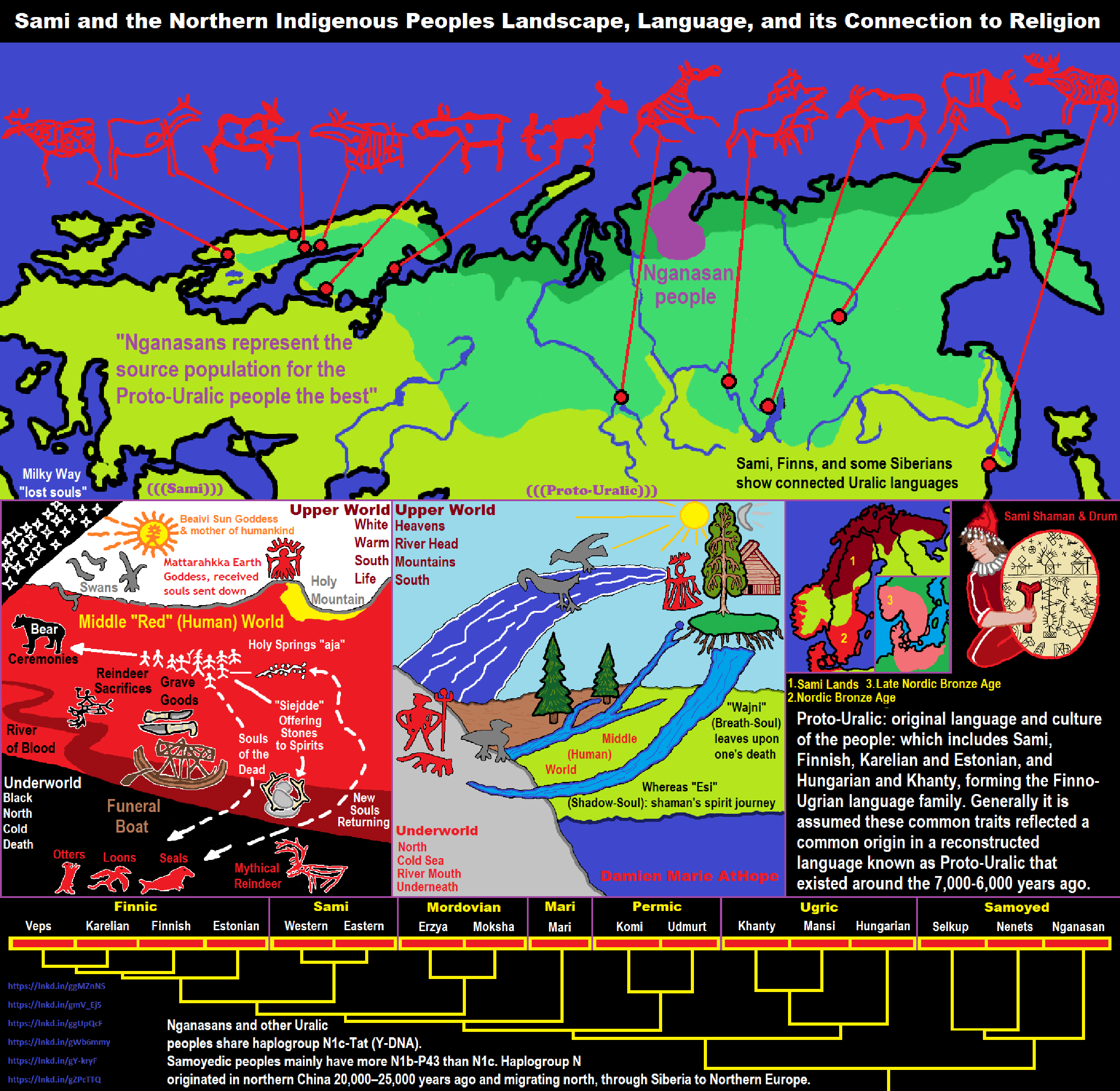
“The Uralic languages form a language family of 38 languages spoken natively by approximately 25 million people, predominantly in Europe (over 99% of the family’s speakers) and northern Asia (less than 1%). The Uralic languages with the most native speakers are Hungarian (which alone accounts for nearly 60% of speakers), Finnish, and Estonian. Other significant languages with fewer speakers are Erzya, Moksha, Mari, Udmurt, Sami, Komi, and Vepsian, all of which are spoken in northern regions of Scandinavia and the Russian Federation.” ref
A computational phylogenetic study by Honkola, et al. (2013) classifies the Uralic languages as follows. Estimated divergence dates from Honkola, et al. (2013) are also given.
- Uralic (5300 years ago)
- Samoyedic
- Finno-Ugric (3900 years ago)

ref, ref, ref, ref, ref, ref, ref, ref, ref, ref, ref, ref, ref, ref, ref, ref, ref
“The shaman is, above all, a connecting figure, bridging several worlds for his people, traveling between this world, the underworld, and the heavens. He transforms himself into an animal and talks with ghosts, the dead, the deities, and the ancestors. He dies and revives. He brings back knowledge from the shadow realm, thus linking his people to the spirits and places which were once mythically accessible to all.–anthropologist Barbara Meyerhoff” ref

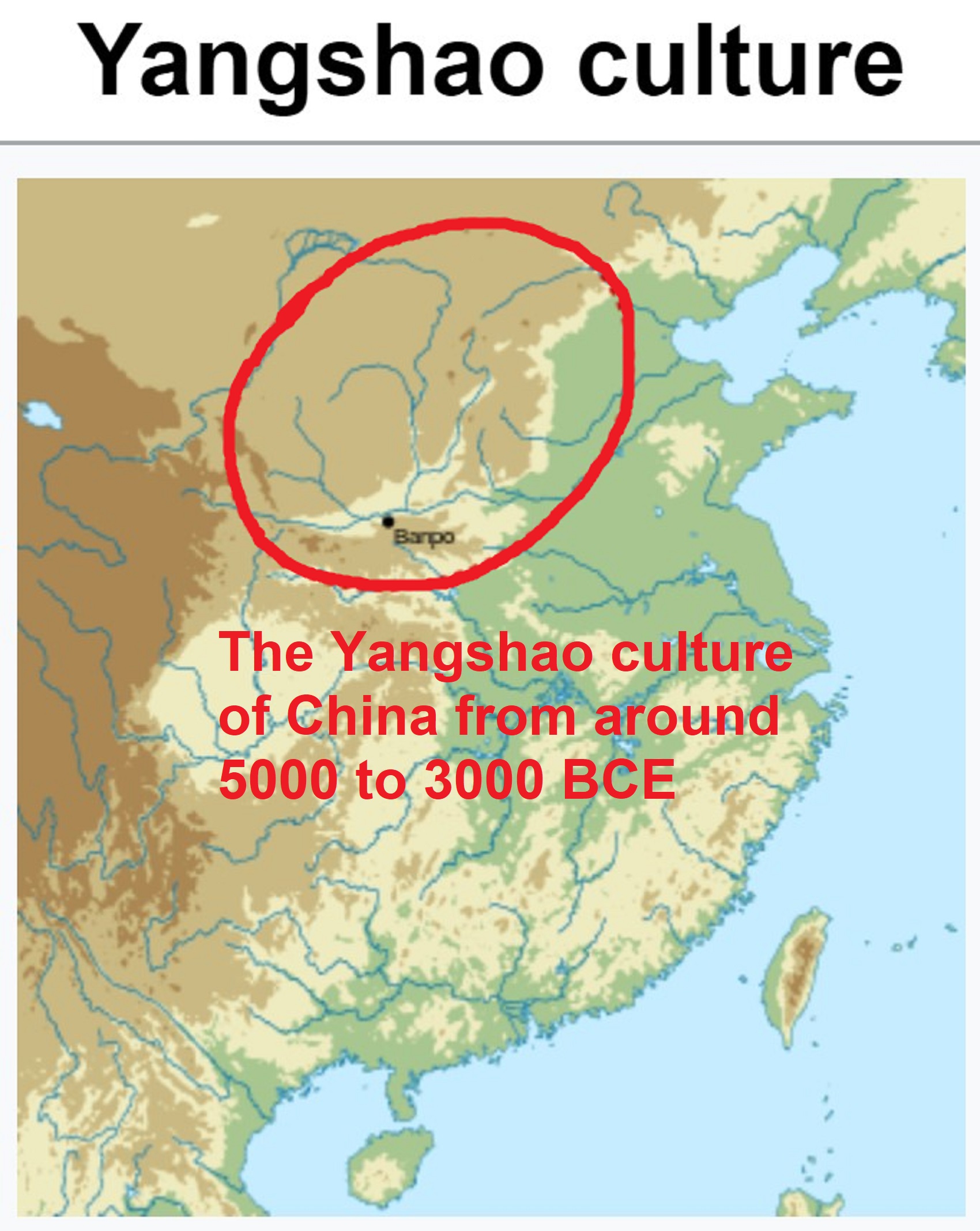
“The Yangshao culture was a Neolithic culture that existed extensively along the middle reaches of the Yellow River in China from 5000 to 3000 BCE or around 7,000 to 5,000 years ago. Recent research indicates a common origin of the Sino-Tibetan languages with the Cishan, Yangshao and/or the Majiayao cultures. The main food of the Yangshao people was millet, with some sites using foxtail millet and others proso millet, though some evidence of rice has been found. The Yangshao culture crafted pottery: Yangshao artisans created fine white, red, and black painted pottery with human facial, animal, and geometric designs. Unlike the later Longshan culture, the Yangshao culture did not use pottery wheels in pottery-making. Excavations found that children were buried in painted pottery jars. Pottery style emerging from the Yangshao culture spread westward to the Majiayao culture, and then further to Xinjiang and Central Asia. The Yangshao culture produced silk to a small degree and wove hemp. Men wore loin clothes and tied their hair in a top knot. Women wrapped a length of cloth around themselves and tied their hair in a bun.” ref
“Although early reports suggested a matriarchal culture, others argue that it was a society in transition from matriarchy to patriarchy, while still others believe it to have been patriarchal. The debate hinges on differing interpretations of burial practices. The discovery of a dragon statue dating back to the fifth millennium BC in the Yangshao culture makes it the world’s oldest known dragon depiction, and the Han Chinese continue to worship dragons to this day. The archaeological site of the village of Banpo near Xi’an is one of the best-known ditch-enclosed settlements of the Yangshao. Another major settlement called Jiangzhai was excavated out to its limits, and archaeologists found that it was completely surrounded by a ring-ditch. Both Banpo and Jiangzhai also yielded incised marks on pottery which a few have interpreted as numerals or perhaps precursors to Chinese characters, but such interpretations are not widely accepted.” ref
“The Yangshao culture is conventionally divided into three phases:
- The early period or Banpo phase, c. 5000–4000 BCE) is represented by the Banpo, Jiangzhai, Beishouling, and Dadiwan sites in the Wei River valley in Shaanxi.
- The middle period or Miaodigou phase, c. 4000–3500 BCE) saw an expansion of the culture in all directions, and the development of hierarchies of settlements in some areas, such as western Henan.
- The late period (c. 3500–3000 BCE) saw a greater spread of settlement hierarchies. The first wall of rammed earth in China was built around the settlement of Xishan (25 ha) in central Henan (near modern Zhengzhou).” ref
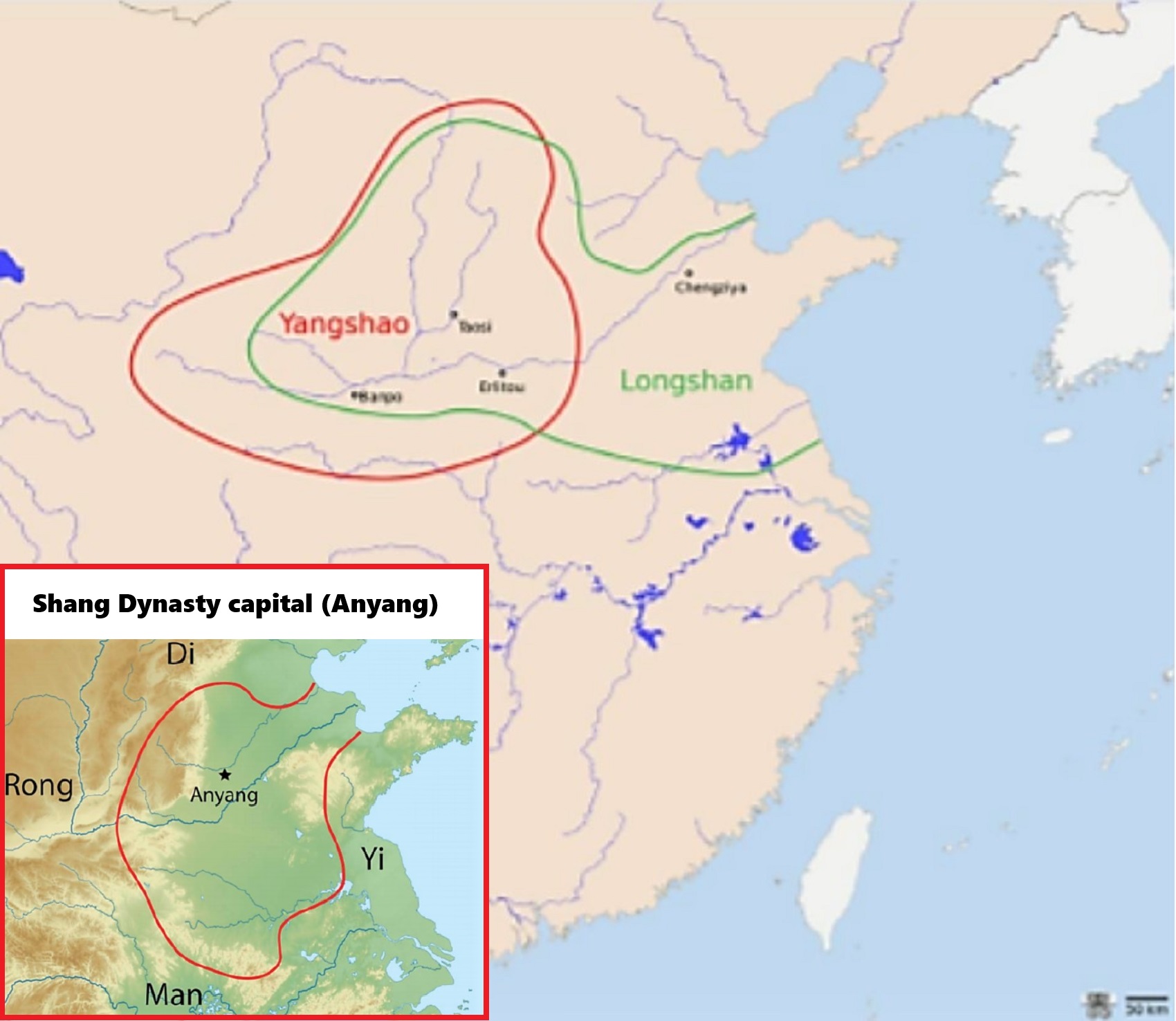
“Over the course of those six millennia leading up to the Xia Dynasty, Neolithic communities became more diverse and complex. For instance, for the period 5000 – 3000 BCE, archaeologists have identified at least eight major regional Neolithic cultures located along rivers and coasts. They did so by examining pottery styles and village settlement patterns. One example is Yangshao culture, which was concentrated along the middle reaches of the Yellow River. Over one thousand sites left behind by millet-farming village communities have been discovered. Jiangzhai (c. 4000 BCE), for instance, was a moated village settlement that occupied roughly thirteen acres. It was composed of related lineages and tribal in organization. During the third millennium BCE, Yangshao culture was gradually supplanted by Longshan culture (c. 3000 – 1900 BCE), which emerged further to the east, along the middle and lower reaches of the Yellow River. Archaeologists excavated a site near the town after which Longshan was named, they found evidence for a culture that had laid the foundations for the kingdoms that emerged in the second millennium BCE, including the ruins of numerous walled towns with cemeteries outside. Their rammed-earth walls protected urban areas with public buildings, roads, and drainage systems. The cemetery’s arrangement suggests that people living in the towns were buried alongside clan members, but also that some members were wealthier and more powerful: while most graves had nothing but a skeleton, others contained numerous artifacts, such as pottery and jade.” ref
“Based on this evidence, archaeologists have concluded that, during the third millennium BCE, population grew and some of it shifted from villages to walled towns. These walled towns developed into political and economic centers exercising control over and serving as protection for surrounding communities. Individuals with more elaborate graves were likely political and religious leaders, and served as chieftains. Hence, numerous competing chiefdoms emerged, providing the foundation for more powerful kingdoms to follow. Ancient Chinese histories identify the first major kingdom as the Xia Dynasty (c. 1900 – 1600 BCE). However, these were written many centuries after the kingdom about which they speak and, lacking written evidence from the dynasty itself, specialists have been unable to definitively establish its location. Nevertheless, most agree that the Xia capital was located along the Yellow River at Erlitou [are-lee-toe]. At its peak of activity from 1900 – 1600 BCE, this town looks like something more complex than a chiefdom. Erlitou included a central, walled palace complex, workshops for the production of bronze and pottery, and elite burials containing bronze weapons and jade, suggesting a socially stratified, Bronze Age civilization and kingdom. That is why many historians identify it as the capital of the Xia Dynasty.” ref
“With the Shang Dynasty (1600 – 1046 BCE), we formally step into China’s historical period. A Chinese scholar came across mysterious bones that were being ground up for use as medicine. He immediately recognized that the Chinese characters inscribed on them were very ancient. Subsequently, the origin of these bones was traced to fields in Anyang [anneyawng], China where, excavations were carried out. Similar to the discovery of the Indus Valley Civilization, a lost civilization was revealed on the North China Plain, the one difference being that traditional histories of a later time had documented this one. The Shang Dynasty capital (was Anyang) and boundaries. The Shang centered in the North China Plain, along the lower reaches of the Yellow River. The other labels indicate names given by the Shang rulers to tribal peoples surrounding the kingdom. The findings were substantial. A diverse array of settlements with a royal capital at the center covered nearly thirty square kilometers. Archaeologists have identified 53 pounded earth foundations as the floors of royal palace-temples and the ruins in their vicinity as residential areas for elites and commoners; sacrificial pits; and workshops for the production of bronze, pottery, and stone. Also, a royal cemetery with eight large tombs and dozens of smaller ones lies to the northwest. The larger graves were roughly half the size of a football field, each accessible through four ramps whose orientation to the cardinal directions gives them the appearance of crosses. Deep down at the bottom of each tomb’s central shaft, wooden chambers were built to house the dead bodies of Shang kings. Shockingly to us, dozens of human skeletons were placed above and below these, presumably as servants to accompany rulers in the afterlife (view reconstruction of a Xia Dynasty palace at Erlitou.” ref
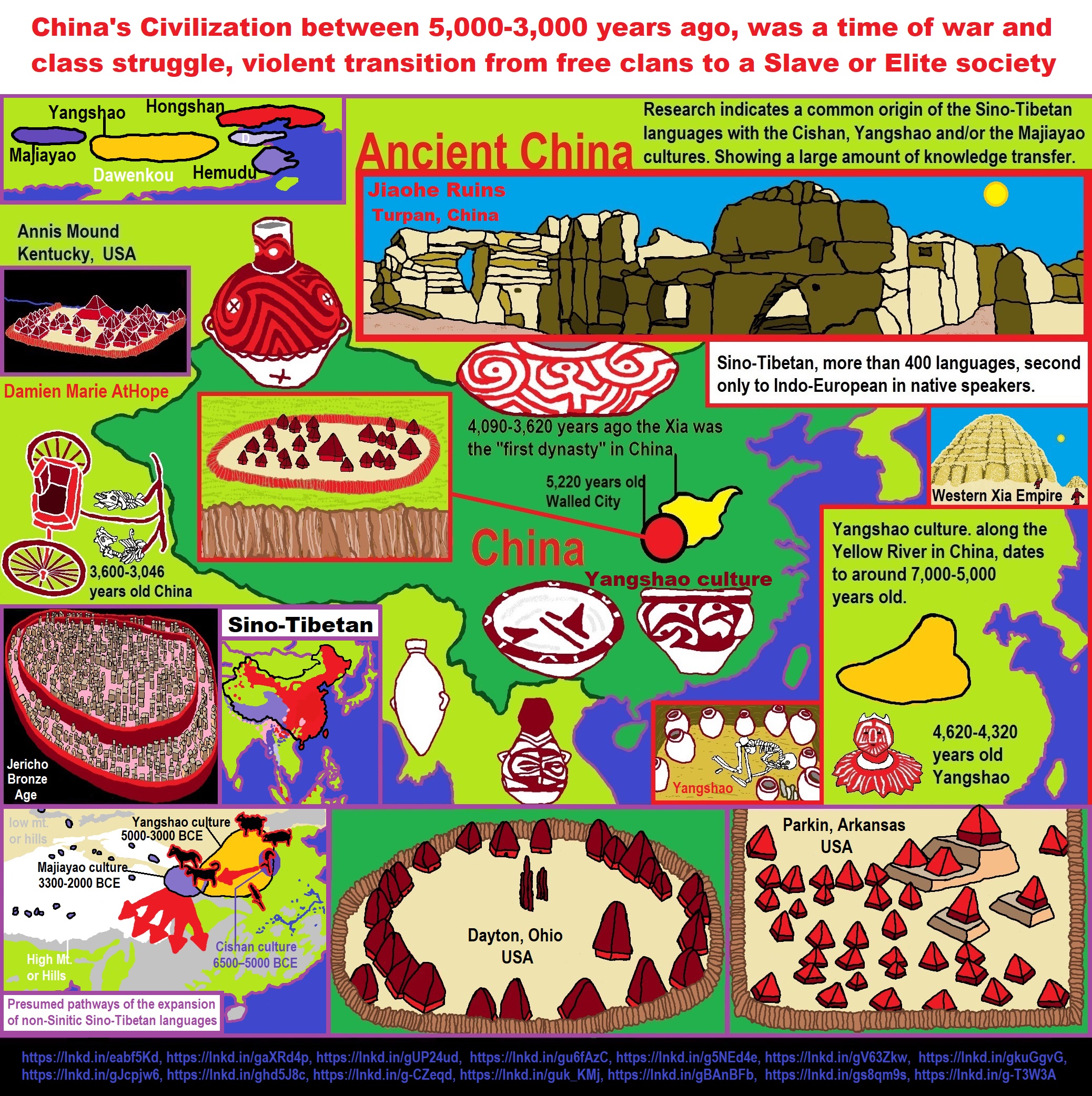
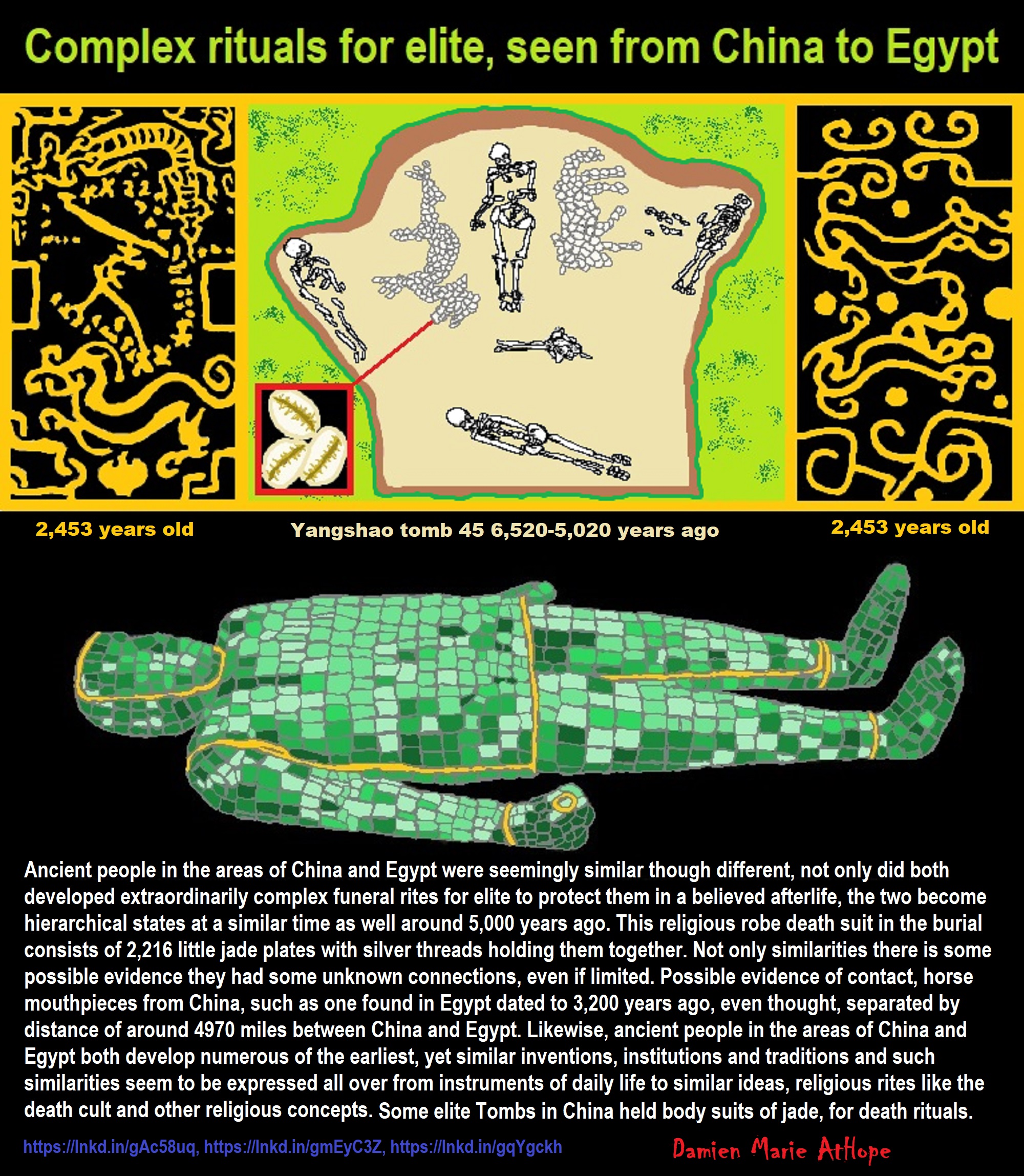
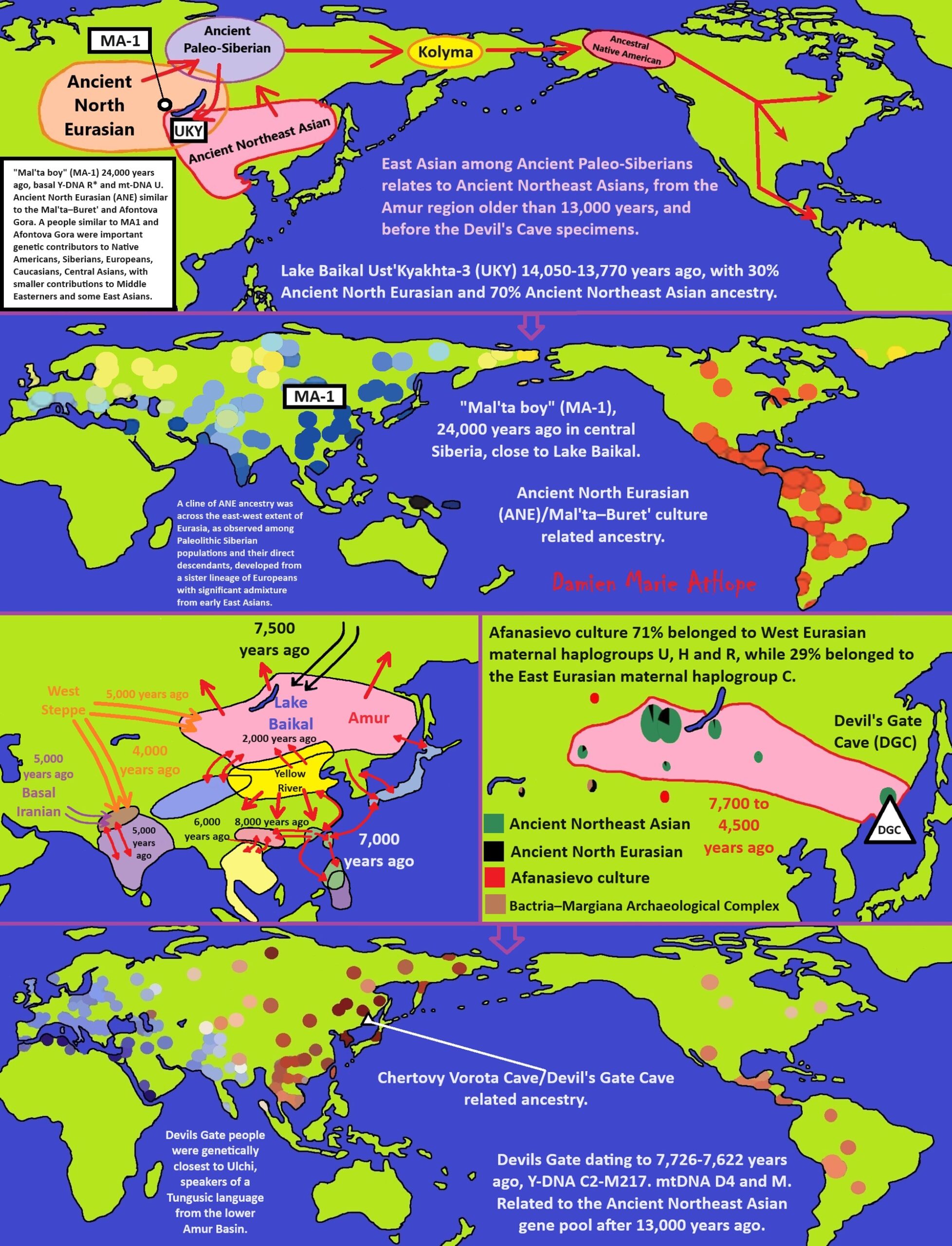
ref, ref, ref, ref, ref, ref, ref, ref, ref, ref, ref, ref, ref, ref, ref
“A 2016 study found that the global maximum of Ancient North Eurasian (ANE) ancestry occurs in modern-day Kets, Mansi, Native Americans, and Selkups. ANE ancestry has spread throughout Eurasia and the Americas in various migrations since the Upper Paleolithic, and more than half of the world’s population today derives between 5 and 42% of their genomes from the Ancient North Eurasians. Significant ANE ancestry can be found in Native Americans, as well as in regions of northern Europe, South Asia, Central Asia, and Siberia. It has been suggested that their mythology may have featured narratives shared by both Indo-European and some Native American cultures, such as the existence of a metaphysical world tree and a fable in which a dog guards the path to the afterlife.” ref
Ancient Northern East Asian/ later became Ancient Northeast Asian
Ancient Paleo-Siberian
Mal’ta–Buret’ culture (Mal’ta boy MA-1)
The Kolyma Shaitans: Legends and Reality (I only use just a small part)
“A unique “shaitan” burial was discovered on the bank of Omuk-Kuel Lake in the Middle-Kolyma ulus in Yakutia. According to the legends, buried in it are mummified remains of a shaman woman who died during a devastating smallpox epidemics in the 18th c. In an attempt to overcome the deadly disease, the shaman’s relatives used her remains as an emeget fetish. The author believes that these legends reflect the real events of those far-away years. The Arabic word “shaitan” came to the Russian language from Turkic languages. According to Islamic tradition, a shaitan is a genie, an evil spirit, a demon. During Russian colonization and Christianization of Siberia, all sacred things used by the aborigines as fetishes, patron spirits of the family, and the tribe, grew to be called “shaitans.” There are various facts, dating to the 18th and 19th cc., confirming that this word also referred to the mummified remains of outstanding shamans.” ref
“In the 1740s, a member of the Second Kamchatka Expedition Yakov Lindenau wrote, “Meat is scratched off the [shaman’s] bones and the bones are put together to form a skeleton, which is dressed in human’s clothes and worshipped as a deity. The Yukagirs place such dressed bones…in their yurts, their number can sometimes reach 10 or 15. If somebody commits even a minor sacrilege with respect to these bones, he stirs up rancor on the part of the Yukagirs… While traveling and hunting, the Yukagirs carry these bones in their sledges, and moreover, in their best sledges pulled by their best deer. When the Yukagirs are going to undertake something really important, they tell fortune using these skeletons: lift a skeleton up, and if it seems light, it means that their enterprise will have a favorable outcome. The Yukagirs call these skeletons stariks (old men), endow them with their best furs, and sit them on beds covered with deer hides, in a circle, as though they are alive.” (Lindenau, 1983, p. 155)” ref
“In the late 19th c., a famous explorer of aboriginal culture V. I. Jochelson noted the changes that occurred in the ritual in the last century and a half. So, the Yukagirs divided among themselves the shaman’s meat dried in the sun and then put it in separate tents. The dead bodies of killed dogs were left there as well. “After that,” V. I. Jochelson writes, “they would divide the shaman’s bones, dry them and wrap in clothes. The skull was an object of worshipping. It was put on top of a trunk (body) cut out of wood. A caftan and two hats – a winter and a summer one – were sewn for the idol. The caftan was all embroidered. On the skull, a special mask was put, with holes for the eyes and the mouth… The figure was placed in the front corner of the home. Before a meal, a piece of food was thrown into the fire and the idol was held above it. This feeding of the idol… was committed before each meal.” (V. I. Jochelson, 2005, pp. 236—237)” ref
“The idol was kept by the children of the dead shaman. One of them was inducted into the shamanism mysteries while his father was still alive. The idol was carried in a wooden box. Sometimes, in line with the air burial ritual, the box was erected on poles or trees, and the idol was taken out only before hunting or a long journey so that the outcome of the enterprise planned could be predicted. With time, the Yukagirs began using wooden idols as charms. V. I. Jochelson notes that by the late 19th c. the Yukagirs had developed a skeptical attitude towards idols and referred to them as “shaitans.” In this way, under the influence of Christianity, the worshipped ancestor’s spirit turned into its opposite – an evil spirit, a devil, a Satan.” ref
Ancestral Native American, Ancient Beringian
14,000-year-old Ust-Kyakhta-3 (UKY) individual found near Lake Baikal
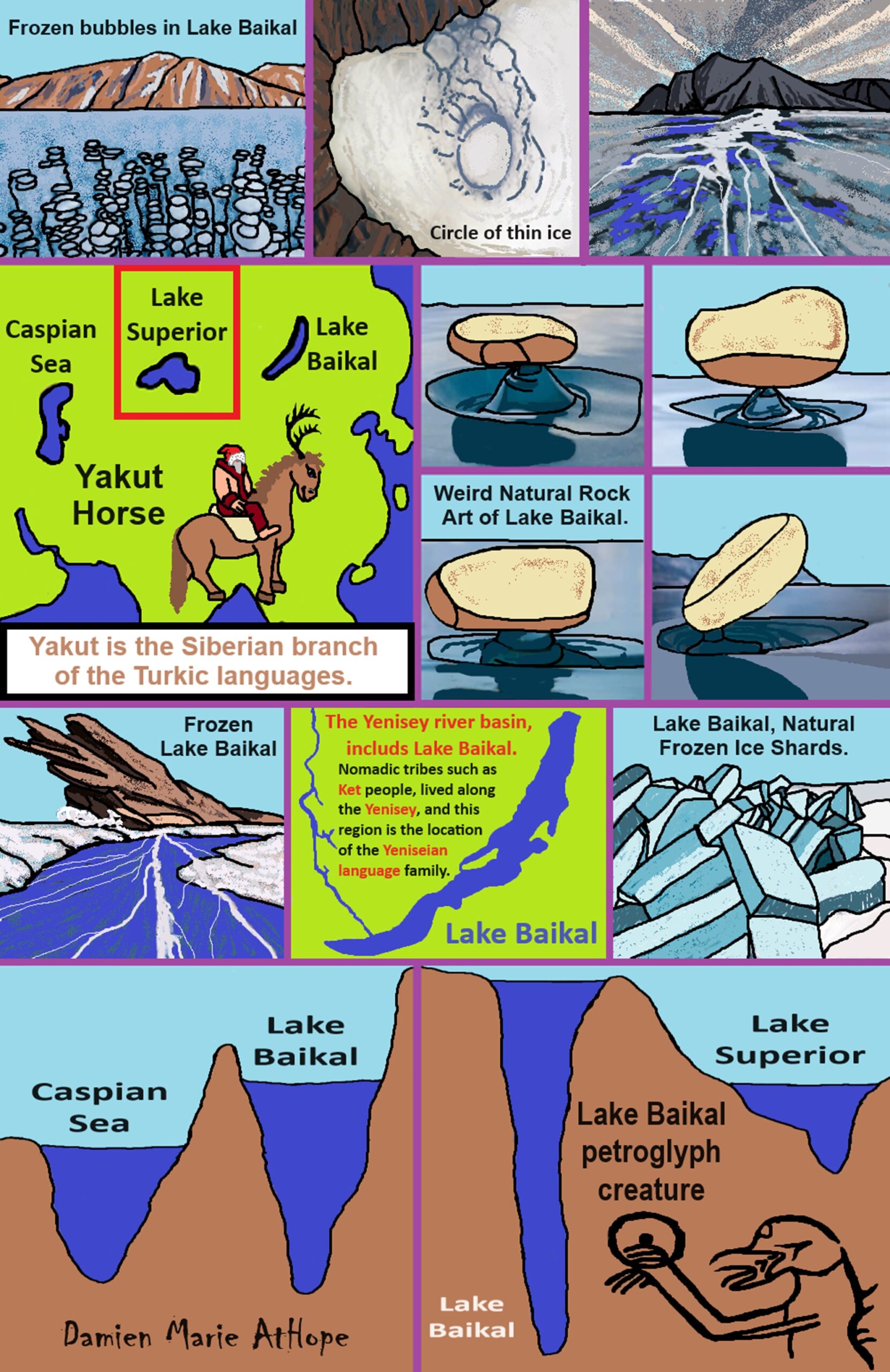
People reached Lake Baikal Siberia around 25,000 years ago. They (to Damien) were likely Animistic Shamanists who were also heavily totemistic as well. Being animistic thinkers they likely viewed amazing things in nature as a part of or related to something supernatural/spiritual (not just natural as explained by science): spirit-filled, a sprit-being relates to or with it, it is a sprit-being, it is a supernatural/spiritual creature, or it is a great spirit/tutelary deity/goddess-god. From there comes mythology and faith in things not seen but are believed to somehow relate or interact with this “real world” we know exists.
Both areas of Lake Baikal, one on the west side with Ancient North Eurasian culture and one on the east side with Ancient Northern East Asian culture (later to become: Ancient Northeast Asian culture) areas are the connected areas that (to Damien) are the origin ancestry religion area for many mythologies and religious ideas of the world by means of a few main migrations and many smaller ones leading to a distribution of religious ideas that even though are vast in distance are commonly related to and centering on Lake Baikal and its surrounding areas like the Amur region and Altai Mountains region.
“Lakes are often mysterious bodies of water, especially if they are very deep or surrounded by mountains. No wonder legends and mysteries thrive about them, including monsters that supposedly lurk in their bottomless depths.” ref
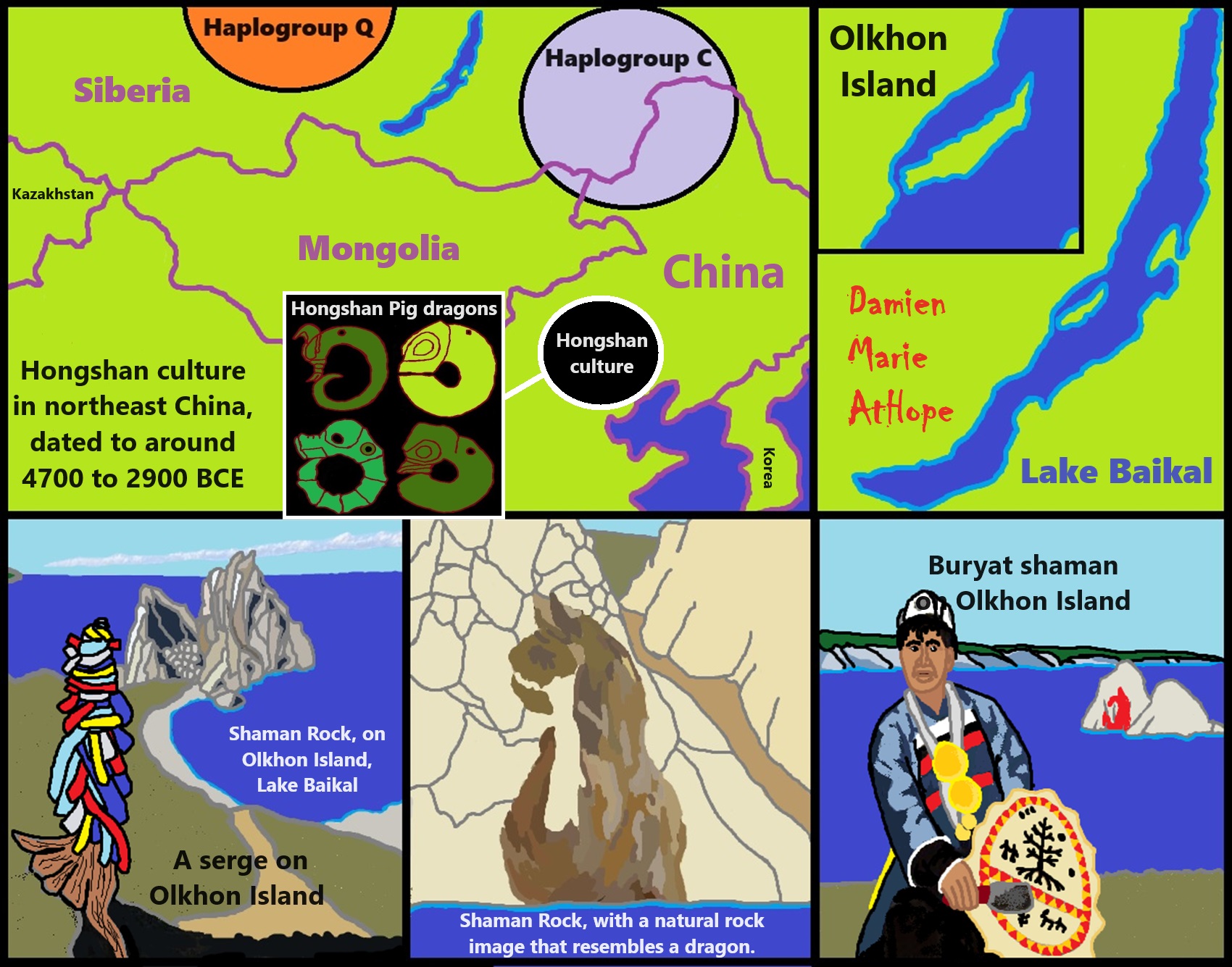
People may have first seen the Shaman Rock with the natural brown rock formation resembling a dragon between 30,000 to 25,000 years ago.
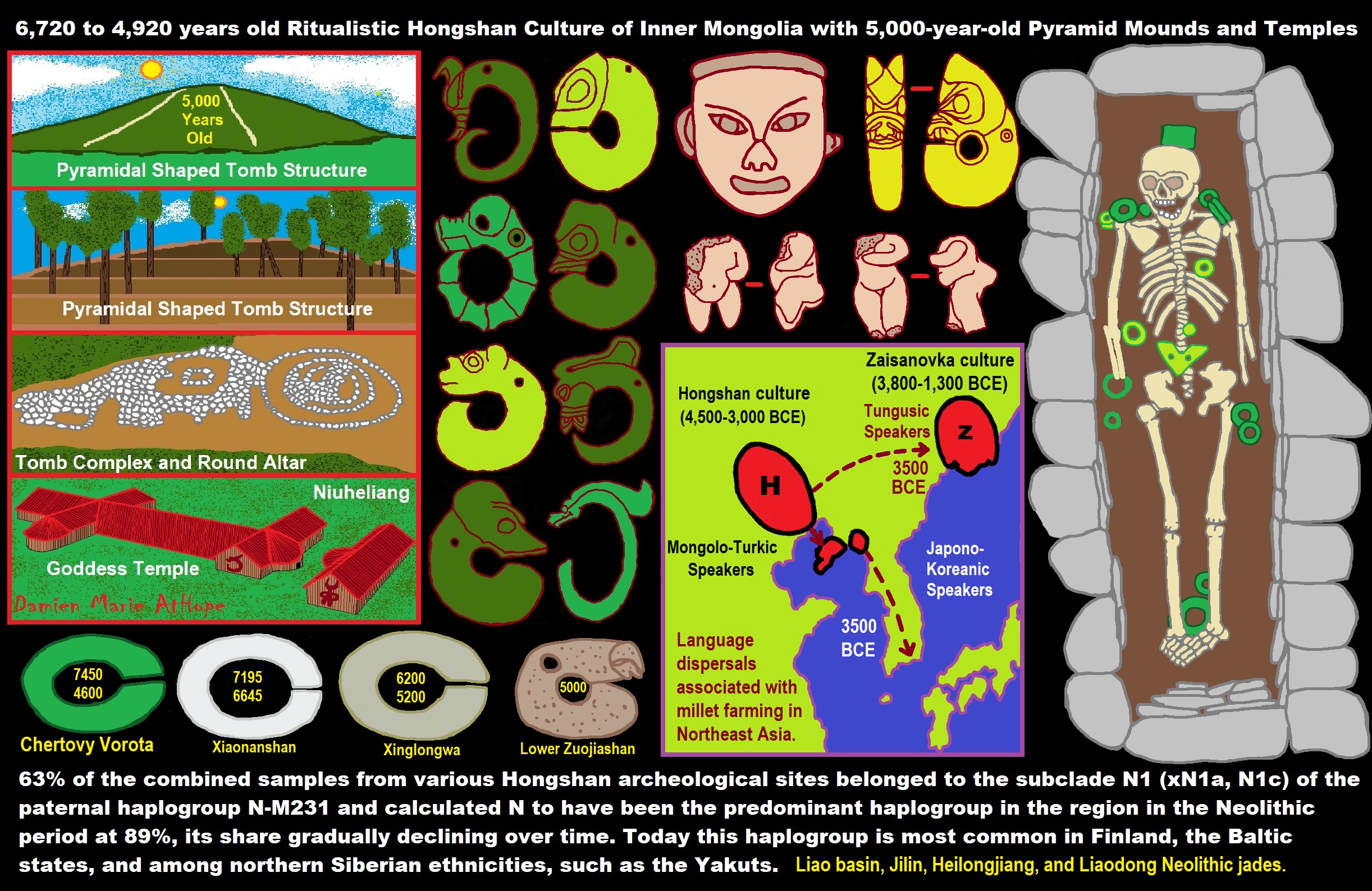
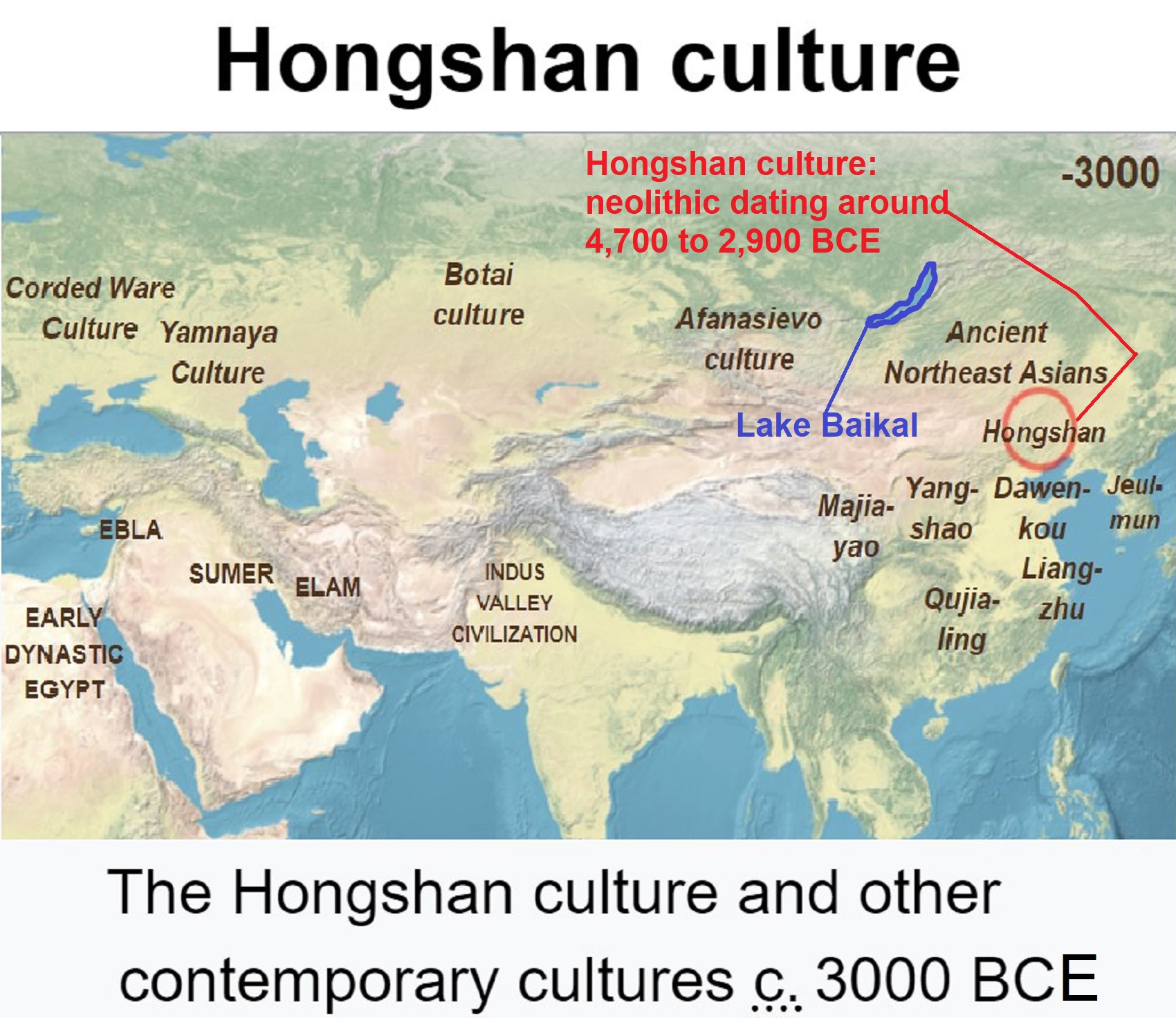
“Similarly to the Yangshao culture, the Hongshan culture cultivated millet. Isotope analyses revealed that millet contributed up to 70% of the human diet in the Early Hongshan and up to 80% in the Late Hongshan. The Hongshan culture is known for its carved jade. Hongshan burial artifacts include some of the earliest known examples of jade working. The Hongshan culture is known for its jade pig dragons and embryo dragons. Clay figurines, including figurines of pregnant women, are also found throughout Hongshan sites. Small copper rings were also excavated. The archaeological site at Niuheliang is a unique ritual complex associated with the Hongshan culture.” ref
“Excavators have discovered an underground temple complex—which included an altar—and also cairns in Niuheliang. The temple was constructed of stone platforms, with painted walls. Archaeologists have given it the name “Goddess Temple” (Chinese: 女神庙; pinyin: nüshenmiao) due to the discovery of a clay female head with jade inlaid eyes. It was an underground structure, 1m deep. Included on its walls are mural paintings. Housed inside the Goddess Temple are clay figurines as large as three times the size of real-life humans. The exceedingly large figurines are possibly deities, but for a religion not reflective in any other Chinese culture.” ref
“The existence of complex trading networks and monumental architecture (such as pyramids and the Goddess Temple) point to the existence of a “chiefdom“ in these prehistoric communities. Painted pottery was also discovered within the temple. Over 60 nearby tombs have been unearthed, all constructed of stone and covered by stone mounds, frequently including jade artifacts. Cairns were discovered atop two nearby two hills, with either round or square-stepped tombs, made of piled limestone. Entombed inside were sculptures of dragons and tortoises. It has been suggested that religious sacrifice might have been performed within the Hongshan culture.” ref
“Just as suggested by evidence found at early Yangshao culture sites, Hongshan culture sites also provide the earliest evidence for feng shui. The presence of both round and square shapes at Hongshan culture ceremonial centres suggests an early presence of the gaitian cosmography (“round heaven, square earth”). Early feng shui relied on astronomy to find correlations between humans and the universe. Archaeological evidence discovered at the Miaozigou site in Ulanqab, Inner Mongolia, a northern branch of the Yangshao culture from the Yellow River (the Yangshao culture is speculated to be the origin of the Sino-Tibetan languages) demonstrates similarities in the material cultures between the Yellow River and Liao River cultures. Three individuals from the Miaozigou site belonged to haplogroup N1(xN1a, N1c), while the main lineage of Yellow River valley cultures is O3-M122. The existence of N1(xN1a, N1c) among the Miaozigou individuals could serve as evidence for the migration of some of the Hongshan people.” ref
“Some Chinese archaeologists such as Guo Da-shun see the Hongshan culture as an important stage of early Chinese civilization. Whatever the linguistic affinity of the ancient denizens, Hongshan culture is believed to have exerted an influence on the development of early Chinese civilization. The culture may have also contributed to the development of settlements in ancient Korea. However, the Hongshan culture is also commonly employed in Korean pseudohistory by some Korean scholars, who seek to contest any connections between the Hongshan culture with Chinese civilization and assert that the Hongshan culture is only related to Korean civilization.” ref
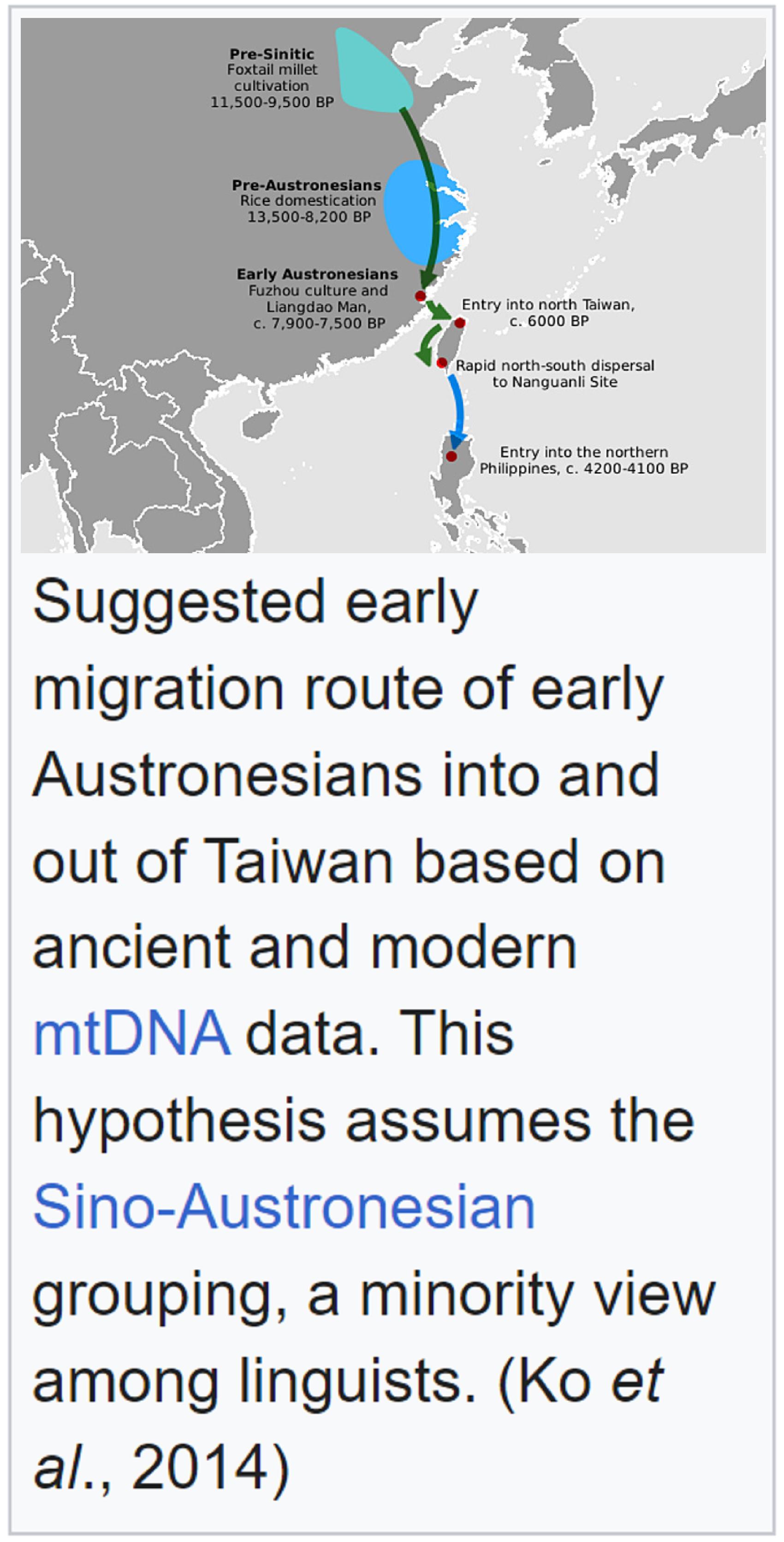
“Suggested early migration route of early Austronesians into and out of Taiwan based on ancient and modern mtDNA data. This hypothesis assumes the Sino-Austronesian grouping, a minority view among linguists. (Ko et al., 2014)” https://en.wikipedia.org/wiki/Austronesian_peoples
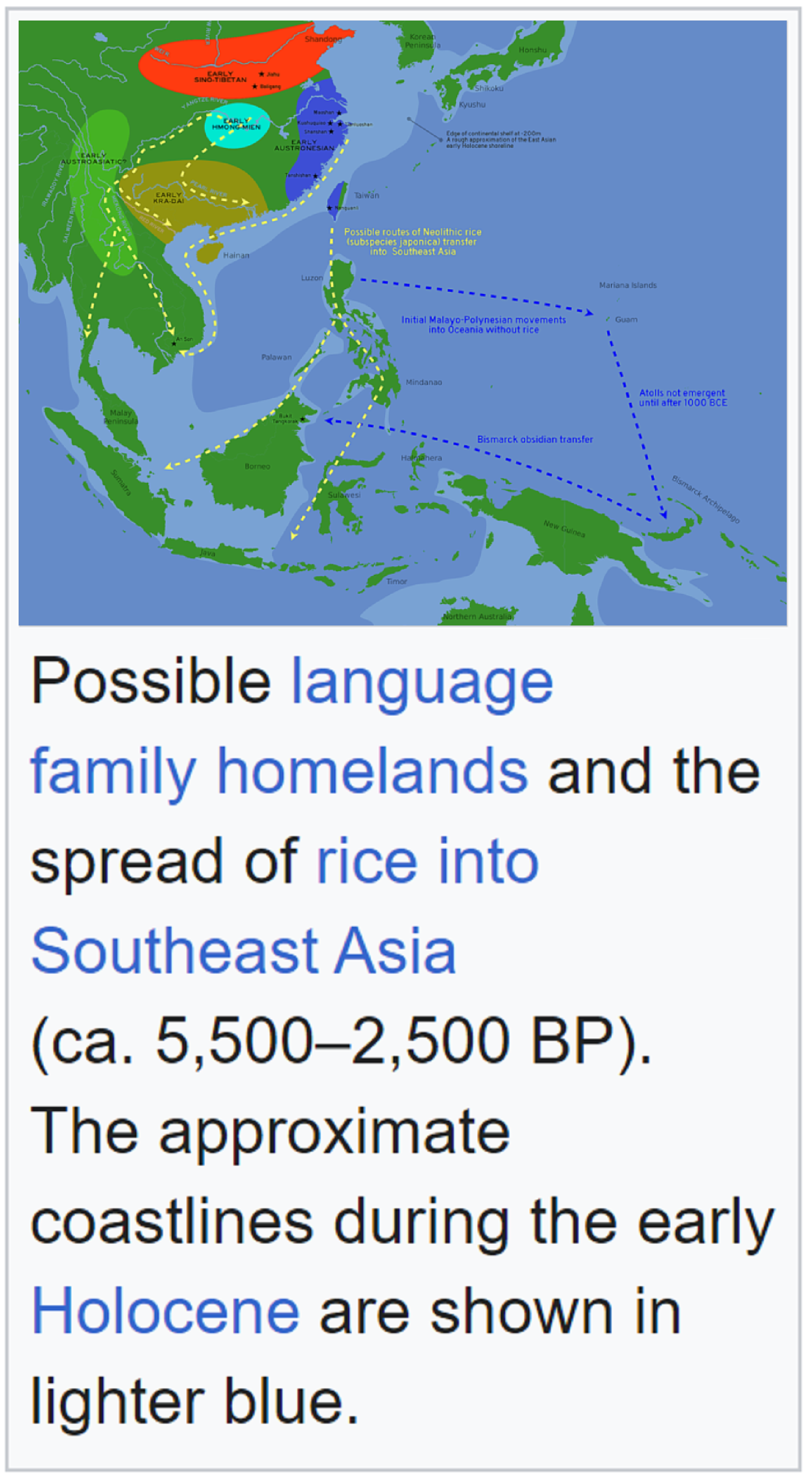
“Possible language family homelands and the spread of rice into Southeast Asia (5,500–2,500 years ago). The approximate coastlines during the early Holocene are shown in lighter blue.” https://en.wikipedia.org/wiki/Austronesian_peoples
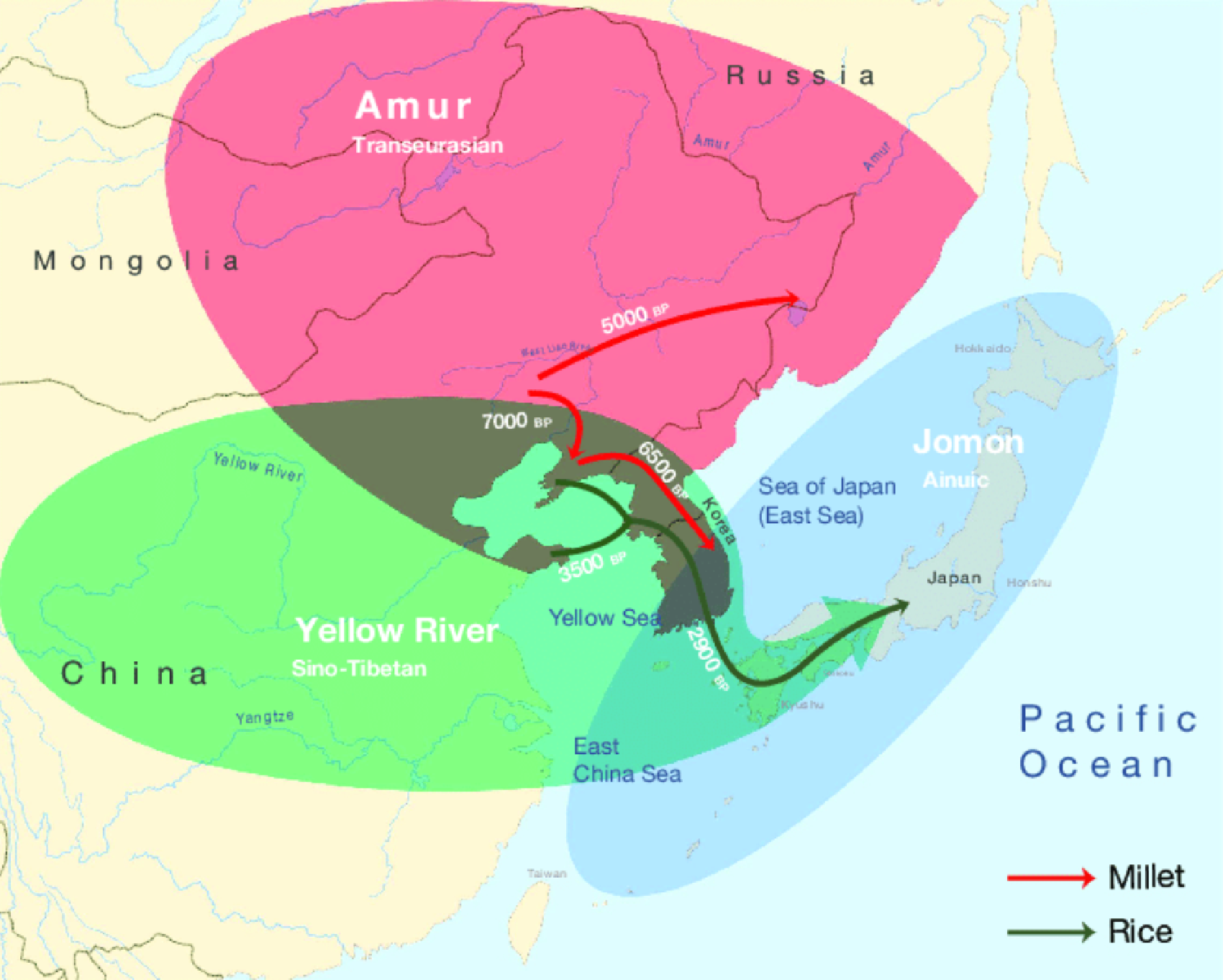
“The red arrows migrations of millet in the Neolithic, bringing Koreanic and Tungusic languages to the indicated regions. The green arrows mark the integration of rice in the Late Neolithic and Bronze Age, bringing the Japonic language over Korea to Japan.” https://www.researchgate.net/figure/Integration-of-linguistic-agricultural-and-genetic-expansions-in-Northeast-Asia-Amur_fig15_356186326
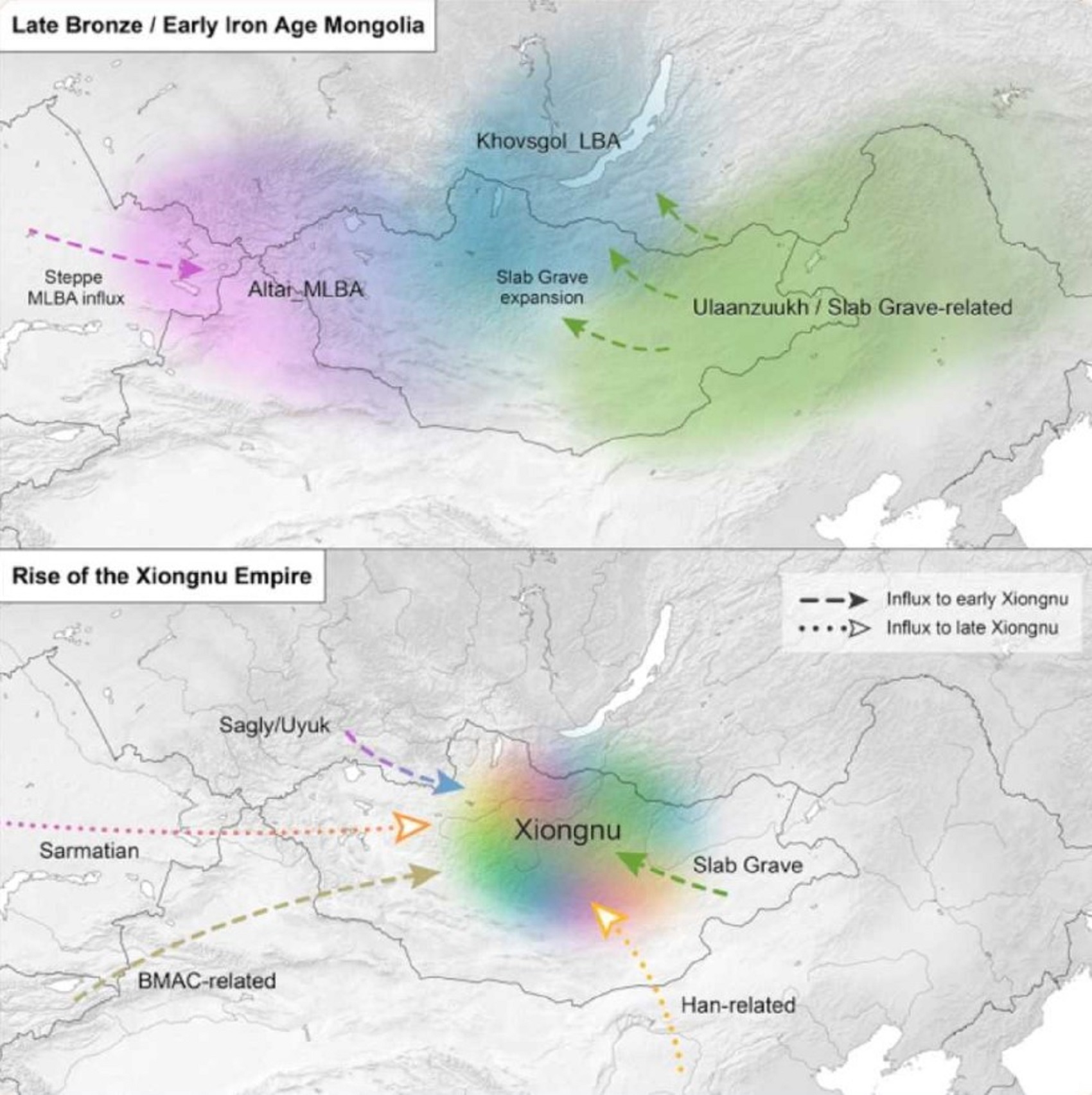

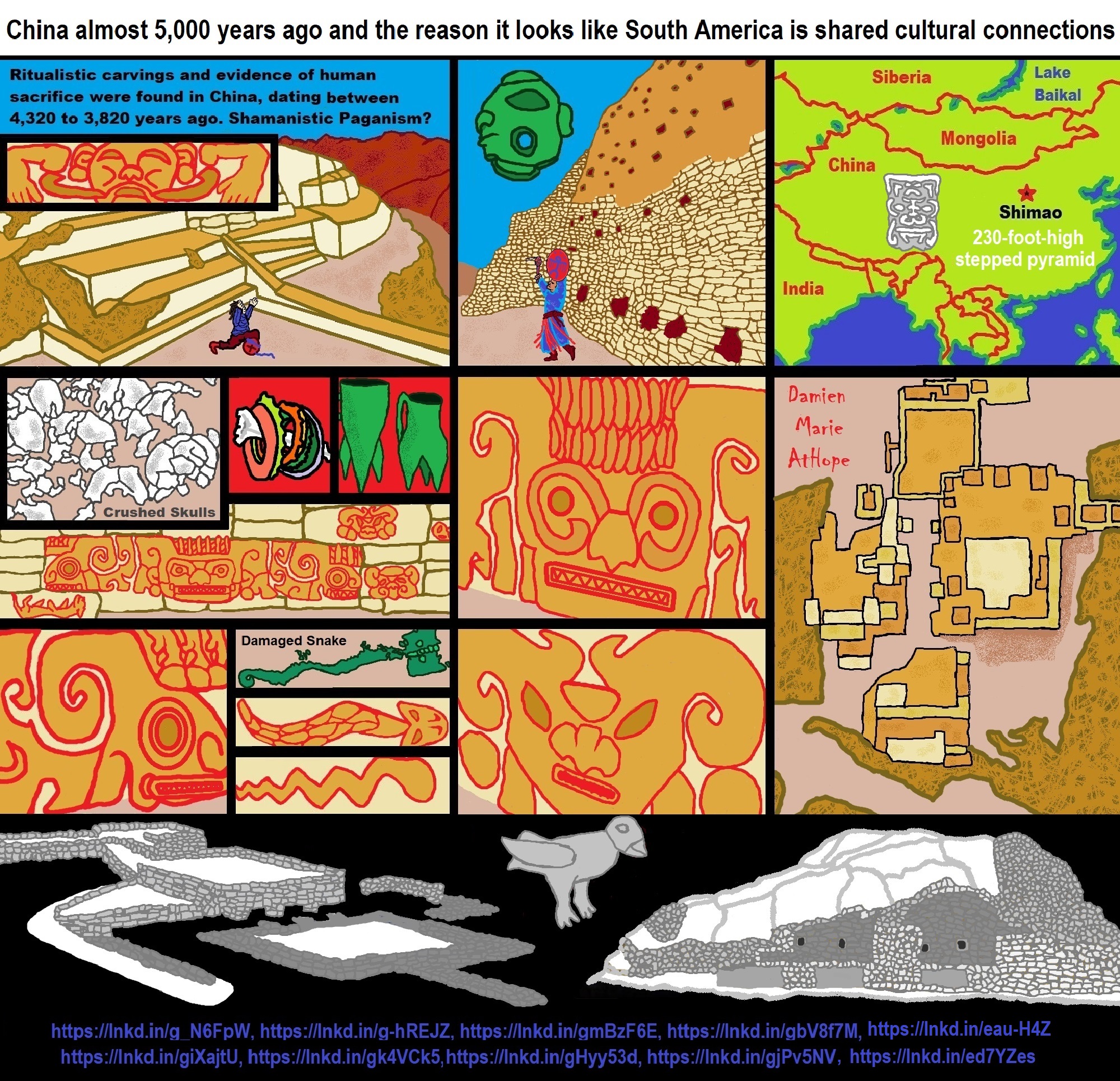
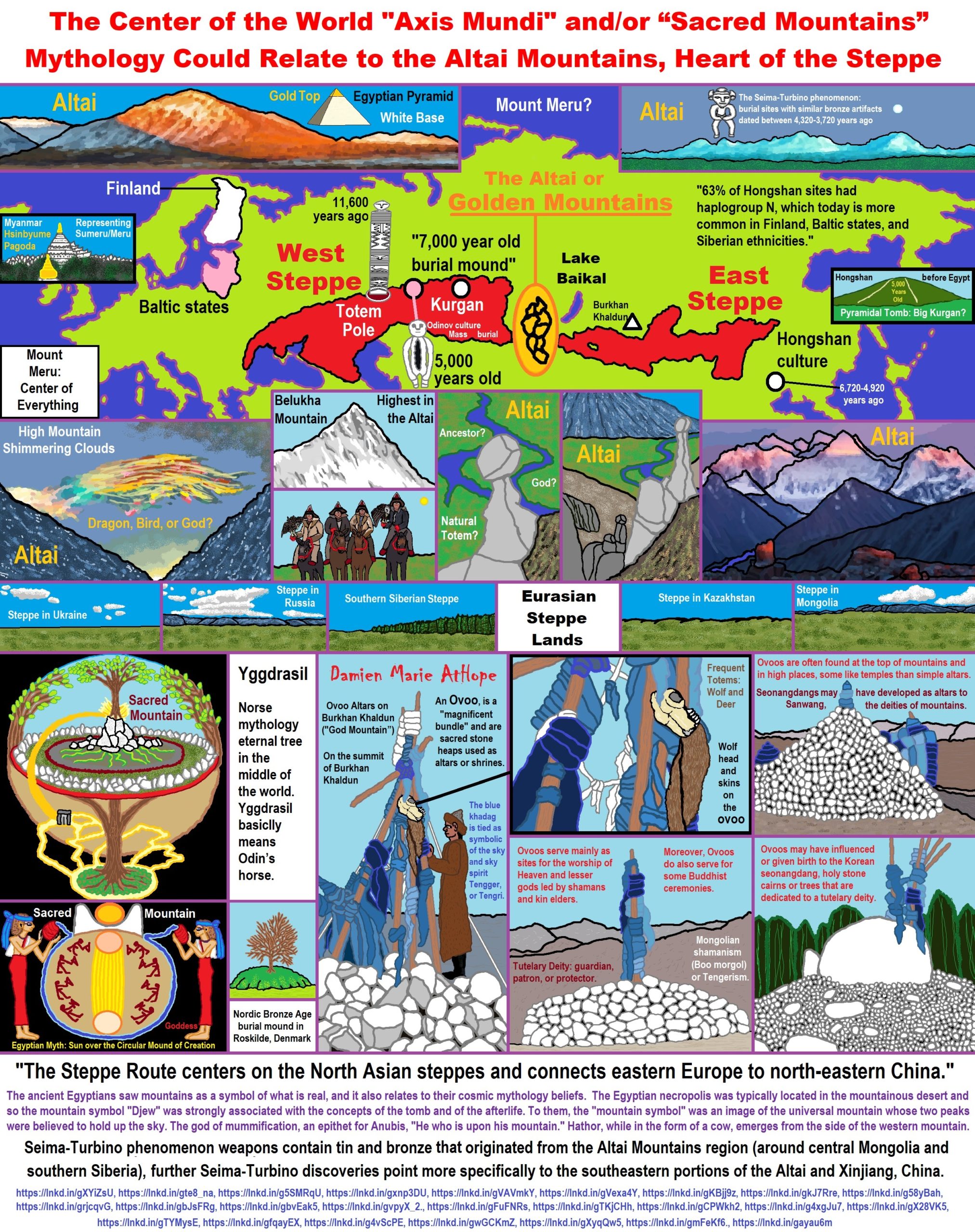
Axis Mundi
“In astronomy, axis mundi is the Latin term for the axis of Earth between the celestial poles. In a geocentric coordinate system, this is the axis of rotation of the celestial sphere. Consequently, in ancient Greco-Roman astronomy, the axis mundi is the axis of rotation of the planetary spheres within the classical geocentric model of the cosmos. In 20th-century comparative mythology, the term axis mundi – also called the cosmic axis, world axis, world pillar, center of the world, or world tree – has been greatly extended to refer to any mythological concept representing “the connection between Heaven and Earth” or the “higher and lower realms”. Mircea Eliade introduced the concept in the 1950s. Axis mundi closely relates to the mythological concept of the omphalos (navel) of the world or cosmos. Items adduced as examples of the axis mundi by comparative mythologists include plants (notably a tree but also other types of plants such as a vine or stalk), a mountain, a column of smoke or fire, or a product of human manufacture (such as a staff, a tower, a ladder, a staircase, a maypole, a cross, a steeple, a rope, a totem pole, a pillar, a spire). Its proximity to heaven may carry implications that are chiefly religious (pagoda, temple mount, minaret, church) or secular (obelisk, lighthouse, rocket, skyscraper). The image appears in religious and secular contexts. The axis mundi symbol may be found in cultures utilizing shamanic practices or animist belief systems, in major world religions, and in technologically advanced “urban centers”. In Mircea Eliade‘s opinion: “Every Microcosm, every inhabited region, has a Centre; that is to say, a place that is sacred above all.” ref
“There are multiple interpretations about the origin of the concept of the axis mundi. One psychological and sociological interpretation suggests that the symbol originates in a natural and universal psychological perception – i.e., that the particular spot that one occupies stands at “the center of the world”. This space serves as a microcosm of order because it is known and settled. Outside the boundaries of the microcosm lie foreign realms that – because they are unfamiliar or not ordered – represent chaos, death, or night. From the center, one may still venture in any of the four cardinal directions, make discoveries, and establish new centers as new realms become known and settled. The name of China — meaning “Middle Nation” (中国 pinyin: Zhōngguó) – is often interpreted as an expression of an ancient perception that the Chinese polity (or group of polities) occupied the center of the world, with other lands lying in various directions relative to it.” ref
“A second interpretation suggests that ancient symbols such as the axis mundi lie in a particular philosophical or metaphysical representation of a common and culturally shared philosophical concept, which is that of a natural reflection of the macrocosm (or existence at grand scale) in the microcosm (which consists of either an individual, community, or local environment that shares the same principles and structures as the macrocosm). In this metaphysical representation of the universe, mankind is placed into an existence that serves as a microcosm of the universe or the entire cosmic existence, and who – in order to achieve higher states of existence or liberation into the macrocosm – must gain necessary insights into universal principles that can be represented by his life or environment in the microcosm.” ref
“In many religious and philosophical traditions around the world, mankind is seen as a sort of bridge between either: two worlds, the earthly and the heavenly (as in Hindu, and Taoist philosophical and theological systems); or three worlds, namely the earthly, heavenly, and the “sub-earthly” or “infra-earthly” (e.g., the underworld, as in the Ancient Greek, Incan, Mayan, and Ancient Egyptian religious systems). Spanning these philosophical systems is the belief that man traverses a sort of axis, or path, which can lead from man’s current central position in the intermediate realms into heavenly or sub-earthly realms. Thus, in this view, symbolic representations of a vertical axis represent a path of “ascent” or “descent” into other spiritual or material realms, and often capture a philosophy that considers human life to be a quest in which one develops insights or perfections in order to move beyond this current microcosmic realm and to engage with the grand macrocosmic order.” ref
“In other interpretations, an axis mundi is more broadly defined as a place of connection between heavenly and the earthly realms – often a mountain or other elevated site. Tall mountains are often regarded as sacred and some have shrines erected at the summit or base. Mount Kunlun fills a similar role in China. Mount Kailash is holy to Hinduism and several religions in Tibet. The Pitjantjatjara people in central Australia consider Uluru to be central to both their world and culture. The Teide volcano was for the Canarian aborigines (Guanches) a kind of axis mundi. In ancient Mesopotamia, the cultures of ancient Sumer and Babylon built tall platforms, or ziggurats, to elevate temples on the flat river plain. Hindu temples in India are often situated on high mountains – e.g., Amarnath, Tirupati, Vaishno Devi, etc. The pre-Columbian residents of Teotihuacán in Mexico erected huge pyramids, featuring staircases leading to heaven.” ref
“These Amerindian temples were often placed on top of caves or subterranean springs, which were thought to be openings to the underworld. Jacob’s Ladder is an axis mundi image, as is the Temple Mount. For Christians, the Cross on Mount Calvary expresses this symbol. The Middle Kingdom, China, had a central mountain, Kunlun, known in Taoist literature as “the mountain at the middle of the world”. To “go into the mountains” meant to dedicate oneself to a spiritual life. As the abstract concept of axis mundi is present in many cultural traditions and religious beliefs, it can be thought to exist in any number of locales at once. Mount Hermon was regarded as the axis mundi in Canaanite tradition, from where the sons of God are introduced descending in 1 Enoch. The ancient Armenians had a number of holy sites, the most important of which was Mount Ararat, which was thought to be the home of the gods as well as the center of the universe.” ref
“Likewise, the ancient Greeks regarded several sites as places of Earth’s omphalos (navel) stone, notably the oracle at Delphi, while still maintaining a belief in a cosmic world tree and in Mount Olympus as the abode of the gods. Judaism has the Temple Mount; Christianity has the Mount of Olives and Calvary; and Islam has the Ka’aba (said to be the first building on Earth), as well as the Temple Mount (Dome of the Rock). In Hinduism, Mount Kailash is identified with the mythical Mount Meru and regarded as the home of Shiva; in Vajrayana Buddhism, Mount Kailash is recognized as the most sacred place where all the dragon currents converge and is regarded as the gateway to Shambhala. In Shinto, the Ise Shrine is the omphalos.” ref
“Sacred places can constitute world centers (omphaloi), with an altar or place of prayer as the axis. Altars, incense sticks, candles, and torches form the axis by sending a column of smoke, and prayer, toward heaven. It has been suggested by Romanian religious historian Mircea Eliade that the architecture of sacred places often reflects this role: “Every temple or palace – and by extension, every sacred city or royal residence – is a Sacred Mountain, thus becoming a Centre.” Pagoda structures in Asian temples take the form of a stairway linking earth and heaven. A steeple in a church or a minaret in a mosque also serves as connections of earth and heaven. Structures such as the maypole, derived from the Saxons‘ Irminsul, and the totem pole among indigenous peoples of the Americas also represent world axes. The calumet, or sacred pipe, represents a column of smoke (the soul) rising from a world center. A mandala creates a world center within the boundaries of its two-dimensional space analogous to that created in three-dimensional space by a shrine. In the classical elements and the Vedic Pancha Bhoota, the axis mundi corresponds to Aether, the quintessence.” ref
“Plants often serve as images of the axis mundi. The image of the Cosmic Tree provides an axis symbol that unites three planes: sky (branches), earth (trunk), and underworld (roots). In some Pacific Island cultures, the banyan tree – of which the Bodhi tree is of the Sacred Fig variety – is the abode of ancestor spirits. In Hindu religion, the banyan tree is considered sacred and is called ashwath vriksha (“Of all trees I am the banyan tree” – Bhagavad Gita). It represents eternal life because of its seemingly ever-expanding branches. The Bodhi tree is also the name given to the tree under which Gautama Siddhartha, the historical Buddha, sat on the night he attained enlightenment. The Mesoamerican world tree connects the planes of the underworld and the sky with that of the terrestrial realm.” ref
“The Yggdrasil, or World Ash, functions in much the same way in Norse mythology; it is the site where Odin found enlightenment. Other examples include Jievaras in Lithuanian mythology and Thor’s Oak in the myths of the pre-Christian Germanic peoples. The Tree of Life and the Tree of Knowledge of Good and Evil in Genesis present two aspects of the same image. Each is said to stand at the center of the paradise garden from which four rivers flow to nourish the whole world. Each tree confers a boon. Bamboo, the plant from which Asian calligraphy pens are made, represents knowledge and is regularly found on Asian college campuses. The Christmas tree, which can be traced in its origins back to pre-Christian European beliefs, represents an axis mundi.” ref
“The human body can express the symbol of the world axis. Some of the more abstract Tree of Life representations, such as the sefirot in Kabbalism and the chakra system recognized by Hinduism and Buddhism, merge with the concept of the human body as a pillar between heaven and earth. Disciplines such as yoga and tai chi begin from the premise of the human body as axis mundi. The Buddha represents a world center in human form. Large statues of a meditating figure unite the human form with the symbolism of the temple and tower. Astrology in all its forms assumes a connection between human health and affairs and celestial-body orientation. World religions regard the body itself as a temple and prayer as a column uniting earth and heaven. The ancient Colossus of Rhodes combined the role of the human figure with those of portal and skyscraper. The Renaissance image known as the Vitruvian Man represented a symbolic and mathematical exploration of the human form as world axis.” ref
“Secular structures can also function as axes mundi. In Navajo culture, the hogan acts as a symbolic cosmic center. In some Asian cultures, houses were traditionally laid out in the form of a square oriented toward the four compass directions. A traditional home was oriented toward the sky through feng shui, a system of geomancy, just as a palace would be. Traditional Arab houses are also laid out as a square surrounding a central fountain that evokes a primordial garden paradise. Mircea Eliade noted that “the symbolism of the pillar in [European] peasant houses likewise derives from the ‘symbolic field’ of the axis mundi. In many archaic dwellings the central pillar does in fact serve as a means of communication with the heavens, with the sky.” The nomadic peoples of Mongolia and the Americas more often lived in circular structures. The central pole of the tent still operated as an axis, but a fixed reference to the four compass points was avoided.” ref
“A common shamanic concept, and a universally told story, is that of the healer traversing the axis mundi to bring back knowledge from the other world. It may be seen in the stories from Odin and the World Ash Tree to the Garden of Eden and Jacob’s Ladder to Jack and the Beanstalk and Rapunzel. It is the essence of the journey described in The Divine Comedy by Dante Alighieri. The epic poem relates its hero’s descent and ascent through a series of spiral structures that take him through the core of the earth, from the depths of hell to celestial paradise. It is also a central tenet in the Southeastern Ceremonial Complex. Anyone or anything suspended on the axis between heaven and earth becomes a repository of potential knowledge. A special status accrues to the thing suspended: a serpent, a rod, a fruit, mistletoe. Derivations of this idea find form in the Rod of Asclepius, an emblem of the medical profession, and in the caduceus, an emblem of correspondence and commercial professions. The staff in these emblems represents the axis mundi, while the serpents act as guardians of, or guides to, knowledge.” ref
Show 4 “Late Neolithic and Bronze Age” China: Ritual, Religion, Elites, Language, and Empires
Use time 10:50 to 35:54 https://www.youtube.com/watch?v=lz4EQ0iYDI4&t=413s
|
3400–2250 |
良渚文化 |
||
|
3100–2700 |
馬家窯文化 |
upper Yellow River region in Gansu and Qinghai |
|
|
3100–2700 |
屈家嶺文化 |
||
|
3000–2000 |
龍山文化 |
central and lower Yellow River |
|
|
2800–2000 |
寶墩文化 |
||
|
2500–2000 |
石家河文化 |
||
|
1900–1500 |
岳石文化 |
lower Yellow River region in Shandong |
https://en.wikipedia.org/wiki/List_of_Neolithic_cultures_of_China
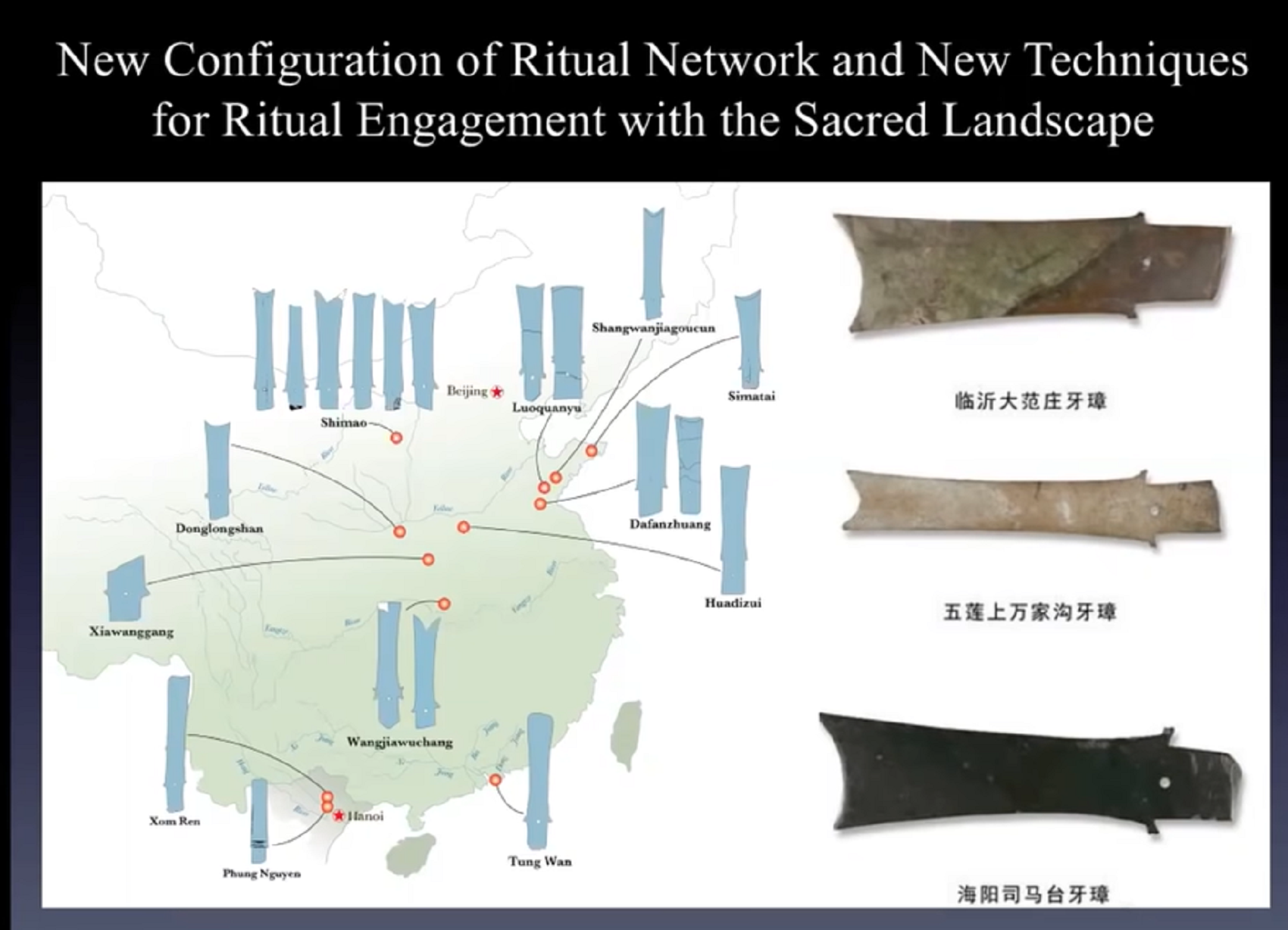
33:00 time on the video: The Rise of Early Chinese Civilization ~ Dr. Min Li https://www.youtube.com/watch?v=lz4EQ0iYDI4&t=413s
(Believed possible “sacred mountain” honoring rituals).
Afanasievo culture (early PIE: Proto-Indo-European)
“Archaeology traces the spread of artifacts, habitations, and burial sites presumed to be created by speakers of Proto-Indo-European in several stages: from the hypothesized locations of the Proto-Indo-European homeland, into their later locations of Western Europe, Central, South, and Eastern Asia.” https://en.wikipedia.org/wiki/Indo-European_migrations
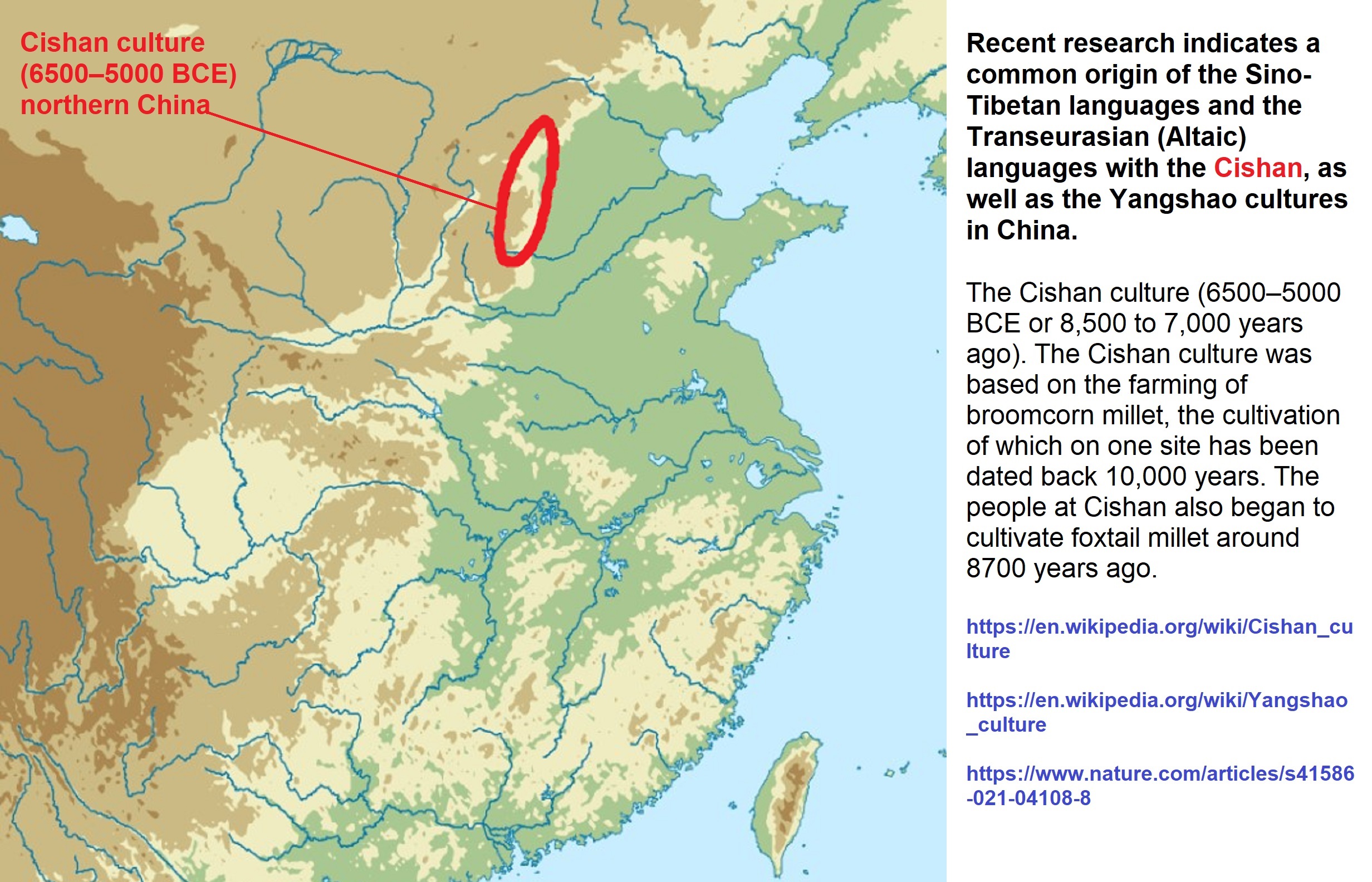
“By applying Bayesian methods to infer a dated phylogeny of the Transeurasian languages. The results indicate a time-depth of 9,181 years ago (5595–12793 95% highest probability density (95% HPD)) for the Proto-Transeurasian root of the family; 6,811 years ago (4404–10166 95% HPD) for Proto-Altaic, the unity of Turkic, Mongolic and Tungusic languages; 4,491 years ago (2599–6373 95% HPD) for Mongolo-Tungusic; and 5,458 years ago (3335–8024 95% HPD) for Japano-Koreanic. In contrast to previously proposed homelands, which range from the Altai to the Yellow River to the Greater Khingan Mountains to the Amur basin, we find support for a Transeurasian origin in the West Liao River region in the Early Neolithic. After a primary break-up of the family in the Neolithic, further dispersals took place in the Late Neolithic and Bronze Age. Although Neolithic Northeast Asia was characterized by widespread plant cultivation, cereal farming expanded from several centers of domestication, the most important of which for Transeurasian was the West Liao basin, where cultivation of broomcorn millet started around 9000 years ago.” ref
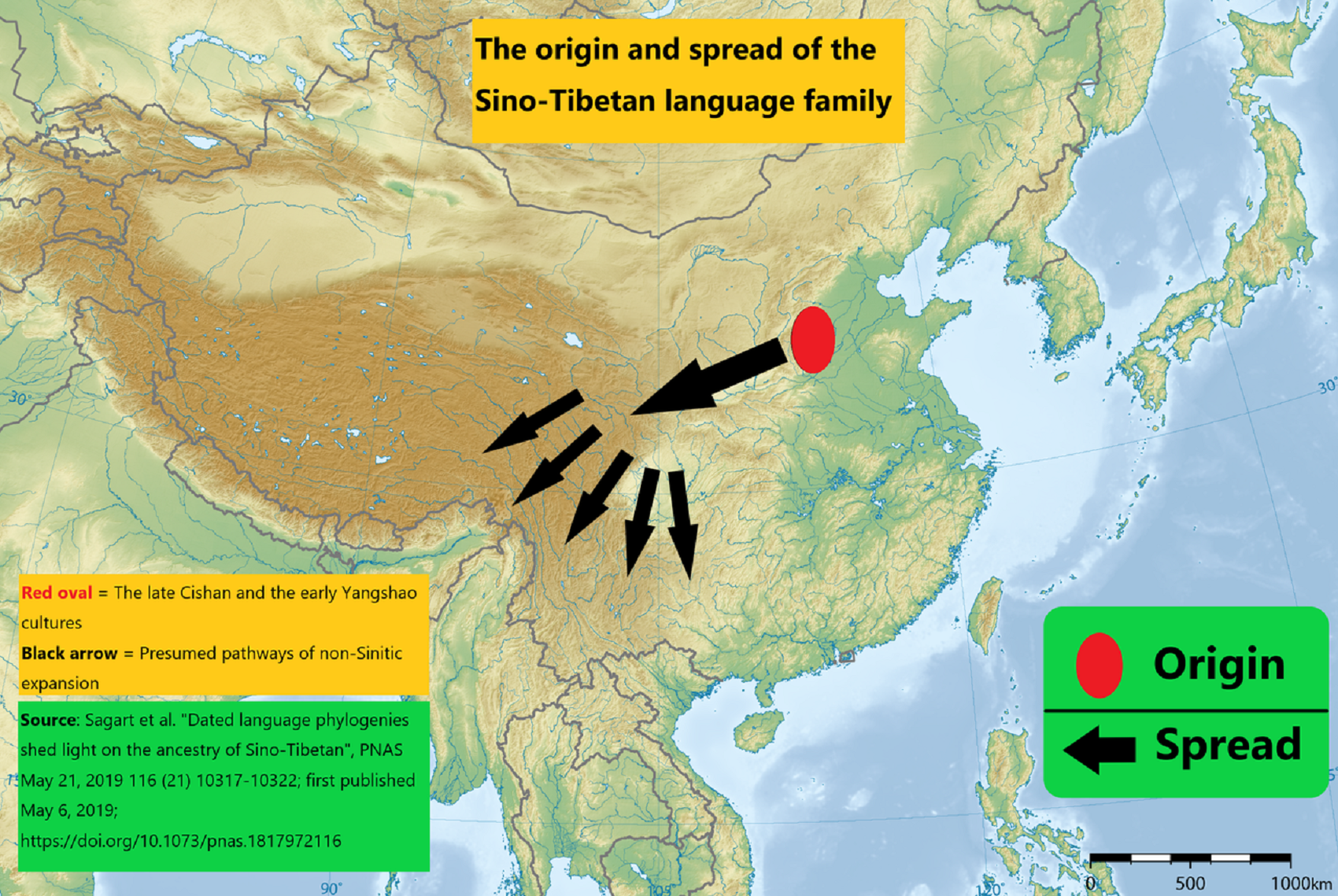
Cishan culture (6500–5000 BCE) and Yangshao culture (5000 to 3000 BCE)
“Red oval is the late Cishan and the early Yangshao cultures. After applying the linguistic comparative method to the database of comparative linguistic data developed by Laurent Sagart in 2019 to identify sound correspondences and establish cognates, phylogenetic methods are used to infer relationships among these languages and estimate the age of their origin and homeland.” ref
“The Cishan culture (6500–5000 BCE) was a Neolithic culture in northern China, on the eastern foothills of the Taihang Mountains. The Cishan culture was based on the farming of broomcorn millet, the cultivation of which on one site has been dated back 10,000 years. The people at Cishan also began to cultivate foxtail millet around 8700 years ago. However, these early dates have been questioned by some archaeologists due to sampling issues and lack of systematic surveying. Over 500 subterranean storage pits were discovered at Cishan. These pits were used to store millet. The largest pits were 5 meters deep and capable of storing up to 1,000 kg (2,205 lb) of millet. Common artifacts from the Cishan culture include stone grinders, stone sickles, and tripod pottery. The sickle blades feature fairly uniform serrations, which made the harvesting of grain easier. Cord markings, used as decorations on the pottery, was more common compared to neighboring cultures. Also, the Cishan potters created a broader variety of pottery forms such as basins, pot supports, serving stands, and drinking cups. Since the culture shared many similarities with its southern neighbor, the Peiligang culture, both cultures were sometimes previously referred to together as the Cishan-Peiligang culture or Peiligang-Cishan culture. The Cishan culture also shared several similarities with its eastern neighbor, the Beixin culture. However, the contemporary consensus among archaeologists is that the Cishan people were members of a distinct culture that shared many characteristics with its neighbors. This culture has been linked to the origin of the Sino-Tibetan language family.” ref
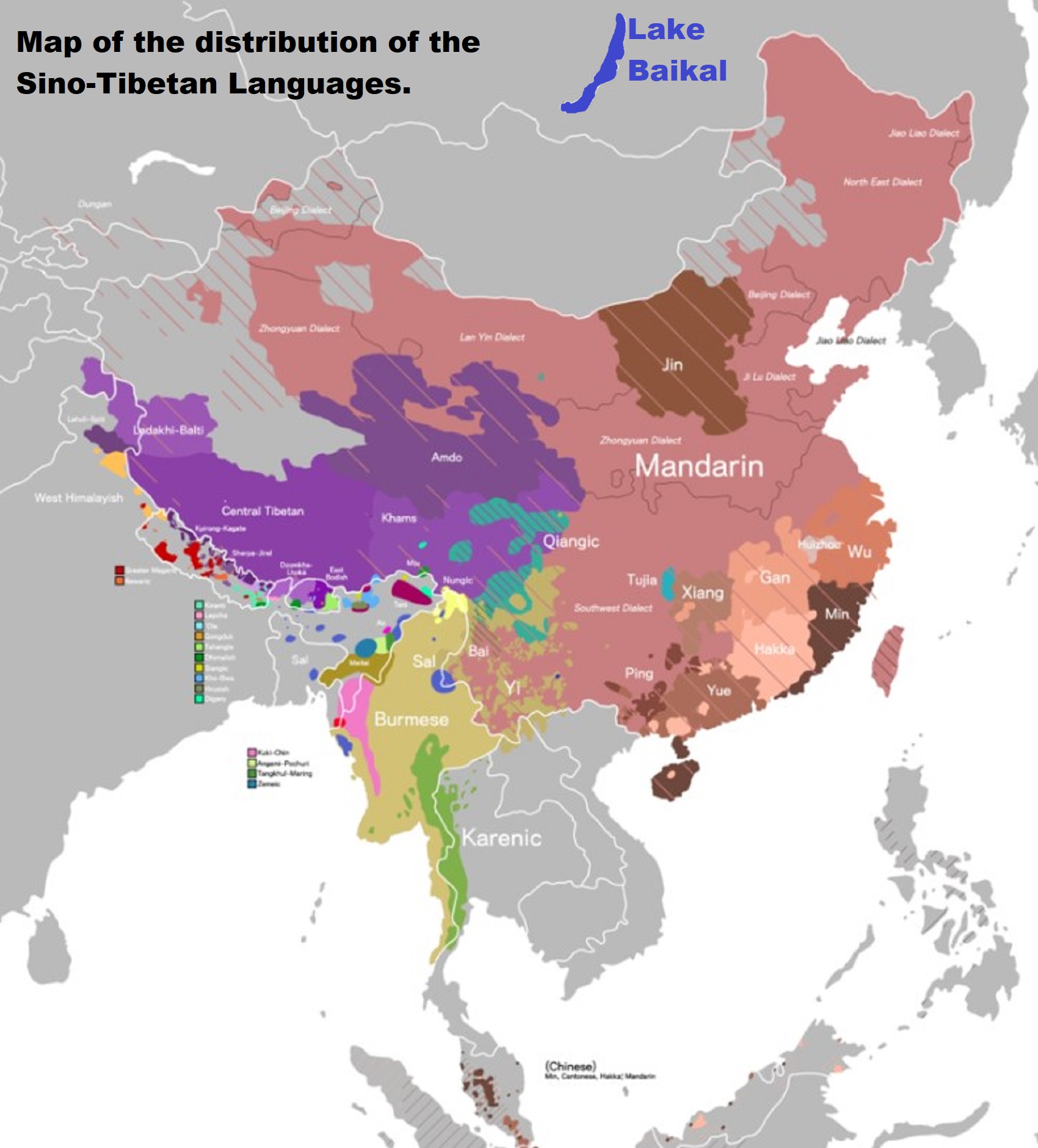
“Sino-Tibetan languages are a family of more than 400 languages, hypothesis associates the family with the Neolithic Yangshao culture (7000–5000 years ago) of the Yellow River basin, with an expansion driven by millet agriculture.”
https://en.wikipedia.org/wiki/Sino-Tibetan_languages
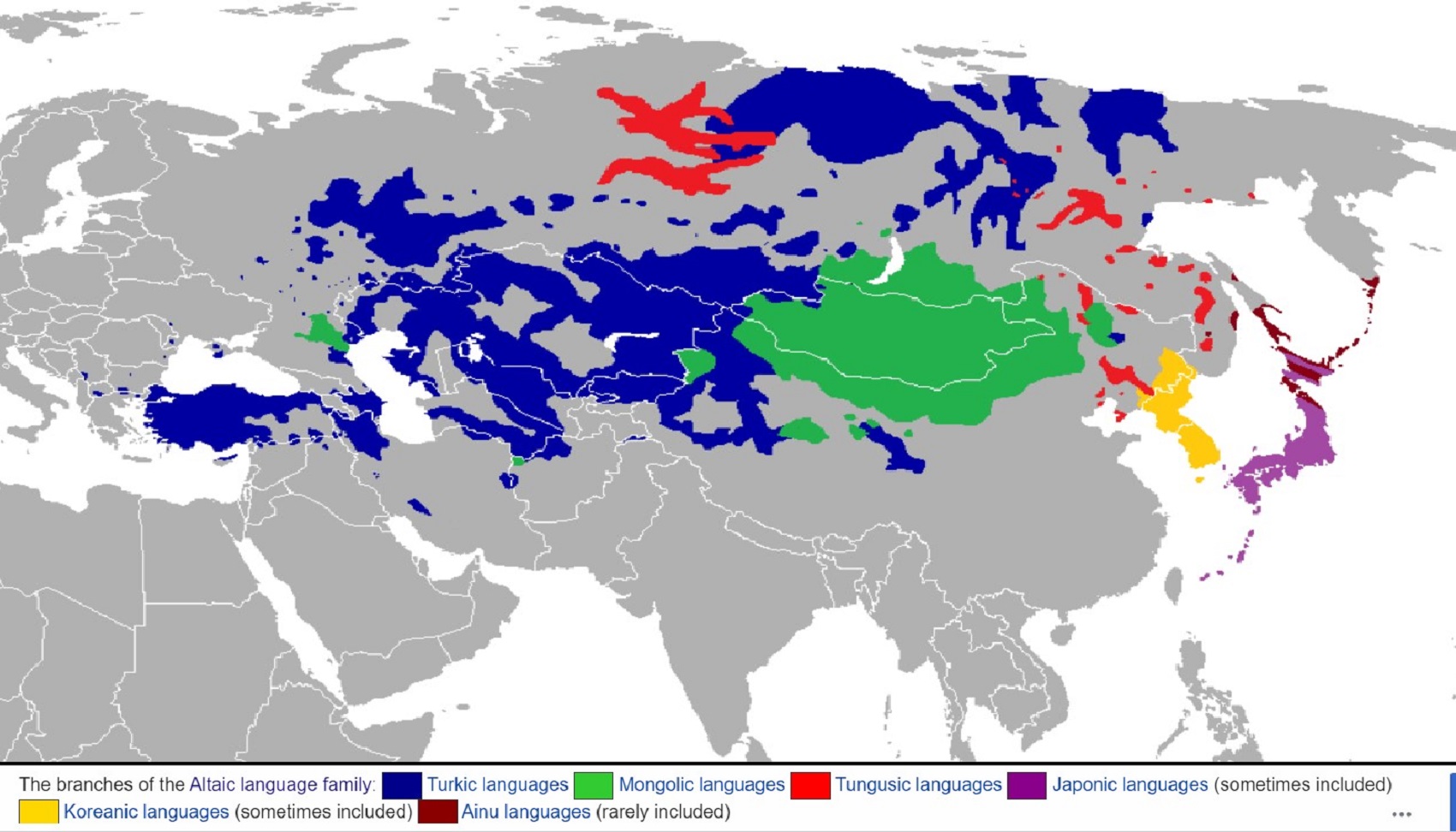
“Altaic (also called Transeurasian) is a proposed language family that would include the Turkic, Mongolic, and Tungusic language families and possibly also the Japonic and Koreanic languages. Speakers of these languages are currently scattered over most of Asia north of 35 °N and in some eastern parts of Europe, extending in longitude from Turkey to Japan. The group is named after the Altai mountain range in the center of Asia.” ref
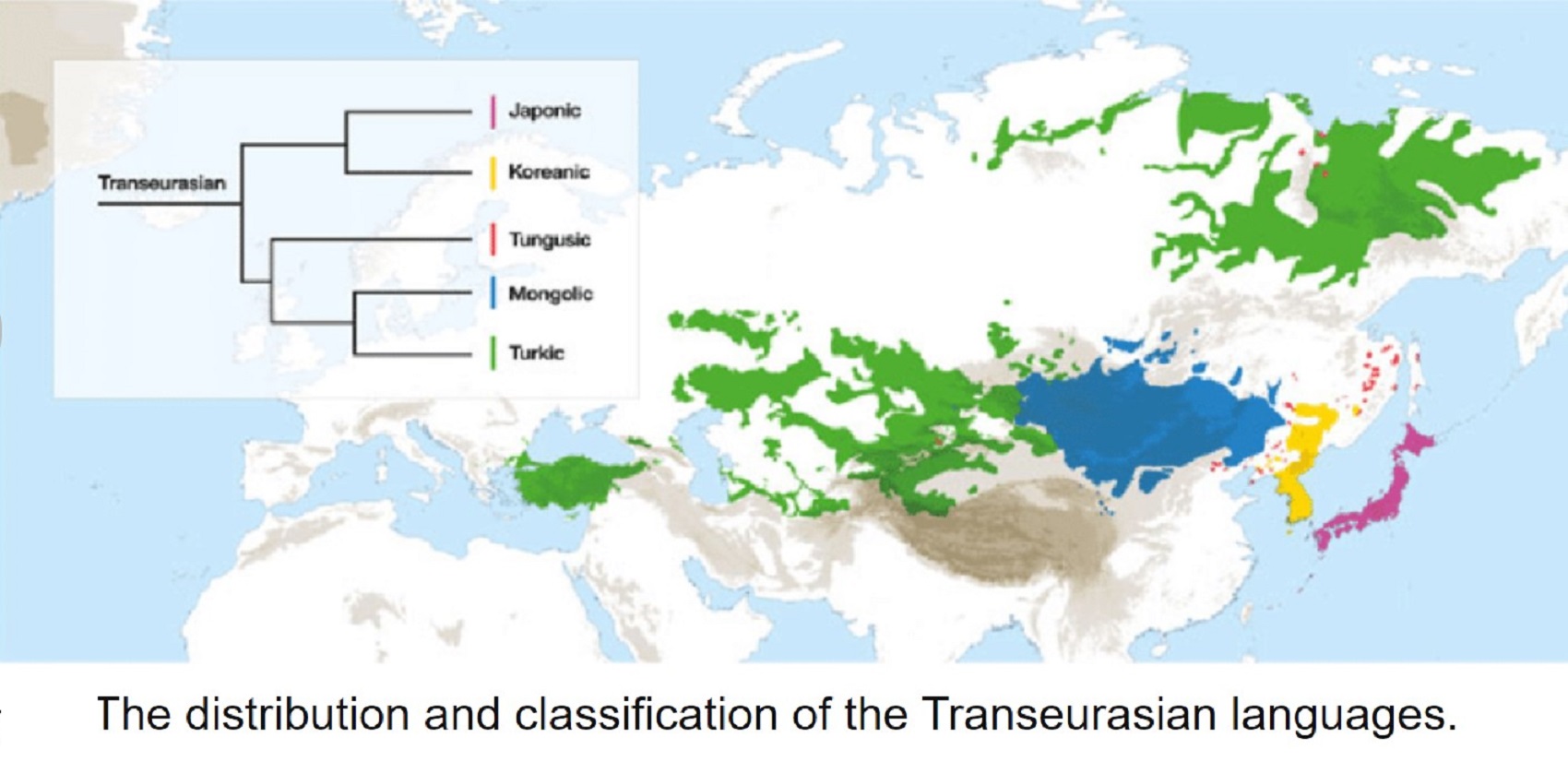
“Altaic (also called Transeurasian) is a proposed language family that would include the Turkic, Mongolic, and Tungusic language families and possibly also the Japonic and Koreanic languages. Speakers of these languages are currently scattered over most of Asia north of 35 °N and in some eastern parts of Europe, extending in longitude from Turkey to Japan. The group is named after the Altai mountain range in the center of Asia.” ref
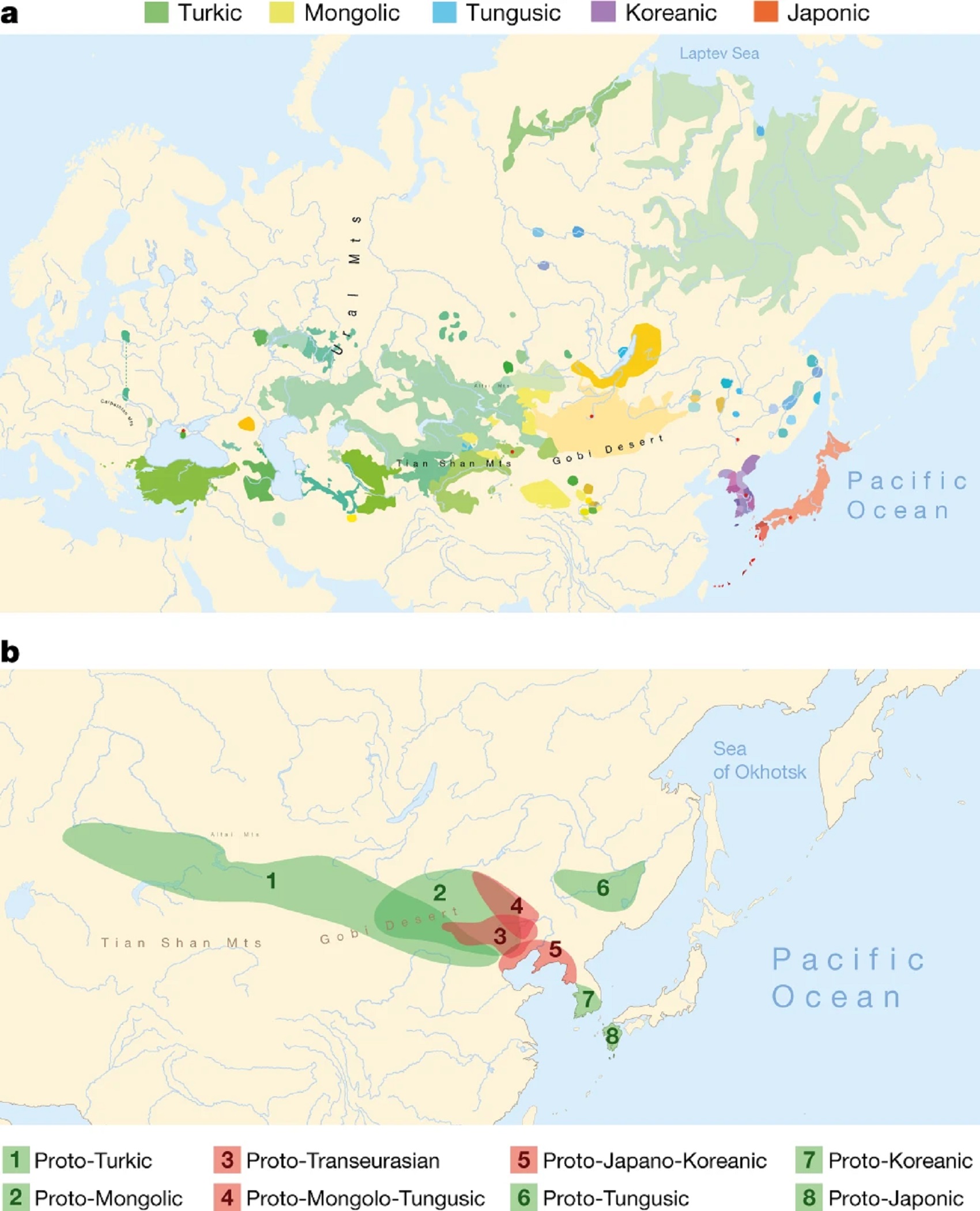
“Distribution of Transeurasian languages in the past and in the present. a, Geographical distribution of the 98 Transeurasian language varieties included in this study. Contemporary languages are represented by colored surfaces, and historical varieties by red dots. b, Reconstructed locations of Transeurasian ancestral languages spoken during the Neolithic (red) and the Bronze Age and later (green).” ref
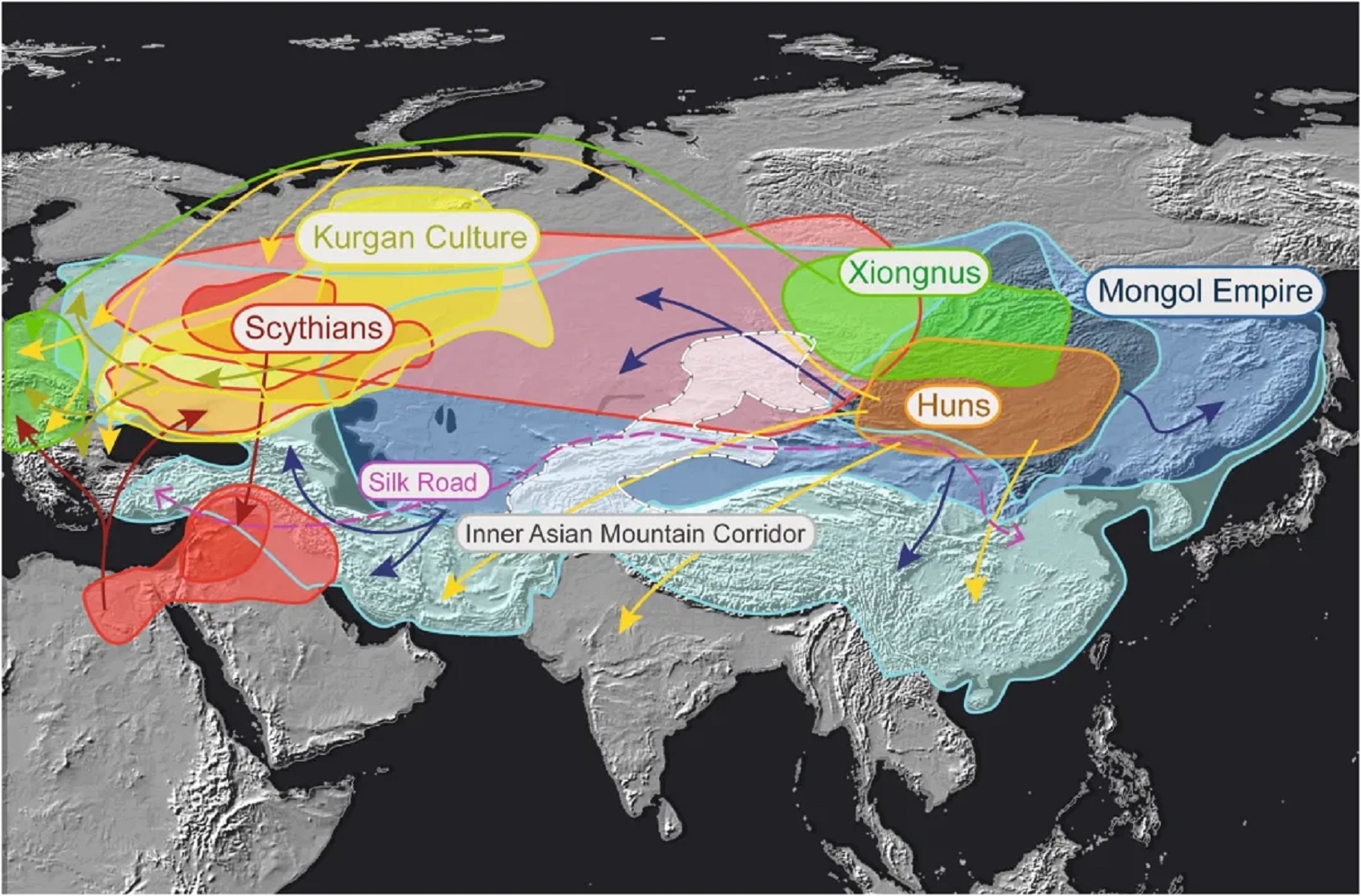
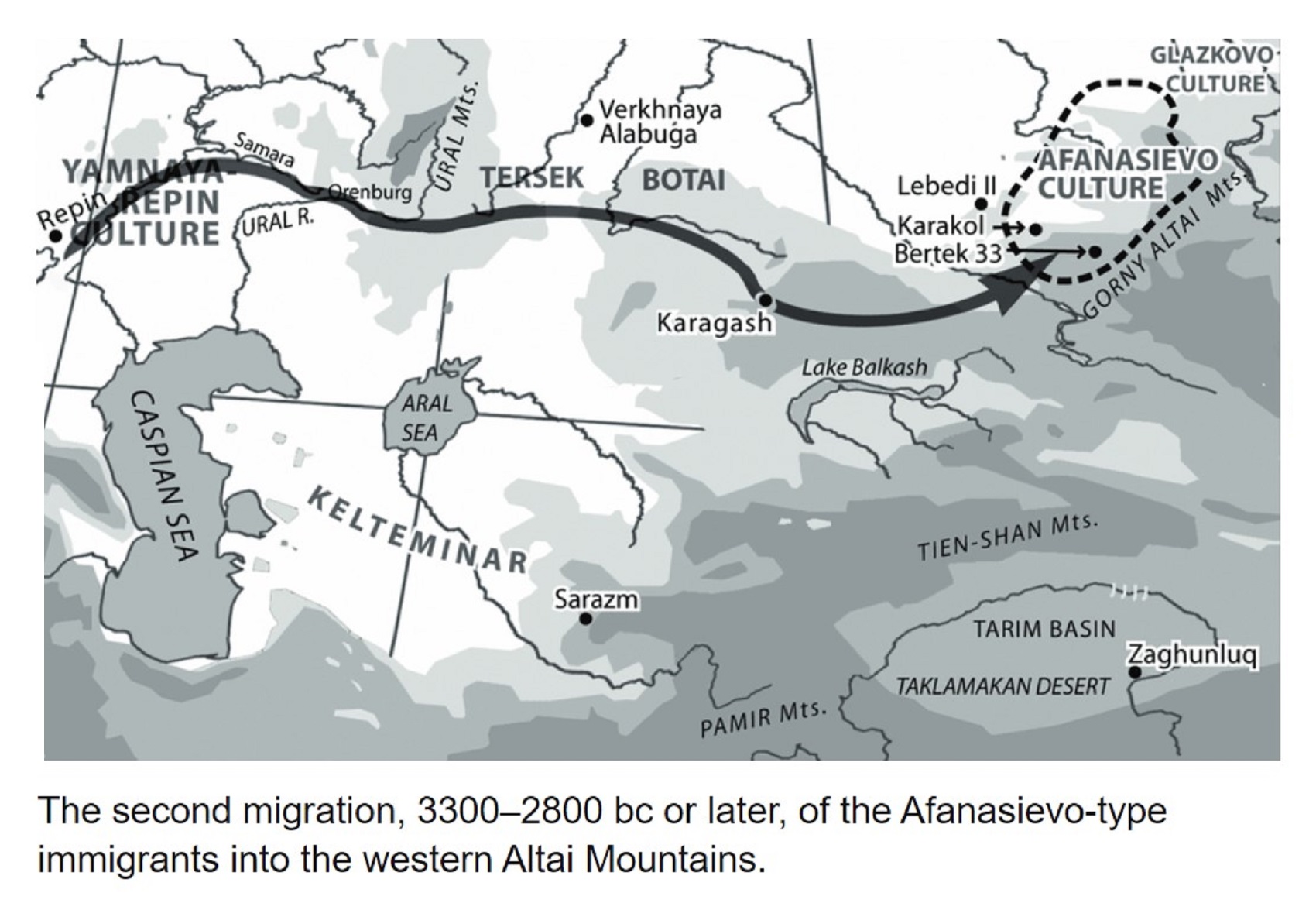

“The Afanasievo culture of south Siberia, occupying the Minusinsk Basin and the Altai Mountains during the Eneolithic era (also called the Chalcolithic or Copper Age), c. 3300 to 2500 BCE or around 5,300-4,500 years ago. Afanasevan population was descended from people who migrated c. 3700–3300 BCE across the Eurasian Steppe from the pre-Yamnaya Repin culture of the Don–Volga region.” https://en.wikipedia.org/wiki/Afanasievo_culture
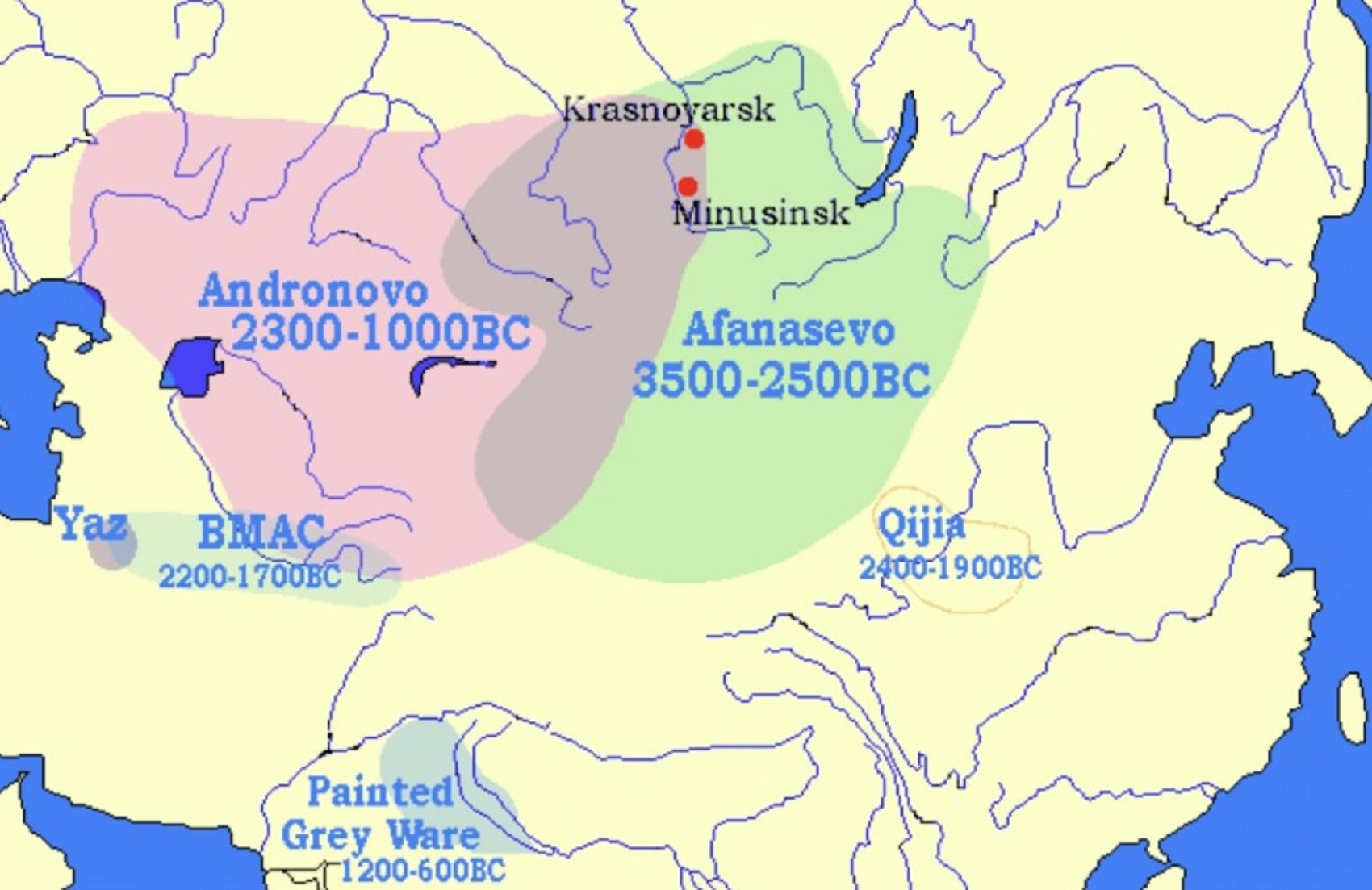
“A map with marked archaeological sites from Afanasievo and Andronovo cultures show that they were genetically related to Indo-European language dispersals.” ref
“The Kurgan hypothesis is the most widely accepted proposal to identify the Proto-Indo-European homeland from which the Indo-European languages spread out throughout Europe and parts of Asia. It postulates that the people of a Kurgan culture in the Pontic steppe north of the Black Sea were the most likely speakers of the Proto-Indo-European language (PIE). The term is derived from the Russian kurgan (курга́н), meaning tumulus or burial mound.” ref
“Tocharian may have been plausibly introduced to the Dzungarian Basin by Afanasievo migrants during the Early Bronze Age.” https://www.nature.com/articles/s41586-021-04052-7
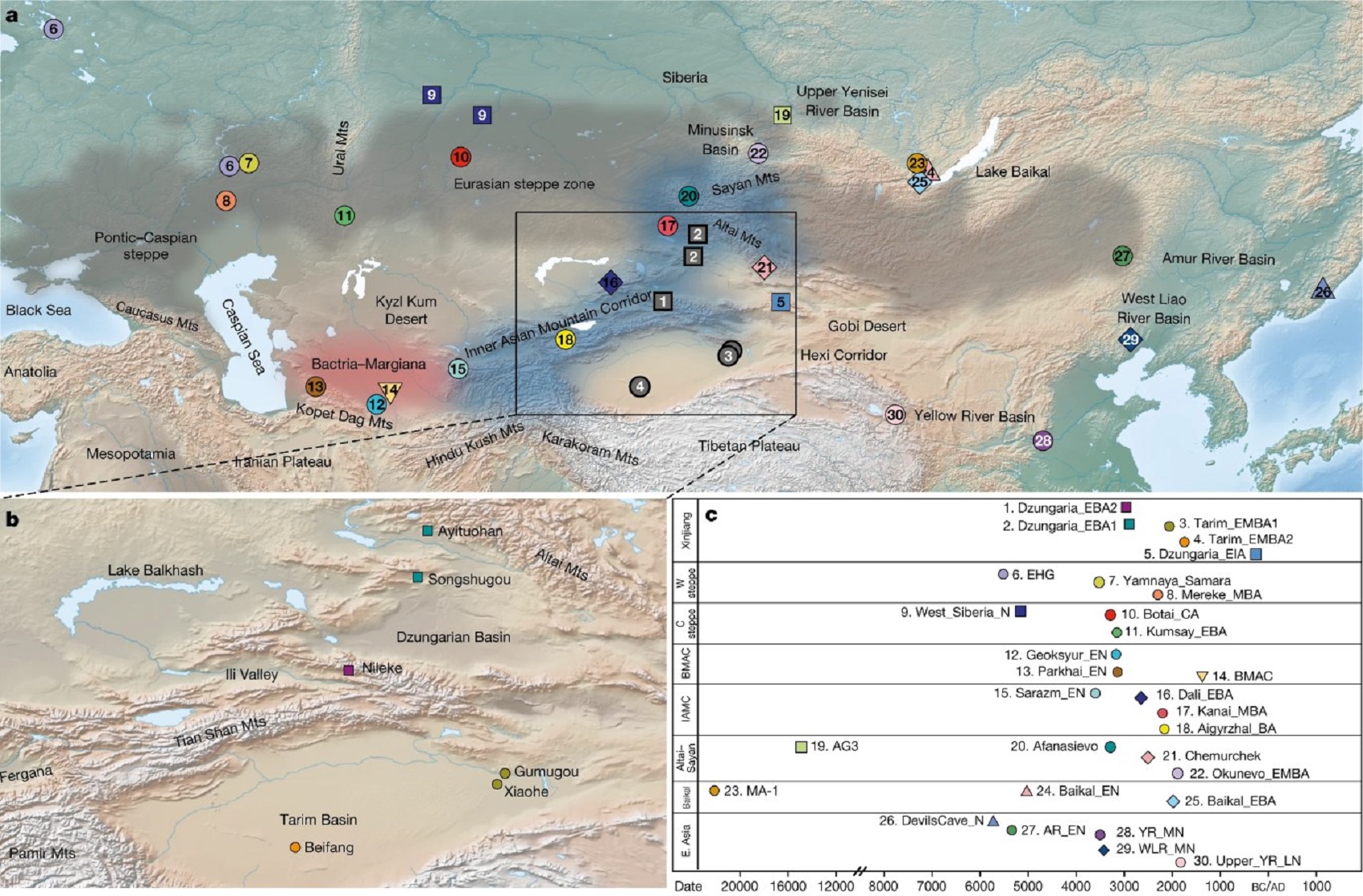
Overview of key Eurasian geographic regions, features, and archaeological sites of the Xinjiang Bronze Age
“Early Bronze Age Dzungarian individuals exhibit a predominantly Afanasievo ancestry with an additional local contribution, and the Early–Middle Bronze Age Tarim individuals contain only a local ancestry.” https://www.nature.com/articles/s41586-021-04052-7

“Transeurasian languages. The abbreviations for the languages can be found in the article. Martine Robbeets, Remco Bouckaert (2018).” ref
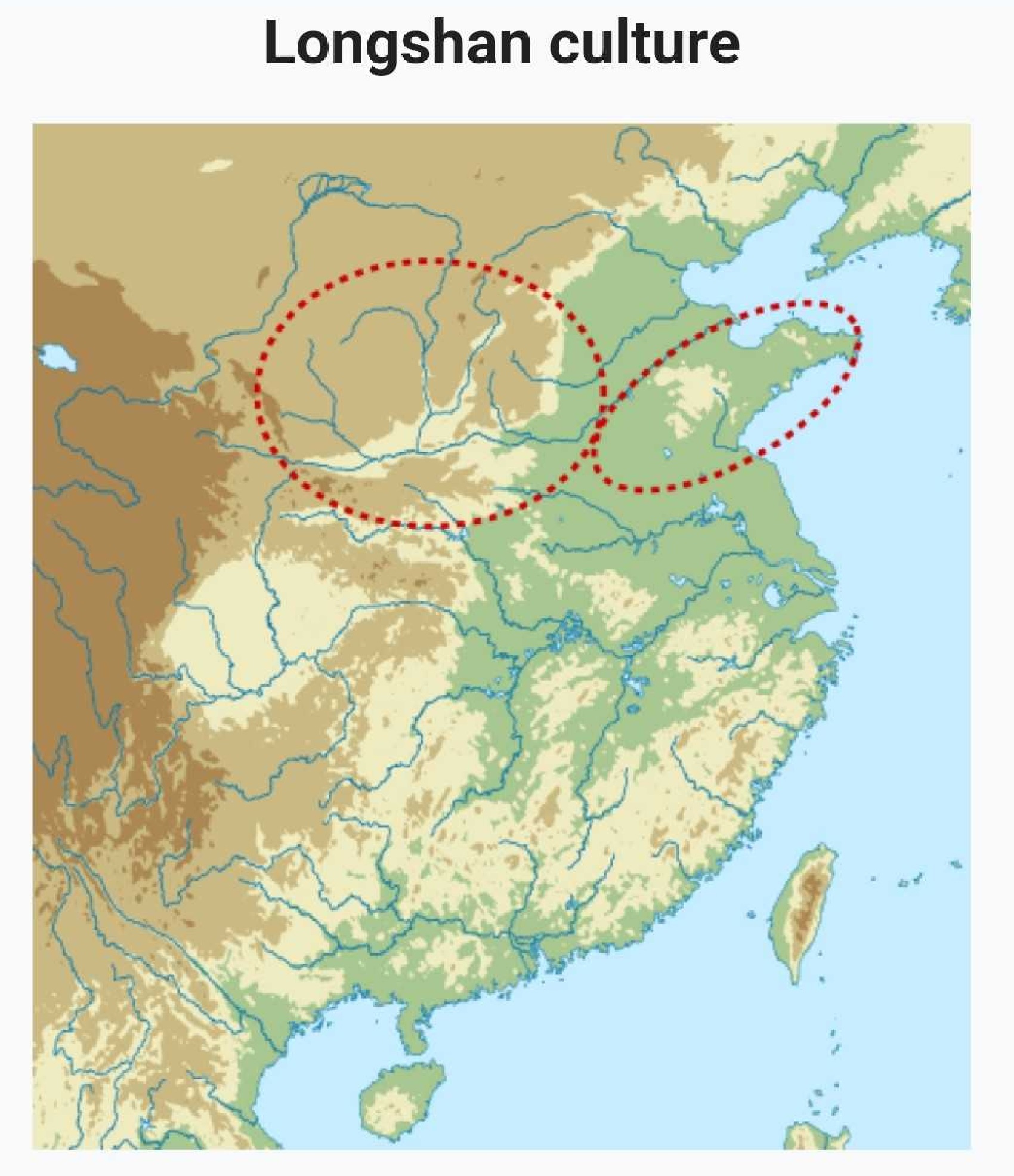
“The Longshan (or Lung-shan) culture, also sometimes referred to as the Black Pottery Culture, was a late Neolithic culture in the middle and lower Yellow River valley areas of northern China from about 3,000 to 1,900 BCE or around 5,000 to 3,900 years ago. It decreased in most areas around 2000 BCE until the central area evolved into the Bronze Age Erlitou culture. The Longshan culture has been linked to the early Sinitic (of the Sino-Tibetan languages). Remains have been found in Shaanxi and southern Henan of scapulae of cattle, pigs, sheep, and deer that were heated as a form of divination. Evidence of human sacrifice becomes more common in Shaanxi and the Central Plain in the late Longshan period.” ref
“Oracle bones are pieces of ox scapula and turtle plastron, which were used for pyromancy – a form of divination – in ancient China, mainly during the late Shang dynasty. The Shang dynasty dates from 1,600 to 1,045 BCE or around 3,600 to 3,045 years ago. The Anyang site has yielded the earliest known body of Chinese writing, using an early form of Chinese characters, mostly divinations inscribed on oracle bones – turtle shells, ox scapulae, or other bones.” ref
Show 5 “Bronze Age and Ancient China” Ritual, Religion, Elites, Language, and Empires
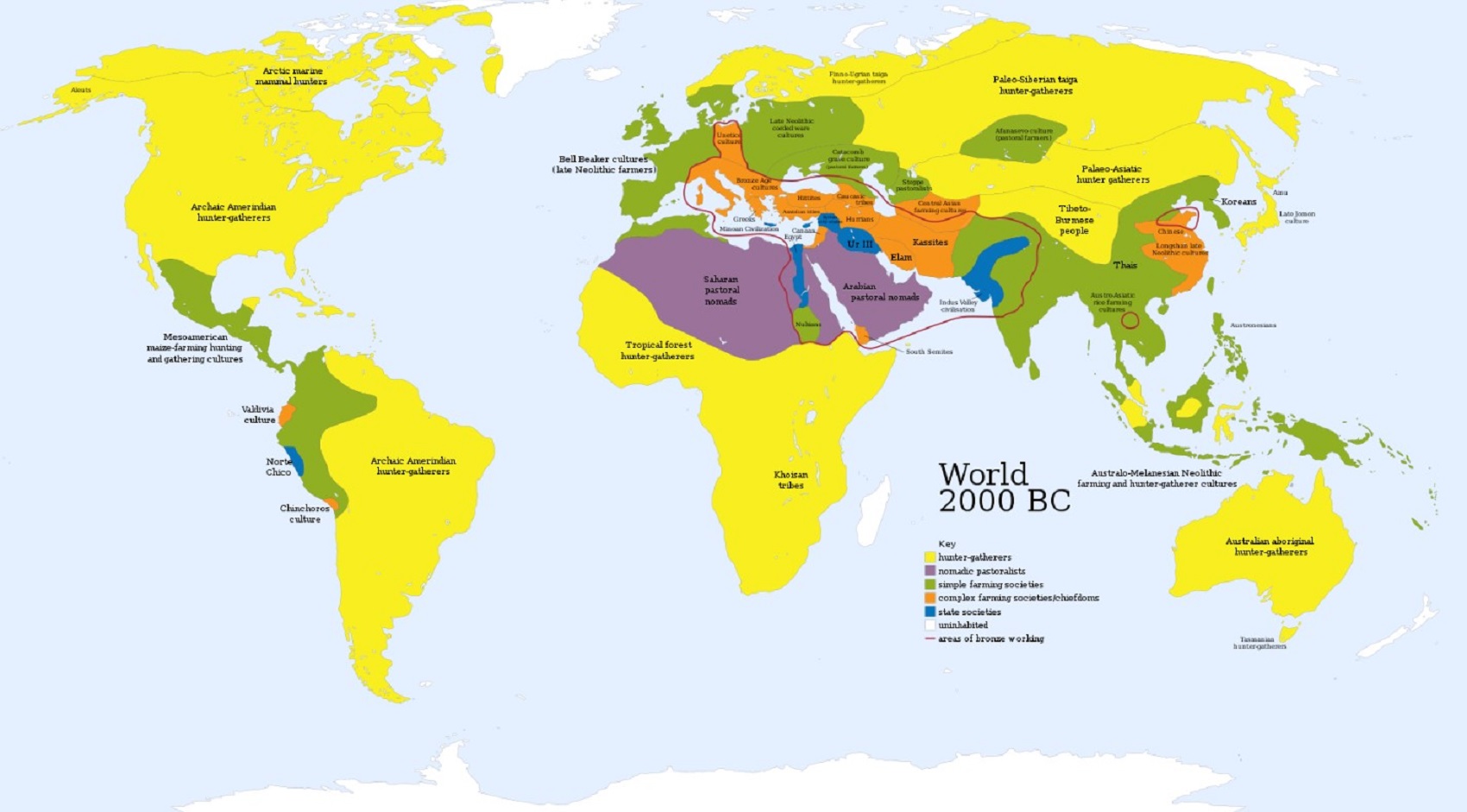
“Map of the world in 2000 BCE or around 4,000 years ago. Red outline indicates areas of bronze working, c. 2000 BCE.” https://en.wikipedia.org/wiki/Bronze_Age
Bronze Age China
“The Bronze Age in China began around 2000 BCE, and the earliest excavated ritual bronze vessels date to around 1600 BCE. Found in tombs, these vessels were made for use in rites performed on an ancestral altar or cast specifically for burial with the dead. Only Chinese kings and high-ranking nobility could afford such expensive and labor-intensive artifacts, which required a knowledge of mining, smelting, metallurgy, and casting to execute. From Shang dynasty (1600–1046 BCE) records comprised of some 200,000 inscriptions on bone and turtle shells, we know that Chinese ancestors were propitiated with elaborate rites, feasts, and sacrifices. If ancestors were displeased with the activities of their descendants or the rituals offered to them, they might fail to act on their progeny’s behalf, or even cause their descendants harm. This could come in the form of poor harvests, drought, or famine. The Chinese believed in a complex world of spirits, which comprised a multitude of nature deities, royal ancestors, and others who controlled important earthly phenomena such as weather, harvests, births, deaths, and military campaigns.” https://artmuseum.indiana.edu/collections-online/features/asian-islamic/chinese-bronze-vessels.php
Bronze age Asia
Agropastoralism
“For many decades scholars made superficial reference to Central Asia as the “pastoral realm” or alternatively, the “nomadic world”, in what researchers have come to call the “Central Asian void”: a 5,000 year span that was neglected in studies of the origins of agriculture. Foothill regions and glacial melt streams supported Bronze Age agropastoralists who developed complex east–west trade routes between Central Asia and China that introduced wheat and barley to China and spread millet across Central Asia.” ref
“The Altai Mountains in what is now southern Russia and central Mongolia have been identified as the point of origin of a cultural enigma termed the Seima-Turbino Phenomenon. It is conjectured that changes in climate in this region around 2000 BCE and the ensuing ecological, economic, and political changes triggered a rapid and massive migration westward into northeast Europe, eastward into China, and southward into Vietnam and Thailand across a frontier of some 4,000 miles. This migration took place in just five to six generations and led to peoples from Finland in the west to Thailand in the east employing the same metalworking technology and, in some areas, horse breeding and riding. It is further conjectured that the same migrations spread the Uralic group of languages across Europe and Asia: some 39 languages of this group are still extant, including Hungarian, Finnish, and Estonian. However, recent genetic testings of sites in south Siberia and Kazakhstan (Andronovo horizon) would rather support a spreading of the bronze technology via Indo-European migrations eastwards, as this technology was well known for quite a while in western regions.” ref
“In China, the earliest bronze artifacts have been found in the Majiayao culture site (between 3100 and 2700 BCE). The term “Bronze Age” has been transferred to the archaeology of China from that of Western Eurasia, and there is no consensus or universally used convention delimiting the “Bronze Age” in the context of Chinese prehistory. By convention, the “Early Bronze Age” in China is sometimes taken as equivalent to the “Shang dynasty” period (16th to 11th centuries BCE), and the “Later Bronze Age” as equivalent to the “Zhou dynasty” period (11th to 3rd centuries BC, from the 5th century, also dubbed “Iron Age“), although there is an argument to be made that the “Bronze Age” proper never ended in China, as there is no recognizable transition to an “Iron Age”. Significantly, together with the jade art that precedes it, bronze was seen as a “fine” material for ritual art when compared with iron or stone.” ref
“Bronze metallurgy in China originated in what is referred to as the Erlitou (Wade–Giles: Erh-li-t’ou) period, which some historians argue places it within the range of dates controlled by the Shang dynasty. Others believe the Erlitou sites belong to the preceding Xia (Wade–Giles: Hsia) dynasty. The U.S. National Gallery of Art defines the Chinese Bronze Age as the “period between about 2000 BCE and 771 BCE”, a period that begins with the Erlitou culture and ends abruptly with the disintegration of Western Zhou rule.” ref
“There is reason to believe that bronze work developed inside China separately from outside influence. However, the discovery of Europoid mummies in Xinjiang has caused some scholars such as Johan Gunnar Andersson, Jan Romgard, and An Zhimin to suggest a possible route of transmission from the West eastwards. According to An Zhimin, “It can be imagined that initially bronze and iron technology took its rise in West Asia, first influenced the Xinjiang region, and then reached the Yellow River valley, providing external impetus for the rise of the Shang and Zhou civilizations.” According to Jan Romgard, “bronze and iron tools seems to have traveled from west to east as well as the use of wheeled wagons and the domestication of the horse.” There are also possible links to Seima-Turbino culture, “a transcultural complex across northern Eurasia,” the Eurasian steppe, and the Urals. However, the oldest bronze objects found in China so far were discovered at the Majiayao site in Gansu rather than at Xinjiang.” ref
“The Shang dynasty (also known as the Yin dynasty) of the Yellow River Valley rose to power after the Xia dynasty around 1600 BC. While some direct information about the Shang dynasty comes from Shang-era inscriptions on bronze artifacts, most comes from oracle bones—turtle shells, cattle scapulae, or other bones—which bear glyphs that form the first significant corpus of recorded Chinese characters.” ref
“The production of Erlitou in Henan represents the earliest large-scale metallurgy industry in the Central Plains of China. The influence of the Saima-Turbino metalworking tradition from the north is supported by a series of recent discoveries in China of many unique perforated spearheads with downward hooks and small loops on the same or opposite side of the socket, which could be associated with the Seima-Turbino visual vocabulary of southern Siberia. The metallurgical centers of northwestern China, especially Qijia in Gansu and Kexingzhuang culture in Shaanxi, played an intermediary role in this process.” ref
“Iron has been found from the Zhou dynasty, but its use was minimal. Chinese literature dating to the 6th century BCE attests knowledge of iron smelting, yet bronze continues to occupy the seat of significance in the archaeological and historical record for some time after this. Historian W.C. White argues that iron did not supplant bronze “at any period before the end of the Zhou dynasty (256 BCE)” and that bronze vessels make up the majority of metal vessels through the Later Han period, or to 221 BCE.” ref
“The Chinese bronze artifacts generally are either utilitarian, like spear points or adze heads, or “ritual bronzes”, which are more elaborate versions in precious materials of everyday vessels, as well as tools and weapons. Examples are the numerous large sacrificial tripods known as dings in Chinese; there are many other distinct shapes. Surviving identified Chinese ritual bronzes tend to be highly decorated, often with the taotie motif, which involves highly stylized animal faces. These appear in three main motif types: those of demons, of symbolic animals, and abstract symbols. Many large bronzes also bear cast inscriptions that are the great bulk of the surviving body of early Chinese writing and have helped historians and archaeologists piece together the history of China, especially during the Zhou dynasty (1046–256 BCE).” ref
“The bronzes of the Western Zhou dynasty document large portions of history not found in the extant texts that were often composed by persons of varying rank and possibly even social class. Further, the medium of cast bronze lends the record they preserve a permanence not enjoyed by manuscripts. These inscriptions can commonly be subdivided into four parts: a reference to the date and place, the naming of the event commemorated, the list of gifts given to the artisan in exchange for the bronze, and a dedication. The relative points of reference these vessels provide have enabled historians to place most of the vessels within a certain time frame of the Western Zhou period, allowing them to trace the evolution of the vessels and the events they record.” ref
“In Ban Chiang, Thailand, (Southeast Asia) bronze artifacts have been discovered dating to 2100 BCE. However, according to the radiocarbon dating on the human and pig bones in Ban Chiang, some scholars propose that the initial Bronze Age in Ban Chiang was in late 2nd millennium. In Nyaunggan, Burma, bronze tools have been excavated along with ceramics and stone artifacts. Dating is still currently broad (3500–500 BCE). Ban Non Wat, excavated by Charles Higham, was a rich site with over 640 graves excavated that gleaned many complex bronze items that may have had social value connected to them.” ref
“Ban Chiang, however, is the most thoroughly documented site while having the clearest evidence of metallurgy when it comes to Southeast Asia. With a rough date range of late 3rd millennium BCE to the first millennium CE, this site alone has various artifacts such as burial pottery (dating from 2100 to 1700 BCE), fragments of Bronze, copper-base bangles, and much more. What’s interesting about this site, however, is not just the old age of the artifacts but that this technology suggested on-site casting from the very beginning. The on-site casting supports the theory that Bronze was first introduced in Southeast Asia as fully developed which therefore shows that Bronze was innovated from a different country. Some scholars believe that the copper-based metallurgy was disseminated from northwest and central China via south and southwest areas such as Guangdong province and Yunnan province and finally into southeast Asia around 1000 BCE. Archaeology also suggests that Bronze Age metallurgy may not have been as significant a catalyst in social stratification and warfare in Southeast Asia as in other regions, social distribution shifting away from chiefdom-states to a heterarchical network. Data analyses of sites such as Ban Lum Khao, Ban Na Di, Non-Nok Tha, Khok Phanom Di, and Nong Nor have consistently led researchers to conclude that there was no entrenched hierarchy.” ref
“The beginning of the Bronze Age on the peninsula is around 1000–800 BCE. Initially centered around Liaoning and southern Manchuria, Korean Bronze Age culture exhibits unique typology and styles, especially in ritual objects. The Mumun pottery period is named after the Korean name for undecorated or plain cooking and storage vessels that form a large part of the pottery assemblage over the entire length of the period, but especially 850–550 BCE. The Mumun period is known for the origins of intensive agriculture and complex societies in both the Korean Peninsula and the Japanese Archipelago.” ref
“The Middle Mumun pottery period culture of the southern Korean Peninsula gradually adopted bronze production (c. 700–600? BCE) after a period when Liaoning-style bronze daggers and other bronze artifacts were exchanged as far as the interior part of the Southern Peninsula (c. 900–700 BCE). The bronze daggers lent prestige and authority to the personages who wielded and were buried with them in high-status megalithic burials at south-coastal centers such as the Igeum-dong site. Bronze was an important element in ceremonies and as for mortuary offerings until 100 BCE. Dating back to the Neolithic Age, the first bronze drum, called the Dong Son drum, were uncovered in and around the Red River Delta regions of Northern Vietnam and Southern China. These relate to the Dong Son culture of Vietnam.” ref
“Archaeological research in Northern Vietnam indicates an increase in rates of infectious disease following the advent of metallurgy; skeletal fragments in sites dating to the early and mid-Bronze Age evidence a greater proportion of lesions than in sites of earlier periods. There are a few possible implications of this. One is the increased contact with bacterial and/or fungal pathogens due to increased population density and land clearing/cultivation. The other one is decreased levels of immunocompetence in the Metal age due to changes in the diet caused by agriculture. The last is that there may have been an emergence of infectious disease in the Da But the period that evolved into a more virulent form in the metal period.” ref
“The Japanese archipelago saw the introduction of bronze during the beginning of the Early Yayoi period (≈300 BCE), which saw the introduction of metalworking and agricultural practices brought in by settlers arriving from the continent. Bronze and iron smelting techniques spread to the Japanese archipelago through contact with other ancient East Asian civilizations, particularly immigration and trade from ancient Korean peninsula and ancient mainland China. Iron was mainly used for agricultural and other tools, whereas ritual and ceremonial artifacts were mainly made of bronze.” ref
I speculate that the Seima-Turbino culture artifacts of male figures may represent a sky god such as Tian/Tengri/*Dyḗus, and thus to me, could represent a similar shared deity that was then added and applied differently to different cultures hiding their related ancient connections of shared mythology.
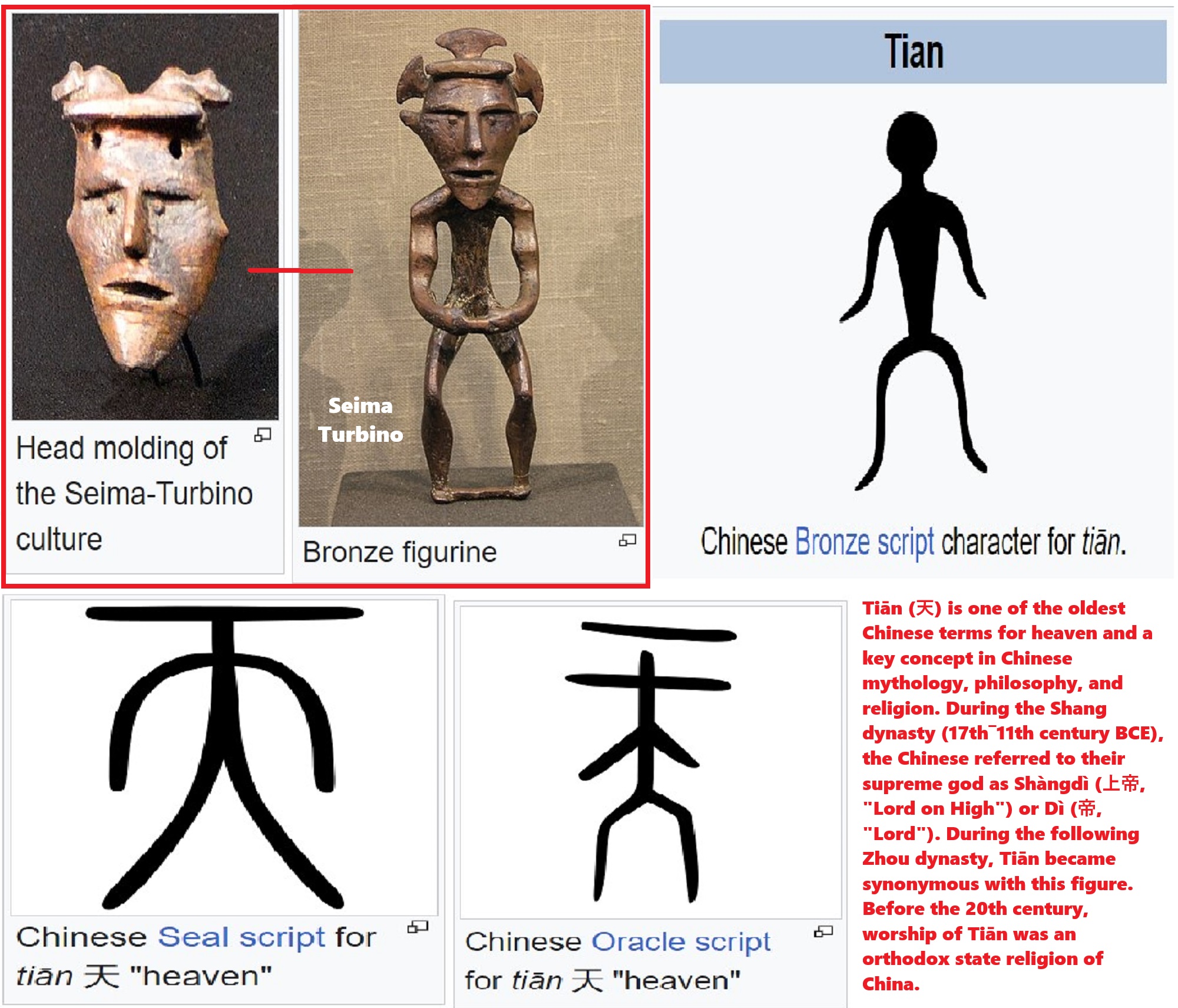
“Tiān (天) is one of the oldest Chinese terms for heaven and a key concept in Chinese mythology, philosophy, and religion. During the Shang dynasty (17th―11th century BCE), the Chinese referred to their supreme god as Shàngdì (上帝, “Lord on High”) or Dì (帝, “Lord”). During the following Zhou dynasty, Tiān became synonymous with this figure. Before the 20th century, worship of Tiān was an orthodox state religion of China. In Taoism and Confucianism, Tiān (the celestial aspect of the cosmos, often translated as “Heaven“) is mentioned in relationship to its complementary aspect of Dì (地, often translated as “Earth“). They are thought to maintain the two poles of the Three Realms (三界) of reality, with the middle realm occupied by Humanity (人, rén), and the lower world occupied by demons (魔, mó) and “ghosts”, the damned, (鬼, guǐ). Tiān was variously thought as a “supreme power reigning over lesser gods and human beings” that brought “order and calm…or catastrophe and punishment”, a god, destiny, an “impersonal” natural force that controlled various events, a holy world or afterlife containing other worlds or afterlives, or one or more of these.” ref
“The modern Chinese character 天 and early seal script both combine dà 大 “great; large” and yī 一 “one”, but some of the original characters in Shāng oracle bone script and Zhōu bronzeware script anthropomorphically portray a large head on a great person. The ancient oracle and bronze ideograms for dà 大 depict a stick figure person with arms stretched out denoting “great; large”. The oracle and bronze characters for tiān 天 emphasize the cranium of this “great (person)”, either with a square or round head, or head marked with one or two lines. Schuessler notes the bronze graphs for tiān, showing a person with a round head, resemble those for dīng 丁 “4th Celestial stem“, and suggests “The anthropomorphic graph may or may not indicate that the original meaning was ‘deity’, rather than ‘sky’.” Two variant Chinese characters for tiān 天 “heaven” are 二人 (written with 二 er “two” and 人 ren “human”) and the Daoist coinage 靝 (with 青 qīng “blue” and 氣 “qì“, i.e., “blue sky”).” ref
“The Modern Standard Chinese pronunciation of 天 “sky, heaven; heavenly deity, god” is tiān [tʰi̯ɛn˥] in level first tone. The character is read as Cantonese tin1; Taiwanese thiN1 or thian1; Vietnamese thiên; Korean cheon or ch’ŏn (천); and Japanese ten in On’yomi (borrowed Chinese reading) and ama- (bound), ame (free), or sora in Kun’yomi (native Japanese reading). Tiān 天 reconstructions in Middle Chinese (c. 6th–10th centuries CE) include t’ien, t’iɛn, tʰɛn > tʰian, and then. Reconstructions in Old Chinese (c. 6th–3rd centuries BCE) include *t’ien, *t’en, *hlin, *thîn, and *l̥ˤin. In some cases, the heavens in Shinto were thought to be a hierarchy of multiple, sphere-like realms that contained kami such as fox spirits. Myths about the kami were told “of their doings on Earth and in heaven.” Heaven was thought to be a clean and orderly place for nature gods in Shinto.” ref
“Kami (Japanese: 神, [kaꜜmi]) are the deities, divinities, spirits, mythological, spiritual, or natural phenomena, or holy powers that are venerated in the Shinto religion. They can be elements of the landscape, forces of nature, beings and the qualities that these beings express, and/or the spirits of venerated dead people. Many kami are considered the ancient ancestors of entire clans (some ancestors became kami upon their death if they were able to embody the values and virtues of kami in life). Traditionally, great leaders like the Emperor could be or became kami. Although deity is the common interpretation of kami, some Shinto scholars argue that such a translation can cause a misunderstanding of the term. Some etymological suggestions are: Kami may, at its root, simply mean spirit, or an aspect of spirituality. It is written with the kanji 神, Sino-Japanese reading shin or jin. In Chinese, the character means deity. And, in the Ainu language, the word kamuy refers to an animistic concept very similar to Japanese kami. The matter of the words’ origins is still a subject of debate; but it is generally suggested that the word kami was derived from Ainu word kamuy.” ref
“A kamuy (Ainu: カムィ; Japanese: カムイ, romanized: kamui) is a spiritual or divine being in Ainu mythology, a term denoting a supernatural entity composed of or possessing spiritual energy. The Ainu people have many myths about the kamuy, passed down through oral traditions and rituals. The stories of the kamuy were portrayed in chants and performances, which were often performed during sacred rituals. In concept, kamuy are similar to the Japanese kami but this translation misses some of the nuances of the term (the missionary John Batchelor assumed that the Japanese term was of Ainu origin). The usage of the term is very extensive and contextual among the Ainu, and can refer to something regarded as especially positive as well as something regarded as especially strong. Kamuy can refer to spiritual beings, including animals, plants, the weather, and even human tools. Guardian angels are called Ituren-Kamui. Kamuy are numerous; some are delineated and named, such as Kamuy Fuchi, the hearth goddess, while others are not.” ref
“Kamuy often have very specific associations, for instance, there is a kamuy of the undertow. Batchelor compares the word with the Greek term daimon. Personified deities of Ainu mythology often have the term kamuy applied as part of their names. Though kamuy yukar is considered to be one of the oldest genres of Ainu oral performance, anthropologist Emiko Ohnuki-Tierney supposed that there are more than 20 types of genres. Originally, it seems kamuy yukar was performed solely for religious purposes by the women who took on the role of shamans. The shamans became possessed and recanted the chants, possibly explaining why kamuy yukar is performed with a first-person narrative. As time passed, kamuy yukar became less of a sacred ritual, serving as entertainment and as a way to pass down traditions and cultural stories.” ref
“For the etymology of tiān, Schuessler links it with the Mongolian word tengri “sky, heaven, heavenly deity” or the Tibeto-Burman words taleŋ (Adi) and tǎ-lyaŋ (Lepcha), both meaning “sky”. He also suggests a likely connection between Chinese tiān 天, diān 巔 “summit, mountaintop”, and diān 顛 “summit, top of the head, forehead”, which have cognates such as Zemeic Naga tiŋ “sky”. However, other reconstructions of 天’s OC pronunciation *qʰl’iːn or *l̥ˤi[n] reconstructed a voiceless lateral onset, either a cluster or a single consonant, respectively. Baxter & Sagart pointed to attested dialectal differences in Eastern Han Chinese, the use of 天 as a phonetic component in phono-semantic compound Chinese characters, and the choice of 天 to transcribe foreign syllables, all of which prompted them to conclude that, around 200 CE, 天’s onset had two pronunciations: coronal *tʰ & dorsal *x, both of which likely originated from an earlier voiceless lateral *l̥ˤ.” ref
“Tiān is one of the components in hundreds of Chinese compounds. Some significant ones include:
- Tiānmìng (天命 “Mandate of Heaven“) “divine mandate, God’s will; fate, destiny; one’s lifespan”
- Tiānwèn (simplified Chinese: 天问; traditional Chinese: 天問; pinyin: Tiānwèn), the Heavenly Questions section of the Chǔ Cí.
- Tiānzĭ (天子 “Son of Heaven“), an honorific designation for the “Emperor; Chinese sovereign” (Tiānzǐ accounts for 28 of the 140 tiān occurrences in the Shī Jīng above.)
- Tiānxià (天下, lit. “all under heaven“) “the world, earth; China”
- Tiāndì (天地, lit “heaven and earth”) “the world; the universe.”
- Xíngtiān (刑天) An early mythological hero who fought against Heaven, despite being decapitated.
- Tiānfáng (天房, lit. “House of Heaven”) A Chinese name for the Kaaba, from Bayt Allah (Arabic: بَيْت ٱللَّٰه, lit. ‘House of God’).” ref
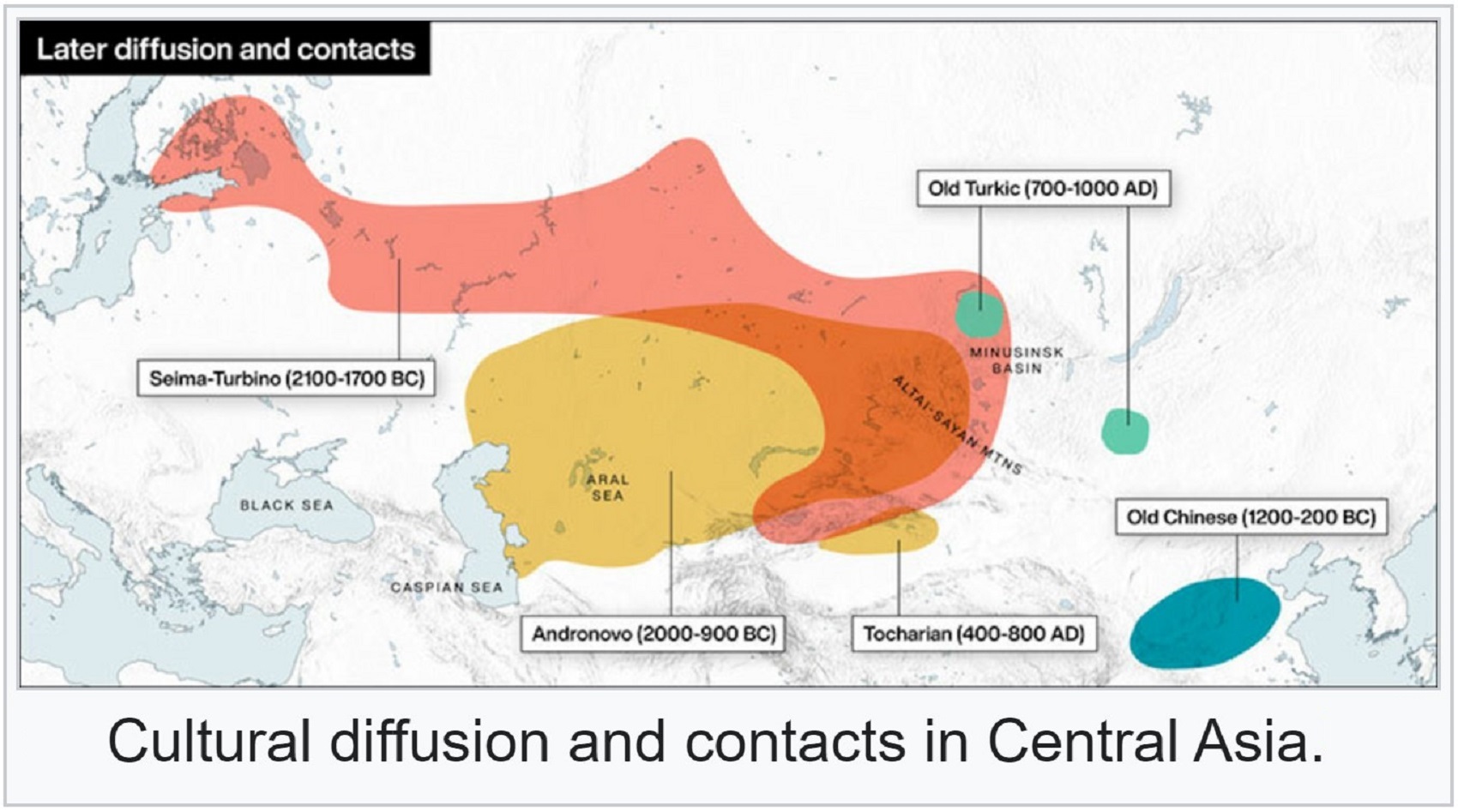
“The Seima-Turbino culture has inspired conjectures that the same migrations spread the Uralic languages across Europe and Asia. The existence of Uralic Samoyedic and Ob-Ugrian groups like the Nenets, Mansi, and Khanty, anchor the Uralic languages in Asia. Notable is the similarity between the range of haplogroup N3a3’6, especially in the western part of Eurasia and the distribution of the Seima-Turbino trans-cultural phenomenon during the interval of 4,200–3,700 years ago. Carriers of N3a1-B211, the early branch of N3a, could have migrated to the eastern fringes of Europe by the same Seima-Turbino groups. However, earlier migrations cannot be ruled out either; a study of ancient DNA revealed a 7,500 year-old influx from Siberia to northeast Europe. Another subclade of Y haplogroup N, N1a2b-P43 (TMRCA 4,700 years ago 95% CI 3,800 ⟷ 5,600 years ago), reaches some of its highest frequencies among the Uralic-speaking Nenets, Nganasan, Khanty, and Mansi peoples in western Siberia. Haplogroup N1a2b-P43 is also often observed among the members of many Uralic- or Turkic-speaking ethnic minorities of European Russia, but it is very rare among the Baltic Finnic and Samic peoples of Northern Europe. Estimated to be approximately 4,700 years old, N1b spread north and westwards from its original locus in Southern Siberia, exactly as Seima-Turbino migration did.” ref
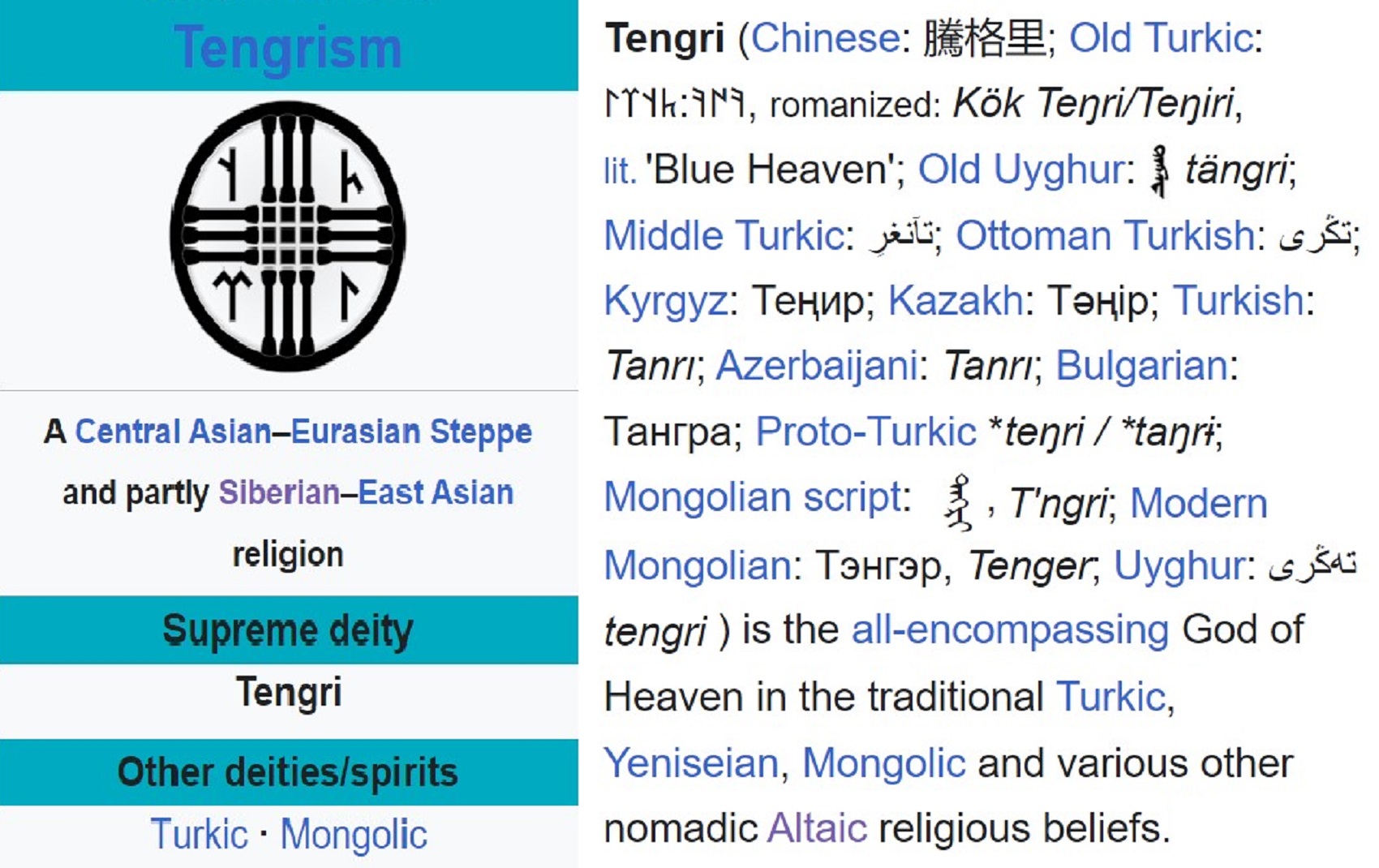
Tengrism is an ethnic Turkic, Yeniseian, and Mongolic religion originating in the Eurasian steppes based on shamanism and animism. Tengri is the all-encompassing God of Heaven.
Tengri
“Tengri (Old Turkic: 𐰚𐰇𐰚:𐱅𐰭𐰼𐰃, romanized: Kök Teŋri/Teŋiri, lit. ‘Blue Heaven’; Old Uyghur: ![]() tängri; Middle Turkic: تآنغرِ; Ottoman Turkish: تڭری; Kyrgyz: Теңир; Kazakh: Тәңір; Turkish: Tanrı; Azerbaijani: Tanrı; Bulgarian: Тангра; Proto-Turkic *teŋri / *taŋrɨ; Mongolian script: ᠲᠩᠷᠢ, T’ngri; Modern Mongolian: Тэнгэр, Tenger; Uyghur: تەڭرى tengri ) is the all-encompassing God of Heaven in the traditional Turkic, Yeniseian, Mongolic and various other nomadic Altaic religious beliefs. Tengri is not considered a deity in the usual sense, but a personification of the universe. However, some qualities associated with Tengri as the judge and source of life, and being eternal and supreme, led European and Muslim writers to identify Tengri as a deity of Turkic and Mongolian people. According to Mongolian belief, Tengri’s will (jayayan) may break its own usual laws and intervene by sending a chosen person to earth. It is also one of the terms used for the primary chief deity of the early Turkic and Mongolic peoples. Worship surrounding Tengri is called Tengrism. The core beings in Tengrism are the Sky Father (Tenger Etseg) and the Earth Mother (Umay Ana). It involves shamanism, animism, totemism, and ancestor worship.” ref
tängri; Middle Turkic: تآنغرِ; Ottoman Turkish: تڭری; Kyrgyz: Теңир; Kazakh: Тәңір; Turkish: Tanrı; Azerbaijani: Tanrı; Bulgarian: Тангра; Proto-Turkic *teŋri / *taŋrɨ; Mongolian script: ᠲᠩᠷᠢ, T’ngri; Modern Mongolian: Тэнгэр, Tenger; Uyghur: تەڭرى tengri ) is the all-encompassing God of Heaven in the traditional Turkic, Yeniseian, Mongolic and various other nomadic Altaic religious beliefs. Tengri is not considered a deity in the usual sense, but a personification of the universe. However, some qualities associated with Tengri as the judge and source of life, and being eternal and supreme, led European and Muslim writers to identify Tengri as a deity of Turkic and Mongolian people. According to Mongolian belief, Tengri’s will (jayayan) may break its own usual laws and intervene by sending a chosen person to earth. It is also one of the terms used for the primary chief deity of the early Turkic and Mongolic peoples. Worship surrounding Tengri is called Tengrism. The core beings in Tengrism are the Sky Father (Tenger Etseg) and the Earth Mother (Umay Ana). It involves shamanism, animism, totemism, and ancestor worship.” ref
“The oldest form of the name is recorded in Chinese annals from the 4th century BCE, describing the beliefs of the Xiongnu. It takes the form 撑犁/Cheng-li, which is hypothesized to be a Chinese transcription of Tängri. (The Proto-Turkic form of the word has been reconstructed as *Teŋri or *Taŋrɨ.) Alternatively, a reconstructed Altaic etymology from *T`aŋgiri (“oath” or “god”) would emphasize the god’s divinity rather than his domain over the sky. It is generally assumed the term tengri originally meant “sky”. Andrey Kononov suggested that the term is formed by the words tän (morning) and injir (evening) into tänri, referring to the sky as whole. The Turkic form, Tengri, is attested in the 8th century Orkhon inscriptions as the Old Turkic form 𐱅𐰭𐰼𐰃 Teŋri. In modern Turkish, the derived word “Tanrı” is used as the generic word for “god”, or for the Abrahamic God, and is used today by Turkish people to refer to any god. The supreme deity of the traditional religion of the Chuvash is Tură. Other reflexes of the name in modern languages include Mongolian: Тэнгэр (“sky”), Bulgarian: Тангра, Azerbaijani: Tanrı.” ref
“Earlier, the Chinese word for “sky” 天 (Mandarin: tiān < Old Chinese *thīn or *thîn) has been suggested to be related to Tengri, possibly a loan into Chinese from a prehistoric Central Asian language. However, this proposal is unlikely in light of recent reconstructions of the Old Chinese pronunciation of the character “天”, such as *qʰl’iːn (Zhengzhang) or *l̥ˤi[n] (Baxter-Sagart), which propose for 天 a voiceless lateral onset, either a cluster or single consonant, respectively. Baxter & Sagart (2014:113-114) pointed to attested dialectal differences in Eastern Han Chinese, the use of 天 as a phonetic component in phono-semantic compound Chinese characters, and the choice of 天 to transcribe foreign syllables, all of which prompted them to conclude that, around 200 CE, 天’s onset had two pronunciations: coronal *tʰ & dorsal *x, both of which likely originated from an earlier voiceless lateral *l̥ˤ. Linguist Stefan Georg has proposed that the Turkic word ultimately originates as a loanword from Proto-Yeniseian *tɨŋgɨr- “high”. Amy Chua renders the name as “[T]he Eternal Blue Sky”, likely because of the connotations of the name’s usage.” ref
“Tengri was the national god of the Göktürks, described as the “god of the Turks” (Türük Tängrisi). The Göktürk khans based their power on a mandate from Tengri. These rulers were generally accepted as the sons of Tengri who represented him on Earth. They wore titles such as tengrikut, kutluġ or kutalmysh, based on the belief that they attained kut, some sort of heavenly and spiritual force granted to these rulers by Tengri. Prior to foreign influences, the Turkic conception of tengri was regarded as the heaven or the will controlling heaven, probably some sort of force. Out of this, the concept of a personal being developed. First, when Turkic people took over other religions, the term tengri became the name of a (personal) god or “higher being”. Tengri was the chief deity worshipped by the ruling class of the Central Asian steppe peoples in 6th to 9th centuries (Turkic peoples, Mongols, and Hungarians). It lost its importance when the Uighuric kagans proclaimed Manichaeism the state religion in the 8th century. The worship of Tengri was brought into Eastern Europe by the Huns and early Bulgars. Tengri is considered to be the chief god who created all things. In addition to this celestial god, they also had minor divinities (Alps) that served the purposes of Tengri. As Gök Tanrı, he was the father of the sun (Koyash) and moon (Ay Tanrı) and also Umay, Erlik, and sometimes Ülgen.” ref
“Tengri was the main god of the Turkic pantheon, controlling the celestial sphere. Tengri is considered to be similar to the Indo-European sky god, *Dyeus, and the structure of the reconstructed Proto-Indo-European religion is closer to that of the early Turks than to the religion of any people of Near Eastern or Mediterranean antiquity. In Christian Turkish usage Tengri is used for the father of Jesus, who is referred to as “Tengri Oghli” (Son of God) and “Mshikha Tengri” (Messiah God). Tengri is also compared to Allah and Khuda. Apart from foreign religious influences, as far as known today, the original Turkish concept of Tengri was that of “heaven” or a spirit ruling in heaven. This spirit was probably imagined as some sort of force, corresponding to “mana” in modern ethnology. In one Turkic myth, Tengri is a pure, white goose that flies constantly over an endless expanse of water, which represents time. Beneath this water, Ak Ana (“White Mother”) calls out to him saying “Create”. To overcome his loneliness, Tengri creates Er Kishi, who is not as pure or as white as Tengri and together they set up the world. Er Kishi becomes a demonic character and strives to mislead people and draw them into its darkness. Tengri assumes the name Tengri Ülgen and withdraws into Heaven from which he tries to provide people with guidance through sacred animals that he sends among them. The Ak Tengris occupy the fifth level of Heaven. Shaman priests who want to reach Tengri Ülgen never get further than this level, where they convey their wishes to the divine guides. Returns to earth or to the human level take place in a goose-shaped vessel.” ref
Tengrism
Tengrism (also known as Tengriism, Tengerism, or Tengrianism) is an ethnic Turkic, Yeniseian, Mongolic religion originating in the Eurasian steppes based on shamanism and animism. It generally involves the titular sky god Tengri, who is not considered a deity in the usual sense, but a personification of the universe. According to some scholars, adherents of Tengrism view the purpose of life, to be in harmony with the universe. It was the prevailing religion of the Tujue, Xianbei, Bulgars, Xiongnu, Huns, and possibly the Hungarians, as well as the state religion of several medieval states: the First Turkic Khaganate, the Western Turkic Khaganate, the Eastern Turkic Khaganate, Old Great Bulgaria, the First Bulgarian Empire, Volga Bulgaria, Khazaria, and the Mongol Empire. In the Irk Bitig, a ninth century manuscript on divination, Tengri is mentioned as Türük Tängrisi (God of Turks). According to many academics, Tengrism was, and to some extent still is, a predominantly polytheistic religion based on shamanistic concept of animism, and was first influenced by monotheism during the imperial period, especially by the 12th–13th centuries. Abdulkadir Inan argues that Yakut and Altai shamanism are not entirely equal to the ancient Turkic religion.” ref
“The term also describes several contemporary Turkic and Mongolic native religious movements and teachings. All modern adherents of “political” Tengrism are monotheists. Tengrism has been advocated for in intellectual circles of the Turkic nations of Central Asia (Kyrgyzstan with Kazakhstan) and the Russian federation (Tatarstan, Bashkortostan) since the dissolution of the Soviet Union during the 1990s. Still practiced, it is undergoing an organized revival in Buryatia, Sakha (Yakutia), Khakassia, Tuva, and other Turkic nations in Siberia. Altaian Burkhanism and Chuvash Vattisen Yaly are contemporary movements similar to Tengrism. The term tengri can either refer to the sky deity or refer also to other deities (compare this with the concept of Kami). Tengrism includes the worship of the tngri (gods), with Tenger Etseg ( – also Gök Tengri; Sky father, Blue sky). While other deities, such as Ülgen or Kaira, are personified gods, Tengri is an “abstract phenomenon”. In the Mongolian folk religion, Genghis Khan is considered one of the embodiments, if not the main embodiment, of Tengri’s will. Stefan Georg proposed that the Turkic Tengri ultimately originates as a loanword from Proto-Yeniseian *tɨŋgɨr- “high”. Mongolia is sometimes poetically called the “Land of Eternal Blue Sky” (Mönkh Khökh Tengeriin Oron) by its inhabitants. According to some scholars, the name of the important deity Dangun (also Tangol) (God of the Mountains) of the Korean folk religion is related to the Siberian Tengri (“Heaven”), while the bear is a symbol of the Big Dipper (Ursa Major).” ref
“According to Jean-Paul Roux, the monotheistic concept evolved later out of a polytheistic system and was not the original form of Tengrism. The monotheistic concept helped to legitimate the rule of the dynasty: “As there is only one God in Heaven, there can only be one ruler on the earth …”. Others point out that Tengri itself was never an Absolute, but only one of many gods of the upper world, the sky deity, of polytheistic shamanism, later known as Tengrism. Tengrism differs from contemporary Siberian shamanism in that it was a more organized religion. Additionally the polities practicing it were not small bands of hunter-gatherers like the Paleosiberians, but a continuous succession of pastoral, semi-sedentarized khanates and empires from the Xiongnu Empire (founded 209 BCE) to the Mongol Empire (13th century). In Mongolia it survives as a synthesis with Tibetan Buddhism while surviving in purer forms around Lake Khovsgol and Lake Baikal. Unlike Siberian shamanism, which has no written tradition, Tengrism can be identified from Turkic and Mongolic historical texts like the Orkhon inscriptions, Secret History of the Mongols, and Altan Tobchi.” ref
“However, these texts are more historically oriented and are not strictly religious texts like the scriptures and sutras of sedentary civilizations, which have elaborate doctrines and religious stories. On a scale of complexity, Tengrism lies somewhere between the Proto-Indo-European religion (a pre-state form of pastoral shamanism on the western steppe) and its later form the Vedic religion. The chief god Tengri (“Heaven”) is considered strikingly similar to the Indo-European sky god *Dyḗus and the East Asian Tian (Chinese: “Sky; Heaven”). The structure of the reconstructed Proto-Indo-European religion is actually closer to that of the early Turks than to the religion of any people of neolithic European, Near Eastern, or Mediterranean antiquity. The term “shamanism” was first applied by Western anthropologists as outside observers of the ancient religion of the Turkic and Mongolic peoples, as well as those of the neighboring Tungusic and Samoyedic-speaking peoples. Upon observing more religious traditions across the world, some Western anthropologists began to also use the term in a very broad sense. The term was used to describe unrelated magico-religious practices found within the ethnic religions of other parts of Asia, Africa, Australasia, and even completely unrelated parts of the Americas, as they believed these practices to be similar to one another.” ref

Erlitou culture of Ancient China
“The Erlitou culture was an early Bronze Age urban society and archaeological culture that existed in the Yellow River valley from approximately 1900 to 1500 BCE or around 3,900 to 3,500 years ago. (A 2007 study of radiocarbon dating proposed a narrower date range of 1750 to 1530 BCE) The culture was named after the site discovered at Erlitou in Yanshi, Henan. It was widely spread throughout Henan and Shanxi and later appeared in Shaanxi and Hubei. Most archaeologists consider Erlitou the first state-level society in China. Chinese archaeologists generally identify the Erlitou culture as the site of the Xia dynasty, but there is no firm evidence, such as writing, to substantiate such a linkage, as the earliest evidence of Chinese writing dates to the late Shang dynasty. The Erlitou culture may have evolved from the matrix of the Longshan culture (3000 – c. 1900 BCE). Originally centered around Henan and Shanxi provinces, the culture spread to Shaanxi and Hubei provinces. After the rise of the Erligang culture, the site at Erlitou diminished in size but remained inhabited.” ref
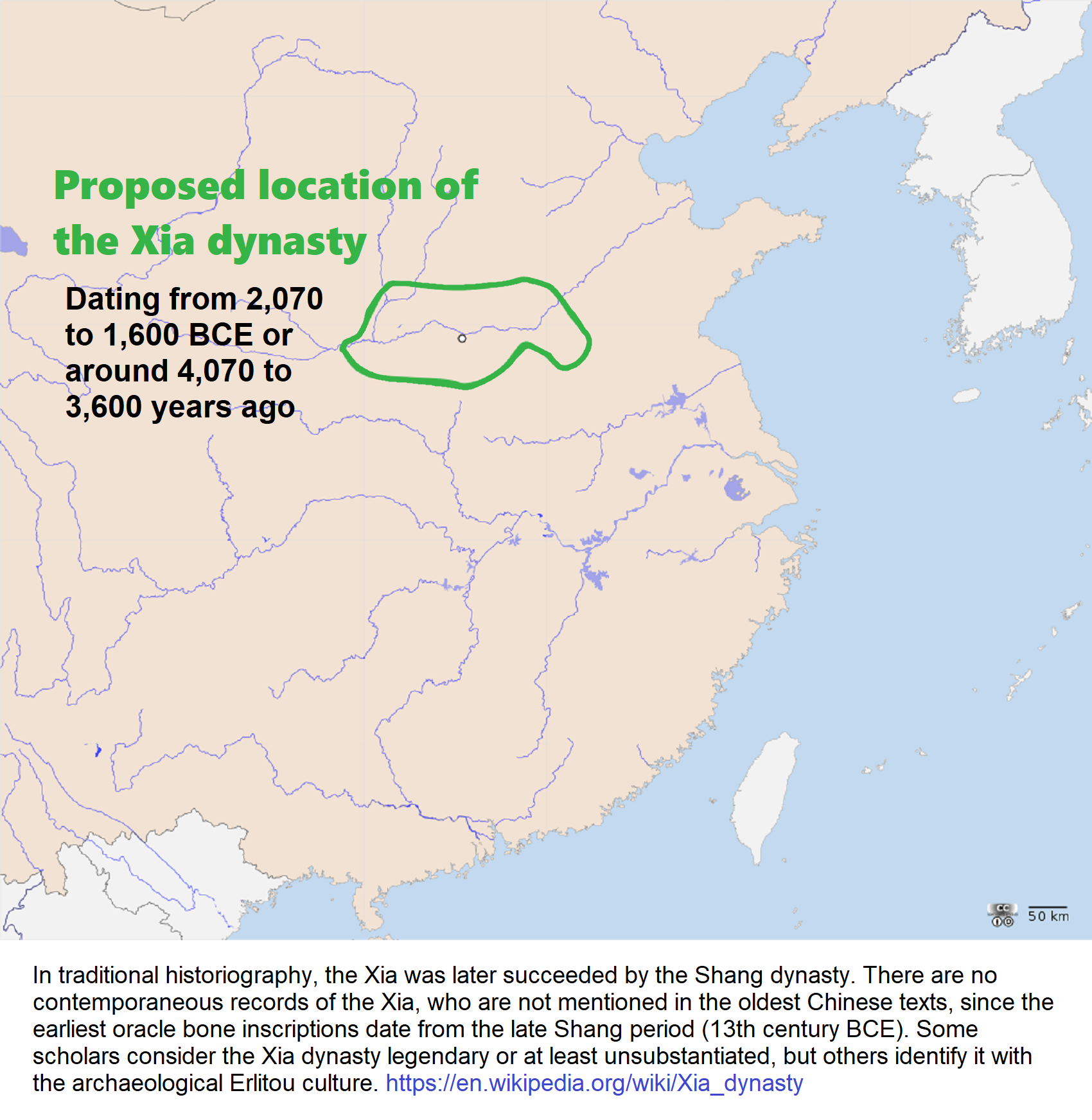
Xia dynasty
“The Xia dynasty from 2070 to 1600 BCE or around 4,070 to 3,600 years ago is the first dynasty in traditional Chinese historiography. In traditional historiography, the Xia was later succeeded by the Shang dynasty. M-DNA from Yinxu graves showed similarities with modern northern Han Chinese.” ref, ref
“According to tradition, the Xia dynasty was established by the legendary Yu the Great, after Shun, the last of the Five Emperors, gave the throne to him. There are no contemporaneous records of the Xia, who are not mentioned in the oldest Chinese texts, since the earliest oracle bone inscriptions date from the late Shang period (13th century BCE). The earliest mentions occur in the oldest chapters of the Book of Documents, which report speeches from the early Western Zhou period and are accepted by most scholars as dating from that time. The speeches justify the Zhou conquest of the Shang as the passing of the Mandate of Heaven and liken it to the succession of the Xia by the Shang. That political philosophy was promoted by the Confucian school in the Eastern Zhou period. The succession of dynasties was incorporated into the Bamboo Annals and the Records of the Grand Historian and became the official position of imperial historiography and ideology. Some scholars consider the Xia dynasty legendary or at least unsubstantiated, but others identify it with the archaeological Erlitou culture.” ref
“According to the traditional chronology, based upon calculations by Liu Xin, the Xia ruled between 2205 and 1766 BCE. According to the chronology based on the “current text” Bamboo Annals, it ruled between 1989 and 1558 BCE. Comparing the same text with dates of five-planet conjunctions, David Pankenier, supported by David Nivison, proposed dates of 1953 and 1555 BCE. The Xia–Shang–Zhou Chronology Project, commissioned by the Chinese government in 1996, concluded that the Xia existed between 2070 and 1600 BCE. The Xia dynasty was described in classic texts such as the Classic of History (Shujing), the Bamboo Annals, and the Records of the Grand Historian (Shiji) by Sima Qian. According to tradition, the resident Huaxia were the ancestral people of the Han Chinese. Traditional histories trace the development of the Xia to the mythical Three Sovereigns and Five Emperors. According to ancient Chinese texts, before the Xia dynasty was established, battles were frequent between Yellow Emperor‘s tribe and Chi You‘s tribe. The Records of the Grand Historian and the Classic of Rites say that Yu the Great, the founder of the Xia dynasty, was the grandson of Zhuanxu, who was the grandson of the Yellow Emperor. But there are also other records, like Ban Gu‘s, that say Yu’s father is a fifth generation descendant of Zhuanxu. Other sources such as Shan Hai Jing mention Yu’s father Gun was the son of Luoming, who was the son of Huangdi. Sima Qian traced the origin of the dynastic Xia to the name of a fief granted to Yu, who would use it as his own surname and his state’s name.” ref
“Gun, the father of Yu the Great, is the earliest recorded member of the Xia clan. When the Yellow River flooded, many tribes united together to control and stop the flooding. Gun was appointed by Emperor Yao to stop the flooding. He ordered the construction of large blockades (levees) to block the path of the water. The attempts of Gun to stop the flooding lasted for nine years, but ultimately failed because the floods strengthened. After nine years, Yao had already given his throne to Shun. Gun was ordered to be imprisoned for life by Shun at Yushan (Chinese: 羽山; pinyin: Yǔshān, Feather Mountain), a mountain located between modern Donghai County in Jiangsu Province and Linshu County in Shandong Province. Yu was highly trusted by Shun, so Shun appointed him to finish his father’s work, which was to stop the flooding. Yu’s method was different from his father’s: he organized people from different tribes and ordered them to help him build canals in all the major rivers that were flooding and leading the water out to the sea. Yu was dedicated to his work. The populace praised his perseverance and were inspired, so much so that other tribes joined in the work. Legend says that in the 13 years, it took him to successfully complete the work to stop the floods, he never went back to his home village to stop and rest, even though he passed by his house three times.” ref
“Yu’s success in stopping the flooding increased agricultural production (since the floods were destructive). The Xia tribe’s power increased and Yu became the leader of the surrounding tribes. Soon afterwards Shun sent Yu to lead an army to suppress the Sanmiao tribe, which continuously abused the border tribes. After defeating them, he exiled them south to the Han River area. This victory strengthened the Xia tribe’s power even more. As Shun aged, he thought of a successor and relinquished the throne to Yu, whom he deemed worthy. Yu’s succession marks the start of the Xia dynasty. As Yu neared death he passed the throne to his son, Qi, instead of passing it to the most capable candidate, thus setting the precedent for dynastic rule or the Hereditary System. The Xia dynasty began a period of family or clan control. It is believed that Zhenxun (modern Gongyi) and Yangcheng (modern Gaocheng) were two of the capitals of the dynasty. Jie, the last king, was said to be immoral, lascivious, and tyrannical. He was overthrown by Tang, the first king of the Shang dynasty. Tang is said to have given the small state of Qi as a fief to the remnants of the Xia ruling family. This practice was referred to as “the two crownings and the three respects”. Zengzi was a descendant of the Xia dynasty Kings through Shao Kang. The Kings of the State of Yue claimed descent from the Xia dynasty Kings through Shao Kang.” ref
“The time gap between the supposed time of the Xia and the first written references to it have meant that the historicity of the Xia dynasty itself and the traditional narrative of its history are at best uncertain. The Skeptical School of early Chinese history, started by Gu Jiegang in the 1920s, was the first group of scholars within China to systematically question the traditional story of its early history. By critically examining the development of the narrative of early Chinese history throughout history, Gu concluded “the later the time, the longer the legendary period of earlier history… early Chinese history is a tale told and retold for generations, during which new elements were added to the front end”. Some historians have suggested that the Zhou rulers invented the Xia as a pretext, to justify their conquest of the Shang, by noting that just as the Shang had supplanted the Xia, they had supplanted the Shang. The existence of the Xia remains unproven, despite efforts by Chinese archaeologists to link them with the Bronze Age Erlitou culture.” ref
“Among other points, Gu and other historians note certain parallels between the traditional narrative of Xia history and Shang history that would suggest probable Zhou-era fabrication or at least embellishment of Xia history. Yun Kuen Lee’s criticism of nationalist sentiment in developing an explanation of the Three Dynasties chronology focuses on the dichotomy of evidence provided by archaeological versus historical research, in particular, the claim that the archaeological Erlitou culture is also the historical Xia dynasty. “How to fuse the archaeological dates with historical dates is a challenge to all chronological studies of early civilization.” In The Shape of the Turtle: Myth, Art, and Cosmos in Early China, Sarah Allan noted that many aspects of the Xia are simply the opposite of traits held to be emblematic of the Shang. The implied dualism of the Shang myth system, Allan argues, is that while the Shang represents the suns, sky, birds, east, and life, the Xia represents the moons, watery underworld, dragons, west, and death. Allan argues that this mythical Xia was re-interpreted by the Zhou as a ruling dynasty replaced by the Shang, a parallel with their own replacement of the Shang.” ref
“Other scholars also argue that Shang political class’s remnants still existed during the early Zhou dynasty, Zhou rulers could not simply justify their succession to pacify Shang remnants if it was entirely fabricated since the Shang remnants, who remembered prior histories, would not believe it in the first place. For example, the Classic of Poetry preserves the “Eulogies of Shang” (商頌 Shāng sòng) which represents the powerful State of Song, whose rulers were the direct descendants of Shang dynasty. Among those eulogies, the eulogy Chang Fa (長發) celebrated victories by the “Martial King” Tang of Shang against Wei (韋), Gu (顧), Kunwu (昆吾), and Jie of Xia. During the later Song dynasty (960–1279 AD), an ancient bronze artifact, “Shu Yi Zhong” (叔夷鐘), was unearthed with an inscription describing how the founder of the Shang dynasty, Tang, overthrew the Xia dynasty.” ref
“The owner of this artifact, Shu Yi, a high officer of the Qi Kingdom during the Spring and Autumn period (c. 600 BCE), was actually a direct descendant of the Song rulers, which means he himself was a descendant of Shang people. This bronze artifact was used to memorialize his Shang ancestors. The inscription contradicts the hypothesis that the Zhou dynasty manufactured the existence of the Xia dynasty. Although the Shang oracle bone inscriptions contain no mention of the Xia, some scholars have suggested that the polities they mention might be remnants of the Xia. Guo Moruo suggested that an enemy state called Tufang state of the Fang states mentioned in many inscriptions might be identified with the Xia. The historian Shen Changyun pointed to four inscriptions mentioning Qǐ (杞), the same name as the state of Qǐ, which according to traditional accounts was established by the defeated royal house of Xia. The following table lists the rulers of Xia according to Sima Qian‘s Shiji. Unlike Sima’s list of Shang dynasty kings, which is closely matched by inscriptions on oracle bones from late in that period, records of Xia rulers have not yet been found in archaeological excavations of contemporary sites, or records on later Shang dynasty oracle bones.” ref
Xia Dynasty Archaeological Discoveries?
“Archaeologists have uncovered urban sites, bronze implements, and tombs that point to the possible existence of the Xia dynasty at locations cited in ancient Chinese historical texts. There exists a debate as to whether or not the Erlitou culture was the site of the Xia dynasty, largely centering on whether archeological evidence of urban habitation across the region before the Shang dynasty should be taken as corroboration of the traditional account of a Xia, or expected regardless of the historicity of the Xia due to the trajectory of population growth and agricultural development in the fertile regions of eastern China from the neolithic through early history. Radiocarbon dating places the Erlitou sites at c. 2100 to 1800 BC, providing physical evidence of the existence of a state contemporaneous with and possibly equivalent to the Xia dynasty as described in later classical Chinese historical works. In 1959, a site located in the city of Yanshi was excavated containing large palaces that some archaeologists have claimed to be the capital of the Xia dynasty. Through the 1960s and 1970s, archaeologists have uncovered urban sites, bronze implements, and tombs in the same locations cited in ancient Chinese historical texts regarding Xia; in 2011, Chinese archaeologists uncovered the remains of an imperial sized palace—dated to about 1700 BCE—at Erlitou in Henan, further fueling the discussions about the existence of the dynasty. At a minimum, the era traditionally denoted as the Xia dynasty marked a period of urbanization and agricultural development bridging the late Neolithic cultures and the urban civilization of the Shang dynasty.” ref
“Archaeological evidence of a large outburst flood at Jishi Gorge that destroyed the Lajia site on the upper reaches of the Yellow River has been dated to about 1920 BCE. This date is shortly before the rise of the Erlitou culture in the middle Yellow River valley and the Yueshi culture in Shandong, following the decline of the Longshan culture in the North China Plain. The authors suggest that this flood may have been the basis for the later myth of Yu the Great, and contributed to the cultural transition into the Erlitou period. They further argue that the timing is further evidence for the identification of the Xia with the Erlitou culture. However, no evidence of contemporaneous widespread flooding in the North China Plain has yet been found. The only musical instruments dated to the Xia dynasty are two qing, two small bells (one earthenware, one bronze) and a xun. Due to this extreme scarcity of surviving instruments and the general uncertainty surrounding most of the Xia, creating a musical narrative of the period is impractical.” ref
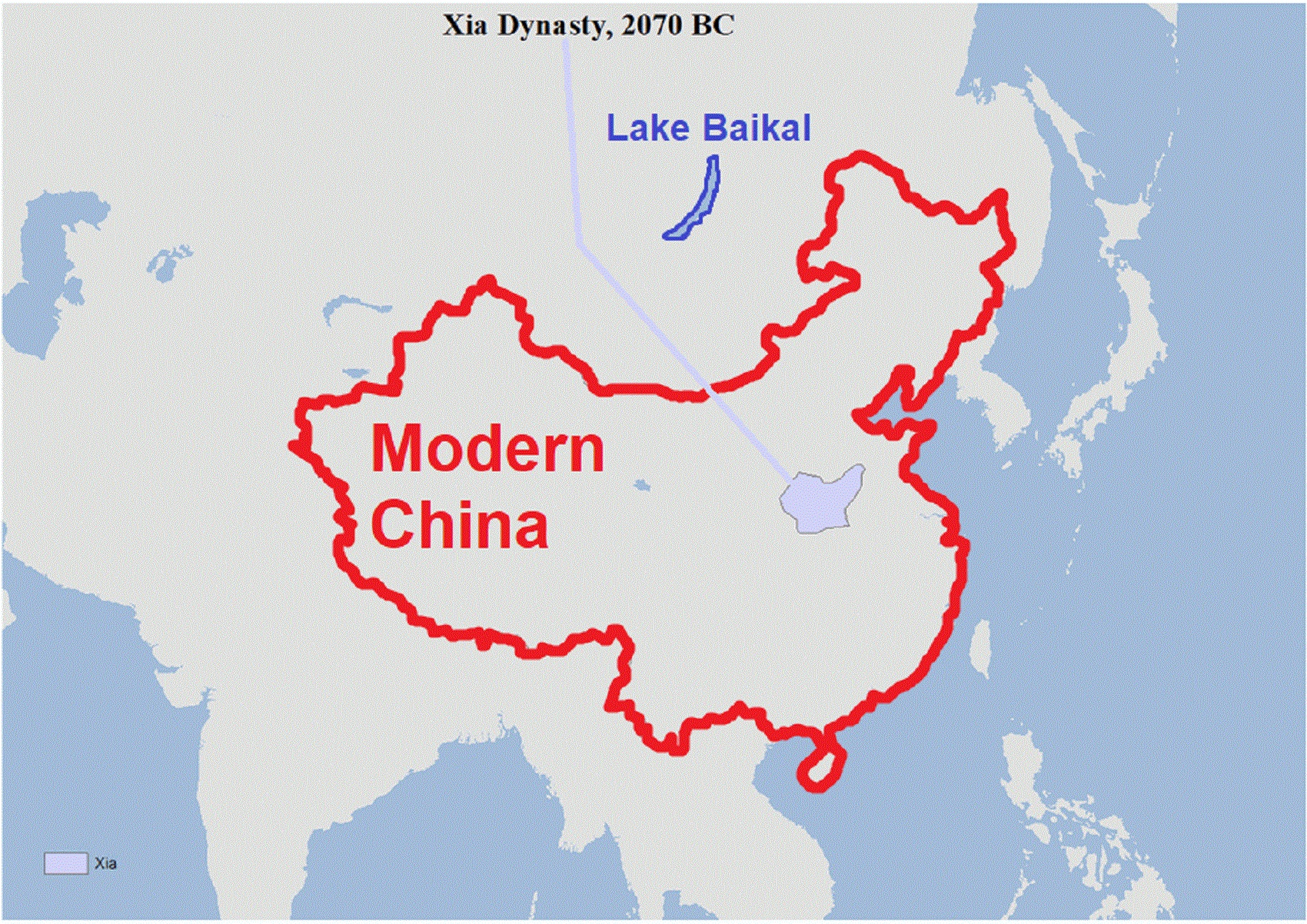
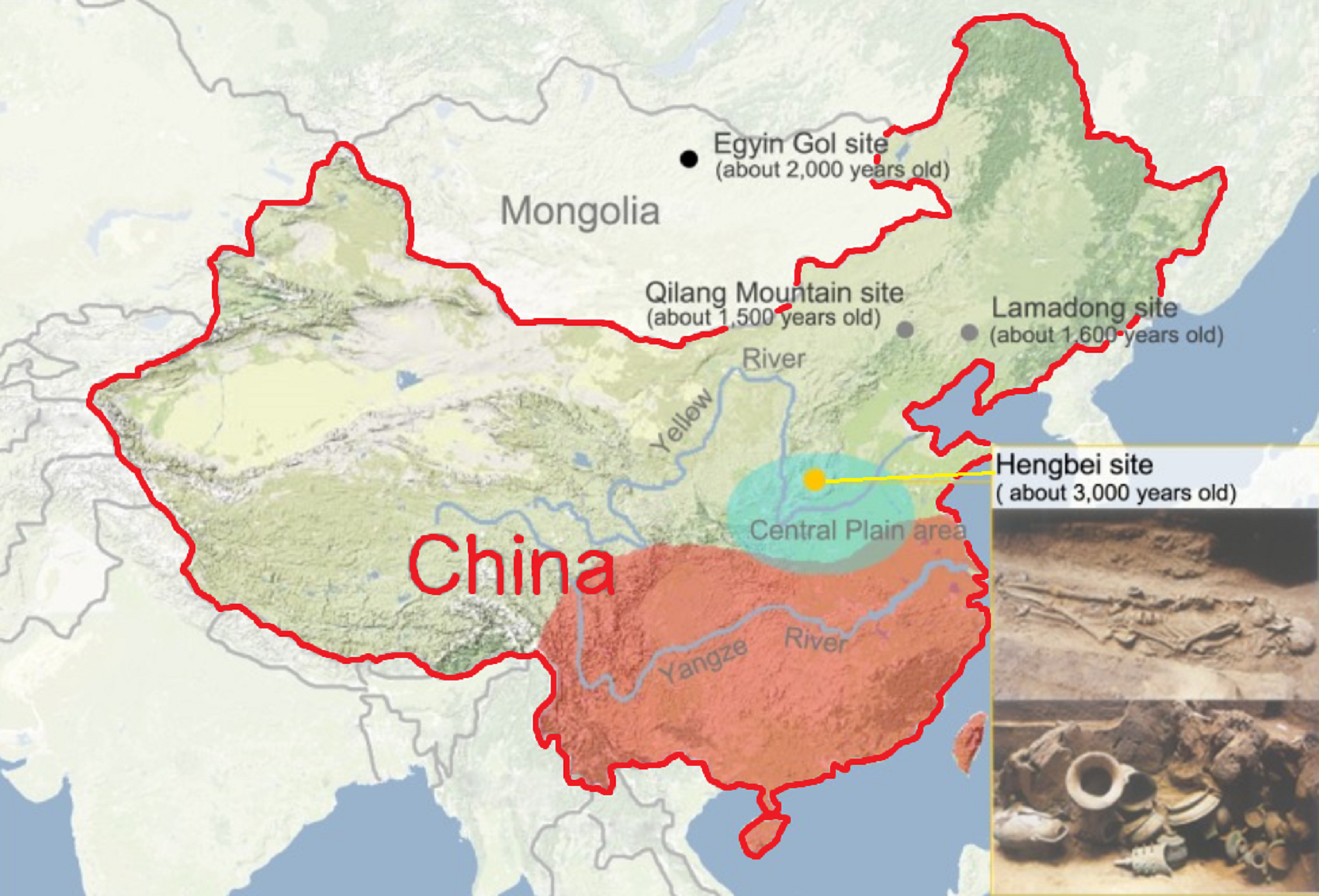
Ancient DNA Reveals That the Genetic Structure of the Northern Han Chinese Was Shaped Prior to 3,000 Years Ago
“The Han Chinese are the largest ethnic group in the world and have a current population of a staggering 1.3 billion individuals. According to historical documents, the generally accepted view is that the Han Chinese can trace their origins to the Huaxia ethnic group, which formed during the Shang and Zhou dynasties (21st–8th centuries BCE) in the Central Plain region of China. During the Han Dynasty (260 BCE-220 CE), the Huaxia ethnic group developed into a tribe known as the Han Chinese.” ref
“Abstract: The Han Chinese are the largest ethnic group in the world, and their origins, development, and expansion are complex. Many genetic studies have shown that Han Chinese can be divided into two distinct groups: northern Han Chinese and southern Han Chinese. The genetic history of the southern Han Chinese has been well studied. However, the genetic history of the northern Han Chinese is still obscure. In order to gain insight into the genetic history of the northern Han Chinese, 89 human remains were sampled from the Hengbei site which is located in the Central Plain and dates back to a key transitional period during the rise of the Han Chinese (approximately 3,000 years ago). We used 64 authentic mtDNA data obtained in this study, 27 Y chromosome SNP data profiles from previously studied Hengbei samples, and genetic datasets of the current Chinese populations and two ancient northern Chinese populations to analyze the relationship between the ancient people of Hengbei and present-day northern Han Chinese. We used a wide range of population genetic analyses, including principal component analyses, shared mtDNA haplotype analyses, and geographic mapping of maternal genetic distances. The results show that the ancient people of Hengbei bore a strong genetic resemblance to present-day northern Han Chinese and were genetically distinct from other present-day Chinese populations and two ancient populations. These findings suggest that the genetic structure of northern Han Chinese was already shaped 3,000 years ago in the Central Plain area.” ref
“A study of mitochondrial DNA (inherited in the maternal line) from Yinxu graves showed similarity with modern northern Han Chinese, but significant differences from southern Han Chinese. Yinxu is the site of one of the ancient and major historical capitals of China. It is the source of the archeological discovery of oracle bones and oracle bone script, which resulted in the identification of the earliest known Chinese writing. The archeological remnants (or ruins) known as Yinxu represent the ancient city of Yin, the last capital of China‘s Shang dynasty which existed through eight generations for 255 years, and through the reign of 12 kings. Among surviving ancient Chinese historical documents, Yin is described as the final capital of the Shang dynasty. There is some disagreement, though, as to when the move to Yin took place.” ref

|
Location of the Tarim mummies, with other contemporary cultures c. 2000 BCE
|
|
| Geographical range | Taklamakan Desert in the Tarim Basin |
|---|---|
| Period | Bronze Age |

“Tarim mummies A 2021 genetic study on the Tarim mummies found that they were primarily descended from a population represented by the Afontova Gora 3 specimen (AG3), genetically displaying “high affinity” with it. The genetic profile of the Afontova Gora 3 individual represented about 72% of the ancestry of the Tarim mummies, while the remaining 28% of their ancestry was derived from a population represented by the Baikal EBA (Early Bronze Age Baikal populations).” ref
“The “Xiaohe Mummy”, exhibited in Xinjiang Museum, is one of the oldest Tarim mummies, dating more than 3,800 years ago. Another mummy from the same place is the “Princess of Xiaohe. A genomic study published in 2021 found that these early mummies (dating from 2,135 to 1,623 BCE) had high levels of Ancient North Eurasian ancestry (ANE, about 72%), with smaller admixture from Ancient Northeast Asians (ANA, about 28%), but no detectable Western Steppe-related ancestry.” ref
“Afontova Gora is a Late Upper Paleolithic and Mesolithic Siberian complex of archaeological sites located on the left bank of the Yenisei River near the city of Krasnoyarsk, Russia. Afontova Gora has cultural and genetic links to the people from Mal’ta-Buret’. The human fossils discovered at Afontova Gora, a male and a girl dated to 17,000~15,000 years ago. In a 2016 study, researchers determined that Afontova Gora 2, Afontova Gora 3, and Mal’ta 1 (Mal’ta boy) shared common descent and were clustered together in a Mal’ta cluster. Genetically, Afontova Gora 3 is not closer to Afontova Gora 2 when compared to Mal’ta 1. When compared to Mal’ta 1, the Afontova Gora 3 lineage apparently contributed more to modern humans and is genetically closer to Native Americans.” ref

“Approximate location of the Ancient North Eurasians, with contemporary cultures c. 24,000~16,000 years ago.” ref
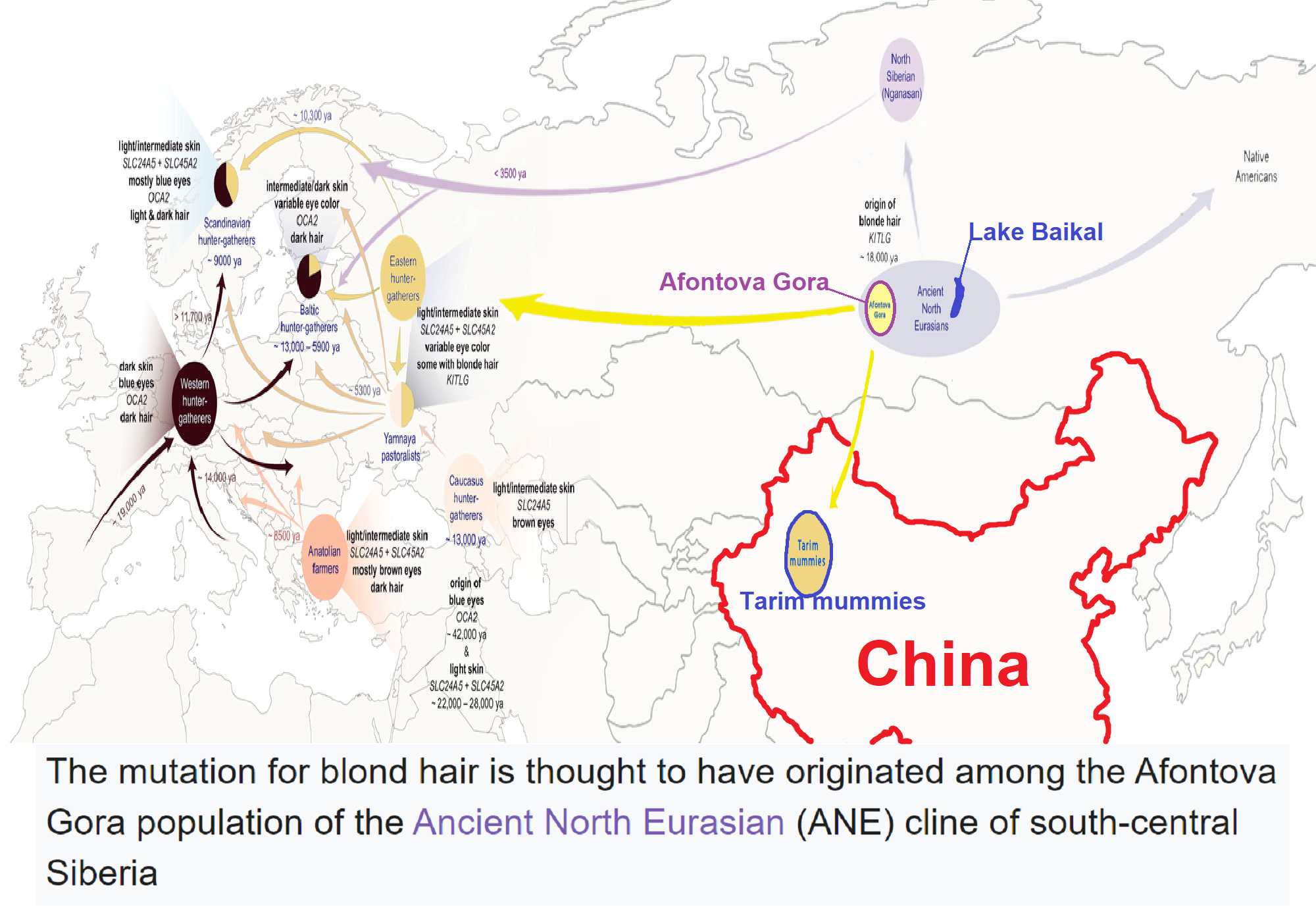
“The mutation for blond hair is thought to have originated among the Afontova Gora population of the Ancient North Eurasian (ANE) cline of south-central Siberia. Phenotypic analysis shows that Afontova Gora 3 carries the derived rs12821256 allele associated with, and likely causal for, blond hair color, making Afontova Gora 3 the earliest individual known to carry this derived allele. The allele was found in three later members of the largely ANE-derived Eastern Hunter-Gatherers populations from Samara, Motala, and Ukraine c. 10,000 years ago, suggesting that it originated in the Ancient North Eurasian population before spreading to western Eurasia. The hundreds of millions of copies of this mutated alelle (a single-nucleotide polymorphism) are at the root of the classic European blond hair mutation, as massive population migrations from the Eurasian steppe, by a people who had substantial Ancient North Eurasian ancestry, entered continental Europe.” ref
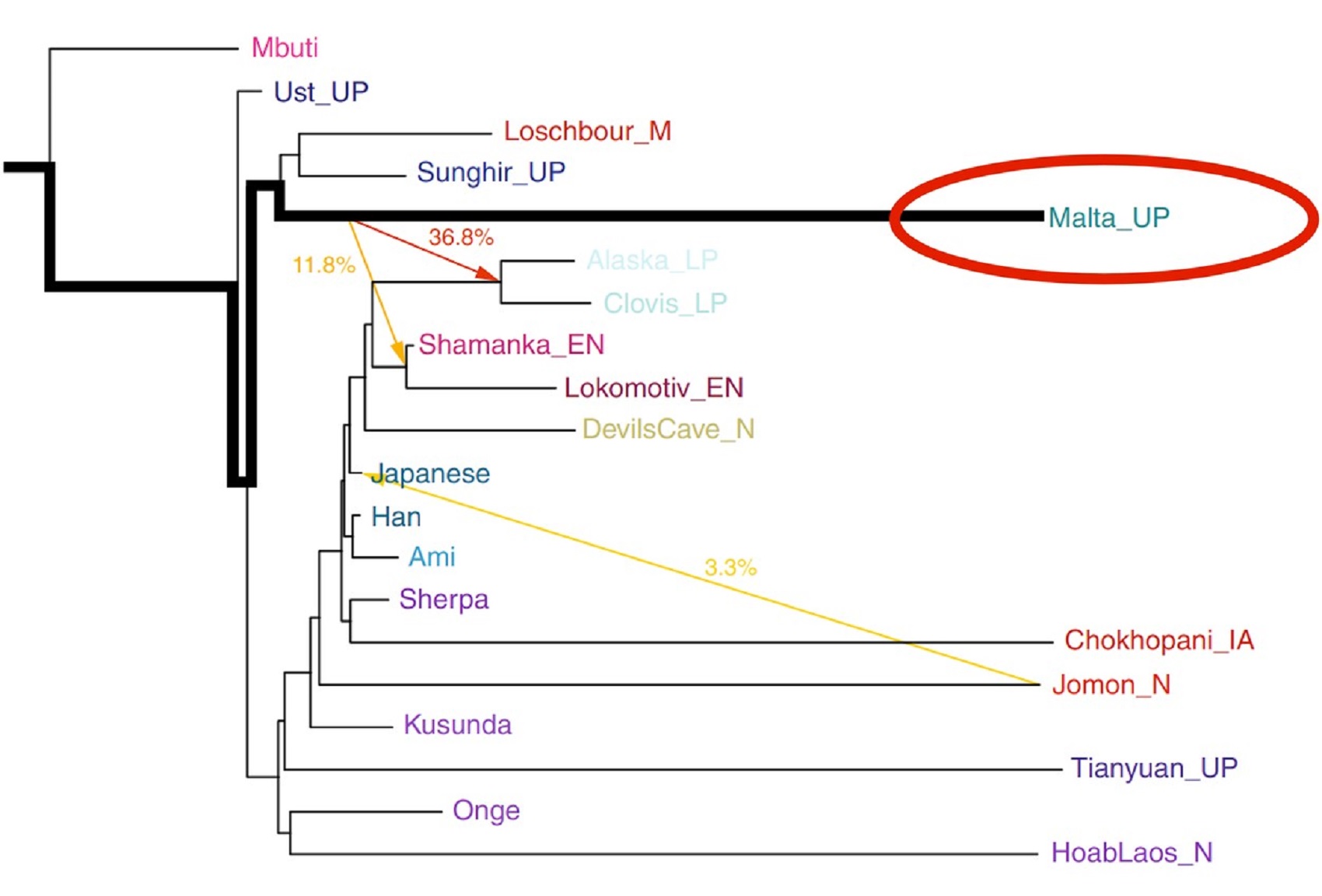

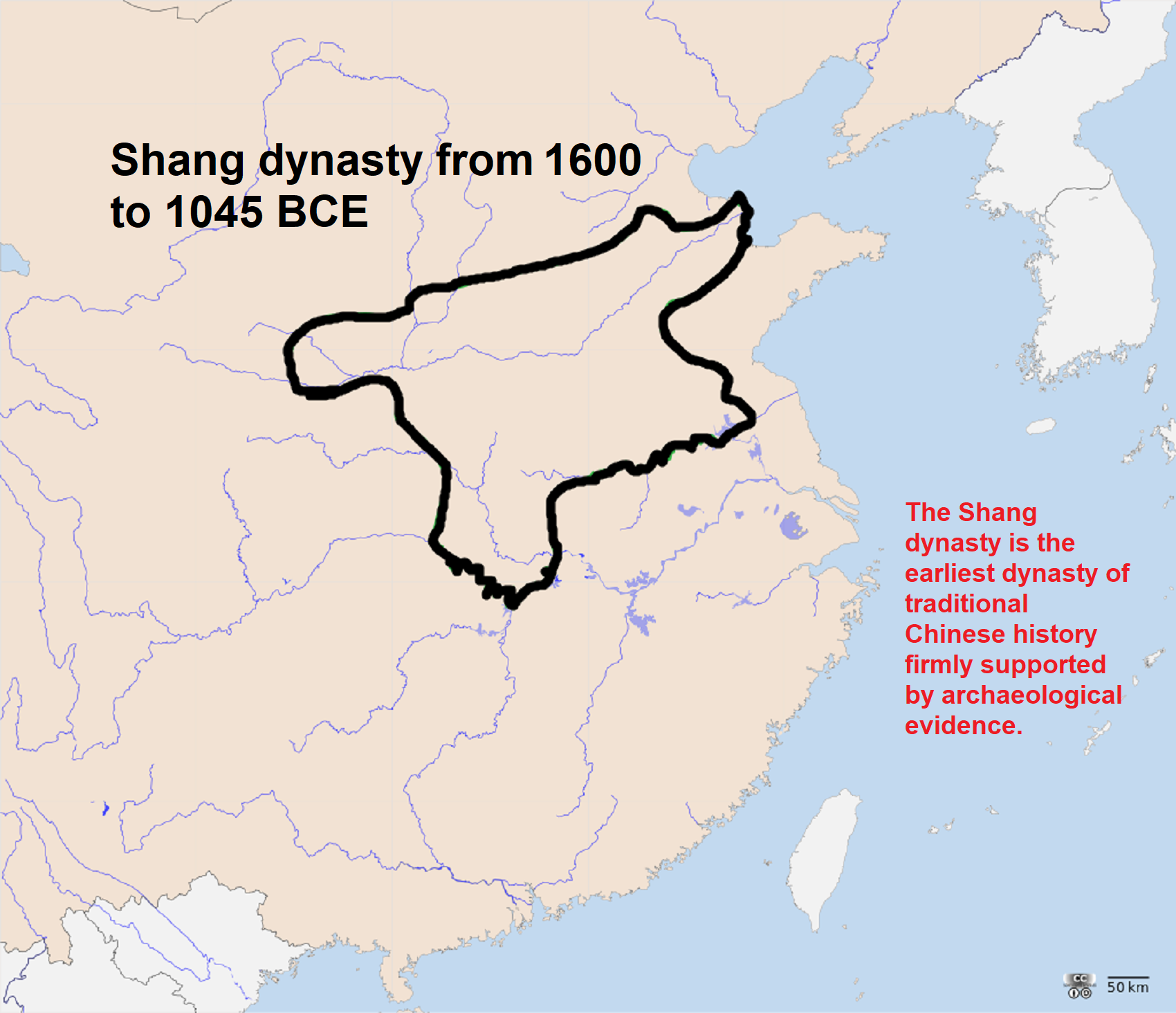
“The Shang dynasty from 1,600 to 1,045 BCE or around 3,600 to 3,045 years ago. The Shang dynasty also known as the Yin dynasty, was a Chinese royal dynasty founded by Tang of Shang (Cheng Tang) that ruled in the Yellow River valley in the second millennium BC, traditionally succeeding the Xia dynasty and followed by the Western Zhou dynasty. The classic account of the Shang comes from texts such as the Book of Documents, Bamboo Annals and Records of the Grand Historian. According to the traditional chronology based on calculations made approximately 2,000 years ago by Liu Xin, the Shang ruled from 1766 to 1122 BC, but most recent scholarship has preferred the 16th to 11th centuries BCE. The Shang dynasty is the earliest dynasty of traditional Chinese history firmly supported by archaeological evidence. Excavation at the Ruins of Yin (near modern-day Anyang), which has been identified as the last Shang capital, uncovered eleven major royal tombs and the foundations of palaces and ritual sites, containing weapons of war and remains from both animal and human sacrifices. Tens of thousands of bronze, jade, stone, bone, and ceramic artifacts have been found.” ref
“The Anyang site has yielded the earliest known body of Chinese writing, mostly divinations inscribed on oracle bones – turtle shells, ox scapulae, or other bones. More than 20,000 were discovered in the initial scientific excavations during the 1920s and 1930s, and over four times as many have been found since. The inscriptions provide critical insight into many topics from the politics, economy, and religious practices to the art and medicine of this early stage of Chinese civilization. Many events concerning the Shang dynasty are mentioned in various Chinese classics, including the Book of Documents, the Mencius, and the Zuo Zhuan. Working from all the available documents, the Han dynasty historian Sima Qian assembled a sequential account of the Shang dynasty as part of his Records of the Grand Historian. His history describes some events in detail, while in other cases only the name of a king is given. A closely related, but slightly different, account is given by the Bamboo Annals. The Annals were interred in 296 BCE, but the text has a complex history, and the authenticity of the surviving versions is controversial.” ref
“The name Yīn (殷) is used by Sima Qian for the dynasty, and in the “current text” version of the Bamboo Annals for both the dynasty and its final capital. It has been a popular name for the Shang throughout history. Since the Records of Emperors and Kings by Huangfu Mi (3rd century AD), it has often been used specifically to describe the later half of the Shang dynasty. In Japan, Korea, and Vietnam, the Shang are still referred to almost exclusively as the Yin (In, Eun, and Ân, respectively for Japan, Korea, and Vietnam) dynasty. However, it seems to have been a Zhou name for the earlier dynasty. The word does not appear in the oracle bones, which refer to the state as Shāng (商), and the capital as Dàyì Shāng (大邑商 “Great Settlement Shang”). It also does not appear in securely dated Western Zhou bronze inscriptions. The founding myth of the Shang dynasty is described by Sima Qian in the Annals of the Yin. In the text, a woman named Jiandi (簡狄), who was the second wife of Emperor Ku, swallowed an egg dropped by a black bird (玄鳥) and subsequently gave birth miraculously to Xie (偰) – also appearing as Qi (契). Xie is said to have helped Yu the Great to control the Great Flood and for his service to have been granted a place called Shang as a fief.” ref
“In the Annals of the Yin, Sima Qian writes that the dynasty was founded 13 generations after Xie, when Xie’s descendant Tang overthrew the impious and cruel final Xia ruler in the Battle of Mingtiao. The Records of the Grand Historian recount events from the reigns of Tang, Tai Jia, Tai Wu, Pan Geng, Wu Ding, Wu Yi and the depraved final king Di Xin, but the rest of the Shang rulers are merely mentioned by name. In the last century, Wang Guowei demonstrated that the succession to the Shang throne matched the list of kings in Sima Qian’s Records of the Grand Historian. According to the Records of the Grand Historian, the Shang moved their capital five times, with the final move to Yin in the reign of Pan Geng inaugurating the golden age of the dynasty. Di Xin, the last Shang king, is said to have committed suicide after his army was defeated by Wu of Zhou. Legends say that his army and his equipped slaves betrayed him by joining the Zhou rebels in the decisive Battle of Muye. According to the Yi Zhou Shu and Mencius the battle was very bloody. The classic, Ming-era novel Fengshen Yanyi retells the story of the war between Shang and Zhou as a conflict with rival factions of gods supporting different sides in the war. After the Shang were defeated, King Wu allowed Di Xin’s son Wu Geng to rule the Shang as a vassal kingdom. However, Zhou Wu sent three of his brothers and an army to ensure that Wu Geng would not rebel. After Zhou Wu’s death, the Shang joined the Rebellion of the Three Guards against the Duke of Zhou, but the rebellion collapsed after three years, leaving Zhou in control of Shang territory.” ref
Show 6 “Ancient China” Ritual, Religion, Elites, Language, Slavery, Eunuchs, and Empires
Use time 35:54 to 1:06:25 https://www.youtube.com/watch?v=lz4EQ0iYDI4&t=413s
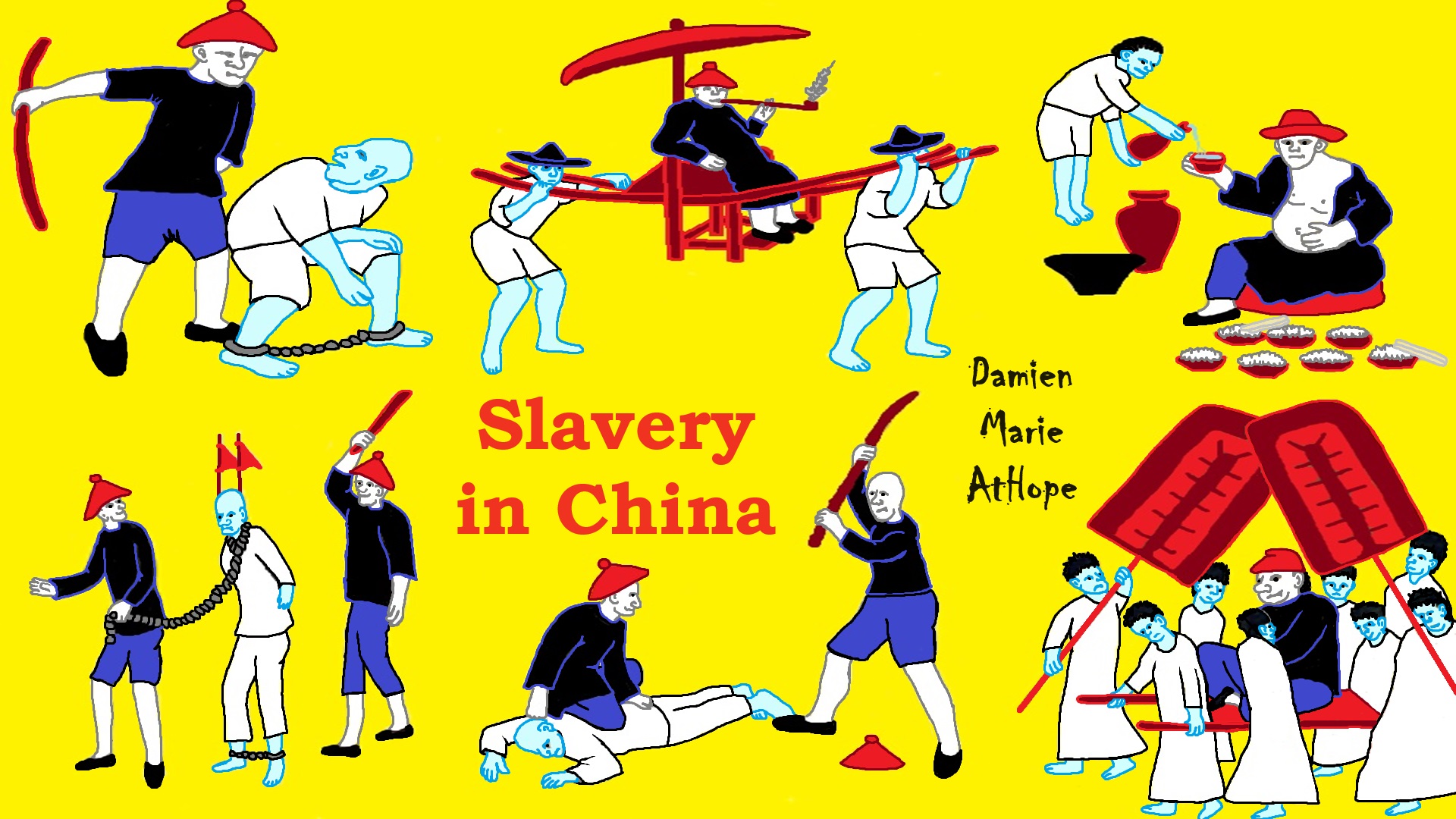
Slavery in China
“Slavery is the ownership of a person as property, especially in regards to their labor. Slavery typically involves compulsory work with the slave’s location of work and residence dictated by the party that holds them in bondage. Enslavement is the placement of a person into slavery. Many historical cases of enslavement occurred as a result of breaking the law, becoming indebted, suffering a military defeat, or exploitation for cheaper labor; other forms of slavery were instituted along demographic lines such as race or sex. Slaves may be kept in bondage for life, or for a fixed period of time after which they would be granted freedom. Although slavery is usually involuntary and involves coercion, there are also cases where people voluntarily enter into slavery to pay a debt or earn money due to poverty. In the course of human history, slavery was a typical feature of civilization, and was legal in most societies, but it is now outlawed in most countries of the world, except as a punishment for a crime.” ref
“In chattel slavery, the slave is legally rendered the personal property (chattel) of the slave owner. In economics, the term de facto slavery describes the conditions of unfree labor and forced labor that most slaves endure. As a social institution, chattel slavery classes slaves as chattels (personal property) owned by the enslaver; like livestock, they can be bought and sold at will. Chattel slavery was practiced in places such as the Roman Empire and classical Greece, where it was considered a keystone of society. Chattel slavery reached its modern extreme in the Americas during European colonization. Forced labor, or unfree labor, is sometimes used to describe an individual who is forced to work against their own will, under threat of violence or other punishment, but the generic term “unfree labor” is also used to describe chattel slavery, as well as any other situation in which a person is obliged to work against their own will, and a person’s ability to work productively is under the complete control of another person. This may also include institutions not commonly classified as slavery, such as serfdom, conscription, and penal labor.” ref
“Slaves have been owned privately by individuals but have also been under state ownership. Slavery predates written records and has existed in many cultures. Slavery is rare among hunter-gatherer populations because it requires economic surpluses and a substantial population density. Thus, although it has existed among unusually resource-rich hunter-gatherers, such as the American Indian peoples of the salmon-rich rivers of the Pacific Northwest coast, slavery became widespread only with the invention of agriculture during the Neolithic Revolution about 11,000 years ago. Slavery was practiced in almost every ancient civilization. Such institutions included debt bondage, punishment for crime, the enslavement of prisoners of war, child abandonment, and the enslavement of slaves’ offspring.” ref
“Slavery existed in ancient China as early as the Shang dynasty. Slavery was employed largely by governments as a means of maintaining a public labor force. Many Han Chinese were enslaved in the process of the Mongol invasion of China proper. According to Japanese historians Sugiyama Masaaki (杉山正明) and Funada Yoshiyuki (舩田善之), Mongolian slaves were owned by Han Chinese during the Yuan dynasty. Slavery has taken various forms throughout China’s history. It was reportedly abolished as a legally recognized institution, including in a 1909 law fully enacted in 1910, although the practice continued until at least 1949. The Tang dynasty purchased Western slaves from the Radhanite Jews. Tang Chinese soldiers and pirates enslaved Koreans, Turks, Persians, Indonesians, and people from Inner Mongolia, central Asia, and northern India. The greatest source of slaves came from southern tribes, including Thais and aboriginals from the southern provinces of Fujian, Guangdong, Guangxi, and Guizhou. Malays, Khmers, Indians, and “black-skinned” peoples (who were either Austronesian Negritos of Southeast Asia and the Pacific Islands, or Africans, or both) were also purchased as slaves in the Tang dynasty. In the 17th century Qing Dynasty, there was a hereditarily servile people called Booi Aha (Manchu: booi niyalma; Chinese transliteration: 包衣阿哈), which is a Manchu word literally translated as “household person” and sometimes rendered as “nucai.” ref
“The Manchu was establishing a close personal and paternalist relationship between masters and their slaves, as Nurhachi said, “The Master should love the slaves and eat the same food as him”. However, booi aha “did not correspond exactly to the Chinese category of “bond-servant slave” (Chinese:奴僕); instead, it was a relationship of personal dependency on a master which in theory guaranteed close personal relationships and equal treatment, even though many western scholars would directly translate “booi” as “bond-servant” (some of the “booi” even had their own servant). Chinese Muslim (Tungans) Sufis who were charged with practicing xiejiao (heterodox religion), were punished by exile to Xinjiang and being sold as a slave to other Muslims, such as the Sufi begs. Han Chinese who committed crimes such as those dealing with opium became slaves to the begs, this practice was administered by Qing law. Most Chinese in Altishahr were exile slaves to Turkestani Begs. While free Chinese merchants generally did not engage in relationships with East Turkestani women, some of the Chinese slaves belonging to begs, along with Green Standard soldiers, Bannermen, and Manchus, engaged in affairs with the East Turkestani women that were serious in nature.” ref
“In Chinese society, slaves were grouped under a category of people known as the jianmin, which means “base” or “mean”. Direct equivalents of chattel slavery did not exist in ancient China. During the Shang dynasty and Zhou dynasty, slaves generally consisted of war captives or criminals, although peasants lived in a similar condition of perpetual servitude and were unable to leave their land or own it. Some people deliberately became slaves to escape imperial taxation, but they were still considered to be higher in status than traditional slaves, and inhabited a position somewhere between a slave and a commoner.” ref
“From the Qin dynasty to Tang dynasty, slavery expanded beyond criminals and war captives. The Qin used large scale slave labor for public works such as land reclamation, road construction, and canal building. Slavery declined during the economic boom of the Song dynasty in the 12th century. Advances in fertilizer, hydraulic, and agricultural technologies allowed the plantation of commercial crops such as medical herbs, mulberry, and cotton. The small land to population ratio enticed slaves to run away and seek better employment. During the Mongol-led Yuan dynasty and Manchu-led Qing dynasty, slavery of Chinese increased. These Chinese slaves to Mongols or Manchus were called bondsmen and became personal retainers of their imperial overlords. Some attained high positions and led other Chinese slaves. In the 19th century, due to concerted efforts to end the African slave trade, large numbers of Chinese laborers known as coolies were exported to replace slave labor. They were transported in cargo ships with conditions and practices nearly identical to the former African slave trade. Visitors to late 19th century China found little difference between the poor free and the slaves, both of which were treated as hired laborers.” ref
“A handful of emperors and officials throughout Chinese history have made efforts to limit or outlaw slavery. None were successful. In 100 BCE, the Confucian scholar Dong Zhongshu advised Emperor Wu of Han to limit the amount of land and slaves that people could own. In 9 CE, Wang Mang ordered the nationalization of large estates and their redistribution to farmers. Part of his reform was changing the institution of slavery so that they would become tax payers, since some impoverished farmers sold themselves or their children into slavery. In the 13th century CE, the jurist Ma Duanlin promulgated a policy limiting the number of slaves owned by officials and commoners to 30. In the 14th century, the Hongwu Emperor ordered an end to all slavery, but in practice, slavery continued without heed to his commands. In the 18th century, the Yongzheng Emperor made similar attempts to abolish slavery. In 1909, the Qing officially abolished slavery, but due to internal turmoil and its demise, the institution persisted until 1949 when the People’s Republic of China was founded.” ref
“The Shang dynasty engaged in frequent raids of surrounding states, obtaining captives who would be killed in ritual sacrifices. Scholars disagree as to whether these victims were also used as a source of slave labor. The Warring States period (475–221 BCE) saw a decline in slavery from previous centuries, although it was still widespread during the period. Since the introduction of private ownership of land in the state of Lu in 594 BCE, which brought a system of taxation on private land, and saw the emergence of a system of landlords and peasants, the system of slavery began to later decline over the following centuries, as other states followed suit. The Qin dynasty (221–206 BCE) confiscated property and enslaved families as punishment. Large numbers of slaves were used by the Qin government to construct large-scale infrastructure projects, including road building, canal construction, and land reclamation. Slave labor was quite extensive during this period.” ref
“Beginning with the Han dynasty (206 BCE – 220 CE), one of Emperor Gao‘s first acts was to manumit agricultural workers enslaved during the Warring States period, although domestic servants retained their status. The Han dynasty promulgated laws to limit the possession of slaves: each king or duke was allowed a maximum of 200 slaves, an imperial princess was allowed a maximum of 100 slaves, other officials were limited to 30 slaves each. Men punished with castration during the Han dynasty were also used as slave labor. Deriving from earlier Legalist laws, the Han dynasty set in place rules penalizing criminals doing three years of hard labor or sentenced to castration by having their families seized and kept as property by the government. In the year CE 9, the Emperor Wang Mang (r. 9–23 CE) usurped the Chinese throne and, to deprive landowning families of their power, instituted a series of sweeping reforms, including the abolition of slavery and radical land reform. Slavery was reinstated in AD 12 before his assassination in CE 23.” ref
Eunuchs in China
“A eunuch is a castrated man. The earliest records for intentional castration to produce eunuchs are from the Sumerian city of Lagash in the 2nd millennium BCE or around 4,000 years ago. Over the millennia since, they have performed a wide variety of functions in many different cultures: courtiers or equivalent domestics, for espionage or clandestine operations, castrato singers, concubines or sexual partners, religious specialists, soldiers, royal guards, government officials, and guardians of women or harem servants. Eunuchs would usually be servants or slaves who had been castrated to make them less threatening servants of a royal court where physical access to the ruler could wield great influence. Castration has had a social function in history. In China, castration included the removal of the penis and the testicles (emasculation). A knife removed both organs at the same time.” ref, ref
“Eunuchs have existed in China since about 146 CE, during the reign of Emperor Huan of Han, and were common as civil servants by the Qing dynasty. From ancient times to the Sui dynasty, castration was a traditional punishment (one of the Five Punishments) and a means of gaining employment in the imperial service. Some eunuchs, such as the Ming dynasty official Zheng He, gained power that superseded that of the Grand Secretaries. Self-castration was not uncommon, although it was not always performed thoroughly and was later banned. Eunuchs were employed as high-ranking civil servants because they could not have children, so they were not tempted to seize power and begin a dynasty. They were also used to guard the Emperors wives and concubines. In addition, many in the palace considered eunuchs more reliable than scholar-officials. Finally, as a symbolic assignment of divine authority in the palace system, a constellation of stars was designated as the emperor’s; west of the constellation, four stars were known as his “eunuchs.” ref
“The tension between eunuchs in the service of the emperor and virtuous Confucian officials is a familiar theme in Chinese history. In his History of Government, Samuel Finer writes that reality often needs to be clearly defined. The emperor valued capable eunuchs as advisers, and resistance from “virtuous” officials often stemmed from jealousy. Ray Huang says that eunuchs represented the personal will of the Emperor, and the officials represented the political will of the bureaucracy; a clash between them would have been a clash of ideologies or political agendas. The number of eunuchs in imperial employment fell to 470 by 1912. The Chinese government abolished the eunuch system on November 5, 1924. The last imperial eunuch, Sun Yaoting, died in December 1996.” ref
Qin (221–206 BCE) and Han dynasties (202 BCE–9 CE, 25–220 CE)
“Men sentenced to castration became eunuch slaves of the Qin dynasty, performing forced labor for projects such as the Terracotta Army. The Qin government confiscated the property and enslaved and castrated the families of rapists as punishment. In Han dynasty China, references to castration were gōngxíng (宮刑 “palace punishment”) or fǔxíng (腐刑 “rotting punishment”), and euphemistically as being “sent to the silkworm house,” referring to the new castrate’s confinement in a room (like a silkworm) to prevent infection and death. In addition, punished castrated men during the Han dynasty were used for slave labor.” ref
“Notable men castrated under Han law included:
- Historian Sima Qian was charged with dissent and castrated.
- Emperor Wu ordered the castration of a prince of Loulan Kingdom Xinjiang as punishment for breaking a law.
- Zhang He, the older brother of Zhang Anshi, had been sentenced to death but was castrated when his brother pleaded for a commuted castration sentence.
- Li Yannian suffered punishment by castration for a crime.
- Envoy Ge Du (Ke Too) was castrated for not killing the “Mad King” of the Wusun, instead helping the king by supplying doctors to cure his illness.
- Su Wen suffered castration for supporting prince Liu Fuling and his mother, Lady Zhao, against Liu Ju (crown prince of Wei) and his mother, Wei Zifu.” ref
“Near the end of the Han dynasty in 189, a group of eunuchs known as the Ten Attendants gained considerable power in the imperial court; several warlords planned their murder to restore the emperor’s government. The loyalist warlord He Jin was lured into a trap in the palace and killed by the eunuchs. The other warlords, led by Yuan Shao, stormed the court and massacred the Ten Attendants and many other eunuchs. In the wake of the fighting, Dong Zhuo seized power. Castration was abolished twice as a punishment under the Han dynasty: before 167 BCE, then during the 110s CE.” ref
Northern Wei (386–535 CE) and Northern Qi (550–577 CE) dynasties
“In 446 CE, the Northern Wei crushed an ethnic Qiang rebellion. Wang Yu was a castrated Qiang eunuch who may have undergone castration during the uprising as the Northern Wei frequently castrated elite young Qiang. He was born in the town of Lirun, in Fengyi prefecture (present-day Chengcheng County). Wang Yu, a Buddhist, had a temple built at his birthplace in 488. The Northern Wei had the young sons of rebels and traitors castrated, forcing them to serve in the palace as eunuchs. Notable survivors of this practice include Liu Siyi (Liu Ssu-i), Yuwen Zhou (Yü-wen Chou 宇文冑), Duan Ba, Wang Zhi, Liu Teng, and Sun Shao. The Northern Qi Gao Huan had Shu Lüè castrated and made a messenger eunuch because his father, Fan Guan (Fan Kuan 樊觀), remained loyal to the Northern Wei. The Northern Wei presented northern wives to Liu Song generals Cui Mo and Shen Mo. Shen Mo had a son, Lingdu, and fled back south to Liu Song; in retaliation, the Northern Wei castrated Lingdu. Cui Mo never returned south, and his northern son escaped punishment. The eunuch Zong Ai killed two Northern Wei emperors and a prince. The Empress Dowager Hu (Northern Qi) mourned for the eunuch Meng Luan. She reportedly engaged in sexual relations with her eunuchs; traditional historians used the term xiexia (褻狎, “immoral games”), rather than “adultery”, to describe her acts with them.” ref
Sui (581–618 CE) and Tang dynasties (618–907 CE)
“Indigenous people from southern China endured castration for use as eunuchs during the Sui and Tang dynasties. For example, the rebel An Lushan had a Khitan (Liao) eunuch named Li Zhu’er (李豬兒) (Li Chu’er) when he was a teenager. Lushan used a sword to cut off Zhu’er’s genitals, nearly killing him from blood loss and reviving him after putting ashes on his injury. Zhu’er then served Lushan for life and was highly trusted by him, frequently aiding the obese Lushan at home and in the Huaqing (Hua-ch’ing) steam baths. Lushan developed a skin disease and became blind and paranoid later in life, which prompted him to flog and murder his subordinates. Lushan’s enemies convinced Zhu’er and Yan Zhuang (Yen Chuang) (嚴莊) to assassinate him, and Zhu’er disemboweled Lushan.” ref
Liao (916–1125 CE), Jin (1115–1234 CE), and Yuan (1271–1368 CE) dynasties
“The Liao, Jin, and Yuan dynasties regularly castrated enemy prisoners of war under age 10, forcing them to serve royalty or esteemed citizens. As a result, the war created many opportunities for men and women to kidnap the young sons of enemy combatants and elite civilians. Khitan (Liao) women would fight beside men in combat, and these women took advantage of the number of captured young prisoners of war to fill their palaces with prepubescent eunuchs. These young eunuchs were domestic enslaved people, frequently serving harems of royal women, titled ladies of the court, and concubines, and had no political or social power. The Khitans captured Chinese eunuchs at the Jin court after their Later Jin invasion. Their war with the Song dynasty helped the Khitans to create more eunuchs. The Khitan Empress Dowager Chengtian led a raid on China and captured 100 young (under age 10), attractive Han Chinese boys to make into eunuchs. One of these eunuchs was Wang Ji’en (王继恩 (辽朝)); another was Zhao Anren (赵安仁). Notable Jin dynasty eunuchs were Liang Chong (梁珫) and Song Gui (宋珪). Like the dynasties which rose and fell before theirs, the Khitans enacted an ordinance permitting castration in 962 after the rape of a footsoldier’s young daughter during the reign of Emperor Muzong of Liao. The rapist (an uncle of an imperial consort) was castrated and enslaved to his victim for life. Like the Mongol Empire, Goryeo (Korea) provided eunuchs to the Mongols; they included Bak Bulhwa, Go Yongbo, and Bang Sinu. Some eunuchs adopted Mongol names.” ref
Ming dynasty (1368–1644)
“Castration became a banned legal punishment at the end of Ming Taizu‘s reign, the first Ming emperor, who reigned over eunuchs from Mongolian, Korea, Vietnamese, Cambodian, Central Asian, Thai, and Okinawan tribes. There were also Korean, Jurchen, Mongolian, Central Asian, and Vietnamese eunuchs under the Yongle Emperor, including Mongol eunuchs who served him when he was the Prince of Yan. Muslim and Mongol eunuchs were in the Ming court, such as those captured from Mongol-controlled Yunnan in 1381; among them was the Ming maritime explorer Zheng He, who served Yongle. The Ming court sent Muslim eunuchs as ambassadors to the Timurids. Vietnamese eunuchs, including Ruan Lang, Ruan An (Nguyễn An), Fan Hong, Chen Wu, and Wang Jin, were sent by Zhang Fu. Korea sent 198 eunuchs, many from Southeast Asia and Korea, to Ming Taizu before ending human tribute in 1435. By the late Ming dynasty, nearly 80 percent of eunuchs came from North China (primarily the Beijing region).” ref
Violence in surrounding countries
“Ming Taizu had a contentious relationship with the Korean Joseon dynasty, often competing for influence over the Jurchens in Manchuria. Korean-born Ming eunuch ambassadors flogged Korean officials due to their unmet demands. Ambassadors were sometimes arrogant; in 1398, a drunk Sin Kwi-Saeng brandished a knife in the king’s presence at dinner. Sino-Korean relations later became amiable, and the Korean envoy’s seat at the Ming court was the highest of the tributaries. The Jurchen eunuch explorer Yishiha lived during the Yongle emperor’s reign. During the Miao rebellions, the Ming governor castrated thousands of Miao boys and gave them to officials as enslaved people; however, Emperor Yingzong of Ming reprimanded him. Prince Zhu Shuang had several Tibetan boys castrated, and Tibetan women seized after a war against the Tibetans. He was a denounced prince after his death. During the Lê dynasty, Vietnamese emperor Lê Thánh Tông cracked down on foreign contacts and enforced isolationism. His policies affected trade between Guangdong (Leizhou Peninsula and Hainan) and Vietnam, with accounts of captured Chinese sailors blown off course being captured and castrated to become slaves of the Vietnamese. Malay envoys from the Malacca Sultanate were attacked and captured in 1469 by the Vietnamese navy as they returned to Malacca from China. The Vietnamese enslaved and castrated the young captives.” ref
“A 1499 entry in the Ming Shilu reported that during the 1460s, under the Chenghua Emperor (1464–1487 AD), 13 Chinese men from Wenchang (including Wu Rui) were captured by the Vietnamese after their ship was blown off course from Hainan to Guangdong‘s Qin subprefecture (Qinzhou) and landed near the coast of Vietnam. The Emperor enslaved 12 of the 13 sailors as agricultural laborers; the youngest Chinese man, Wu Rui (吳瑞), was selected by the Vietnamese court for castration and became a eunuch at the Imperial Citadel of Thang Long for nearly 25 years. After the death of Lê Thánh Tông in 1497, Wu Rui became a military superintendent in northern Vietnam. An Lạng Sơn guard told him about a route back to China, and Rui escaped to Longzhou after walking for nine days through the mountains. Local ethnic minority Tusi chief Wei Chen took him into custody, overruling objections from his family (who wanted to return him to Vietnam). Learning about his escape and fearing that he would reveal Vietnamese state secrets, officials sent an agent to repurchase Rui from Wei Chen. An argument about price began; Pingxiang magistrate Li Guangning rescued Rui and sent him to Beijing to serve in the Ming palace.” ref
“In 1467, a similar entry in the Đại Việt sử ký toàn thư reports that a Chinese ship blew onshore in the An Bang province of Dai Viet (present-day Quảng Ninh Province). Lê Thánh Tông ordered the Chinese to be detained and not allowed to return to China. Historians Leo K. Shin, John K. Whitmore, and Tana Li suggest that these accounts of sailors blown off course and being captured and castrated may point to Chinese involvement in illegal trade, which the Vietnamese government suppressed. Rumors about the Ming Zhengde Emperor‘s possible conversion to Islam abounded after he encouraged his Muslim eunuchs to commission the production of porcelain with blue-and-white inscriptions in Persian and Arabic. Suspicion grew when the emperor was associated with an anti-pig-slaughter mandate, although the author of the proclamation is unknown. Muslim eunuchs contributed money in 1496 to repair the Niujie Mosque, the largest mosque and Muslim cultural center in Beijing, and the emperor’s association with his Muslim eunuchs triggered gossip.” ref
“The emperor employed nearly 70,000 eunuchs by the end of the Ming dynasty, with some serving in the imperial palace. The dynasty’s eunuch population peaked at 100,000. In popular cultural texts, such as Zhang Yingyu’s The Book of Swindles (c. 1617), eunuchs were described negatively and accused of enriching themselves with excessive taxation and indulging in cannibalism and sexual debauchery. The Southern Ming Yongli emperor‘s wife, Empress Wang, had a young eunuch enslaved person who later wrote an account detailing his childhood in Huguang province’s Jingzhou prefecture. First, the eunuch writes that rebels killed his parents; one of the rebels adopted him, who later became a Southern Ming soldier. Then, in 1656, the Southern Ming court ordered high-ranking military officers to give up their sons over the age of seven years for castration in Kunming (Yunnan Fu) and enslavement in the Yongli court. Over 20 boys were castrated one month after the order, including Empress Wang’s slave (despite his adoptive father’s attempts to save him). Wang Ruoshue and Pang Tianshou were eunuchs in Zhu Youlang’s court.” ref
Imperial eunuchs
“In Ming China, eunuchs were a cornerstone of daily operations in the imperial palace. First and foremost was maintaining a comfortable life for the emperor. Their other responsibilities varied in significance, encompassing almost every aspect of the palace routine. They included procuring copper, tin, wood, and iron and repairing and constructing ponds, castle gates, and palaces in major cities like Beijing and Nanjing and the mansions and mausoleums of imperial relatives. Eunuchs prepared meals for many people and cared for pets and wild animals in and around the palace. They worked closely with other professionals in the palace, frequently associating with those in lower-ranking occupations. In addition, some eunuchs had supportive partnerships with serving women in the palace; the name for such a pair was a “vegetarian couple” (duishi). The relationships offered security and protection to both parties, enabling them to interact with higher-ranking Mandarin bureaucrats. The duties of eunuchs evolved. The Hongwu Emperor decreed that a few uneducated eunuchs should be kept (to prevent them from seizing power). Still, later emperors began to train and educate eunuchs and often made them their secretaries. The elimination of previous restrictions allowed some eunuchs (particularly Wang Zhen, Liu Jin, and Wei Zhongxian) to attain great power. The Yongle Emperor established the Eastern Depot, a spy and secret police agency run by eunuchs from 1420 to 1644. Zheng He was a seafaring pioneer who spread Chinese influence extensively.” ref
Reputation
“Eunuchs were controversial in Ming China as they had a reputation for spying. They served the harem and the emperors who believed they could carry valuable information. Fearful bureaucrat scholars thought of eunuchs as greedy, evil, cunning, and duplicitous because they worked in the palace or other official houses with many concubines. In Chinese society, castration broke conventional moral rules; a son without a male heir to carry on the family name contradicted Confucian ideology. Eunuchs in the palace were stereotyped as exceeding their authority in areas where they did not belong. The Yongle Emperor allowed them to supervise the implementation of political tasks, and eunuchs sometimes interfered in the succession to the throne. As their presence and power increased, they gradually took over the duties of female palace musicians and became the dominant Ming palace musicians.” ref
Qing dynasty (1634-1912)
“Although eunuchs were employed by all Chinese dynasties, their opportunities declined during the Qing dynasty; their work was largely replaced by the Imperial Household Department, which had managed their employment since the reign of the Kangxi Emperor. The Qing palace tended to recruit eunuchs from Zhili who were primarily unmarried adolescent-to-mid-20s Han Chinese from northern Shandong and the counties of Wanping, Jinghai, Daxing, and Hejian in southern Hebei near Beijing. A small number of southern Chinese from Yunnan, Zhejiang, and Guangdong became eunuchs, but the increase was minor compared to the number of eunuchs from the counties around Beijing. In 1621, the Qing beile (princes) were erroneously told that their palace women would have sex with their young male slaves and were instructed to have the slaves castrated by Nurhaci. At the beginning of the 20th century, about 2,000 eunuchs worked in the Forbidden City; they were notorious for corruption and theft during the later dynasty after being routinely beaten and abused as slaves governed by a frequently hostile and violent emperor. Many men willingly became eunuchs because of poverty in China, also experiencing physical violence to live a better life. Puyi, the last emperor, wrote about growing up in the Forbidden City: “By the age of 11, flogging eunuchs was part of my daily routine. My cruelty and love of power were already too firmly set for persuasion to have any effect on me… Whenever I was in a bad temper the eunuchs would be in for trouble.” A yellow bag with bamboo sticks were kept in the Forbidden City, and Empress Dowager Cixi once ordered the palace servant girls and court women to beat the eunuchs with them. Eunuchs would be punished more unless they begged their mistress (or master) for mercy.” ref
Lin Shuangwen Rebellion and Aftermath
“A new policy of castrating rebels and the sons of killers of three or more related people helped bolster the dwindling supply of young eunuchs for the Qing summer palace. The Qing lowered their age limit for castrating the sons of rebels from nine to four years of age. The Qing Imperial Household Department sometimes waited until the boys were 11 years old before castrating them; two young, imprisoned sons of executed murderer Sui Bilong from Shandong were not castrated until they were older. However, the department immediately castrated 11-year-old, Hunanese Fang Mingzai after his father was executed for murder. One hundred thirty sons of participants in the Lin Shuangwen rebellion, aged four to fifteen, were castrated on the orders of the Qianlong Emperor and Heshen (including rebel leader Zhuang Datian’s four-year-old grandson, Zhuang Amo). The rebel leader Datian’s family and the family of Lin Da were punished for their participation in the rebellion. Lin Shuangwen ordered Lin Da to lead a group of 100 rebels, and titled him “General Xuanlue”. After the rebellion, Lin Da was executed by Lingchi at age 42. He had six sons; the two eldest died before the rebellion, his third son (Lin Dou) died of disease in Beijing before he could be castrated, and his fourth and fifth sons (11-year-old Lin Biao and 8-year-old Lin Xian) were castrated. His sixth and youngest son (seven-year-old Lin Mading) was adopted by his uncle, Lin Qin; since Lin Qin did not join the rebellion, Lin Mading was not castrated and had two children after marrying in 1800.” ref
Castration policy changes
“The Qing policy of castrating the sons of rebels and murderers with three or more victims was inspired by the 1781 case of an 18-year-old nephew of a rebel whose death sentence was commuted to castration. Castration for the sons of rebels and murderers was reintroduced by the Qing during the 18th century, after its abolition in the Tang and Ming dynasties. In 1793, Qianlong and the Imperial Household Department (under Heshen) decreed that the sons of murderers over age 16 would be exiled as slaves to the frontier after castration; sons under 16 would be kept as eunuchs in the imperial palace, in the belief that the younger sons could be controlled more easily.” ref
Young eunuchs used for intimate services
“Sir John Barrow, 1st Baronet noted on his visit to the Qing summer palace as part of the 1793 Macartney Mission that there were two types of Chinese eunuchs: those without testicles (who inspected and maintained buildings, gardens, and other palace works) and those (called rasibus by local Catholic missionaries) who had also had their penises and testicles – amputated. Barrow notes that the term “black eunuch” referred not to skin color but referenced the Ottoman Empire term for eunuchs who had their penis removed. These eunuchs served inside the palace, attending to the imperial harem. The young, emasculated eunuchs, considered nearly as coquettish as the women they served, often painted their faces like the imperial women. Barrow noted that all the Chinese eunuchs (including the rasibus) had female slaves, purchased from poor families who sold their daughters. The Qing court and the eunuchs, however, considered eunuchs male and not female or third sex. The 19th-century British researcher George Carter Stent and later historian Norman A. Kutcher observed that young eunuchs were prized by female members of the Qing imperial family as attendants. Both note that young eunuchs were physically attractive, considered “completely pure”, and were used for “impossible to describe” duties by female members of the imperial family. Kutcher suggests that the boys were used for sexual pleasure by Qing imperial women, likening them to other young eunuchs called “earrings” who were also used for that purpose. Young eunuchs were used for intimate bathroom and bedroom duties by palace ladies.” ref
“During the Qing dynasty, eunuchs satisfied women sexually through use of dildos, oral sex, or foreplay. Liang Zhangju (1775–1849) wrote in his “Wandering Talk” sketches that palace eunuchs performed oral sex on the women and caressed them until the women were sexually satisfied. Eunuchs used dildos and hormones to have a “dry-run orgasm with diminished sensation to reduce the effects of castration”, especially if they were past puberty when castrated. Eunuchs still had a sexual desire after castration but were sexually frustrated. The eunuch Zhang Delang engaged in sexual acts with a prostitute in Tianjin’s Japanese concession (where he lived after the fall of the Qing) and married three women. Yu Chunhe, a eunuch who worked for Delang, said he was “burning with fever and desire” as he watched Delang and the prostitute. Cixi (Tsu-Hsi) suggested that eunuch Xiao Dezhang (Hsiao Teh-chang) (Zhang Lande) become a sexual partner of the Longyu empress (Lung-yu), since the Guangxi emperor (Kuang Hsu) was impotent. Zhang Lande also had a love affair with Han banner woman Yu Roung Ling, a sister of Princess Der Ling. Sexual relations and marriage between eunuchs and palace maids was referred to as duishi.” ref
Eunuchs and Banner-women
“The Manchu palace maid Ronger (榮兒) (b. 1880) of the Manchu Hešeri clan wrote The Memoirs of a Palace Maid, an autobiography about her experiences as a Qing palace maid. She retired from service at age 18 and was married to Liu, a Han Chinese eunuch given to her by the Dowager Empress Cixi and an adopted son of eunuch Liu Lianying. Ronger writes that Qing court rules required that all court eunuchs must be Han Chinese and not from the Eight Banners (administrative and military divisions in the Later Jin and Qing dynasties into which all Manchu households were placed). All palace maids had to be Manchu Banner-women from the three Upper Banners and were required to “stay ten years at the palace to wait upon Her Majesty, and then they are free to marry”. Han girls were not allowed to be palace maids unless their Han Banner-man father was a high official of the sixth rank or higher, and Han fathers were not required to send their daughters to serve.” ref
End of the dynasty
“The Qing dynasty ended after the 1911 Revolution. Puyi (the last Qing emperor) continued to live in the Forbidden City with his eunuchs with financial support from the new Chinese republic until 1924 when he and his entourage were expelled by the warlord general Feng Yuxiang. In 1923, after a fire that Puyi believed was started to cover the theft of his imperial treasures, he expelled the eunuchs from the Forbidden City.” ref
China’s History of Human Sacrifice
“Human sacrifice is the act of killing one or more humans as part of a ritual, which is usually intended to please or appease gods, a human ruler, public or jurisdictional demands for justice by capital punishment, an authoritative/priestly figure or spirits of dead ancestors or as a retainer sacrifice, wherein a monarch’s servants are killed in order for them to continue to serve their master in the next life. Closely related practices found in some tribal societies are cannibalism and headhunting. Human sacrifice was practiced in many human societies beginning in prehistoric times. By the Iron Age (1st millennium BCE), with the associated developments in religion (the Axial Age), human sacrifice was becoming less common throughout Africa, Europe, and Asia, and came to be looked down upon as barbaric during classical antiquity. In the Americas, however, human sacrifice continued to be practiced, by some, to varying degrees until the European colonization of the Americas. Today, human sacrifice has become extremely rare. Modern secular laws treat human sacrifices as tantamount to murder. Most major religions in the modern day condemn the practice. For example, the Hebrew Bible prohibits murder and human sacrifice to Moloch.” ref
“Human sacrifice (sometimes called ritual murder), has been practiced on a number of different occasions and in many different cultures. The various rationales behind human sacrifice are the same that motivate religious sacrifice in general. Human sacrifice is typically intended to bring good fortune and to pacify the gods, for example in the context of the dedication of a completed building like a temple or bridge. Fertility was another common theme in ancient religious sacrifices, such as sacrifices to the Aztec god of agriculture Xipe Totec. In ancient Japan, legends talk about hitobashira (“human pillar”), in which maidens were buried alive at the base of or near some constructions to protect the buildings against disasters or enemy attacks, and almost identical accounts appear in the Balkans (The Building of Skadar and Bridge of Arta). For the re-consecration of the Great Pyramid of Tenochtitlan in 1487, the Aztecs reported that they killed about 80,400 prisoners over the course of four days. According to Ross Hassig, author of Aztec Warfare, “between 10,000 and 80,400 persons” were sacrificed in the ceremony.” ref
“Human sacrifice can also have the intention of winning the gods’ favor in warfare. In Homeric legend, Iphigeneia was to be sacrificed by her father Agamemnon to appease Artemis so she would allow the Greeks to wage the Trojan War. In some notions of an afterlife, the deceased will benefit from victims killed at his funeral. Mongols, Scythians, early Egyptians, and various Mesoamerican chiefs could take most of their household, including servants and concubines, with them to the next world. This is sometimes called a “retainer sacrifice”, as the leader’s retainers would be sacrificed along with their master, so that they could continue to serve him in the afterlife. Another purpose is divination from the body parts of the victim. According to Strabo, Celts stabbed a victim with a sword and divined the future from his death spasms. Headhunting is the practice of taking the head of a killed adversary, for ceremonial or magical purposes, or for reasons of prestige. It was found in many pre-modern tribal societies. Successful agricultural cities had already emerged in the Near East by the Neolithic, some protected behind stone walls. Jericho is the best known of these cities but other similar settlements existed along the coast of Levant extending north into Asia Minor and west to the Tigris and Euphrates rivers. Most of the land was arid and the religious culture of the entire region centered on fertility and rain. Many of the religious rituals, including human sacrifice, had an agricultural focus. Blood was mixed with soil to improve its fertility.” ref
“Human sacrifice may be a ritual practiced in a stable society, and may even be conducive to enhance societal unity (see: Sociology of religion), both by creating a bond unifying the sacrificing community, and in combining human sacrifice and capital punishment, by removing individuals that have a negative effect on societal stability (criminals, religious heretics, foreign slaves or prisoners of war). However, outside of civil religion, human sacrifice may also result in outbursts of blood frenzy and mass killings that destabilize society. Many cultures show traces of prehistoric human sacrifice in their mythologies and religious texts, but ceased the practice before the onset of historical records. Some see the story of Abraham and Isaac (Genesis 22) as an example of an etiological myth, explaining the abolition of human sacrifice. The Vedic Purushamedha (literally “human sacrifice”) is already a purely symbolic act in its earliest attestation. According to Pliny the Elder, human sacrifice in ancient Rome was abolished by a senatorial decree in 97 BCE, although by this time the practice had already become so rare that the decree was mostly a symbolic act. Human sacrifice once abolished is typically replaced by either animal sacrifice, or by the mock-sacrifice of effigies, such as the Argei in ancient Rome.” ref
“The history of human sacrifice in China may extend as early as 2300 BCE or around 4,300 years ago. Excavations of the ancient fortress city of Shimao in the northern part of modern Shaanxi province revealed 80 skulls ritually buried underneath the city’s eastern wall. Forensic analysis indicates the victims were all teenage girls. The ancient Chinese are known to have made drowned sacrifices of men and women to the river god Hebo. They also have buried slaves alive with their owners upon death as part of a funeral service. This was especially prevalent during the Shang and Zhou dynasties. During the Warring States period, Ximen Bao of Wei outlawed human sacrificial practices to the river god. In Chinese lore, Ximen Bao is regarded as a folk hero who pointed out the absurdity of human sacrifice. The sacrifice of a high-ranking male’s slaves, concubines, or servants upon his death (called Xun Zang 殉葬 or Sheng Xun 生殉) was a more common form. The stated purpose was to provide companionship for the dead in the afterlife. In earlier times, the victims were either killed or buried alive, while later they were usually forced to commit suicide.” ref
“Funeral human sacrifice was widely practiced in the ancient Chinese state of Qin. According to the Records of the Grand Historian by Han dynasty historian Sima Qian, the practice was started by Duke Wu, the tenth ruler of Qin, who had 66 people buried with him in 678 BCE. The 14th ruler Duke Mu had 177 people buried with him in 621 BCE, including three senior government officials. Afterward, the people of Qin wrote the famous poem Yellow Bird to condemn this barbaric practice, later compiled in the Confucian Classic of Poetry. The tomb of the 18th ruler Duke Jing of Qin, who died in 537 BCE, has been excavated. More than 180 coffins containing the remains of 186 victims were found in the tomb. The practice would continue until Duke Xian of Qin (424–362 BCE) abolished it in 384 BCE. Modern historian Ma Feibai considers the significance of Duke Xian’s abolition of human sacrifice in Chinese history comparable to that of Abraham Lincoln‘s abolition of slavery in American history.” ref
“After the abolition by Duke Xian, funeral human sacrifice became relatively rare throughout the central parts of China. However, the Hongwu Emperor of the Ming dynasty revived it in 1395, following the Mongolian Yuan precedent, when his second son died and two of the prince’s concubines were sacrificed. In 1464, the Tianshun Emperor, in his will, forbade the practice for Ming emperors and princes. Human sacrifice was also practiced by the Manchus. Following Nurhaci’s death, his wife, Lady Abahai, and his two lesser consorts committed suicide. During the Qing dynasty, the sacrifice of slaves was banned by the Kangxi Emperor in 1673.” ref
How China’s history of human sacrifice led to Ching Ming Festival’s paper offerings
“Health concerns aside, burning joss paper to honor the dead is much better than what came before – commoners were buried with domesticated animals while the upper classes were entombed with the bodies of their wives, concubines, and slaves.” ref
“The Qingming festival or Ching Ming Festival, also known as Tomb-Sweeping Day in English (sometimes also called Chinese Memorial Day, Ancestors’ Day, the Clear Brightness Festival, or the Pure Brightness Festival), is a traditional Chinese festival observed by ethnic Chinese in mainland China, Hong Kong, Macau, Taiwan, Malaysia, Singapore, Cambodia, Indonesia, Philippines, Thailand, and Vietnam. A celebration of spring, it falls on the first day of the fifth solar term (also called Qingming) of the traditional Chinese lunisolar calendar. This makes it the 15th day after the Spring Equinox, either 4, 5 or 6 April in a given year. During Qingming, Chinese families visit the tombs of their ancestors to clean the gravesites and make ritual offerings to their ancestors. Offerings would typically include traditional food dishes and the burning of joss sticks and joss paper. The holiday recognizes the traditional reverence of one’s ancestors in Chinese culture. The origins of the Qingming Festival go back more than 2500 years, although the observance has changed significantly. It became a public holiday in mainland China in 2008, where it is associated with the consumption of qingtuan, green dumplings made of glutinous rice, and Chinese mugwort or barley grass. In Taiwan, the public holiday was in the past observed on 5 April to honor the death of Chiang Kai-shek on that day in 1975, but with Chiang’s popularity waning, this convention is not being observed. A confection called caozaiguo or shuchuguo, made with Jersey cudweed, is consumed there. A similar holiday is observed in the Ryukyu Islands, called Shīmī in the local language.” ref
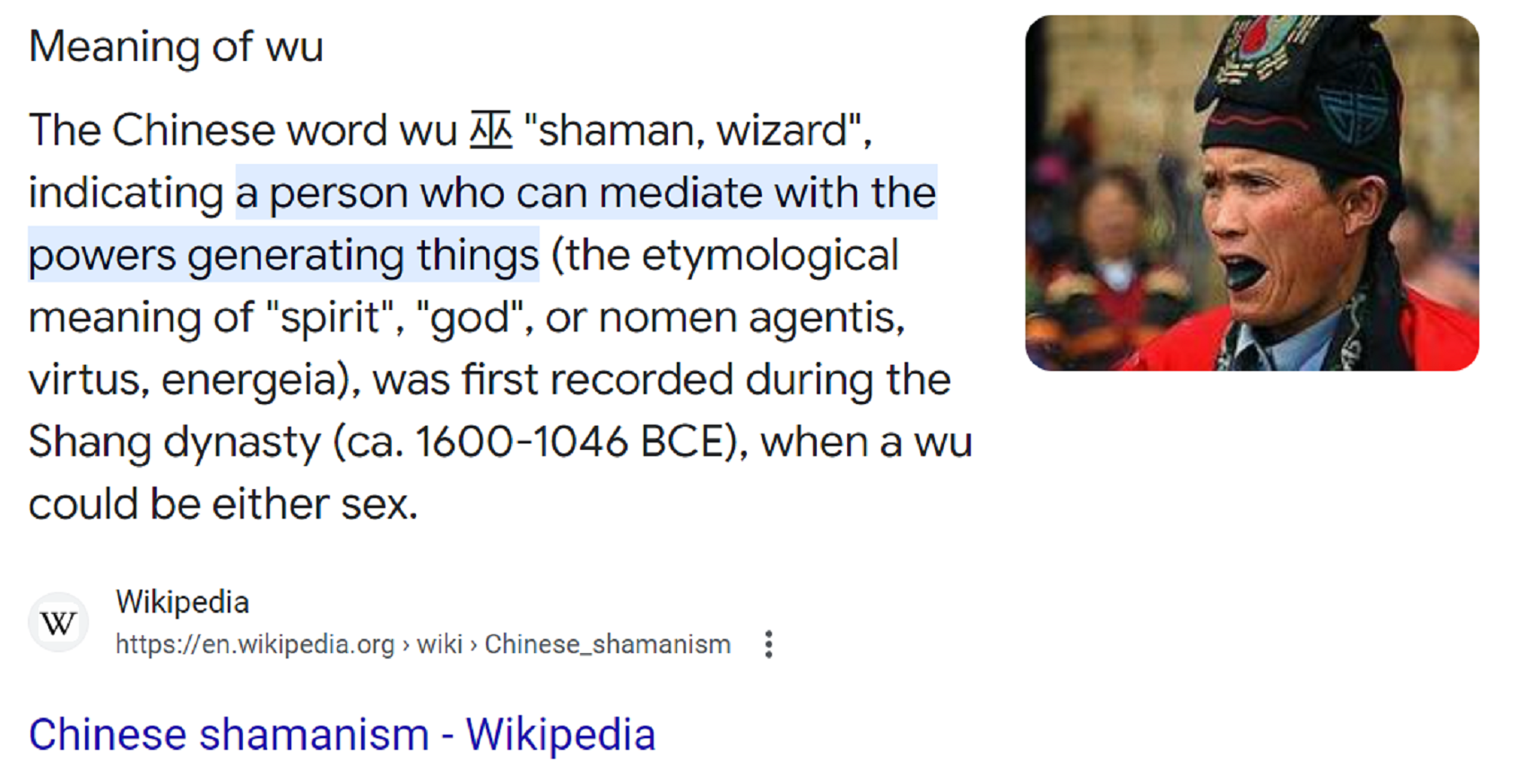
Wu (shaman)
“Wu (Chinese: 巫; pinyin: wū; Wade–Giles: wu) is a Chinese term translating to “shaman” or “sorcerer”, originally the practitioners of Chinese shamanism or “Wuism” (巫教 wū jiào). Chinese shamanism, alternatively called Wuism (Chinese: 巫教; pinyin: wū jiào; lit. ‘wu religion, shamanism, witchcraft‘; alternatively 巫觋宗教 wū xí zōngjiào), refers to the shamanic religious tradition of China. Its features are especially connected to the ancient Neolithic cultures such as the Hongshan culture. Chinese shamanic traditions are intrinsic to Chinese folk religion. Various ritual traditions are rooted in original Chinese shamanism: contemporary Chinese ritual masters are sometimes identified as wu by outsiders, though most orders don’t self-identify as such. Also, Taoism has some of its origins from Chinese shamanism: it developed around the pursuit of long life (shou 壽/寿), or the status of a xian (仙, “mountain man”, “holy man”). The glyph ancestral to modern 巫 is first recorded in bronze script, where it could refer to shamans or sorcerers of either sex. By the late Zhou Dynasty (4th to 3rd centuries BCE), wu referred mostly to female shamans or “sorceresses”, while male sorcerers were named xi 覡 “male shaman; sorcerer”, first attested in the Guoyu or Discourses of the States (4th century BCE). Other sex-differentiated shaman names include nanwu 男巫 for “male shaman; sorcerer; wizard”; and nüwu 女巫, wunü 巫女, wupo 巫婆, and wuyu 巫嫗 for “female shaman; sorceress; witch”. Wu is used in compounds like wugu 巫蠱 “sorcery; cast harmful spells”, wushen 巫神 or shenwu 神巫 (with shen “spirit; god”) “wizard; sorcerer”, and wuxian 巫仙 (with xian “immortal; alchemist”) “immortal shaman”. The word tongji 童乩 (lit. “youth diviner”) “shaman; spirit-medium” is a near-synonym of wu. Chinese uses phonetic transliteration to distinguish native wu from “Siberian shaman“: saman 薩滿 or saman 薩蠻. “Shaman” is occasionally written with Chinese Buddhist transcriptions of Shramana “wandering monk; ascetic”: shamen 沙門, sangmen 桑門, or sangmen 喪門.” ref, ref
Xirang “Chinese” Earth-diver Creation Myths?
“The earth-diver is a common character in various traditional creation myths. In these stories, a supreme being usually sends an animal (most often a type of bird, but also crustaceans, insects, and fish in some narratives) into the primal waters to find bits of sand or mud with which to build habitable land. Some scholars interpret these myths psychologically, while others interpret them cosmogonically. In both cases, emphasis is placed on beginnings emanating from the depths.” ref
“Xirang was a magical soil in Chinese mythology with the ability to self-expand and grow continuously. Its properties made it particularly effective for use by Gun and Yu the Great in fighting the rising waters of the Great Flood. This Chinese word compounds xí 息 “breathe; cease; rest; grow; multiply” and rǎng 壤 “soil; earth”. Noting similarities with earth-diver creation myths, Anne Birrell translates xirang as “self-renewing soil”, and compares other translations of “breathing earth” (Wolfram Eberhard), “swelling mold” (Derk Bodde), “idle soil” (Roger Greatrex), and “living earth” or “breathing earth” (Rémi Mathieu).” ref
“In some versions of the myths, Gun stole the xirang from the Shangdi, who sent the deity Zhu Rong to execute him in punishment, on Feather Mountain. According to some accounts, Yu, on the other hand, went up to Heaven. After begging Shangdi, he received from him a gift of as much xirang as his magical black tortoise could carry on its back, thus allowing Yu to successfully block up the 233,559 springs, the sources of the flood waters. In other versions of these myths, xirang was stolen or obtained from the Primordial Divinity, or Gun’s executioner was other than Zhu Rong.” ref
“A historical basis has been suggested for both the Great Flood and for xirang. Sinologist David Hawkes proposes that the myths are a symbolic interpretation of a societal transition. In this case, Gun represents a society at an earlier technological stage, which engages in small-scale agriculture which involves raising areas of arable land sufficiently above the level of the marshes. The “magically-expanding” xirang soil may represent a type of friable raised garden, made up of soil, brushwood, and similar materials. Yu and his work in controlling the flood would symbolize a later type of society, which allowed a much larger scale approach to transforming wetlands to arable fields.” ref
“A less mythical explanation could be sought in various forms of expansive clay. Generally impervious to water, clays are useful in creating the core of earthen dams. Expansive clays, in particular, slowly expand when wetted, thus matching the “swelling” translation. When dried, they take on a puffy “popcorn” look, which could be interpreted as “breathing” or airy. Such clays are abundant in the Shaanxi Province where many of these events are thought to have occurred. The xirang mythology has interesting parallels to the mythologies of the indigenous peoples of the Americas, particularly the earth-diver creation myth. In the earth-diver myth, the primordial waters cover all, until after overcoming great perils, a certain creature is able to dive down into the waters and retrieve a small bit of magical soil. This xirang-like soil then magically expands into the land areas of today.” ref
GUN AND YU: REVISITING THE CHINESE “EARTH-DIVER” HYPOTHESIS
“Flood-taming is always seen as the main plot of the Gun and Yu myth in Chinese classics. A recent argument treats the archetype of this flood=taming myth cycle cosmogonic, i.e., the “earth-diver” or “earth-scooper” myth. However, this hypothesis is not well grounded. Although it finds solutions to some questions, its limitations are yet obvious. As an important part of Chinese ancient myth cycle, flood-taming stories of Gun and Yu were well documented in numerous classics. While some episodes are regarded as supernatural myths, some are categorized as historical legends. In terms of historiography, the former type with supernatural elements is generally thought to occur earlier than the latter. That is to say, the image of Gun and Yu as kings derives from their initial image as deities. This perspective, valid or not, nevertheless, does not change the fact that these stories primarily center on flood-taming, seemingly irrelevant to earth creation.” ref
“However, some mythologists hold that the archetype of this flood-taming myth cycle is a cosmogonic myth, namely the so-called “earthdiver” myth. For example, Ye Shuxian asserts that “the flood-taming myth is actually the second earth creation, i.e., the transformed endless-mud-based ‘earth-diver’ myth, whose protagonists are Gun, Yu and the Supreme God” (Ye 338). To avoid ambiguity of the term “earth-diver” in Chinese, Hu Wanchuan, a chief advocator of the “earth-diver” hypothesis, renamed it the “earth-scooper” myth. Either way, the aforementioned hypothesis has in recent years greatly influenced mythological studies, whereas some of its premises do call for further analyses. In 1965, based on the “earth-diver” mythic materials prevailing in East Europe, North Asia, Southeast Asia, India, and North America,
Japanese Scholar Obayashi Taryo employs methodologies of comparative mythology to reach the assumption that the plot of Gun stealing the endless mud from the Supreme God was a former hunting peoples’ “earth-diver” myth, which was influenced by the agricultural peoples’ motif: disobeying the will of God and stealing valuable things for human beings” (Obayashi 51–2).” ref
“Obayashi gives the following example as an Altaic “earth-diver” myth: At the birth of the earth, there was no ground, but water. God and the first man (or the devil ) hovered over the primeval ocean in the forms of two wild geese. Then, God asked the man to fetch some soil from the bottom of the ocean. After he had done that, God scattered the soil on the surface of water and commanded: “The Earth! You should have the shape!” And then, God asked the man to fetch some more soil. However, this time, to save some soil to create his own world, the man handed in only one handful of soil and swallowed the rest. In the meantime, the soil scattered by God became larger and harder on the surface of water. Along with the growth of the Cosmo, the size of the earth lump in the man’s mouth was dramatically increasing as well, almost making him suffocate.” ref
“So he had to turn to God for help. God interrogated him, and the first man confessed his sin and threw up the soil, which was the origin of the marsh. (Obayashi 51) At first glance, the above “earth-diver” myth is rather different from the flood-taming myth of Gun and Yu. Nevertheless, Obayashi tries to bring out the connection between them by providing two evidences. First, geographically, the “earth-diver” myth prevails in most of China’s neighboring areas, which makes it highly probable that China shares the same kind of myth; second, the soil scooped from the water multiplied itself and became the earth, exactly the same as the endless mud in the Gun and Yu myth cycle. Thus, according to Obayashi, the
Gun and Yu flood-taming myth is a Chinese conversion or variation of the “earth-diver” myth. Moreover, inspired by the Native Americans’ “earth-diver” myths, Ye claims that the flood-taming myth and the “earth-diver” myth share the same external structure. In his opinion, although there.” ref
Earth-diver Creation Myth Motif distribution
“According to Gudmund Hatt and Tristram P. Coffin, Earth-diver myths are common in Native American folklore, among the following populations: Shoshone, Meskwaki, Blackfoot, Chipewyan, Newettee, Yokuts of California, Mandan, Hidatsa, Cheyenne, Arapaho, Ojibwe, Yuchi, and Cherokee. American anthropologist Gladys Reichard located the distribution of the motif across “all parts of North America”, save for “the extreme north, northeast, and southwest”. The pattern of distribution of these stories suggests they have a common origin in the eastern Asiatic coastal region, spreading as peoples migrated west into Siberia and east to the North American continent. However, there are examples of this mytheme found well outside of this boreal distribution pattern, for example, the West African Yoruba creation myth of Ọbatala and Oduduwa.” ref
“In a 1977 study, anthropologist Victor Barnouw surmised that the earth-diver motif appeared in “hunting-gathering societies,” mainly among northerly groups such as the Hare, Dogrib, Kaska, Beaver, Carrier, Chipewyan, Sarsi, Cree, and Montagnais. Similar tales are also found among the Chukchi and Yukaghir, the Tatars, and many Finno-Ugric traditions, as well as among the Buryat and the Samoyed. In addition, the earth-diver motif also exists in narratives from Eastern Europe, namely Romani, Romanian, Slavic (namely, Bulgarian, Polish, Ukrainian, and Belarusian), and Lithuanian mythological traditions.” ref
Native American Earth-diver Creation Myth narrative
“Characteristic of many Native American myths, earth-diver creation stories begin as beings and potential forms linger asleep or suspended in the primordial realm. The earth-diver is among the first of them to awaken and lay the necessary groundwork by building suitable lands where the coming creation will be able to live. In many cases, these stories will describe a series of failed attempts to make land before the solution is found. Among the indigenous peoples of the Americas, the earth-diver cosmogony is attested in Iroquois mythology: a female sky deity falls from the heavens, and certain animals, the beaver, the otter, the duck, and the muskrat dive in the waters to fetch mud to construct an island.” ref
“In a similar story from the Seneca, people lived in a sky realm. One day, the chief’s daughter was afflicted with a mysterious illness, and the only cure recommended for her (revealed in a dream) was to lie beside a tree and to have it be dug up. The people do so, but a man complains that the tree was their livelihood, and kicks the girl through the hole. She ends up falling from the sky to a world of only water, but is rescued by waterfowl. A turtle offers to bear her on its shell, but asked where would be a definitive dwelling place for her. They decide to create land, and the toad dives into the depths of the primal sea to get pieces of soil. The toad puts it on the turtle’s back, which grows larger with every deposit of soil.” ref
“In another version from the Wyandot, the Wyandot lived in heaven. The daughter of the Big Chief (or Mighty Ruler) was sick, so the medicine man recommends that they dig up the wild apple tree that stands next to the Lodge of the Mighty Ruler, because the remedy is to be found on its roots. However, as the tree has been dug out, the ground begins to sink away, and the treetops catch and carry down the sick daughter with it. As the girl falls from the skies, two swans rescue her on their backs. The birds decide to summon all the Swimmers and the Water Tribes. Many volunteer to dive into the Great Water to fetch bits of earth from the bottom of the sea, but only the toad (female, in the story) is the one successful.” ref
Chinese “Pan Gu” and Creation?
“Pangu (Chinese: 盤古, PAN-koo) is a primordial being and creation figure in Chinese mythology and Taoism who separated heaven and earth, and his body later became geographic features such as mountains and roaring water. The first writer to record the myth of Pangu was thought to be Xu Zheng during the Three Kingdoms period. However, his name was found in a tomb predating the Three Kingdoms period. The Pangu myth appears to have been preceded in ancient Chinese literature by the existence of Shangdi or Taiyi (of the Taiyi Shengshui). Other Chinese myths, such as those of Nüwa and the Jade Emperor, try to explain how people were created, and do not necessarily explain the creation of the world. There are many variations of these myths.” ref
“Pan Gu, central figure in Chinese Daoist legends of creation. Pan Gu, the first man, is said to have come forth from chaos (an egg) with two horns, two tusks, and a hairy body. Some accounts credit him with the separation of heaven and earth, setting the sun, moon, stars, and planets in place, and dividing the four seas. He shaped the earth by chiselling out valleys and stacking up mountains. All this was accomplished from Pan Gu’s knowledge of yinyang, the inescapable principle of duality in all things.” ref
“Another legend asserts that the universe derived from Pan Gu’s gigantic corpse. His eyes became the sun and moon, his blood formed rivers, his hair grew into trees and plants, his sweat turned to rivers, and his body became soil. The human race, moreover, evolved from parasites that infested Pan Gu’s body. These creation myths date from the 3rd to the 6th century. Artistic representations frequently depict Pan Gu as a dwarf clothed with leaves.” ref
“Three main elements describe the origin of the Pangu myth. The first is that the story is indigenous and was developed or transmitted through time to Xu Zheng. Senior Scholar Wei Juxian states that the Pangu story is derived from stories during the Western Zhou Dynasty. He cites the story of Zhong (重) and Li (黎) in the “Chuyu (楚語)” section of the ancient classics Guoyu. In it, King Zhao of Chu asked Guanshefu (觀射父) a question: “What did the ancient classic “Zhou Shu (周書)” mean by the sentence that Zhong and Li caused the heaven and earth to disconnect from each other?” The “Zhou Shu” sentence he refers to is about an earlier person, Luu Xing (呂刑), who converses with King Mu of Zhou. King Mu’s reign is much earlier and dates to about 1001 to 946 BC. In their conversation, they discuss a “disconnection” between heaven and earth. Derk Bodde linked the myth to the ancestral mythologies of the Miao people and Yao people in southern China.” ref
“This is how Professor Qin Naichang (覃乃昌), head of the Guangxi Institute for Nationality Studies, reconstructs the true creation myth preceding the myth of Pangu. Note that it is not actually a creation myth:
A brother and his sister became the only survivors of the prehistoric Deluge by crouching in a gourd that floated on water. The two got married afterwards, and a mass of flesh in the shape of a whetstone was born. They chopped it and the pieces turned into large crowds of people, who began to reproduce again. The couple were named ‘Pan’ and ‘Gou’ in the Zhuang ethnic language, which stand for whetstone and gourd respectively.” ref
“19th-century comparative religion scholar Paul Carus writes:
P’an-Gu: The basic idea of the yih philosophy was so convincing that it almost obliterated the Taoist cosmology of P’an-Ku who is said to have chiseled the world out of the rocks of eternity. Though the legend is not held in high honor by the literati, it contains some features of interest which have not as yet been pointed out and deserve at least an incidental comment.
P’an-Gu is written in two ways: one means in literal translations, “basin ancient”, the other “basin solid”. Both are homophones, i.e., they are pronounced the same way; and the former may be preferred as the original and correct spelling. Obviously the name means “aboriginal abyss,” or in the terser German, Urgrund, and we have reason to believe it to be a translation of the Babylonian Tiamat, “the Deep.”
The Chinese legend tells us that P’an-Ku’s bones changed to rocks; his flesh to earth; his marrow, teeth and nails to metals; his hair to herbs and trees; his veins to rivers; his breath to wind; and his four limbs became pillars marking the four corners of the world, which is a Chinese version not only of the Norse myth of the Giant Ymir, but also of the Babylonian story of Tiamat.
Illustrations of P’an-Ku represent him in the company of supernatural animals that symbolize old age or immortality, viz., the tortoise and the crane; sometimes also the dragon, the emblem of power, and the phoenix, the emblem of bliss.
When the earth had thus been shaped from the body of P’an-Ku, we are told that three great rivers successively governed the world: first the celestial, then the terrestrial, and finally the human sovereign. They were followed by Yung-Ch’eng and Sui -Jen (i.e., fire-man) the later being the Chinese Prometheus, who brought the fire down from heaven and taught man its various uses.
The Prometheus myth is not indigenous to Greece, where it received the artistically classical form under which it is best known to us. The name, which by an ingenious afterthought is explained as “the fore thinker,” is originally the Sanskrit pramantha and means “twirler” or “fire-stick,” being the rod of hard wood which produced fire by rapid rotation in a piece of soft wood.
We cannot deny that the myth must have been known also in Mesopotamia, the main center of civilization between India and Greece, and it becomes probable that the figure Sui-Jen has been derived from the same prototype as the Greek Prometheus.” ref
“The missionary and translator James Legge discusses Pangu:
P’an-ku is spoken of by the common people as “the first man, who opened up heaven and earth.” It has been said to me in “pidgin” English that “he is all the same your Adam”; and in Taoist picture books I have seen him as a shaggy, dwarfish, Hercules, developing from a bear rather than an ape, and wielding an immense hammer and chisel with which he is breaking the chaotic rocks.” ref
“In the beginning, there was nothing, and the universe was in a featureless, formless primordial state. This primordial state coalesced into a cosmic egg for about 18,000 years. Within it, the perfectly opposed principles of yin and yang became balanced, and Pangu emerged (or woke up) from the egg. Pangu inside the cosmic egg symbolizes Taiji. Pangu is usually depicted as a primitive, hairy giant who has horns on his head. Pangu began creating the world: he separated yin from yang with a swing of his giant axe, creating the earth (murky yin) and the sky (clear yang). To keep them separated, Pangu stood between them and pushed up the sky. With each day, the sky grew ten feet (3 meters) higher, the earth ten feet thicker, and Pangu ten feet taller. This task took yet another 18,000 years.” ref
“In some versions of the story, Pangu is aided in this task by the Four Holy Beasts (四靈獸), the Turtle, the Qilin, the Phoenix, and the Dragon. In others, Pangu separated heaven and earth, which were already yin and yang, with his axe. After the 18,000 years had elapsed, Pangu died. His breath became the wind, mist and clouds; his voice, thunder; his left eye, the Sun; his right eye, the Moon; his head, the mountains and extremes of the world; his blood, rivers; his muscles, fertile land; his facial hair, the stars and Milky Way; his fur, bushes and forests; his bones, valuable minerals; his bone marrow, precious jewels; his sweat, rain; and the fleas on his fur carried by the wind became animals. In other versions of the story, his body turned into the mountains.” ref
“According to Bouyei mythology, after Pangu became an expert in rice farming after creating the world, he married the daughter of the Dragon King, and their union gave rise to the Buyei people. This is celebrated by the Bouyei people on June 6, as a holiday. Pangu is worshipped at a number of shrines in contemporary China, usually with Taoist symbols, such as the Bagua. The daughter of the Dragon King and Pangu had a son named Xinheng (新横). When Xinheng disrespected his mother, she returned to heaven and never came down, despite the repeated pleas of her husband and son. Pangu was forced to remarry and eventually died on the sixth day of the sixth month of the lunar calendar.” ref
“Xinheng’s stepmother treated him badly and almost killed him. When Xinheng threatened to destroy her rice harvest, she realized her mistake. She made peace with him, and they went on to pay their respects to Pangu annually on the sixth day of the sixth month of the lunar calendar. This day became an important traditional Buyei holiday for ancestral worship. This legend of creation is one of the main characteristics that distinguishes the Buyei from the Zhuang. The Pangu King Temple (盤古皇廟 or 盘古皇庙) built in 1809 is located in Guangdong Province, northwest Huadu District (west of G106 / north of S118), north of Shiling Town at the foot of the Pangu King Mountain.” ref


People don’t commonly teach religious history, even that of their own claimed religion. No, rather they teach a limited “pro their religion” history of their religion from a religious perspective favorable to the religion of choice.

Do you truly think “Religious Belief” is only a matter of some personal choice?
Do you not see how coercive one’s world of choice is limited to the obvious hereditary belief, in most religious choices available to the child of religious parents or caregivers? Religion is more commonly like a family, culture, society, etc. available belief that limits the belief choices of the child and that is when “Religious Belief” is not only a matter of some personal choice and when it becomes hereditary faith, not because of the quality of its alleged facts or proposed truths but because everyone else important to the child believes similarly so they do as well simply mimicking authority beliefs handed to them. Because children are raised in religion rather than being presented all possible choices but rather one limited dogmatic brand of “Religious Belief” where children only have a choice of following the belief as instructed, and then personally claim the faith hereditary belief seen in the confirming to the belief they have held themselves all their lives. This is obvious in statements asked and answered by children claiming a faith they barely understand but they do understand that their family believes “this or that” faith, so they feel obligated to believe it too. While I do agree that “Religious Belief” should only be a matter of some personal choice, it rarely is… End Hereditary Religion!

Animism: Respecting the Living World by Graham Harvey
“How have human cultures engaged with and thought about animals, plants, rocks, clouds, and other elements in their natural surroundings? Do animals and other natural objects have a spirit or soul? What is their relationship to humans? In this new study, Graham Harvey explores current and past animistic beliefs and practices of Native Americans, Maori, Aboriginal Australians, and eco-pagans. He considers the varieties of animism found in these cultures as well as their shared desire to live respectfully within larger natural communities. Drawing on his extensive casework, Harvey also considers the linguistic, performative, ecological, and activist implications of these different animisms.” ref

We are like believing machines we vacuum up ideas, like Velcro sticks to almost everything. We accumulate beliefs that we allow to negatively influence our lives, often without realizing it. Our willingness must be to alter skewed beliefs that impend our balance or reason, which allows us to achieve new positive thinking and accurate outcomes.

My thoughts on Religion Evolution with external links for more info:
- (Pre-Animism Africa mainly, but also Europe, and Asia at least 300,000 years ago), (Pre-Animism – Oxford Dictionaries)
- (Animism Africa around 100,000 years ago), (Animism – Britannica.com)
- (Totemism Europe around 50,000 years ago), (Totemism – Anthropology)
- (Shamanism Siberia around 30,000 years ago), (Shamanism – Britannica.com)
- (Paganism Turkey around 12,000 years ago), (Paganism – BBC Religion)
- (Progressed Organized Religion “Institutional Religion” Egypt around 5,000 years ago), (Ancient Egyptian Religion – Britannica.com)
- (CURRENT “World” RELIGIONS after 4,000 years ago) (Origin of Major Religions – Sacred Texts)
- (Early Atheistic Doubting at least by 2,600 years ago) (History of Atheism – Wikipedia)
“Religion is an Evolved Product” and Yes, Religion is Like Fear Given Wings…
Atheists talk about gods and religions for the same reason doctors talk about cancer, they are looking for a cure, or a firefighter talks about fires because they burn people and they care to stop them. We atheists too often feel a need to help the victims of mental slavery, held in the bondage that is the false beliefs of gods and the conspiracy theories of reality found in religions.
Understanding Religion Evolution:
- Pre-Animism (at least 300,000 years ago)
- Animism (Africa: 100,000 years ago)
- Totemism (Europe: 50,000 years ago)
- Shamanism (Siberia: 30,000 years ago)
- Paganism (Turkey: 12,000 years ago)
- Progressed organized religion (Egypt: 5,000 years ago), (Egypt, the First Dynasty 5,150 years ago)
- CURRENT “World” RELIGIONS (after 4,000 years ago)
- Early Atheistic Doubting (at least by 2,600 years ago)
“An Archaeological/Anthropological Understanding of Religion Evolution”
It seems ancient peoples had to survived amazing threats in a “dangerous universe (by superstition perceived as good and evil),” and human “immorality or imperfection of the soul” which was thought to affect the still living, leading to ancestor worship. This ancestor worship presumably led to the belief in supernatural beings, and then some of these were turned into the belief in gods. This feeble myth called gods were just a human conceived “made from nothing into something over and over, changing, again and again, taking on more as they evolve, all the while they are thought to be special,” but it is just supernatural animistic spirit-belief perceived as sacred.
Quick Evolution of Religion?
Pre-Animism (at least 300,000 years ago) pre-religion is a beginning that evolves into later Animism. So, Religion as we think of it, to me, all starts in a general way with Animism (Africa: 100,000 years ago) (theoretical belief in supernatural powers/spirits), then this is physically expressed in or with Totemism (Europe: 50,000 years ago) (theoretical belief in mythical relationship with powers/spirits through a totem item), which then enlists a full-time specific person to do this worship and believed interacting Shamanism (Siberia/Russia: 30,000 years ago) (theoretical belief in access and influence with spirits through ritual), and then there is the further employment of myths and gods added to all the above giving you Paganism (Turkey: 12,000 years ago) (often a lot more nature-based than most current top world religions, thus hinting to their close link to more ancient religious thinking it stems from). My hypothesis is expressed with an explanation of the building of a theatrical house (modern religions development). Progressed organized religion (Egypt: 5,000 years ago) with CURRENT “World” RELIGIONS (after 4,000 years ago).
Historically, in large city-state societies (such as Egypt or Iraq) starting around 5,000 years ago culminated to make religion something kind of new, a sociocultural-governmental-religious monarchy, where all or at least many of the people of such large city-state societies seem familiar with and committed to the existence of “religion” as the integrated life identity package of control dynamics with a fixed closed magical doctrine, but this juggernaut integrated religion identity package of Dogmatic-Propaganda certainly did not exist or if developed to an extent it was highly limited in most smaller prehistoric societies as they seem to lack most of the strong control dynamics with a fixed closed magical doctrine (magical beliefs could be at times be added or removed). Many people just want to see developed religious dynamics everywhere even if it is not. Instead, all that is found is largely fragments until the domestication of religion.
Religions, as we think of them today, are a new fad, even if they go back to around 6,000 years in the timeline of human existence, this amounts to almost nothing when seen in the long slow evolution of religion at least around 70,000 years ago with one of the oldest ritual worship. Stone Snake of South Africa: “first human worship” 70,000 years ago. This message of how religion and gods among them are clearly a man-made thing that was developed slowly as it was invented and then implemented peace by peace discrediting them all. Which seems to be a simple point some are just not grasping how devastating to any claims of truth when we can see the lie clearly in the archeological sites.
I wish people fought as hard for the actual values as they fight for the group/clan names political or otherwise they think support values. Every amount spent on war is theft to children in need of food or the homeless kept from shelter.
Here are several of my blog posts on history:
- To Find Truth You Must First Look
- Archaeology Knowledge Challenge?
- Beware of Pseudo-History like the Claims of a Hammer in a 400 Million-Year-Old Rock
- The Evolution of Fire Sacralizing and/or Worship 1.5 million to 300,000 years ago and beyond?
- Proto Religion: Superstition around 1 million years ago, to Pre-Animism 300,000 years ago, & then Animism Religion 100,000 years ago
- Stone Age Art: 500,000 – 233,000 Years Old
- Around 500,000 – 233,000 years ago, Oldest Anthropomorphic art (Pre-animism) is Related to Female
- 400,000 Years Old Sociocultural Evolution
- Burial-pits, Cave-tombs, and/or Shallow-graves begin with Homo
- The Emergence of Pre-Religion 300,000 years ago, with Pre-Animism?
- Pre-Animism: Portable Rock Art at least 300,000-year-old
- Pre-animism 300,000 years old and animism 100,000 years old: related to “Anarchism and Socialism”
- Prehistory: related to “Anarchism and Socialism” the division of labor, power, rights, and recourses.
- Homo Naledi and an Intentional Cemetery “Pre-Animism” dating to around 250,000 years ago?
- Neanderthals “Primal Religion (Pre-Animism/Animism?)” Mystery Cave Rings 175,000 Years Ago
- 130,000 years ago – Earliest evidence for burial and it’s Neanderthals…
- Did Neanderthals teach us “Primal Religion (Pre-Animism/Animism?)” 120,000 Years Ago?
- What about Neanderthals and Religion?
- Animism: an approximately 100,000-year-old belief system?
- Animism: a belief among some indigenous people, young children, or all religious people!
- The Origin of Language: Starts in Symbolism Around 100,000 years ago, to Early Proto-Writing 44,000-5,000 years ago with Unrealized Connections
- Rock crystal stone tools 75,000 Years Ago – (Spain) made by Neanderthals
- Prehistoric Child Burials Begin at Least Around 78,000 Years Ago
- Stone Snake of South Africa: “first human worship” 70,000 years ago
- Similarities and differences in Animism and Totemism
- Did Neanderthals Help Inspire Totemism? Because there is Art Dating to Around 65,000 Years Ago in Spain?
- History of Drug Use with Religion or Sacred Rituals possibly 58,000 years ago?
- Totemism: an approximately 50,000-year-old belief system?
- Totemism 50,000 years old: related to “Anarchism and Socialism”
- Australia & Aboriginal Religion at least around 50,000 years old
- Modern Humans start around 50,000 years ago Helped by Feminisation
- Out of Africa: “the evolution of religion seems tied to the movement of people”
- Totemism and Shamanism Dispersal Theory Expressed around 50,000 to 30,000 years ago
- Back-migrations to Africa, Starting with Eurasia to North Africa around 45,000 years ago
- Possible Religion Motivations in the First Cave Art at around 43,000 years ago?
- 43,000-33,000 years old Aurignacian Figurine Marks, like at the Swabian Jura caves in Germany
- 41,000-20,000-year-old Upper Paleolithic Tally sticks
- 40,000 years old Aurignacian Lion Figurine Early Totemism?
- 40,000-35,000 years ago “first seeming use of a Totem” ancestor, animal, and possible pre-goddess worship?
- Prehistoric Egypt 40,000 years ago to The First Dynasty 5,150 years ago
- 38,000 Years Old Engraving of an Aurochs with Seeming Totemism Expression?
- Aurignacian Period female ‘Venus’ carvings start at 35,000 years ago, then Transfer on to Other Cultures?
- Sacred Bulls, the Moon, and Fertility begins at least around 35,000 years ago?
- Women were the focus of religion, from at least around 35,000 years ago, until 2,000 years ago?
- Stars: Ancestors, Spirit Animals, and Deities (around 6,000 years ago, with connections to shamanism at 30,000 years ago and possibly further back to 40,000 years ago with totemism)
- Sacred Bulls, the Moon, and Fertility begins at least around 35,000 years ago?
- 34,000 years ago Lunar Calendar Cave art around the Time Shift From Totemism to Early Shamanism
- 34,000 years old Russan “Sungir” Early Totemistic-Shamanism
- 31,000-25,000 years old Dolni Vestonice, Czech Republic Totemistic-Shamanism
- Shamanism: an approximately 30,000-year-old belief system
- Could the Phallus Phenomena (A Bull Horn) and the Shamanism Phenomena beginning around 30,000 years ago
- Lenticular Cloud Formations may connect to Ancient “House of Gods” Mythology
- “Sky Burial” and its possible origins at least 12,000 years ago to likely 30,000 years ago or older.
- The Peopling of the Americas Pre-Paleoindians/Paleoamericans around 30,000 to 12,000 years ago
- Hunter-Gatherer/Indigenous Peoples Religiosity, Beliefs, and Practices
- Starting 30,000 Years Ago is the Sitting Venus Phenomena
- Shamanism 30,000 years old: related to “Anarchism and Socialism”
- Trinity Evolution Started over 30,000 years ago, Maybe?
- Paleolithic Totem Venuses become the later Goddesses of the Neolithic and beyond?
- The “Inner Asian Mountain Corridor” as well as the “Eurasian Steppe Corridor” and Repetitious Migrations
- Who were the Groups migrating and merging with the previous Groups of Europe?
- 27,000 to 25,000 Years ago Oldest Shaman was Female, Buried with the Oldest Portrait Carving
- Could a Gravettian carving around 25,000 years old relate to Later Goddess and the Bull cults like Catal Huyuk
- Gravettian burial of Caviglione Woman, (shaman?) dated to around 24,000 years ago
- The Gravettian culture (Europe) shared ritual ideas and The Ancient North Eurasian culture (Asia) 24,000 years ago
- 24,000 Years Old Sacred Burial of a Siberian Mal’ta Boy
- Mal’ta–Buret’ culture of Siberia and Basal Haplogroup R* or R-M207
- Groups partially derived from the Ancient North Eurasians
- Leda and the Swan: possibly relates back to 24,000–15,000 years old Mal’ta–Buret’ culture, Lake Baikal, Siberia?
- Similarities in Shamanism?
- Black, White, and Yellow Shamanism?
- Shamanistic rock art from central Aboriginal Siberians and Aboriginal drums in the Americas
- Horned female shamans and Pre-satanism Devil/horned-god Worship?
- Epipalaeolithic Near East 20,000 to 9,000 years ago and the Emergence of Advanced Culture as well as New Religion?
- Sifting through the relation of Bird spirits/deities of the sky (20,000 to 5,000 years ago)
- (Magdalenian/Iberomaurusian) Connections to the First Paganists of the early Neolithic Near East Dating from around 17,000 to 12,000 Years Ago
- 16,000 to 12,000 years ago Magdalenian Sacred Ritual and Symbols
- Are the Natufians of Israel around 15,000 to 11,500 years ago who you thought they were?
- Natufians: an Ancient People at the Origins of Agriculture and Sedentary Life
- Possible Clan Leader/Special “MALE” Ancestor Totem Poles At Least 13,500 years ago?
- Jewish People with DNA at least 13,200 years old, Judaism, and the Origins of Some of its Ideas
- Genetic studies on Jewish DNA is not 6,000 years old but has origin links to about 20,000 to 30,000 years ago?
- Baltic Reindeer Hunters: Swiderian, Lyngby, Ahrensburgian, and Krasnosillya cultures 12,020 to 11,020 years ago are evidence of powerful migratory waves during the last 13,000 years and a genetic link to Saami and the Finno-Ugric peoples.
- My Reasoned Speculations on the Early Migrations of Paganism 13,000 to 3,000 years ago, Cultural Transfer
- 13,000-12,000 years ago Culture Leading to New Oppression changed everything and it was not always this way.
- The Rise of Inequality: patriarchy and state hierarchy inequality
- Fertile Crescent 12,500 – 9,500 Years Ago: fertility and death cult belief system?
- 12,400 – 11,700 Years Ago – Kortik Tepe (Turkey) Pre/early-Agriculture Cultic Ritualism
- Paganism: spread of Haplogroup J and its Seeming connection of Bull Worship
- Pre-Pottery Neolithic (10000 – 6500 BCE) and Pottery Neolithic (7000–5000 BCE)
- 12,000-year-old Gobekli Tepe: “first human-made pagan temple”
- Gobekli Tepe is more like Shamanistic early Paganism, Not Adam, Eve, and Cain or Bible anything!
- Ritualistic Bird Symbolism at Gobekli Tepe and its “Ancestor Cult”
- Male-Homosexual (female-like) / Trans-woman (female) Seated Figurine from Gobekli Tepe
- Could a 12,000-year-old Bull Geoglyph at Göbekli Tepe relate to older Bull and Female Art 25,000 years ago and Later Goddess and the Bull cults like Catal Huyuk?
- Sedentism and the Creation of goddesses around 12,000 years ago as well as male gods after 7,000 years ago.
- Alcohol, where Agriculture and Religion Become one? Such as Gobekli Tepe’s Ritualistic use of Grain as Food and Ritual Drink
- Epigravettians Join the Religious Partying at Gobekli Tepe?
- Neolithic Ritual Sites with T-Pillars and other Cultic Pillars
- Paganism: Goddesses around 12,000 years ago then Male Gods after 7,000 years ago
- First Patriarchy: Split of Women’s Status around 12,000 years ago & First Hierarchy: fall of Women’s Status around 5,000 years ago.
- Natufians: an Ancient People at the Origins of Agriculture and Sedentary Life
- J DNA and the Spread of Agricultural Religion (paganism)
- Paganism: an approximately 12,000-year-old belief system
- Paganism 12,000 years old: related to “Anarchism and Socialism” (Pre-Capitalism)
- Shaman burial in Israel 12,000 years ago and the Shamanism Phenomena
- Need to Mythicized: gods and goddesses
- 12,000 – 7,000 Years Ago – Paleo-Indian Culture (The Americas)
- Ancient Egypt: Epipaleolithic, Neolithic, and Predynastic from 12,000 to 5,000 years ago
- 12,000 – 2,000 Years Ago – Indigenous-Scandinavians (Nordic)
- Norse did not wear helmets with horns?
- Pre-Pottery Neolithic Skull Cult around 11,500 to 8,400 Years Ago?
- Masked Head Hunters of “Karahan Tepe” 11,400-year-old monumental site from the Pre-Pottery Neolithic A to B
- 10,400 – 10,100 Years Ago, in Turkey the Nevail Cori Religious Settlement
- Evolution of human skin color, white-skin is really under 10,000 years old?
- Indo-European language Trees fit an Agricultural expansion from Anatolia beginning 8,000 – 9,500 years ago
- 9,000-6,500 Years Old Submerged Pre-Pottery/Pottery Neolithic Ritual Settlements off Israel’s Coast
- Catal Huyuk “first religious designed city” around 9,500 to 7,700 years ago (Turkey)
- Goddesses/Demigoddesses/Grandmother-Mother Ancestor Spirits from Catal Huyuk?
- Cultic Hunting at Catal Huyuk “first religious designed city”
- Special Items and Art as well as Special Elite Burials at Catal Huyuk
- New Rituals and Violence with the appearance of Pottery and People?
- Haplogroup N and its related Uralic Languages and Cultures
- Ainu people, Sámi people, Native Americans, the Ancient North Eurasians, and Paganistic-Shamanism with Totemism
- Ideas, Technology and People from Turkey, Europe, to China and Back again 9,000 to 5,000 years ago?
- First Pottery of Europe and the Related Cultures
- 9,000 years old Neolithic Artifacts Judean Desert and Hills Israel
- 9,000-7,000 years-old Sex and Death Rituals: Cult Sites in Israel, Jordan, and the Sinai
- 9,000-8500 year old Horned Female shaman Bad Dürrenberg Germany
- Neolithic Jewelry and the Spread of Farming in Europe Emerging out of West Turkey
- 8,600-year-old Tortoise Shells in Neolithic graves in central China have Early Writing and Shamanism
- Swing of the Mace: the rise of Elite, Forced Authority, and Inequality begin to Emerge 8,500 years ago?
- Migrations and Changing Europeans Beginning around 8,000 Years Ago
- My “Steppe-Anatolian-Kurgan hypothesis” 8,000/7,000 years ago
- Around 8,000-year-old Shared Idea of the Mistress of Animals, “Ritual” Motif
- Pre-Columbian Red-Paint (red ochre) Maritime Archaic Culture 8,000-3,000 years ago
- 7,522-6,522 years ago Linear Pottery culture which I think relates to Arcane Capitalism’s origins
- Arcane Capitalism: Primitive socialism, Primitive capital, Private ownership, Means of production, Market capitalism, Class discrimination, and Petite bourgeoisie (smaller capitalists)
- 7,500-4,750 years old Ritualistic Cucuteni-Trypillian culture of Moldova, Romania, and Ukraine
- Roots of a changing early society 7,200-6,700 years ago Jordan and Israel
- Agriculture religion (Paganism) with farming reached Britain between about 7,000 to 6,500 or so years ago and seemingly expressed in things like Western Europe’s Long Barrows
- My Thoughts on Possible Migrations of “R” DNA and Proto-Indo-European?
- “Millet” Spreading from China 7,022 years ago to Europe and related Language may have Spread with it leading to Proto-Indo-European
- Proto-Indo-European (PIE), ancestor of Indo-European languages: DNA, Society, Language, and Mythology
- The Dnieper–Donets culture and Asian varieties of Millet from China to the Black Sea region of Europe by 7,022 years ago
- Kurgan 6,000 years ago/dolmens 7,000 years ago: funeral, ritual, and other?
- 7,020 to 6,020-year-old Proto-Indo-European Homeland of Urheimat or proposed home of their Language and Religion
- Ancient Megaliths: Kurgan, Ziggurat, Pyramid, Menhir, Trilithon, Dolman, Kromlech, and Kromlech of Trilithons
- The Mytheme of Ancient North Eurasian Sacred-Dog belief and similar motifs are found in Indo-European, Native American, and Siberian comparative mythology
- Elite Power Accumulation: Ancient Trade, Tokens, Writing, Wealth, Merchants, and Priest-Kings
- Sacred Mounds, Mountains, Kurgans, and Pyramids may hold deep connections?
- Between 7,000-5,000 Years ago, rise of unequal hierarchy elite, leading to a “birth of the State” or worship of power, strong new sexism, oppression of non-elites, and the fall of Women’s equal status
- Paganism 7,000-5,000 years old: related to “Anarchism and Socialism” (Capitalism) (World War 0) Elite & their slaves
- Hell and Underworld mythologies starting maybe as far back as 7,000 to 5,000 years ago with the Proto-Indo-Europeans?
- The First Expression of the Male God around 7,000 years ago?
- White (light complexion skin) Bigotry and Sexism started 7,000 years ago?
- Around 7,000-year-old Shared Idea of the Divine Bird (Tutelary and/or Trickster spirit/deity), “Ritual” Motif
- Nekhbet an Ancient Egyptian Vulture Goddess and Tutelary Deity
- 6,720 to 4,920 years old Ritualistic Hongshan Culture of Inner Mongolia with 5,000-year-old Pyramid Mounds and Temples
- First proto-king in the Balkans, Varna culture around 6,500 years ago?
- 6,500–5,800 years ago in Israel Late Chalcolithic (Copper Age) Period in the Southern Levant Seems to Express Northern Levant Migrations, Cultural and Religious Transfer
- KING OF BEASTS: Master of Animals “Ritual” Motif, around 6,000 years old or older…
- Around 6000-year-old Shared Idea of the Solid Wheel & the Spoked Wheel-Shaped Ritual Motif
- “The Ghassulian Star,” a mysterious 6,000-year-old mural from Jordan; a Proto-Star of Ishtar, Star of Inanna or Star of Venus?
- Religious/Ritual Ideas, including goddesses and gods as well as ritual mounds or pyramids from Northeastern Asia at least 6,000 years old, seemingly filtering to Iran, Iraq, the Mediterranean, Europe, Egypt, and the Americas?
- Maykop (5,720–5,020 years ago) Caucasus region Bronze Age culture-related to Copper Age farmers from the south, influenced by the Ubaid period and Leyla-Tepe culture, as well as influencing the Kura-Araxes culture
- 5-600-year-old Tomb, Mummy, and First Bearded Male Figurine in a Grave
- Kura-Araxes Cultural 5,520 to 4,470 years old DNA traces to the Canaanites, Arabs, and Jews
- Minoan/Cretan (Keftiu) Civilization and Religion around 5,520 to 3,120 years ago
- Evolution Of Science at least by 5,500 years ago
- 5,500 Years old birth of the State, the rise of Hierarchy, and the fall of Women’s status
- “Jiroft culture” 5,100 – 4,200 years ago and the History of Iran
- Stonehenge: Paganistic Burial and Astrological Ritual Complex, England (5,100-3,600 years ago)
- Around 5,000-year-old Shared Idea of the “Tree of Life” Ritual Motif
- Complex rituals for elite, seen from China to Egypt, at least by 5,000 years ago
- Around 5,000 years ago: “Birth of the State” where Religion gets Military Power and Influence
- The Center of the World “Axis Mundi” and/or “Sacred Mountains” Mythology Could Relate to the Altai Mountains, Heart of the Steppe
- Progressed organized religion starts, an approximately 5,000-year-old belief system
- China’s Civilization between 5,000-3,000 years ago, was a time of war and class struggle, violent transition from free clans to a Slave or Elite society
- Origin of Logics is Naturalistic Observation at least by around 5,000 years ago.
- Paganism 5,000 years old: progressed organized religion and the state: related to “Anarchism and Socialism” (Kings and the Rise of the State)
- Ziggurats (multi-platform temples: 4,900 years old) to Pyramids (multi-platform tombs: 4,700 years old)
- Did a 4,520–4,420-year-old Volcano In Turkey Inspire the Bible God?
- Finland’s Horned Shaman and Pre-Horned-God at least 4,500 years ago?
- 4,000-year-Old Dolmens in Israel: A Connected Dolmen Religious Phenomenon?
- Creation myths: From chaos, Ex nihilo, Earth-diver, Emergence, World egg, and World parent
- Bronze Age “Ritual” connections of the Bell Beaker culture with the Corded Ware/Single Grave culture, which were related to the Yamnaya culture and Proto-Indo-European Languages/Religions
- Low Gods (Earth/ Tutelary deity), High Gods (Sky/Supreme deity), and Moralistic Gods (Deity enforcement/divine order)
- The exchange of people, ideas, and material-culture including, to me, the new god (Sky Father) and goddess (Earth Mother) religion between the Cucuteni-Trypillians and others which is then spread far and wide
- Koryaks: Indigenous People of the Russian Far East and Big Raven myths also found in Tlingit, Haida, Tsimshian, and other Indigenous People of North America
- 42 Principles Of Maat (Egyptian Goddess of the justice) around 4,400 years ago, 2000 Years Before Ten Commandments
- “Happy Easter” Well Happy Eostre/Ishter
- 4,320-3,820 years old “Shimao” (North China) site with Totemistic-Shamanistic Paganism and a Stepped Pyramid
- 4,250 to 3,400 Year old Stonehenge from Russia: Arkaim?
- 4,100-year-old beaker with medicinal & flowering plants in a grave of a woman in Scotland
- Early European Farmer ancestry, Kelif el Boroud people with the Cardial Ware culture, and the Bell Beaker culture Paganists too, spread into North Africa, then to the Canary Islands off West Africa
- Flood Accounts: Gilgamesh epic (4,100 years ago) Noah in Genesis (2,600 years ago)
- Paganism 4,000 years old: related to “Anarchism and Socialism” (First Moralistic gods, then the Origin time of Monotheism)
- When was the beginning: TIMELINE OF CURRENT RELIGIONS, which start around 4,000 years ago.
- Early Religions Thought to Express Proto-Monotheistic Systems around 4,000 years ago
- Kultepe? An archaeological site with a 4,000 years old women’s rights document.
- Single God Religions (Monotheism) = “Man-o-theism” started around 4,000 years ago with the Great Sky Spirit/God Tiān (天)?
- Confucianism’s Tiān (Shangdi god 4,000 years old): Supernaturalism, Pantheism or Theism?
- Yes, Your Male God is Ridiculous
- Mythology, a Lunar Deity is a Goddess or God of the Moon
- Sacred Land, Hills, and Mountains: Sami Mythology (Paganistic Shamanism)
- Horse Worship/Sacrifice: mythical union of Ruling Elite/Kingship and the Horse
- The Amorite/Amurru people’s God Amurru “Lord of the Steppe”, relates to the Origins of the Bible God?
- Bronze Age Exotic Trade Routes Spread Quite Far as well as Spread Religious Ideas with Them
- Sami and the Northern Indigenous Peoples Landscape, Language, and its Connection to Religion
- Prototype of Ancient Analemmatic Sundials around 3,900-3,150 years ago and a Possible Solar Connection to gods?
- Judaism is around 3,450 or 3,250 years old. (“Paleo-Hebrew” 3,000 years ago and Torah 2,500 years ago)
- The Weakening of Ancient Trade and the Strengthening of Religions around 3000 years ago?
- Are you aware that there are religions that worship women gods, explain now religion tears women down?
- Animistic, Totemistic, and Paganistic Superstition Origins of bible god and the bible’s Religion.
- Myths and Folklore: “Trickster gods and goddesses”
- Jews, Judaism, and the Origins of Some of its Ideas
- An Old Branch of Religion Still Giving Fruit: Sacred Trees
- Dating the BIBLE: naming names and telling times (written less than 3,000 years ago, provable to 2,200 years ago)
- Did a Volcano Inspire the bible god?
- Yamnaya culture or at least Proto-Indo-European Languages/Religions may actually relate back to North Asia?
- Dené–Yeniseian language, Old Copper Complex, and Pre-Columbian Mound Builders?
- No “dinosaurs and humans didn’t exist together just because some think they are in the bible itself”
- Sacred Shit and Sacred Animals?
- Everyone Killed in the Bible Flood? “Nephilim” (giants)?
- Hey, Damien dude, I have a question for you regarding “the bible” Exodus.
- Archaeology Disproves the Bible
- Bible Battle, Just More, Bible Babble
- The Jericho Conquest lie?
- Canaanites and Israelites?
- Accurate Account on how did Christianity Began?
- Let’s talk about Christianity.
- So the 10 commandments isn’t anything to go by either right?
- Misinformed christian
- Debunking Jesus?
- Paulism vs Jesus
- Ok, you seem confused so let’s talk about Buddhism.
- Unacknowledged Buddhism: Gods, Savior, Demons, Rebirth, Heavens, Hells, and Terrorism
- His Foolishness The Dalai Lama
- Yin and Yang is sexist with an ORIGIN around 2,300 years ago?
- I Believe Archaeology, not Myths & Why Not, as the Religious Myths Already Violate Reason!
- Archaeological, Scientific, & Philosophic evidence shows the god myth is man-made nonsense.
- Aquatic Ape Theory/Hypothesis? As Always, Just Pseudoscience.
- Ancient Aliens Conspiracy Theorists are Pseudohistorians
- The Pseudohistoric and Pseudoscientific claims about “Bakoni Ruins” of South Africa
- Why do people think Religion is much more than supernaturalism and superstitionism?
- Religion is an Evolved Product
- Was the Value of Ancient Women Different?
- 1000 to 1100 CE, human sacrifice Cahokia Mounds a pre-Columbian Native American site
- Feminist atheists as far back as the 1800s?
- Promoting Religion as Real is Mentally Harmful to a Flourishing Humanity
- Screw All Religions and Their Toxic lies, they are all fraud
- Forget Religions’ Unfounded Myths, I Have Substantiated “Archaeology Facts.”
- Religion Dispersal throughout the World
- I Hate Religion Just as I Hate all Pseudoscience
- Exposing Scientology, Eckankar, Wicca and Other Nonsense?
- Main deity or religious belief systems
- Quit Trying to Invent Your God From the Scraps of Science.
- Archaeological, Scientific, & Philosophic evidence shows the god myth is man-made nonsense.
- Ancient Alien Conspiracy Theorists: Misunderstanding, Rhetoric, Misinformation, Fabrications, and Lies
- Misinformation, Distortion, and Pseudoscience in Talking with a Christian Creationist
- Judging the Lack of Goodness in Gods, Even the Norse God Odin
- Challenging the Belief in God-like Aliens and Gods in General
- A Challenge to Christian use of Torture Devices?
- Yes, Hinduism is a Religion
- Trump is One of the Most Reactionary Forces of Far-right Christian Extremism
- Was the Bull Head a Symbol of God? Yes!
- Primate Death Rituals
- Christian – “God and Christianity are objectively true”
- Australopithecus afarensis Death Ritual?
- You Claim Global Warming is a Hoax?
- Doubter of Science and Defamer of Atheists?
- I think that sounds like the Bible?
- History of the Antifa (“anti-fascist”) Movements
- Indianapolis Anti-Blasphemy Laws #Free Soheil Rally
- Damien, you repeat the golden rule in so many forms then you say religion is dogmatic?
- Science is a Trustable Methodology whereas Faith is not Trustable at all!
- Was I ever a believer, before I was an atheist?
- Atheists rise in reason
- Mistrust of science?
- Open to Talking About the Definition of ‘God’? But first, we address Faith.
- ‘United Monarchy’ full of splendor and power – Saul, David, and Solomon? Most likely not.
- Is there EXODUS ARCHAEOLOGY? The short answer is “no.”
- Lacking Proof of Bigfoots, Unicorns, and Gods is Just a Lack of Research?
- Religion and Politics: Faith Beliefs vs. Rational Thinking
- Hammer of Truth that lying pig RELIGION: challenged by an archaeologist
- “The Hammer of Truth” -ontology question- What do You Mean by That?
- Navigation of a bad argument: Ad Hominem vs. Attack
- Why is it Often Claimed that Gods have a Gender?
- Why are basically all monotheistic religions ones that have a male god?
- Shifting through the Claims in support of Faith
- Dear Mr. AtHope, The 20th Century is an Indictment of Secularism and a Failed Atheist Century
- An Understanding of the Worldwide Statistics and Dynamics of Terrorist Incidents and Suicide Attacks
- Intoxication and Evolution? Addressing and Assessing the “Stoned Ape” or “Drunken Monkey” Theories as Catalysts in Human Evolution
- Sacred Menstrual cloth? Inanna’s knot, Isis knot, and maybe Ma’at’s feather?
- Damien, why don’t the Hebrews accept the bible stories?
- Dealing with a Troll and Arguing Over Word Meaning
- Knowledge without Belief? Justified beliefs or disbeliefs worthy of Knowledge?
- Afrocentrism and African Religions
- Crecganford @crecganford offers history & stories of the people, places, gods, & culture
- Empiricism-Denier?
I am not an academic. I am a revolutionary that teaches in public, in places like social media, and in the streets. I am not a leader by some title given but from my commanding leadership style of simply to start teaching everywhere to everyone, all manner of positive education.



To me, Animism starts in Southern Africa, then to West Europe, and becomes Totemism. Another split goes near the Russia and Siberia border becoming Shamanism, which heads into Central Europe meeting up with Totemism, which also had moved there, mixing the two which then heads to Lake Baikal in Siberia. From there this Shamanism-Totemism heads to Turkey where it becomes Paganism.





Not all “Religions” or “Religious Persuasions” have a god(s) but
All can be said to believe in some imaginary beings or imaginary things like spirits, afterlives, etc.
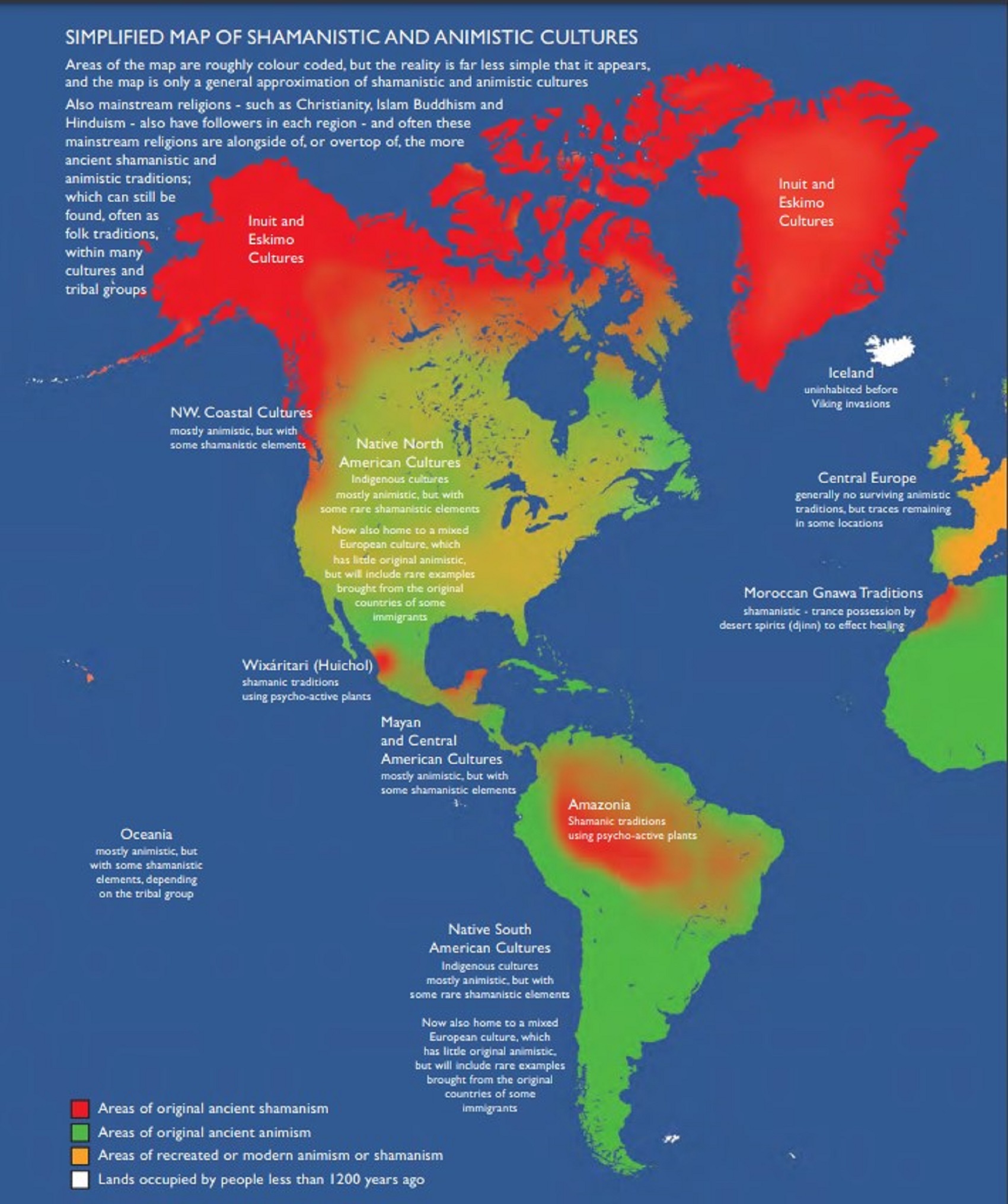
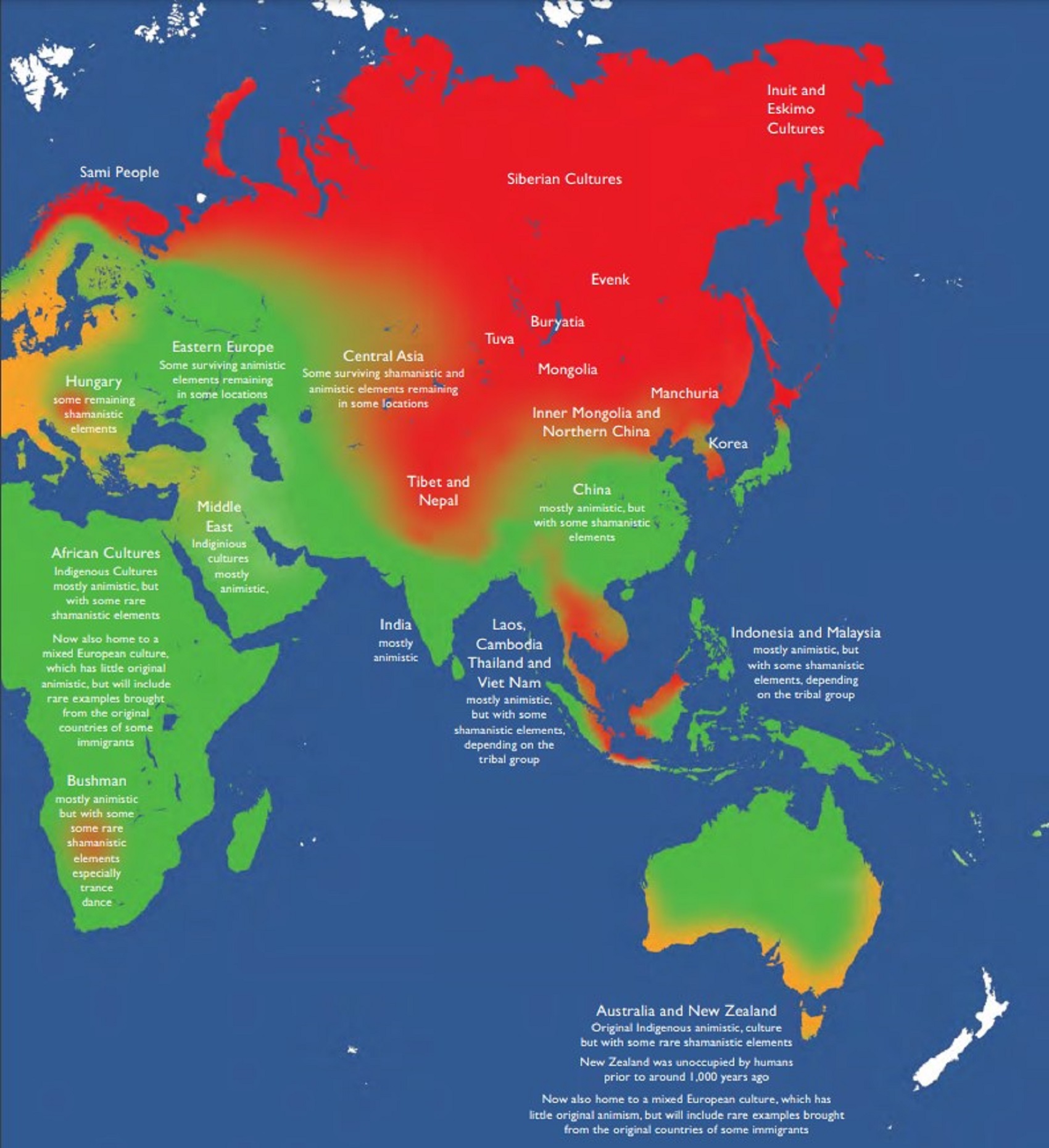
Shamanistic and Animistic Cultures map by “The Shamanism Magazine” (http://SacredHoop.org) https://sacredhoop.org/Free-Guide-To-Shamanism/Sacred-Hoop-Free-Guide-To-Shamanism.pdf
https://sacredhoop.org/Free-Guide-To-Shamanism/Sacred-Hoop-Free-Guide-To-Shamanism.pdf

Paganism 12,000-4,000 years old
12,000-7,000 years old: related to (Pre-Capitalism)
7,000-5,000 years old: related to (Capitalism) (World War 0) Elite and their slaves!
5,000 years old: related to (Kings and the Rise of the State)
4,000 years old: related to (First Moralistic gods, then the Origin time of Monotheism)

ref, ref, ref, ref, ref, ref, ref, ref, ref, ref, ref, ref, ref, ref, ref, ref, ref, ref, ref, ref, ref
Low Gods “Earth” or Tutelary deity and High Gods “Sky” or Supreme deity
“An Earth goddess is a deification of the Earth. Earth goddesses are often associated with the “chthonic” deities of the underworld. Ki and Ninhursag are Mesopotamian earth goddesses. In Greek mythology, the Earth is personified as Gaia, corresponding to Roman Terra, Indic Prithvi/Bhūmi, etc. traced to an “Earth Mother” complementary to the “Sky Father” in Proto-Indo-European religion. Egyptian mythology exceptionally has a sky goddess and an Earth god.” ref
“A mother goddess is a goddess who represents or is a personification of nature, motherhood, fertility, creation, destruction or who embodies the bounty of the Earth. When equated with the Earth or the natural world, such goddesses are sometimes referred to as Mother Earth or as the Earth Mother. In some religious traditions or movements, Heavenly Mother (also referred to as Mother in Heaven or Sky Mother) is the wife or feminine counterpart of the Sky father or God the Father.” ref
“Any masculine sky god is often also king of the gods, taking the position of patriarch within a pantheon. Such king gods are collectively categorized as “sky father” deities, with a polarity between sky and earth often being expressed by pairing a “sky father” god with an “earth mother” goddess (pairings of a sky mother with an earth father are less frequent). A main sky goddess is often the queen of the gods and may be an air/sky goddess in her own right, though she usually has other functions as well with “sky” not being her main. In antiquity, several sky goddesses in ancient Egypt, Mesopotamia, and the Near East were called Queen of Heaven. Neopagans often apply it with impunity to sky goddesses from other regions who were never associated with the term historically. The sky often has important religious significance. Many religions, both polytheistic and monotheistic, have deities associated with the sky.” ref
“In comparative mythology, sky father is a term for a recurring concept in polytheistic religions of a sky god who is addressed as a “father”, often the father of a pantheon and is often either a reigning or former King of the Gods. The concept of “sky father” may also be taken to include Sun gods with similar characteristics, such as Ra. The concept is complementary to an “earth mother“. “Sky Father” is a direct translation of the Vedic Dyaus Pita, etymologically descended from the same Proto-Indo-European deity name as the Greek Zeûs Pater and Roman Jupiter and Germanic Týr, Tir or Tiwaz, all of which are reflexes of the same Proto-Indo-European deity’s name, *Dyēus Ph₂tḗr. While there are numerous parallels adduced from outside of Indo-European mythology, there are exceptions (e.g. In Egyptian mythology, Nut is the sky mother and Geb is the earth father).” ref
Tutelary deity
“A tutelary (also tutelar) is a deity or spirit who is a guardian, patron, or protector of a particular place, geographic feature, person, lineage, nation, culture, or occupation. The etymology of “tutelary” expresses the concept of safety and thus of guardianship. In late Greek and Roman religion, one type of tutelary deity, the genius, functions as the personal deity or daimon of an individual from birth to death. Another form of personal tutelary spirit is the familiar spirit of European folklore.” ref
“A tutelary (also tutelar) in Korean shamanism, jangseung and sotdae were placed at the edge of villages to frighten off demons. They were also worshiped as deities. Seonangshin is the patron deity of the village in Korean tradition and was believed to embody the Seonangdang. In Philippine animism, Diwata or Lambana are deities or spirits that inhabit sacred places like mountains and mounds and serve as guardians. Such as: Maria Makiling is the deity who guards Mt. Makiling and Maria Cacao and Maria Sinukuan. In Shinto, the spirits, or kami, which give life to human bodies come from nature and return to it after death. Ancestors are therefore themselves tutelaries to be worshiped. And similarly, Native American beliefs such as Tonás, tutelary animal spirit among the Zapotec and Totems, familial or clan spirits among the Ojibwe, can be animals.” ref
“A tutelary (also tutelar) in Austronesian beliefs such as: Atua (gods and spirits of the Polynesian peoples such as the Māori or the Hawaiians), Hanitu (Bunun of Taiwan‘s term for spirit), Hyang (Kawi, Sundanese, Javanese, and Balinese Supreme Being, in ancient Java and Bali mythology and this spiritual entity, can be either divine or ancestral), Kaitiaki (New Zealand Māori term used for the concept of guardianship, for the sky, the sea, and the land), Kawas (mythology) (divided into 6 groups: gods, ancestors, souls of the living, spirits of living things, spirits of lifeless objects, and ghosts), Tiki (Māori mythology, Tiki is the first man created by either Tūmatauenga or Tāne and represents deified ancestors found in most Polynesian cultures). ” ref, ref, ref, ref, ref, ref, ref
Mesopotamian Tutelary Deities can be seen as ones related to City-States
“Historical city-states included Sumerian cities such as Uruk and Ur; Ancient Egyptian city-states, such as Thebes and Memphis; the Phoenician cities (such as Tyre and Sidon); the five Philistine city-states; the Berber city-states of the Garamantes; the city-states of ancient Greece (the poleis such as Athens, Sparta, Thebes, and Corinth); the Roman Republic (which grew from a city-state into a vast empire); the Italian city-states from the Middle Ages to the early modern period, such as Florence, Siena, Ferrara, Milan (which as they grew in power began to dominate neighboring cities) and Genoa and Venice, which became powerful thalassocracies; the Mayan and other cultures of pre-Columbian Mesoamerica (including cities such as Chichen Itza, Tikal, Copán and Monte Albán); the central Asian cities along the Silk Road; the city-states of the Swahili coast; Ragusa; states of the medieval Russian lands such as Novgorod and Pskov; and many others.” ref
“The Uruk period (ca. 4000 to 3100 BCE; also known as Protoliterate period) of Mesopotamia, named after the Sumerian city of Uruk, this period saw the emergence of urban life in Mesopotamia and the Sumerian civilization. City-States like Uruk and others had a patron tutelary City Deity along with a Priest-King.” ref
“Chinese folk religion, both past, and present, includes myriad tutelary deities. Exceptional individuals, highly cultivated sages, and prominent ancestors can be deified and honored after death. Lord Guan is the patron of military personnel and police, while Mazu is the patron of fishermen and sailors. Such as Tu Di Gong (Earth Deity) is the tutelary deity of a locality, and each individual locality has its own Earth Deity and Cheng Huang Gong (City God) is the guardian deity of an individual city, worshipped by local officials and locals since imperial times.” ref
“A tutelary (also tutelar) in Hinduism, personal tutelary deities are known as ishta-devata, while family tutelary deities are known as Kuladevata. Gramadevata are guardian deities of villages. Devas can also be seen as tutelary. Shiva is the patron of yogis and renunciants. City goddesses include: Mumbadevi (Mumbai), Sachchika (Osian); Kuladevis include: Ambika (Porwad), and Mahalakshmi. In NorthEast India Meitei mythology and religion (Sanamahism) of Manipur, there are various types of tutelary deities, among which Lam Lais are the most predominant ones. Tibetan Buddhism has Yidam as a tutelary deity. Dakini is the patron of those who seek knowledge.” ref
“A tutelary (also tutelar) The Greeks also thought deities guarded specific places: for instance, Athena was the patron goddess of the city of Athens. Socrates spoke of hearing the voice of his personal spirit or daimonion:
You have often heard me speak of an oracle or sign which comes to me … . This sign I have had ever since I was a child. The sign is a voice which comes to me and always forbids me to do something which I am going to do, but never commands me to do anything, and this is what stands in the way of my being a politician.” ref
“Tutelary deities who guard and preserve a place or a person are fundamental to ancient Roman religion. The tutelary deity of a man was his Genius, that of a woman her Juno. In the Imperial era, the Genius of the Emperor was a focus of Imperial cult. An emperor might also adopt a major deity as his personal patron or tutelary, as Augustus did Apollo. Precedents for claiming the personal protection of a deity were established in the Republican era, when for instance the Roman dictator Sulla advertised the goddess Victory as his tutelary by holding public games (ludi) in her honor.” ref
“Each town or city had one or more tutelary deities, whose protection was considered particularly vital in time of war and siege. Rome itself was protected by a goddess whose name was to be kept ritually secret on pain of death (for a supposed case, see Quintus Valerius Soranus). The Capitoline Triad of Juno, Jupiter, and Minerva were also tutelaries of Rome. The Italic towns had their own tutelary deities. Juno often had this function, as at the Latin town of Lanuvium and the Etruscan city of Veii, and was often housed in an especially grand temple on the arx (citadel) or other prominent or central location. The tutelary deity of Praeneste was Fortuna, whose oracle was renowned.” ref
“The Roman ritual of evocatio was premised on the belief that a town could be made vulnerable to military defeat if the power of its tutelary deity were diverted outside the city, perhaps by the offer of superior cult at Rome. The depiction of some goddesses such as the Magna Mater (Great Mother, or Cybele) as “tower-crowned” represents their capacity to preserve the city. A town in the provinces might adopt a deity from within the Roman religious sphere to serve as its guardian, or syncretize its own tutelary with such; for instance, a community within the civitas of the Remi in Gaul adopted Apollo as its tutelary, and at the capital of the Remi (present-day Rheims), the tutelary was Mars Camulus.” ref
Household deity (a kind of or related to a Tutelary deity)
“A household deity is a deity or spirit that protects the home, looking after the entire household or certain key members. It has been a common belief in paganism as well as in folklore across many parts of the world. Household deities fit into two types; firstly, a specific deity – typically a goddess – often referred to as a hearth goddess or domestic goddess who is associated with the home and hearth, such as the ancient Greek Hestia.” ref
“The second type of household deities are those that are not one singular deity, but a type, or species of animistic deity, who usually have lesser powers than major deities. This type was common in the religions of antiquity, such as the Lares of ancient Roman religion, the Gashin of Korean shamanism, and Cofgodas of Anglo-Saxon paganism. These survived Christianisation as fairy-like creatures existing in folklore, such as the Anglo-Scottish Brownie and Slavic Domovoy.” ref
“Household deities were usually worshipped not in temples but in the home, where they would be represented by small idols (such as the teraphim of the Bible, often translated as “household gods” in Genesis 31:19 for example), amulets, paintings, or reliefs. They could also be found on domestic objects, such as cosmetic articles in the case of Tawaret. The more prosperous houses might have a small shrine to the household god(s); the lararium served this purpose in the case of the Romans. The gods would be treated as members of the family and invited to join in meals, or be given offerings of food and drink.” ref
“In many religions, both ancient and modern, a god would preside over the home. Certain species, or types, of household deities, existed. An example of this was the Roman Lares. Many European cultures retained house spirits into the modern period. Some examples of these include:
- Brownie (Scotland and England) or Hob (England) / Kobold (Germany) / Goblin / Hobgoblin
- Domovoy (Slavic)
- Nisse (Norwegian or Danish) / Tomte (Swedish) / Tonttu (Finnish)
- Húsvættir (Norse)” ref
“Although the cosmic status of household deities was not as lofty as that of the Twelve Olympians or the Aesir, they were also jealous of their dignity and also had to be appeased with shrines and offerings, however humble. Because of their immediacy they had arguably more influence on the day-to-day affairs of men than the remote gods did. Vestiges of their worship persisted long after Christianity and other major religions extirpated nearly every trace of the major pagan pantheons. Elements of the practice can be seen even today, with Christian accretions, where statues to various saints (such as St. Francis) protect gardens and grottos. Even the gargoyles found on older churches, could be viewed as guardians partitioning a sacred space.” ref
“For centuries, Christianity fought a mop-up war against these lingering minor pagan deities, but they proved tenacious. For example, Martin Luther‘s Tischreden have numerous – quite serious – references to dealing with kobolds. Eventually, rationalism and the Industrial Revolution threatened to erase most of these minor deities, until the advent of romantic nationalism rehabilitated them and embellished them into objects of literary curiosity in the 19th century. Since the 20th century this literature has been mined for characters for role-playing games, video games, and other fantasy personae, not infrequently invested with invented traits and hierarchies somewhat different from their mythological and folkloric roots.” ref
“In contradistinction to both Herbert Spencer and Edward Burnett Tylor, who defended theories of animistic origins of ancestor worship, Émile Durkheim saw its origin in totemism. In reality, this distinction is somewhat academic, since totemism may be regarded as a particularized manifestation of animism, and something of a synthesis of the two positions was attempted by Sigmund Freud. In Freud’s Totem and Taboo, both totem and taboo are outward expressions or manifestations of the same psychological tendency, a concept which is complementary to, or which rather reconciles, the apparent conflict. Freud preferred to emphasize the psychoanalytic implications of the reification of metaphysical forces, but with particular emphasis on its familial nature. This emphasis underscores, rather than weakens, the ancestral component.” ref
“William Edward Hearn, a noted classicist, and jurist, traced the origin of domestic deities from the earliest stages as an expression of animism, a belief system thought to have existed also in the neolithic, and the forerunner of Indo-European religion. In his analysis of the Indo-European household, in Chapter II “The House Spirit”, Section 1, he states:
The belief which guided the conduct of our forefathers was … the spirit rule of dead ancestors.” ref
“In Section 2 he proceeds to elaborate:
It is thus certain that the worship of deceased ancestors is a vera causa, and not a mere hypothesis. …
In the other European nations, the Slavs, the Teutons, and the Kelts, the House Spirit appears with no less distinctness. … [T]he existence of that worship does not admit of doubt. … The House Spirits had a multitude of other names which it is needless here to enumerate, but all of which are more or less expressive of their friendly relations with man. … In [England] … [h]e is the Brownie. … In Scotland this same Brownie is well known. He is usually described as attached to particular families, with whom he has been known to reside for centuries, threshing the corn, cleaning the house, and performing similar household tasks. His favorite gratification was milk and honey.” ref

Hinduism around 3,700 to 3,500 years old. ref
Judaism around 3,450 or 3,250 years old. (The first writing in the bible was “Paleo-Hebrew” dated to around 3,000 years ago Khirbet Qeiyafa is the site of an ancient fortress city overlooking the Elah Valley. And many believe the religious Jewish texts were completed around 2,500) ref, ref
Judaism is around 3,450 or 3,250 years old. (“Paleo-Hebrew” 3,000 years ago and Torah 2,500 years ago)
“Judaism is an Abrahamic, its roots as an organized religion in the Middle East during the Bronze Age. Some scholars argue that modern Judaism evolved from Yahwism, the religion of ancient Israel and Judah, by the late 6th century BCE, and is thus considered to be one of the oldest monotheistic religions.” ref
“Yahwism is the name given by modern scholars to the religion of ancient Israel, essentially polytheistic, with a plethora of gods and goddesses. Heading the pantheon was Yahweh, the national god of the Israelite kingdoms of Israel and Judah, with his consort, the goddess Asherah; below them were second-tier gods and goddesses such as Baal, Shamash, Yarikh, Mot, and Astarte, all of whom had their own priests and prophets and numbered royalty among their devotees, and a third and fourth tier of minor divine beings, including the mal’ak, the messengers of the higher gods, who in later times became the angels of Judaism, Christianity and Islam. Yahweh, however, was not the ‘original’ god of Israel “Isra-El”; it is El, the head of the Canaanite pantheon, whose name forms the basis of the name “Israel”, and none of the Old Testament patriarchs, the tribes of Israel, the Judges, or the earliest monarchs, have a Yahwistic theophoric name (i.e., one incorporating the name of Yahweh).” ref
“El is a Northwest Semitic word meaning “god” or “deity“, or referring (as a proper name) to any one of multiple major ancient Near Eastern deities. A rarer form, ‘ila, represents the predicate form in Old Akkadian and in Amorite. The word is derived from the Proto-Semitic *ʔil-, meaning “god”. Specific deities known as ‘El or ‘Il include the supreme god of the ancient Canaanite religion and the supreme god of East Semitic speakers in Mesopotamia’s Early Dynastic Period. ʼĒl is listed at the head of many pantheons. In some Canaanite and Ugaritic sources, ʼĒl played a role as father of the gods, of creation, or both. For example, in the Ugaritic texts, ʾil mlk is understood to mean “ʼĒl the King” but ʾil hd as “the god Hadad“. The Semitic root ʾlh (Arabic ʾilāh, Aramaic ʾAlāh, ʾElāh, Hebrew ʾelōah) may be ʾl with a parasitic h, and ʾl may be an abbreviated form of ʾlh. In Ugaritic the plural form meaning “gods” is ʾilhm, equivalent to Hebrew ʾelōhîm “powers”. In the Hebrew texts this word is interpreted as being semantically singular for “god” by biblical commentators. However the documentary hypothesis for the Old Testament (corresponds to the Jewish Torah) developed originally in the 1870s, identifies these that different authors – the Jahwist, Elohist, Deuteronomist, and the Priestly source – were responsible for editing stories from a polytheistic religion into those of a monotheistic religion. Inconsistencies that arise between monotheism and polytheism in the texts are reflective of this hypothesis.” ref
Jainism around 2,599 – 2,527 years old. ref
Confucianism around 2,600 – 2,551 years old. ref
Buddhism around 2,563/2,480 – 2,483/2,400 years old. ref
Christianity around 2,o00 years old. ref
Shinto around 1,305 years old. ref
Islam around 1407–1385 years old. ref

Knowledge to Ponder:
Stars/Astrology:
- Possibly, around 30,000 years ago (in simpler form) to 6,000 years ago, Stars/Astrology are connected to Ancestors, Spirit Animals, and Deities.
- The star also seems to be a possible proto-star for Star of Ishtar, Star of Inanna, or Star of Venus.
- Around 7,000 to 6,000 years ago, Star Constellations/Astrology have connections to the “Kurgan phenomenon” of below-ground “mound” stone/wood burial structures and “Dolmen phenomenon” of above-ground stone burial structures.
- Around 6,500–5,800 years ago, The Northern Levant migrations into Jordon and Israel in the Southern Levant brought new cultural and religious transfer from Turkey and Iran.
- “The Ghassulian Star,” a mysterious 6,000-year-old mural from Jordan may have connections to the European paganstic kurgan/dolmens phenomenon.
“Astrology is a range of divinatory practices, recognized as pseudoscientific since the 18th century, that claim to discern information about human affairs and terrestrial events by studying the apparent positions of celestial objects. Different cultures have employed forms of astrology since at least the 2nd millennium BCE, these practices having originated in calendrical systems used to predict seasonal shifts and to interpret celestial cycles as signs of divine communications. Most, if not all, cultures have attached importance to what they observed in the sky, and some—such as the Hindus, Chinese, and the Maya—developed elaborate systems for predicting terrestrial events from celestial observations. Western astrology, one of the oldest astrological systems still in use, can trace its roots to 19th–17th century BCE Mesopotamia, from where it spread to Ancient Greece, Rome, the Islamicate world and eventually Central and Western Europe. Contemporary Western astrology is often associated with systems of horoscopes that purport to explain aspects of a person’s personality and predict significant events in their lives based on the positions of celestial objects; the majority of professional astrologers rely on such systems.” ref
Around 5,500 years ago, Science evolves, The first evidence of science was 5,500 years ago and was demonstrated by a body of empirical, theoretical, and practical knowledge about the natural world. ref
Around 5,000 years ago, Origin of Logics is a Naturalistic Observation (principles of valid reasoning, inference, & demonstration) ref
Around 4,150 to 4,000 years ago: The earliest surviving versions of the Sumerian Epic of Gilgamesh, which was originally titled “He who Saw the Deep” (Sha naqba īmuru) or “Surpassing All Other Kings” (Shūtur eli sharrī) were written. ref
Hinduism:
- 3,700 years ago or so, the oldest of the Hindu Vedas (scriptures), the Rig Veda was composed.
- 3,500 years ago or so, the Vedic Age began in India after the collapse of the Indus Valley Civilization.
Judaism:
- around 3,000 years ago, the first writing in the bible was “Paleo-Hebrew”
- around 2,500 years ago, many believe the religious Jewish texts were completed
Myths: The bible inspired religion is not just one religion or one myth but a grouping of several religions and myths
- Around 3,450 or 3,250 years ago, according to legend, is the traditionally accepted period in which the Israelite lawgiver, Moses, provided the Ten Commandments.
- Around 2,500 to 2,400 years ago, a collection of ancient religious writings by the Israelites based primarily upon the Hebrew Bible, Tanakh, or Old Testament is the first part of Christianity’s bible.
- Around 2,400 years ago, the most accepted hypothesis is that the canon was formed in stages, first the Pentateuch (Torah).
- Around 2,140 to 2,116 years ago, the Prophets was written during the Hasmonean dynasty, and finally the remaining books.
- Christians traditionally divide the Old Testament into four sections:
- The first five books or Pentateuch (Torah).
- The proposed history books telling the history of the Israelites from their conquest of Canaan to their defeat and exile in Babylon.
- The poetic and proposed “Wisdom books” dealing, in various forms, with questions of good and evil in the world.
- The books of the biblical prophets, warning of the consequences of turning away from God:
- Henotheism:
- Exodus 20:23 “You shall not make other gods besides Me (not saying there are no other gods just not to worship them); gods of silver or gods of gold, you shall not make for yourselves.”
- Polytheism:
- Judges 10:6 “Then the sons of Israel again did evil in the sight of the LORD, served the Baals and the Ashtaroth, the gods of Aram, the gods of Sidon, the gods of Moab, the gods of the sons of Ammon, and the gods of the Philistines; thus they forsook the LORD and did not serve Him.”
- 1 Corinthians 8:5 “For even if there are so-called gods whether in heaven or on earth, as indeed there are many gods and many lords.”
- Monotheism:
- Isaiah 43:10 “You are my witnesses,” declares the LORD, “and my servant whom I have chosen, so that you may know and believe me and understand that I am he. Before me no god was formed, nor will there be one after me.
Around 2,570 to 2,270 Years Ago, there is a confirmation of atheistic doubting as well as atheistic thinking, mainly by Greek philosophers. However, doubting gods is likely as old as the invention of gods and should destroy the thinking that belief in god(s) is the “default belief”. The Greek word is apistos (a “not” and pistos “faithful,”), thus not faithful or faithless because one is unpersuaded and unconvinced by a god(s) claim. Short Definition: unbelieving, unbeliever, or unbelief.

Expressions of Atheistic Thinking:
- Around 2,600 years ago, Ajita Kesakambali, ancient Indian philosopher, who is the first known proponent of Indian materialism. ref
- Around 2,535 to 2,475 years ago, Heraclitus, Greek pre-Socratic philosopher, a native of the Greek city Ephesus, Ionia, on the coast of Anatolia, also known as Asia Minor or modern Turkey. ref
- Around 2,500 to 2,400 years ago, according to The Story of Civilization book series certain African pygmy tribes have no identifiable gods, spirits, or religious beliefs or rituals, and even what burials accrue are without ceremony. ref
- Around 2,490 to 2,430 years ago, Empedocles, Greek pre-Socratic philosopher and a citizen of Agrigentum, a Greek city in Sicily. ref
- Around 2,460 to 2,370 years ago, Democritus, Greek pre-Socratic philosopher considered to be the “father of modern science” possibly had some disbelief amounting to atheism. ref
- Around 2,399 years ago or so, Socrates, a famous Greek philosopher was tried for sinfulness by teaching doubt of state gods. ref
- Around 2,341 to 2,270 years ago, Epicurus, a Greek philosopher known for composing atheistic critics and famously stated, “Is God willing to prevent evil, but not able? Then he is not omnipotent. Is he able, but not willing? Then he is malevolent. Is he both able and willing? Then whence cometh evil? Is he neither able nor willing? Then why call him god?” ref
This last expression by Epicurus, seems to be an expression of Axiological Atheism. To understand and utilize value or actually possess “Value Conscious/Consciousness” to both give a strong moral “axiological” argument (the problem of evil) as well as use it to fortify humanism and positive ethical persuasion of human helping and care responsibilities. Because value-blindness gives rise to sociopathic/psychopathic evil.

“Theists, there has to be a god, as something can not come from nothing.”
Well, thus something (unknown) happened and then there was something. This does not tell us what the something that may have been involved with something coming from nothing. A supposed first cause, thus something (unknown) happened and then there was something is not an open invitation to claim it as known, neither is it justified to call or label such an unknown as anything, especially an unsubstantiated magical thinking belief born of mythology and religious storytelling.


While hallucinogens are associated with shamanism, it is alcohol that is associated with paganism.
The Atheist-Humanist-Leftist Revolutionaries Shows in the prehistory series:
Show two: Pre-animism 300,000 years old and animism 100,000 years old: related to “Anarchism and Socialism”
Show tree: Totemism 50,000 years old: related to “Anarchism and Socialism”
Show four: Shamanism 30,000 years old: related to “Anarchism and Socialism”
Show five: Paganism 12,000 years old: related to “Anarchism and Socialism”
Show six: Emergence of hierarchy, sexism, slavery, and the new male god dominance: Paganism 7,000-5,000 years old: related to “Anarchism and Socialism” (Capitalism) (World War 0) Elite and their slaves!
Prehistory: related to “Anarchism and Socialism” the division of labor, power, rights, and recourses: VIDEO
Pre-animism 300,000 years old and animism 100,000 years old: related to “Anarchism and Socialism”: VIDEO
Totemism 50,000 years old: related to “Anarchism and Socialism”: VIDEO
Shamanism 30,000 years old: related to “Anarchism and Socialism”: VIDEO
Paganism 12,000 years old: related to “Anarchism and Socialism” (Pre-Capitalism): VIDEO
Paganism 7,000-5,000 years old: related to “Anarchism and Socialism” (Capitalism) (World War 0) Elite and their slaves: VIEDO
Paganism 5,000 years old: progressed organized religion and the state: related to “Anarchism and Socialism” (Kings and the Rise of the State): VIEDO
Paganism 4,000 years old: related to “Anarchism and Socialism” (First Moralistic gods, then the Origin time of Monotheism): VIEDO
I do not hate simply because I challenge and expose myths or lies any more than others being thought of as loving simply because of the protection and hiding from challenge their favored myths or lies.
The truth is best championed in the sunlight of challenge.
An archaeologist once said to me “Damien religion and culture are very different”
My response, So are you saying that was always that way, such as would you say Native Americans’ cultures are separate from their religions? And do you think it always was the way you believe?
I had said that religion was a cultural product. That is still how I see it and there are other archaeologists that think close to me as well. Gods too are the myths of cultures that did not understand science or the world around them, seeing magic/supernatural everywhere.
I personally think there is a goddess and not enough evidence to support a male god at Çatalhöyük but if there was both a male and female god and goddess then I know the kind of gods they were like Proto-Indo-European mythology.
This series idea was addressed in, Anarchist Teaching as Free Public Education or Free Education in the Public: VIDEO
Our 12 video series: Organized Oppression: Mesopotamian State Force and the Politics of power (9,000-4,000 years ago), is adapted from: The Complete and Concise History of the Sumerians and Early Bronze Age Mesopotamia (7000-2000 BC): https://www.youtube.com/watch?v=szFjxmY7jQA by “History with Cy“
Show #1: Mesopotamian State Force and the Politics of Power (Samarra, Halaf, Ubaid)
Show #2: Mesopotamian State Force and the Politics of Power (Eridu: First City of Power)
Show #3: Mesopotamian State Force and the Politics of Power (Uruk and the First Cities)
Show #4: Mesopotamian State Force and the Politics of Power (First Kings)
Show #5: Mesopotamian State Force and the Politics of Power (Early Dynastic Period)
Show #6: Mesopotamian State Force and the Politics of Power (King Lugalzagesi and the First Empire)
Show #7: Mesopotamian State Force and the Politics of Power (Sargon and Akkadian Rule)
Show #9: Mesopotamian State Force and the Politics of Power (Gudea of Lagash and Utu-hegal)
Show #12: Mesopotamian State Force and the Politics of Power (Aftermath and Legacy of Sumer)

The “Atheist-Humanist-Leftist Revolutionaries”
Cory Johnston ☭ Ⓐ Atheist Leftist @Skepticallefty & I (Damien Marie AtHope) @AthopeMarie (my YouTube & related blog) are working jointly in atheist, antitheist, antireligionist, antifascist, anarchist, socialist, and humanist endeavors in our videos together, generally, every other Saturday.
Why Does Power Bring Responsibility?
Think, how often is it the powerless that start wars, oppress others, or commit genocide? So, I guess the question is to us all, to ask, how can power not carry responsibility in a humanity concept? I know I see the deep ethical responsibility that if there is power their must be a humanistic responsibility of ethical and empathic stewardship of that power. Will I be brave enough to be kind? Will I possess enough courage to be compassionate? Will my valor reach its height of empathy? I as everyone, earns our justified respect by our actions, that are good, ethical, just, protecting, and kind. Do I have enough self-respect to put my love for humanity’s flushing, over being brought down by some of its bad actors? May we all be the ones doing good actions in the world, to help human flourishing.
I create the world I want to live in, striving for flourishing. Which is not a place but a positive potential involvement and promotion; a life of humanist goal precision. To master oneself, also means mastering positive prosocial behaviors needed for human flourishing. I may have lost a god myth as an atheist, but I am happy to tell you, my friend, it is exactly because of that, leaving the mental terrorizer, god belief, that I truly regained my connected ethical as well as kind humanity.
Cory and I will talk about prehistory and theism, addressing the relevance to atheism, anarchism, and socialism.
At the same time as the rise of the male god, 7,000 years ago, there was also the very time there was the rise of violence, war, and clans to kingdoms, then empires, then states. It is all connected back to 7,000 years ago, and it moved across the world.
Cory Johnston: https://damienmarieathope.com/2021/04/cory-johnston-mind-of-a-skeptical-leftist/?v=32aec8db952d
The Mind of a Skeptical Leftist (YouTube)
Cory Johnston: Mind of a Skeptical Leftist @Skepticallefty
The Mind of a Skeptical Leftist By Cory Johnston: “Promoting critical thinking, social justice, and left-wing politics by covering current events and talking to a variety of people. Cory Johnston has been thoughtfully talking to people and attempting to promote critical thinking, social justice, and left-wing politics.” http://anchor.fm/skepticalleft
Cory needs our support. We rise by helping each other.
Cory Johnston ☭ Ⓐ @Skepticallefty Evidence-based atheist leftist (he/him) Producer, host, and co-host of 4 podcasts @skeptarchy @skpoliticspod and @AthopeMarie
Damien Marie AtHope (“At Hope”) Axiological Atheist, Anti-theist, Anti-religionist, Secular Humanist. Rationalist, Writer, Artist, Poet, Philosopher, Advocate, Activist, Psychology, and Armchair Archaeology/Anthropology/Historian.
Damien is interested in: Freedom, Liberty, Justice, Equality, Ethics, Humanism, Science, Atheism, Antiteism, Antireligionism, Ignosticism, Left-Libertarianism, Anarchism, Socialism, Mutualism, Axiology, Metaphysics, LGBTQI, Philosophy, Advocacy, Activism, Mental Health, Psychology, Archaeology, Social Work, Sexual Rights, Marriage Rights, Woman’s Rights, Gender Rights, Child Rights, Secular Rights, Race Equality, Ageism/Disability Equality, Etc. And a far-leftist, “Anarcho-Humanist.”
I am not a good fit in the atheist movement that is mostly pro-capitalist, I am anti-capitalist. Mostly pro-skeptic, I am a rationalist not valuing skepticism. Mostly pro-agnostic, I am anti-agnostic. Mostly limited to anti-Abrahamic religions, I am an anti-religionist.
To me, the “male god” seems to have either emerged or become prominent around 7,000 years ago, whereas the now favored monotheism “male god” is more like 4,000 years ago or so. To me, the “female goddess” seems to have either emerged or become prominent around 11,000-10,000 years ago or so, losing the majority of its once prominence around 2,000 years ago due largely to the now favored monotheism “male god” that grow in prominence after 4,000 years ago or so.
My Thought on the Evolution of Gods?
Animal protector deities from old totems/spirit animal beliefs come first to me, 13,000/12,000 years ago, then women as deities 11,000/10,000 years ago, then male gods around 7,000/8,000 years ago. Moralistic gods around 5,000/4,000 years ago, and monotheistic gods around 4,000/3,000 years ago.
Gods?
“Animism” is needed to begin supernatural thinking.
“Totemism” is needed for supernatural thinking connecting human actions & related to clan/tribe.
“Shamanism” is needed for supernatural thinking to be controllable/changeable by special persons.
Together = Gods/paganism


Damien Marie AtHope (Said as “At” “Hope”)/(Autodidact Polymath but not good at math):
Axiological Atheist, Anti-theist, Anti-religionist, Secular Humanist, Rationalist, Writer, Artist, Jeweler, Poet, “autodidact” Philosopher, schooled in Psychology, and “autodidact” Armchair Archaeology/Anthropology/Pre-Historian (Knowledgeable in the range of: 1 million to 5,000/4,000 years ago). I am an anarchist socialist politically. Reasons for or Types of Atheism
My Website, My Blog, & Short-writing or Quotes, My YouTube, Twitter: @AthopeMarie, and My Email: damien.marie.athope@gmail.com
